Discover the power of Staff Augmentation Best Practices in IT. Optimize team efficiency, transparent communication, and successful project outcomes.
Read Our Recent Blogs
The latest updates, stories, idea, guides from the Ontik team

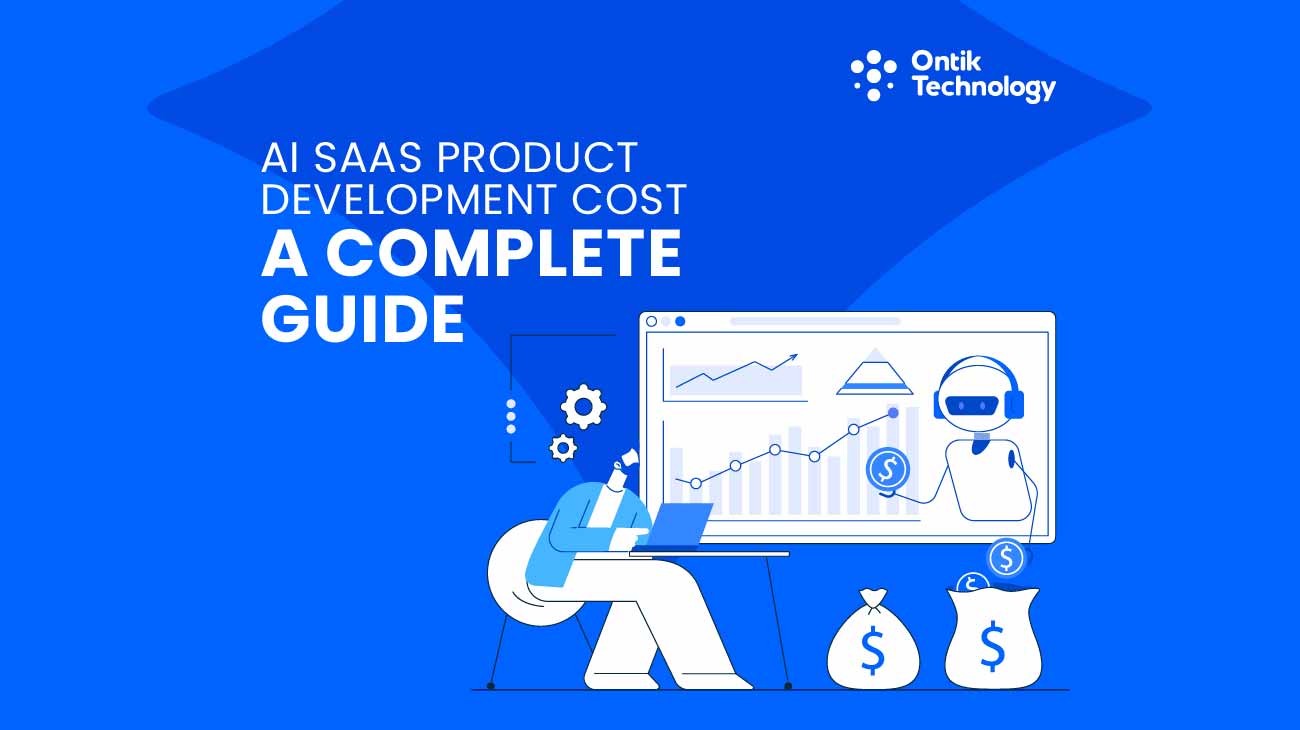

Key Takeaways
- 2026 is the breakout year for AI SaaS market leadership.
- AI SaaS combines SaaS delivery with learning, predictive, and generative intelligence.
- A structured 8-stage process de-risks AI SaaS product development.
- AI SaaS costs $40K–$400K+, with APIs and outsourcing cutting spend.
- Winners focus on narrow pains, workflow integration, and ROI-driven automation.
The AI SaaS market is exploding from $71 billion in 2024 to $775 billion by 2031, a 38.28% annual growth rate. This makes 2025 the pivotal year where early movers building AI SaaS products capture market share.
Success stories like Grammarly serving 30 million daily users, Salesforce Einstein transforming CRM, and ChatGPT reaching 100 million users faster than any software as a service example prove the opportunity. These companies understood the fundamental shift in AI SaaS product development.
Modern customers demand intelligent tools, making manual-workflow SaaS obsolete. This guide defines AI SaaS, details the build process from discovery to scaling, provides development costs, explores generative AI infrastructure options, and shares insights from successful AI-powered SaaS companies.
Whether you are exploring AI machine learning solutions or planning your product strategy, understanding AI SaaS development is essential.
What Is an AI SaaS Product? Understanding the Definition and Core Concepts
An AI SaaS product combines subscription-based software delivery with artificial intelligence capabilities. Unlike traditional software that follows programmed rules, AI powered SaaS platforms make decisions based on data patterns, learning and adapting from every interaction.
To define saas model clearly, traditional software follows programmed rules. AI powered SaaS platforms make decisions based on data patterns. This core difference changes everything about AI SaaS product development, particularly when you are planning custom software development services for your business.
The Building Blocks of AI SaaS Architecture
Every successful AI SaaS platform has four essential components. Your SaaS foundation provides multi-tenant architecture and cloud infrastructure for user management. Your AI layer powers intelligence through machine learning models, natural language processing, and predictive analytics. Data pipelines enable real-time processing and vector databases. Your user interface delivers conversational elements and personalized dashboards that make AI accessible.
AI SaaS Product Ideas Across Industries
- Healthcare: Diagnostic assistants analyze data/images for treatment paths.
- Finance: Fraud detection and personalized investment advisors.
- Marketing: Content generation (blogs, social, ads) tailored to brand voice.
- Customer Support: AI chatbots handle tier-1 inquiries, routing complex issues.
- Sales: AI CRMs predict deal closure and suggest outreach times.
- HR: Resume screening and employee engagement platforms predicting retention risks.
- Legal Tech: Contract analysis for risk identification and compliance.
- Supply Chain: Inventory forecasting and logistics optimization.
- EdTech: Personalized learning and automated, detailed grading systems.
These examples show how AI transforms traditional SaaS into intelligent, high-value systems.
Traditional SaaS vs AI-Powered SaaS
A traditional CRM stores contacts and tracks interactions manually. An AI SaaS platform like Salesforce Einstein analyzes thousands of deals simultaneously, predicts conversion probability, and suggests optimal timing for outreach. This fundamental difference shows how AI solutions for SaaS providers deliver measurable business outcomes rather than just data storage.
The Business Value of Intelligent Automation
AI SaaS products deliver measurable advantages. Automation reduces manual tasks by 40 to 60 percent while personalization drives usage up by 20 to 35 percent. Predictive accuracy exceeds 80 percent in well-trained systems, and scalability becomes exponential as AI handles ten times the workload without proportional support staff increases.
Why Build an AI SaaS Product in 2026? Market Opportunity and Business Case
The AI SaaS market explosion from $71.54 billion in 2024 to $775.44 billion by 2031 represents a once-in-a-generation wealth creation opportunity. McKinsey reports 78 percent of companies already use AI, and 40 percent are aggressively increasing budgets. The window to capture market leadership is closing fast.
Three Unstoppable Forces Creating Historic Opportunity
The technology breakthrough is complete. Foundation models like GPT-4, Claude, and Gemini power billion-dollar companies today. Inference costs plummeted 90 percent since 2020, making AI economically viable for startups. Small teams now build what required research labs three years ago.
Customer demand shifted from interest to expectation. Seventy-three percent of buyers prioritize AI capabilities when evaluating software. After experiencing ChatGPT and Grammarly, customers will not settle for manual workflows anymore.
Competitive dynamics reward speed over perfection. Traditional SaaS companies scramble to retrofit AI into decade-old architectures while burning millions. New entrants build AI-first, capturing frustrated customers. The companies moving now define categories. The companies waiting become footnotes.
The Economics Are Dramatically Better
AI SaaS commands 15 to 30 percent premium pricing and achieves 95 percent retention versus 85 percent for traditional products. AI handles 60 to 80 percent of support inquiries, cutting costs by 40 percent. Automated onboarding improves activation by 25 to 35 percent. Lean teams serve enterprise-scale customer bases.
The 2025 Window Is Everything
Market leaders emerge within 18 to 24 months. By late 2026, markets commoditize and competition shifts to price. Every delay lets competitors build data moats while their AI improves from usage. This opportunity rivals the mobile revolution and cloud migration. The only question is whether you will capture it.
How to Build an AI SaaS Product: Complete 8-Stage Development Process
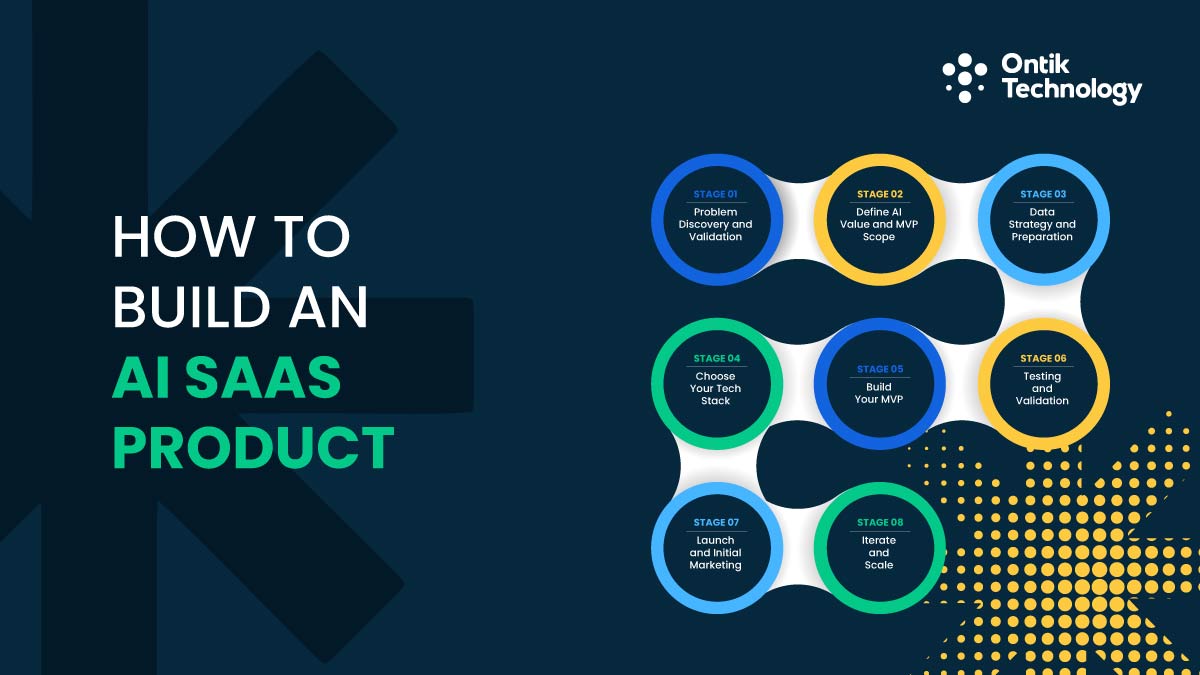
Learning how to build a saas with ai differs from traditional development. You validate both problem and solution fit. This framework provides a proven AI SaaS product development path with validation gates preventing expensive mistakes in AI SaaS projects. Following our proven development process ensures you stay on track from concept to launch.
Stage 1: Problem Discovery and Validation (2 to 3 weeks)
Conduct 20 to 30 customer interviews before coding your AI SaaS platform. Ask about workflows, pain points, and previous attempts. Run competitive analysis of existing AI SaaS tools.
Define success metrics for AI SaaS development. Your deliverable is a problem statement plus user personas. Red flags include starting with technology instead of problems in AI SaaS projects.
Stage 2: Define AI Value and MVP Scope (2 to 3 weeks)
Decide what AI does in your solution. Understanding AI SaaS product classification criteria helps specify whether it predicts, generates, classifies, or recommends.
Define your minimum viable product ruthlessly for AI SaaS projects. Choose one core AI feature plus minimal interface. Here is a SaaS example. Your customer support MVP includes email integration, AI responses, and human review. No multi-channel support or analytics yet in initial AI SaaS development.
If you lack the technical resources to build your MVP internally, consider partnering with experienced development teams. Ontik Technology offers MVP development services that can accelerate your launch timeline.
Their expertise in AI and machine learning, combined with web development and UI/UX design, helps transform your idea into a working product. You can also explore their dedicated development team option for ongoing support, or their custom software development services for more specialized needs.
Stage 3: Data Strategy and Preparation (3 to 4 weeks)
Data determines AI SaaS product development success more than algorithms. Choose pre-trained APIs for general tasks, small datasets under 10,000 samples, or budgets under $100,000.
Build custom models for specialized domains, datasets over 100,000 samples, or when privacy is paramount for your AI SaaS platform. Most early AI SaaS products start with APIs, transitioning to custom models with revenue.
Budget 20 to 30 percent of timeline for data work. Underestimating requirements is why AI SaaS projects fail. If data preparation feels overwhelming, development partners with AI and machine learning expertise can help structure your data strategy from the start.
Stage 4: Choose Your Tech Stack (1 to 2 weeks)
Selecting the best options for generative AI infrastructure affects speed and scalability. Consider OpenAI GPT-4, Anthropic Claude, or Google Gemini for AI SaaS development. Evaluate Meta Llama 3 or Mistral AI for more control.
Vector databases like Pinecone, Weaviate, or Pgvector power semantic search in AI powered SaaS. LangChain or LlamaIndex simplify workflows in AI SaaS projects.
Python dominates AI SaaS development. FastAPI delivers performance while Django offers complete features. JavaScript works for unified codebases when building AI SaaS products. Choose Python for heavy machine learning or JavaScript for real-time features in AI powered SaaS. Many teams leverage web development expertise to build robust frontend interfaces. For Web3 integrations or blockchain features, specialized Web 3.0 development partners can add decentralized capabilities to your stack.
Stage 5: Build Your MVP (8 to 12 weeks)
Your AI team integrates models and engineers prompts for the AI SaaS platform. Application teams create user flows and authentication. Integration connects AI to frontend for complete AI powered SaaS experience.
For founders without technical teams, this stage often requires outside help. A dedicated development team can handle the entire build process while you focus on customer discovery and business development. This approach works especially well for non-technical founders with strong domain expertise.
Your MVP succeeds demonstrating value, completing user journeys, handling load, and collecting feedback for AI SaaS tools. Ship imperfect working products rather than waiting for perfection in AI SaaS product development.
Stage 6: Testing and Validation (2 to 3 weeks)
Testing AI SaaS products requires validating AI-specific dimensions. Functional testing covers user flows. AI testing examines output quality, bias evaluation, and latency for your AI SaaS platform.
Security testing verifies encryption and access controls for AI powered SaaS. User acceptance with 10 to 20 beta users provides feedback. Your deliverable is test reports and launch decisions for AI SaaS projects.
Stage 7: Launch and Initial Marketing (2 to 4 weeks)
Soft launch to waitlists reduces risk for AI SaaS projects. Consider Product Hunt for buzz. Create content demonstrating AI SaaS development expertise.
Monitor metrics daily for AI powered SaaS. Track signups, activation, and usage. Conduct weekly interviews. Focus on first 10 to 50 customers confirming fit for your AI SaaS platform.
Stage 8: Iterate and Scale (Ongoing)
AI SaaS product development continues post-launch. Improve core AI, reduce onboarding friction, and optimize costs in AI SaaS projects. Monitor cost per user for opportunities reducing API calls.
Your scaling checklist ensures sustainable economics at 10x usage, auto-scaling infrastructure, systematized support, metrics dashboards, and validated pricing for AI SaaS platforms. Implementing cloud solutions helps manage infrastructure complexity as you grow. Business intelligence and analytics tools provide insights into user behavior and system performance as your product matures.
Common Pitfalls to Avoid
Overengineering before proving value wastes resources in AI SaaS development. Underestimating data needs hurts AI performance. Ignoring inference costs threatens AI powered saas economics. Neglecting user experience kills AI SaaS products. Skipping validation and treating compliance as afterthoughts create risks in AI SaaS projects.
AI SaaS Development Cost: Complete Budget Breakdown
Understanding saas development costs is critical. Building an AI SaaS product costs $40,000 to $400,000 plus depending on complexity, team location, and technology choices in AI SaaS development.
Three Tiers of AI SaaS Development
Basic AI SaaS MVP costs $40,000 to $80,000 taking 3 to 4 months with outsourced developers. You integrate pre-trained APIs for one feature. Examples include content tools or chatbots for initial AI SaaS projects.
Intermediate AI SaaS Product costs $80,000 to $200,000 taking 4 to 6 months with mixed developers. You use fine-tuned models for 2 to 3 features with polished experience. Examples include support platforms or CRM assistants as AI SaaS tools.
Enterprise AI SaaS Platform costs $200,000 to $400,000 plus taking 6 to 12 months with specialists. You build custom models with compliance and white-label options meeting b2b saas ai startup investment criteria.
Detailed Cost Components
Development team costs consume 50 to 60 percent of saas development costs:
- AI engineers cost $100 to $200 per hour for 200 to 400 hours totaling $20,000 to $80,000
- Backend developers cost $70 to $150 per hour for 300 to 500 hours totaling $21,000 to $75,000
- North American developers charge $100 to $200 per hour
- Eastern European developers cost $40 to $80 per hour
- Asian teams range $25 to $50 per hour when you hire remote developers
Technology costs account for 15 to 25 percent:
- AI APIs at $500 to $5,000 monthly
- Cloud hosting at $300 to $3,000 monthly
- Databases at $200 to $1,500 monthly
Additional budget allocations:
- Data acquisition takes 5 to 15 percent at $5,000 to $50,000
- Compliance requires 5 to 10 percent at $15,000 to $50,000
- Design consumes 5 to 10 percent at $10,000 to $45,000
Smart Ways to Optimize Costs
Reduce saas development costs by 40 to 60 percent with strategic choices. Start with APIs saving $20,000 to $80,000 initially in AI SaaS development.
Strategic outsourcing saves 40 to 60 percent when executed properly. The challenge most companies face is finding developers who understand both AI architecture and SaaS economics. Working with experienced technology partners who have shipped multiple AI products eliminates trial-and-error costs and accelerates time to market by months.
Leverage open-source tools saving $10,000 to $30,000. Roll out features in phases validating core functionality before building advanced AI SaaS tools. Serverless architecture reduces costs by 30 to 50 percent for AI powered saas. Consider team augmentation to scale your development capacity cost-effectively while maintaining control over your product vision and roadmap.
Understanding Your Return on Investment
AI SaaS products achieve payback within 18 to 36 months. Example for AI SaaS development: invest $120,000, charge $100 monthly, $300 acquisition cost. Break-even at 1,200 customers for your AI SaaS product takes 15 to 18 months. AI powered saas commands 15 to 30 percent premium pricing.
Essential Technology Stack for AI SaaS Development
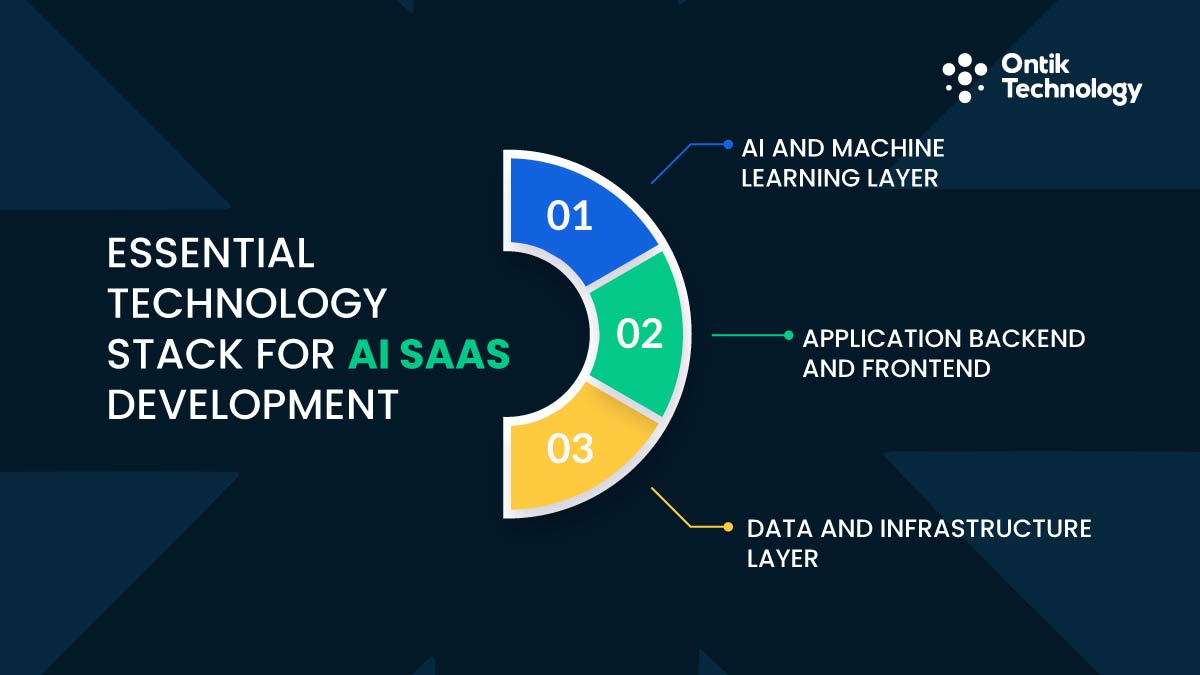
Selecting the best options for generative ai infrastructure determines shipping speed, AI SaaS platform scalability, and ownership costs. Let's examine modern AI SaaS product development architecture layers.
AI and Machine Learning Layer
Foundation models power your AI SaaS product. OpenAI GPT-4, Anthropic Claude, and Google Gemini handle natural language for AI SaaS development. Meta Llama 3 or Mistral AI provide control for AI SaaS tools.
Selection criteria include cost at $0.03 per 1,000 tokens, privacy requirements, and specific capabilities for AI SaaS platforms. Vector databases like Pinecone, Weaviate, or Pgvector enable semantic search in AI powered saas. LangChain or LlamaIndex simplify workflows in AI SaaS projects.
Application Backend and Frontend
Python dominates AI SaaS development. FastAPI delivers performance while Django offers complete features for AI SaaS platforms. JavaScript works for unified codebases with NestJS or Next.js when building AI SaaS products.
Choose Python for heavy machine learning in your AI SaaS product. Pick JavaScript for unified codebases or real-time features in AI powered saas. React plus Next.js is recommended for most AI SaaS development projects. Tailwind CSS enables rapid styling while Shadcn/ui provides components for AI SaaS tools. Professional UI/UX design consulting can dramatically improve user adoption rates.
Data and Infrastructure Layer
PostgreSQL is best for AI SaaS product development, handling relational data plus vector storage through pgvector. MongoDB works for flexible schemas. Redis provides caching for AI SaaS platforms.
AWS offers most services for AI SaaS development while Google Cloud provides excellent AI tools. Docker plus Kubernetes ensures consistent environments for AI SaaS products. Datadog, Sentry, or Prometheus catch issues in AI powered saas. Implementing business intelligence and analytics helps you monitor performance and make data-driven decisions.
Real-World AI SaaS Success Stories: Examples and Case Studies
Examining successful AI SaaS products reveals patterns in positioning and implementation that work for AI SaaS development.
LazyChat: Ontik Technology's AI-Powered Customer Support Platform
LazyChat demonstrates how focused AI SaaS product development solves specific market pain points. Built by Ontik Technology, LazyChat is an AI sales agent that handles customer conversations across Facebook Messenger, WhatsApp, and Instagram automatically.
The platform addresses a critical problem for growing e-commerce businesses where message volume overwhelms small teams. LazyChat's AI responds instantly to customer inquiries, answers product questions, takes orders, and resolves common support issues without human intervention. The system speaks naturally in different languages, adapting to how customers actually communicate.
Key success factors include deep vertical specialization for e-commerce workflows, multilingual AI trained on local market patterns, and seamless integration with platforms businesses already use. LazyChat achieved 30 percent sales increases for clients by eliminating missed conversations and late replies. The pricing model scales with message volume at $39 to $199 monthly, making AI accessible to businesses of all sizes.
This AI SaaS platform shows how understanding specific market needs and building AI that solves real workflow problems creates immediate value. Rather than general-purpose AI requiring extensive configuration, LazyChat works out of the box for its target market. The lesson for AI SaaS development is clear: narrow focus with deep execution beats broad capabilities with shallow implementation.
Grammarly and Salesforce Einstein: Proven Patterns
Grammarly serves 30 million users with AI-powered writing assistance, starting narrow with grammar checking before expanding. Freemium pricing lets users experience AI value before paying. Salesforce Einstein embedded AI into existing CRM workflows, adding predictive scoring and automation to familiar interfaces. Both demonstrate that AI adds most value when integrated into existing workflows rather than requiring new tool adoption.
Common Patterns Across Winners
Successful AI SaaS products begin focused, then expand. Freemium/trials allow users to experience AI value first. Continuous feedback-driven improvement is key. Easy integration via extensions, APIs, or existing tools reduces friction. Vertical specialization outperforms horizontal approaches. Premium pricing is justified when automation value is clear.
Common Challenges in AI SaaS Development and How to Overcome Them
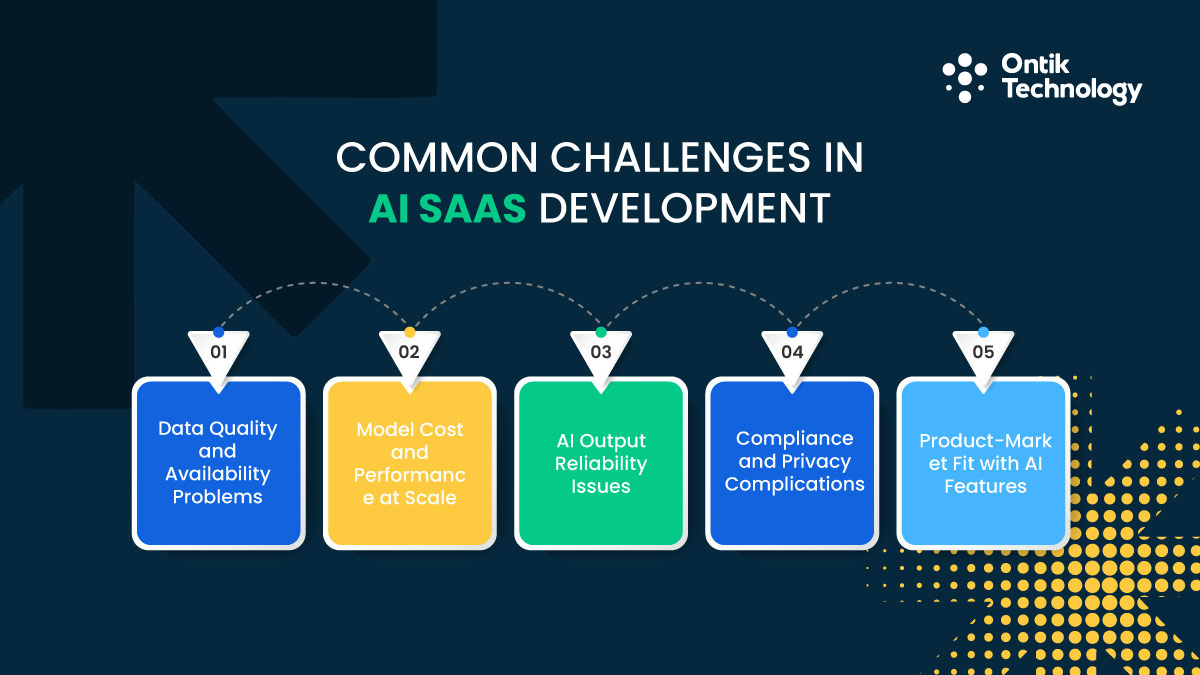
AI SaaS product development introduces unique obstacles that separate successful launches from expensive failures. At Ontik Technology, we have navigated these challenges across dozens of AI implementations, developing proven frameworks that anticipate problems before they derail timelines.
Data Quality and Availability Problems
Most companies lack datasets AI SaaS platforms require. Poor training data leads to inaccurate predictions eroding trust in AI powered saas.
Our approach starts with realistic expectations for AI SaaS development. We use synthetic or public datasets for MVPs and design AI SaaS products that collect training data with clear consent. We establish partnerships with providers like Scale AI and budget 20 to 30 percent timeline for data work, ensuring quality foundations rather than rebuilding later.
Model Cost and Performance at Scale
AI inference costs explode as AI SaaS platforms grow. Token pricing seems cheap but adds up for AI powered saas.
We focus on optimization from day one. Our implementations include caching that reduces API calls by 40 to 60 percent, intelligent model routing that uses smaller models for simple tasks, and fine-tuned open-source models for high-volume operations. We monitor cost per user weekly, catching economic problems before they threaten viability.
AI Output Reliability Issues
AI models hallucinate in AI SaaS platforms. Outputs prove inconsistent across AI powered saas implementations. Bias appears from training data.
We build comprehensive guardrails into every AI SaaS product. Our validation layers check responses before reaching users. We implement human-in-the-loop workflows for critical decisions and run regular bias audits. We communicate AI limitations transparently and define acceptable accuracy thresholds before launching AI SaaS projects.
Compliance and Privacy Complications
AI amplifies privacy concerns in AI SaaS development. Regulations impose strict requirements. Enterprise customers demand certifications meeting b2b saas ai startup investment criteria for AI SaaS platforms.
Our compliance-first approach minimizes data collection, encrypts everything, and implements opt-in mechanisms from the start. We work with legal experts and budget $15,000 to $50,000 for compliance, treating it as investment rather than overhead. This prevents costly retrofits when enterprise customers request certifications.
Product-Market Fit with AI Features
Impressive technology means nothing without solving real problems in AI SaaS projects. Many AI SaaS products have sophisticated AI but poor engagement.
We prioritize problem validation throughout development. Our process measures feature usage, not just accuracy, and includes weekly customer interviews. We focus on outcomes rather than algorithms and define success metrics beyond AI performance, ensuring products deliver business value customers will pay for.
Future-Proofing Your AI SaaS: Scaling and Growth Strategies
Launching MVPs begins AI SaaS product development journeys. Sustainable growth requires strategic scaling across dimensions for AI SaaS platforms. At Ontik Technology, we have guided dozens of AI SaaS products through this scaling journey, understanding exactly where bottlenecks emerge and how to architect for growth from day one through our custom software development services.
Technical Scaling Path
Infrastructure needs evolve as AI SaaS products grow. Stage 1 serves 0 to 100 users with simple monoliths on managed services. Stage 2 supports 100 to 1,000 users separating frontend from backend plus adding caching for AI powered saas.
Stage 3 handles 1,000 to 10,000 users with microservices and horizontal scaling in AI SaaS development. Stage 4 scales beyond 10,000 users with multi-region deployment for AI SaaS platforms. Our cloud solutions team architects this progression, anticipating scaling needs before they become problems.
Model strategies evolve with scale in AI SaaS projects. Start with external APIs, move to fine-tuned models when API costs exceed hosting, then build custom models with competitive advantages in AI SaaS tools. We help clients make these transitions smoothly, avoiding the common pitfall of premature optimization or delayed migration that bleeds budget.
Team Scaling and Business Model Evolution
First 10 customers get served by founding teams plus contractors for AI SaaS development. Growing to 100 customers requires first AI hire plus customer success for AI SaaS products.
Scaling to 1,000 customers adds data engineer and DevOps supporting AI powered saas. Beyond 1,000 customers needs specialized AI teams for AI SaaS platforms. Our dedicated development team model accelerates this scaling by embedding experienced engineers who understand AI SaaS economics. Unlike traditional hiring that takes months, we assemble specialized teams in weeks, maintaining quality standards while you focus on customers.
At launch of AI SaaS projects, use simple tier pricing. During growth, add usage-based components aligning pricing with value for AI SaaS tools. At scale, introduce enterprise custom pricing meeting b2b saas ai startup investment criteria. We have helped clients navigate these pricing evolutions, testing models that maximize revenue without triggering churn.
Metrics That Matter Most
Track Net Revenue Retention targeting 110 percent for AI SaaS products. Monitor Gross Margin targeting 75 percent in AI SaaS development. Watch Customer Acquisition Cost Payback under 12 months for AI powered saas.
Measure AI Feature Adoption ensuring users value intelligence in AI SaaS platforms. Our business intelligence and analytics solutions provide real-time dashboards tracking these metrics, helping teams make data-driven scaling decisions rather than guessing. These strategies provide frameworks for sustainable scaling of AI SaaS projects.
Conclusion
The AI SaaS market offers generational opportunity. With 38 percent plus annual growth through 2031, early movers in AI SaaS product development define categories for decades.
Accessible AI technology, customer demand, and proven business models create ideal conditions for transformative AI SaaS products. Success in AI SaaS development requires solving real problems with appropriate technical architecture using the best options for generative ai infrastructure while scaling sustainably through monitoring and iteration in AI SaaS projects.
Winners will make AI invisible in AI SaaS platforms, focusing on outcomes rather than algorithms in AI powered saas. Start problem discovery this week for AI SaaS development. Conduct 10 interviews validating pain points. Choose technical approaches matching capabilities when you hire saas developer talent. Budget realistically using frameworks covering saas development costs.
AI SaaS products are marathons requiring continuous improvement in AI SaaS platforms. Learn how to create a saas product properly understanding what saas means. The question is not whether to build AI into SaaS but whether to lead or follow in AI SaaS product development. 2025 is the year to lead with AI powered saas. Partner with experienced technology providers to accelerate your AI SaaS journey and turn your vision into reality.
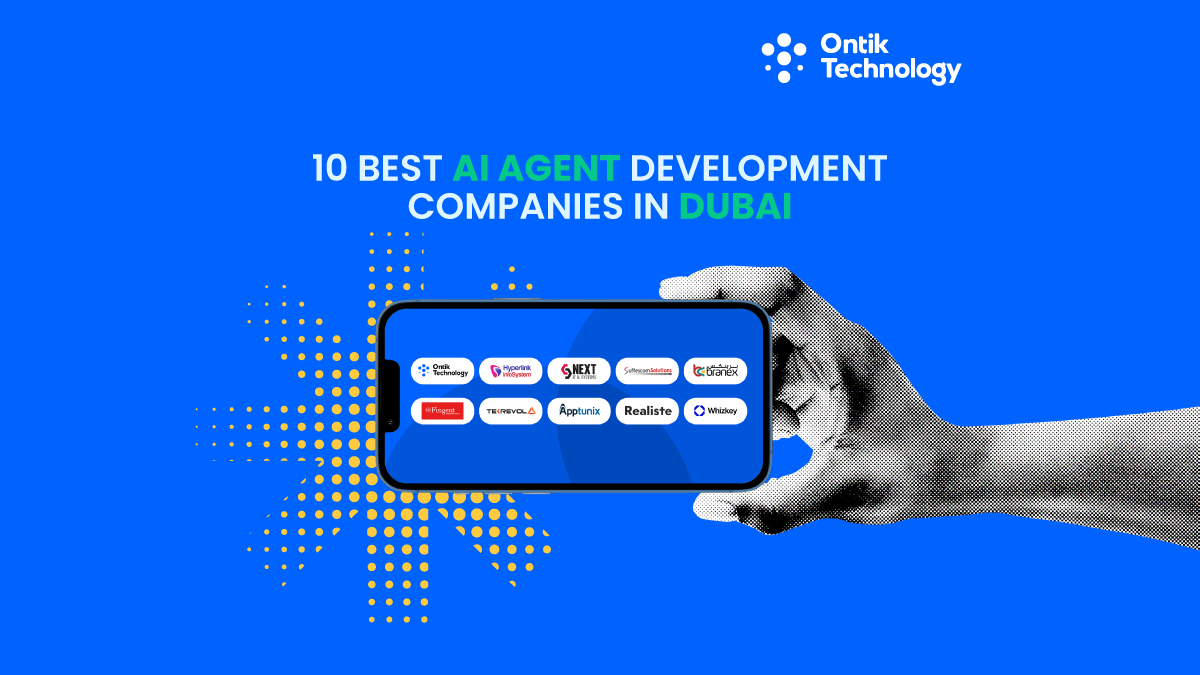

Key Takeaways
- Dubai is a global hub for agentic AI, backed by $100B+ investment, strong government support, and a fast-growing enterprise adoption ecosystem.
- Agentic AI goes beyond automation by enabling autonomous reasoning, planning, and decision-making without constant human input.
- Leading Dubai-based AI companies specialize in generative AI, multi-agent systems, machine learning, NLP, and computer vision across industries.
- Choosing the right AI partner requires focus on real delivery experience, regulatory knowledge, MLOps maturity, and business alignment.
- Successful AI adoption starts with focused MVPs, strong data pipelines, and scalable architecture, not over-engineered solutions.
Dubai commits over $100 billion to artificial intelligence, establishing itself as a global technology leader. More than 800 AI companies now operate across finance, retail, healthcare, and logistics, driving measurable transformation throughout the emirate.
Agentic AI marks a fundamental evolution beyond traditional automation. These systems reason independently, plan strategically, and adapt autonomously to changing conditions, making decisions without waiting for human instructions.
Real-world results validate this investment. Emirates NBD delivers 24/7 customer service through intelligent chatbots. DP World optimizes port operations using predictive analytics. Dubai Customs eliminated thousands of manual work hours with AI productivity engines.
Government initiatives accelerate adoption. The Dubai AI Roadmap 2031 and Smart Dubai provide strategic direction and funding. Free zones offer tax incentives and simplified regulations. This guide examines top agentic AI development companies in Dubai, evaluating technical expertise, delivery records, and capabilities across generative AI, machine learning, and computer vision services.
What is Agentic AI and AI Development Services?
Agentic AI refers to autonomous systems that think, plan, and act independently. These intelligent agents go far beyond simple automation. They understand context, evaluate multiple options, and execute complex tasks without constant human supervision.
Traditional AI follows predefined rules and patterns. You program it to respond to specific inputs with predetermined outputs. Agentic AI breaks free from these limitations. It assesses situations dynamically, considers various strategies, and chooses optimal actions based on its training and defined goals.
AI development services encompass the complete spectrum of building intelligent solutions for businesses. Machine learning services involve supervised, unsupervised, and reinforcement learning techniques. Natural language processing services enhance communication and content understanding across platforms. Computer vision services focus on image recognition, object detection, and visual analytics that transform how companies process visual data.
A practical example clarifies this distinction effectively. A traditional customer service bot answers frequently asked questions by matching queries to a static database. An agentic AI customer service agent understands nuanced customer intent, accesses multiple data sources simultaneously, resolves complex issues through reasoning, and escalates appropriately without any human intervention.
Key differences between traditional and agentic approaches:
- Traditional AI responds only to direct commands while agentic AI initiates actions independently
- Traditional systems follow rigid predetermined rules while agentic systems adapt strategies based on context
- Traditional AI requires constant human input while agentic AI operates autonomously for extended periods
- Traditional models handle single isolated tasks while agentic systems manage complex interconnected workflows
- Traditional AI cannot learn from unexpected situations while agentic systems improve through experience
Artificial intelligence companies in Dubai build both types of systems depending on business needs. However, the shift toward agentic models accelerates as organizations demand more sophisticated automation. AI development companies create predictive analytics services to help businesses make data-driven decisions faster. They deploy generative AI services including intelligent chatbots, automated content generation, and video creation solutions.
The software development company landscape in Dubai now prioritizes seamless integration of AI capabilities. Custom software development projects increasingly incorporate machine learning algorithms and intelligent automation features. This transformation touches every sector from banking apps with fraud detection to e commerce platforms with personalized recommendations.
The Rise of AI Development in Dubai
Dubai positions itself aggressively as a global AI innovation hub. The government launched the UAE AI Strategy with an ambitious goal to make the country a world leader in artificial intelligence by 2031. This comprehensive plan touches education, transportation, healthcare, government services, and economic development.
Smart Dubai initiatives demonstrate tangible commitment to this vision. The Ministry of Health and Prevention uses AI for diagnostic support and healthcare solutions. Dubai actively tests autonomous vehicle integration and intelligent traffic management systems. Government agencies integrate AI to enhance citizen services and streamline operations.
The tech industry in Dubai benefits from several structural advantages. The city offers strategic geographic positioning between Eastern and Western markets. It provides access to world class talent recruited from across the globe. Multiple free zones deliver substantial tax benefits and simplified business setup processes.
Major technology players recognize Dubai's potential. Microsoft has invested $10 billion in OpenAI, advancing AI capabilities worldwide. NVIDIA commands 87% of the GPU market, providing crucial hardware for AI technologies. Apple stands as the largest AI company by market capitalization as of 2024.
Key factors driving AI growth in Dubai:
- Over $100 billion committed to AI infrastructure and development initiatives
- More than 800 companies actively deploying AI solutions across various sectors
- Government-backed programs including Dubai 2030 vision and UAE Digital Government strategy
- Strategic free zones like Dubai Internet City, DIFC Innovation Hub, and Hub71
- Advanced telecommunications and cloud infrastructure supporting AI workloads
- Access to regional markets across Middle East, Africa, and South Asia
- Growing ecosystem of AI talent, researchers, and specialized developers
Local champions emerge alongside global giants. G42 operates as a national-scale AI and cloud computing company focusing on large-scale solutions. Saal.ai provides data-driven cognitive solutions specifically for defense, healthcare, and finance sectors. These firms prove that artificial intelligence expertise grows rapidly within the region itself.
Digital transformation accelerates across various industries throughout the UAE. Retail platforms like Noon and Amazon.ae deploy AI for personalized shopping experiences. Banking institutions employ intelligent systems for real-time fraud detection and sophisticated risk assessment. Logistics companies optimize delivery routes and predict demand patterns with remarkable accuracy.
How to Choose the Right Agentic AI Development Company in Dubai
Selecting the right AI development company requires systematic evaluation beyond marketing claims. You need a reliable partner who delivers intelligent solutions aligned with your business goals. The wrong choice leads to wasted resources and missed opportunities.
Start by verifying genuine local presence and deep regulatory knowledge. Companies operating in Dubai must understand UAE data protection laws and evolving compliance requirements. They should demonstrate proven familiarity with industry-specific regulations governing finance, healthcare, or government sectors.
Technical expertise matters significantly for project success. Request detailed case studies showing completed AI projects with measurable business outcomes. A strong artificial intelligence company showcases successful implementations across different industries. They provide transparent timelines and clearly explain their development methodology.
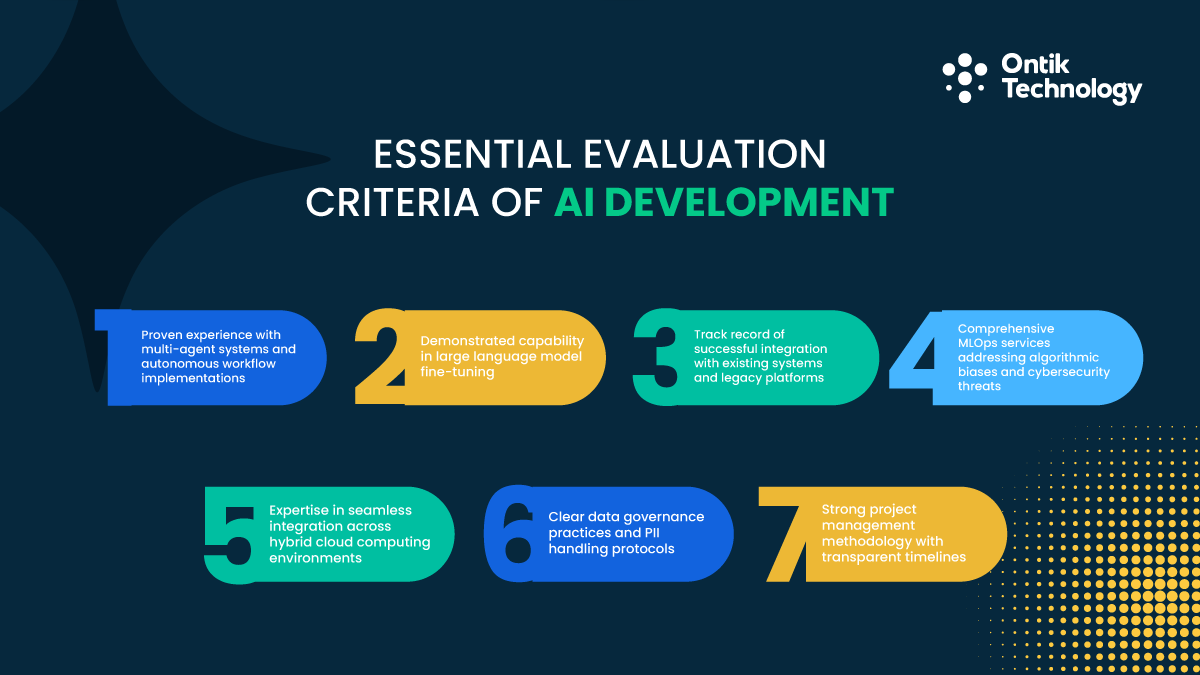
Essential evaluation criteria include:
- Proven experience with multi-agent systems and autonomous workflow implementations
- Demonstrated capability in large language model fine-tuning and deployment
- Track record of successful integration with existing systems and legacy platforms
- Comprehensive MLOps services addressing algorithmic biases and cybersecurity threats
- Expertise in seamless integration across hybrid cloud computing environments
- Clear data governance practices and PII handling protocols
- Strong project management methodology with transparent timelines
Evaluate their technology stack and strategic partnerships carefully. Leading companies work with cutting edge technology from OpenAI, Google, Microsoft, and other AI research leaders. They understand when to recommend proprietary models versus open-source alternatives. Their teams stay current with emerging technologies through continuous learning.
Assessment criteria should include proven project management capabilities. The best development company partners demonstrate clear communication patterns and collaborative problem solving skills. They involve you in critical decisions while independently handling technical complexities.
Critical red flags to watch for:
- Companies lacking documented case studies or published technical white papers
- Firms promising unrealistic timelines without proper discovery phases
- Vendors unable to explain their data governance and security practices
- Providers focusing exclusively on technology without understanding business strategy
- Companies with no references from clients in similar industries
Cost transparency proves essential for establishing trust. Reputable firms provide detailed breakdowns of project scope and comprehensive pricing structures. They explain specific cost drivers including data preparation, model training, cloud infrastructure, and ongoing maintenance. Hidden fees indicate potential problems down the road.
Top 10 Agentic AI Development Companies in Dubai, UAE
Dubai hosts numerous AI companies competing across sectors with varying capabilities. We evaluated firms based on agentic AI expertise, verified project delivery records, technical depth, and documented client success stories. The following companies represent the strongest options for building autonomous intelligent systems.
1. Ontik Technology

Ontik Technology leads in custom AI and machine learning development for enterprise clients worldwide. With 220+ successful projects across 20+ countries, they specialize in intelligent automation that addresses complex business challenges with measurable results—clients report 35% cost savings, 48% faster procurement cycles, and 58% increased engagement.
Core AI Capabilities: Their expertise spans generative AI implementation, advanced machine learning, and natural language processing. They build AI agents that integrate seamlessly into existing systems, delivering solutions through MVP development, dedicated teams, and custom software development.
Comprehensive Technology Services: Beyond AI, Ontik offers web development, mobile app development, blockchain solutions, UI/UX design, business intelligence, and cloud solutions.
Key Strengths:
- Transparent project management with clear milestone tracking
- Proven on-schedule delivery with 99.95% platform uptime achievements
- Comprehensive MLOps practices ensuring production reliability
- Strong presence in Dubai's software market and AI chatbot solutions
- Flexible staff augmentation services with full team setup in 2 weeks
Industries Served: Finance, healthcare, retail, real estate, and logistics benefit from their domain expertise and agile, collaborative approach.
Recognized by Stanford Seed Spark Program and as a Top 100 Finalist in Google Cloud's AI For Impact challenge, Ontik combines technical excellence with practical business acumen to deliver transformative solutions.
2. Hyperlink InfoSystem
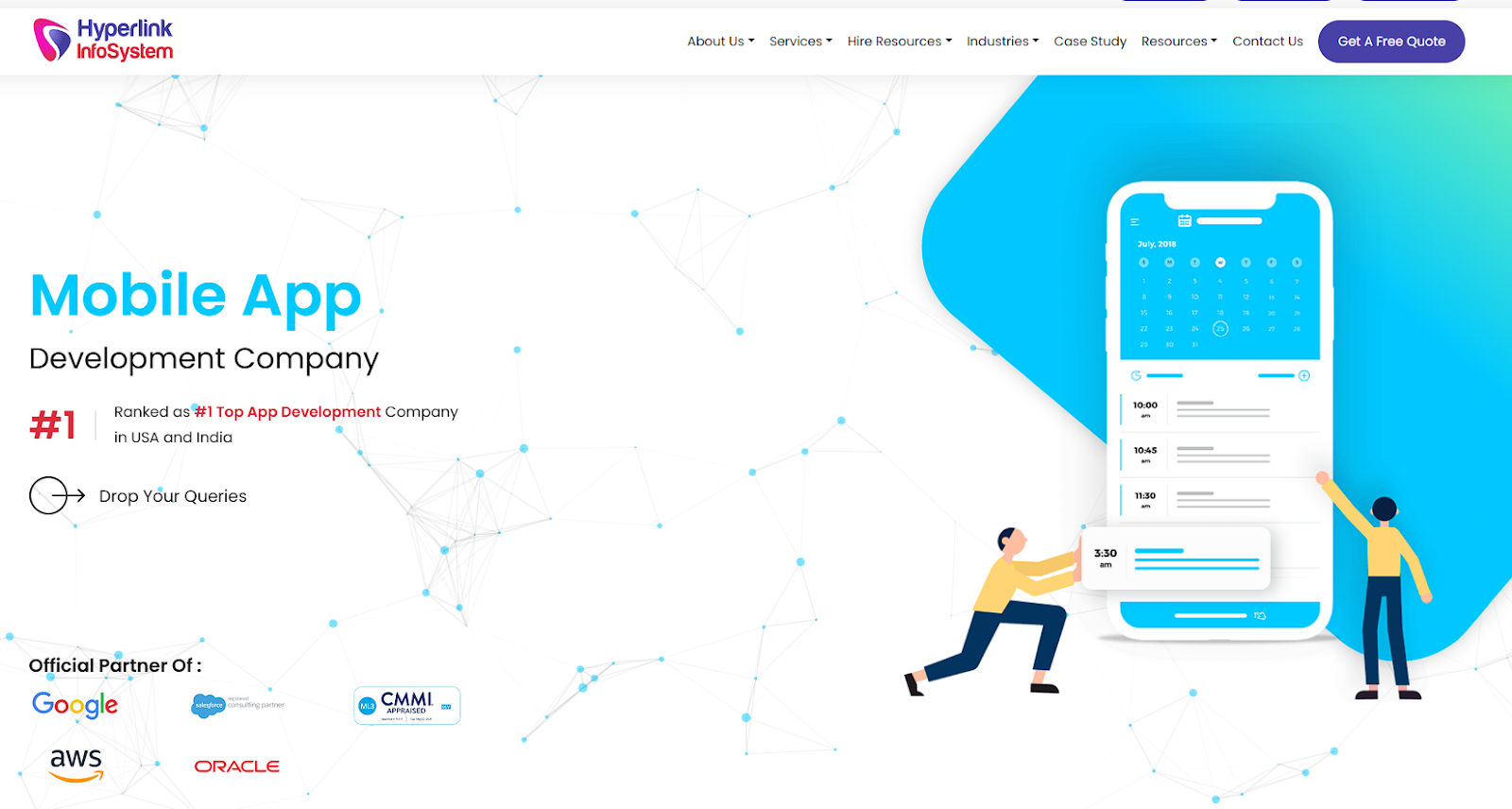
Hyperlink InfoSystem operates as a global software development company with substantial AI capabilities. They have completed over 1,500 transformative projects since their founding in 2009. Their Dubai presence serves clients across the Middle East region with localized support.
The firm specializes in AI powered mobile apps and comprehensive web development solutions. They build sophisticated predictive analytics platforms, intelligent voice assistants, and advanced computer vision applications. Their teams handle high-volume enterprise AI builds while maintaining consistent quality standards.
Notable features and services:
- Proven delivery speed with extensive portfolio demonstrating versatility
- Cost effective solutions without compromising on innovation or quality
- Experience across e commerce, banking, healthcare, and education sectors
- Dedicated teams organized by technology stacks and industry verticals
- Strong emphasis on user experience and practical functionality
3. Next UAE
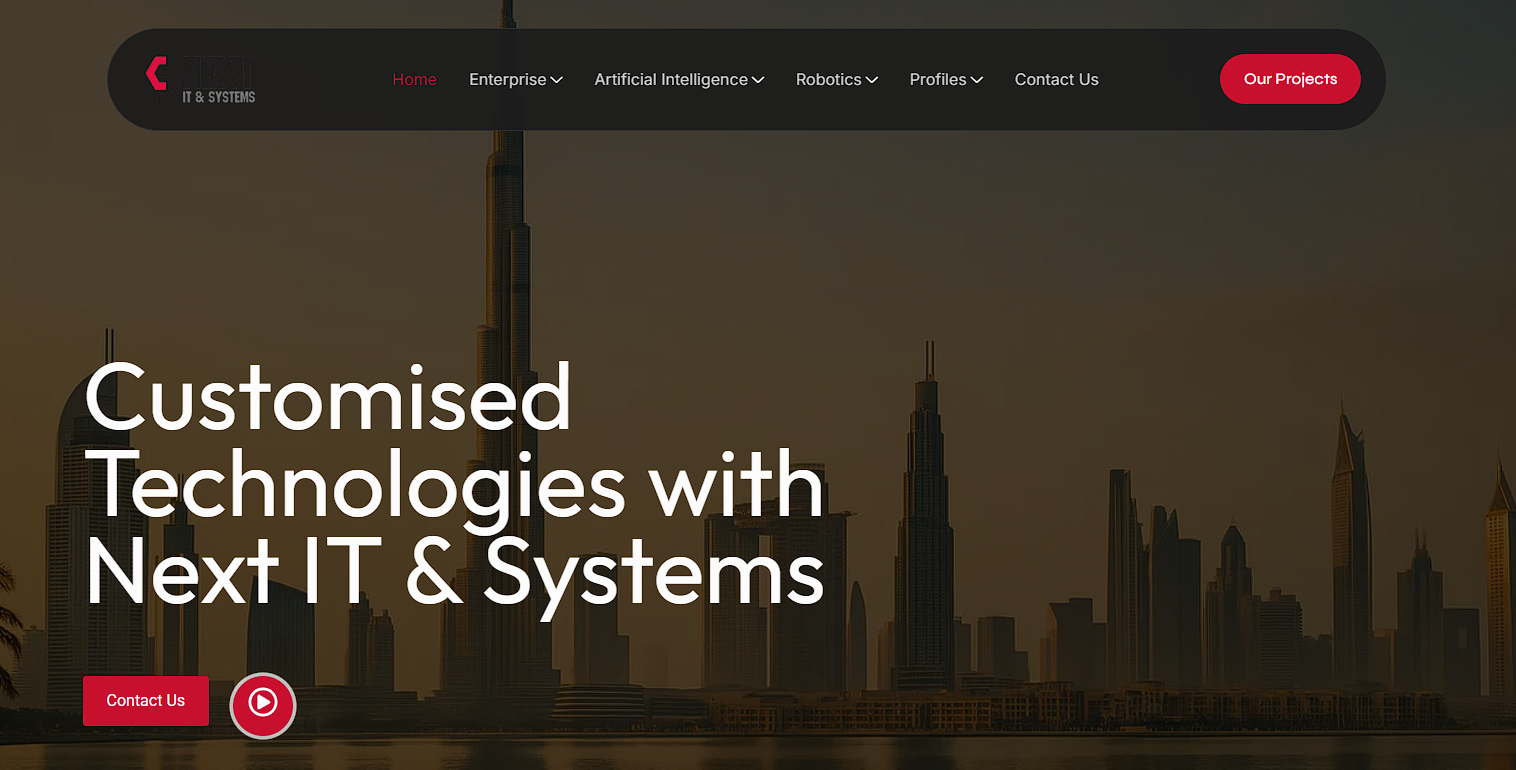
Next UAE positions itself as a comprehensive technology solutions provider with deep local roots. They offer custom software development, digital solutions, and strategic AI integration services. Their approach combines intimate local market knowledge with access to global technological solutions.
The company focuses on helping businesses navigate digital transformation through practical artificial intelligence applications. They build intelligent solutions that genuinely streamline operations and measurably improve customer engagement. Their services span from initial strategy development through complete implementation.
Core advantages include:
- Deep understanding of unique UAE market dynamics and business culture
- Effective navigation of local regulations and compliance requirements
- Consultative approach focusing on solving real problems over technology trends
- Pragmatic methodology resulting in higher user adoption rates
- Primary industries: government agencies, real estate, hospitality, retail
4. Suffescom Solutions
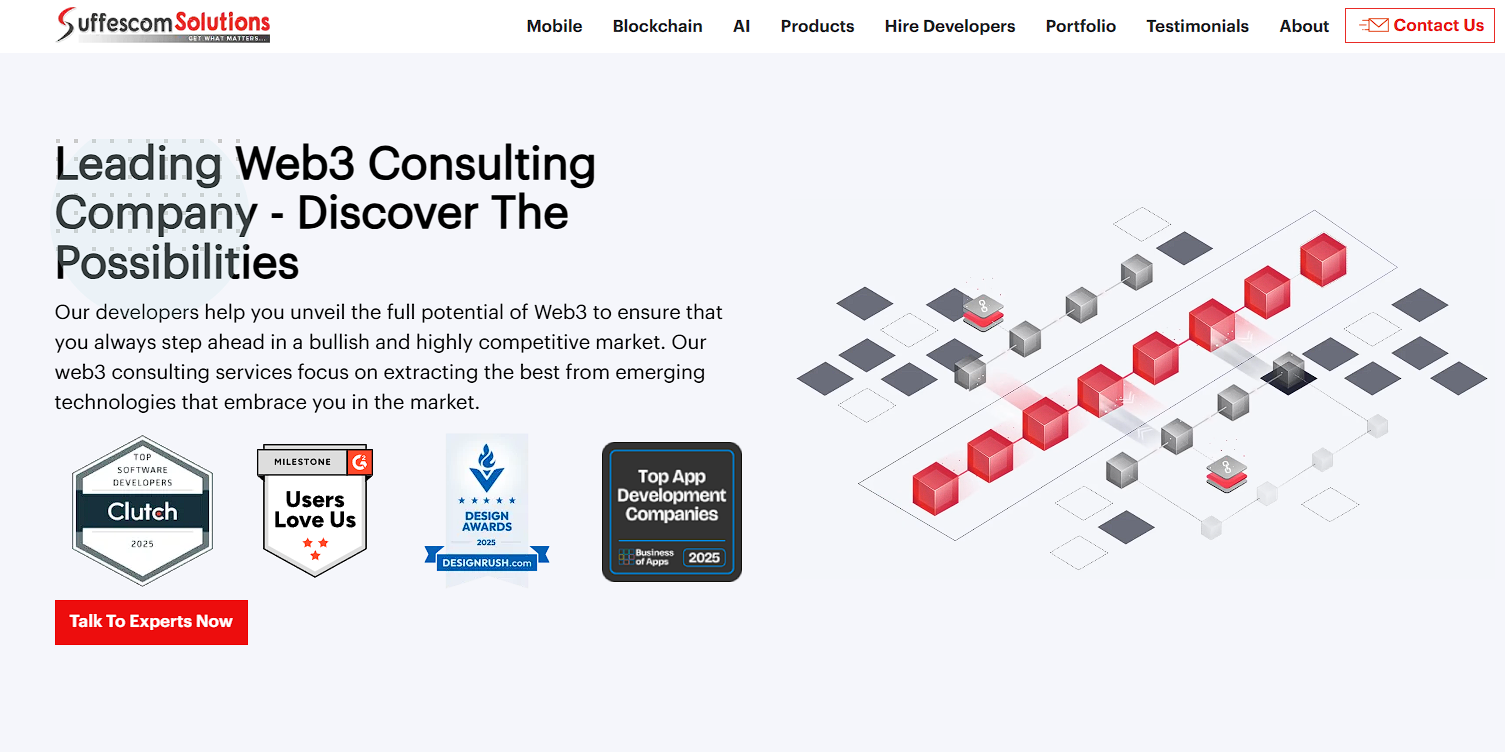
Suffescom Solutions operates across software development and multiple emerging technology domains. They build enterprise AI systems, blockchain solutions, and innovative metaverse applications. Their AI practice emphasizes automation tools and intelligent process optimization that reduces costs.
The company develops AI software for diverse industries with strong emphasis on scalability. They handle entire project lifecycles from initial concept through final deployment. Their technical teams actively stay current with AI research and evolving implementation best practices.
Key differentiators:
- Strong capabilities in complex system integration across platforms
- Successful combination of AI with complementary technologies like IoT and blockchain
- Experience with enterprise-level deployments reflected in robust architecture
- Comprehensive documentation and knowledge transfer programs
- Focus areas: supply chain management, manufacturing, finance, gaming
5. Branex

Branex operates as a full-service digital agency with specialized AI capabilities and creative strength. They combine creative design excellence with solid technical development to deliver engaging digital experiences. Their AI practice focuses on enhancing user interactions and intelligently personalizing content.
The firm builds AI driven solutions for both web and mobile platforms with emphasis on user experience. They integrate natural language processing for improved communication between systems and users. Their teams create intelligent dashboards that transform complex data into actionable insights.
What sets them apart:
- Excellence at making sophisticated AI accessible and genuinely user-friendly
- Design-first approach resulting in intuitive interfaces for complex systems
- Ability to explain technical concepts clearly in business terms
- Strong creative applications of AI technology beyond standard implementations
- Specialized in marketing agencies, media companies, corporate websites, consumer apps
6. Fingent
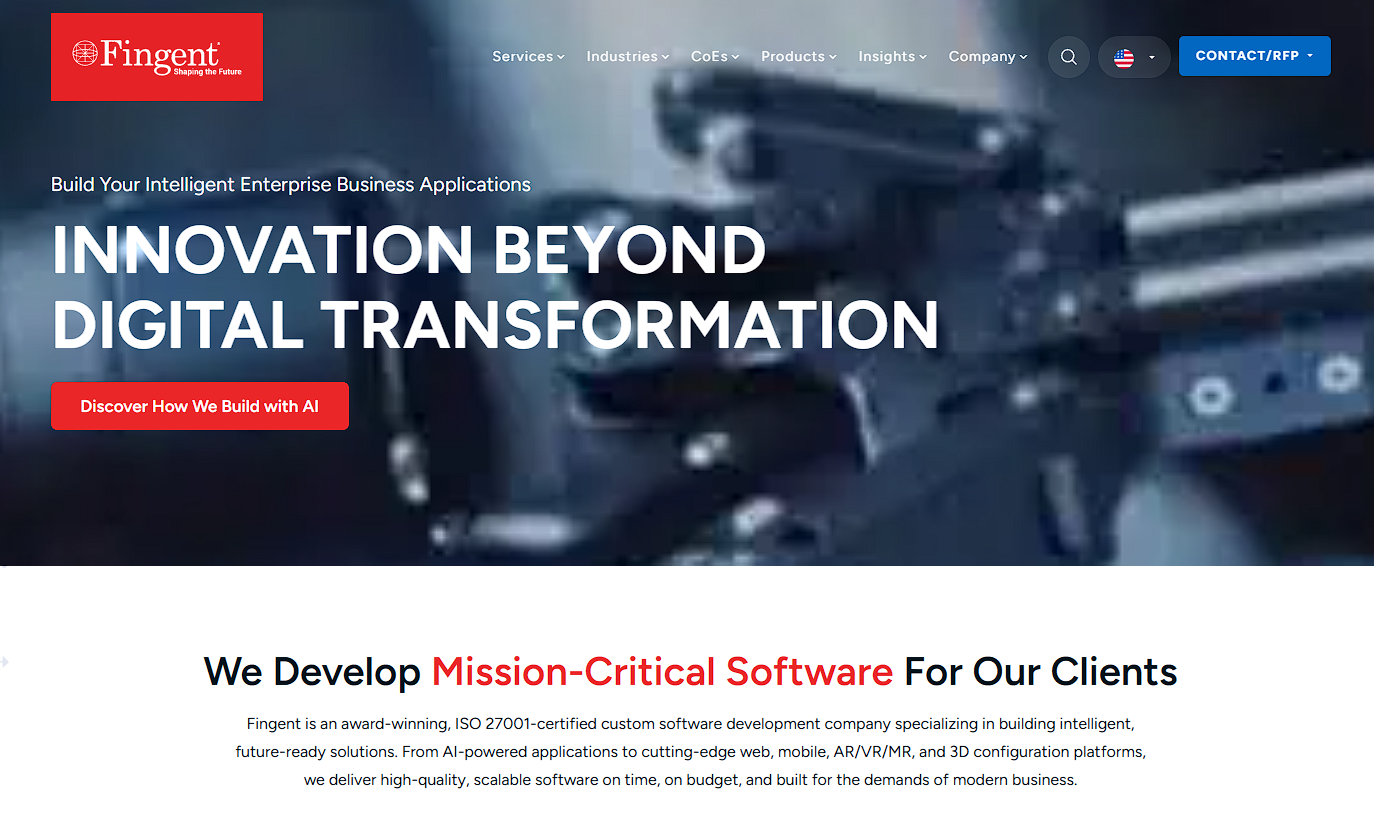
Fingent brings over two decades of custom software development experience to the AI space. They have evolved into a leading AI development company serving enterprise clients across global markets. Their Dubai operations focus specifically on AI implementation tailored for Middle East business requirements.
The company specializes in strategic AI integration that solves clearly defined business challenges. They build accurate predictive models, automate complex workflows, and enhance decision-making systems. Their consulting services help organizations develop comprehensive AI strategies aligned with business objectives.
Primary strengths:
- Deep industry knowledge across heavily regulated sectors
- Understanding of complex compliance requirements and data governance needs
- Enterprise focus enabling effective handling of complex stakeholder requirements
- Strong technical documentation supporting long-term system maintenance
- Key industries: healthcare, financial services, manufacturing, transportation
7. Tekrevol
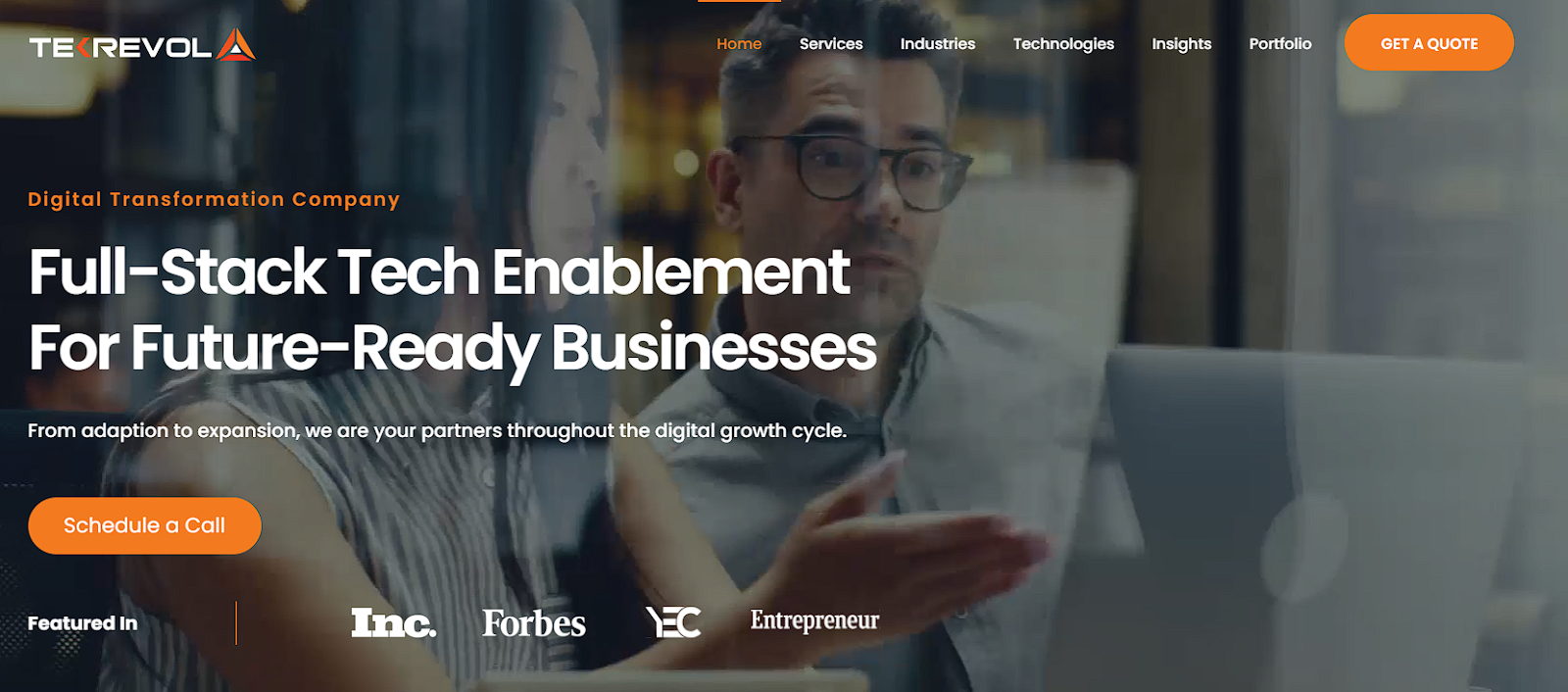
Tekrevol operates as a mobile-first development company with impressive AI capabilities. They build app development solutions that strategically leverage machine learning and intelligent automation. Their dedicated focus on mobile platforms differentiates them in the competitive market.
The company creates sophisticated AI powered features specifically optimized for consumer and enterprise mobile apps. They implement smart recommendation engines, predictive analytics, and natural language interfaces. Their teams optimize ruthlessly for performance on mobile devices and varying network conditions.
Distinguishing features:
- Excellence at creating engaging mobile experiences powered by AI
- Deep understanding of mobile user behavior patterns and expectations
- Rapid development cycles suitable for startups testing new concepts
- Strong client reviews highlighting creativity plus reliable execution
- Expertise across iOS, Android, and cross-platform development frameworks
8. Apptunix

Apptunix positions itself as an innovation-focused development company embracing emerging technologies. They build digital products that incorporate the latest AI and machine learning capabilities. Their comprehensive services span mobile apps, web platforms, and enterprise software solutions.
The firm develops intelligent solutions for businesses actively seeking competitive advantages through technology. They create AI systems that continuously learn from user behavior and optimize automatically. Their approach emphasizes measurable business outcomes over innovation for its own sake.
Notable characteristics:
- Strong combination of technical skills with business understanding
- Projects framed around specific goals like cost reduction or satisfaction improvement
- Iterative development approach allowing adjustments based on early results
- Dedicated teams matched to appropriate expertise for each project
- Primary sectors: retail, healthcare, logistics, education, entertainment
9. Realiste AI

Realiste AI specializes exclusively in artificial intelligence and machine learning solutions. They focus on building production-ready AI systems designed for demanding enterprise environments. Their boutique approach enables deep customization and exceptional attention to technical details.
The company develops sophisticated AI agents, automated workflows, and intelligent decision support systems. They excel particularly at natural language processing and computer vision applications requiring advanced capabilities. Their team includes AI researchers who actively contribute to advancing the field.
Core competencies:
- Deep technical expertise in cutting edge AI methods and research
- Ability to handle complex challenges requiring advanced techniques
- Research background ensuring they remain at forefront of AI innovation
- Collaborative approach creating sustainable long-term implementations
- Specialized focus: financial services, legal technology, healthcare, research institutions
10. Whizkey

Whizkey operates as a comprehensive technology partner for businesses navigating digital transformation. They provide AI development services alongside broader IT solutions and infrastructure support. Their integrated approach addresses infrastructure, applications, and intelligent automation together cohesively.
The company builds AI systems that measurably enhance operational efficiency across various business functions. They automate repetitive tasks, provide predictive insights, and improve decision-making processes. Their services include strategy consulting, hands-on implementation, and ongoing support.
Value propositions:
- Understanding of challenges facing mid-market companies adopting AI
- Accessible entry points without overwhelming clients with complexity
- Bundled services simplifying vendor management and accountability
- Patient approach to change management and user training
- Target markets: SMEs, government agencies, professional services, manufacturing
Emerging Agentic AI Trends in Dubai and UAE for 2025
The AI landscape evolves rapidly as generative AI moves decisively from experimentation to production deployment. Dubai businesses now implement multi-agent systems where multiple AI models coordinate seamlessly. These orchestrated solutions handle complex workflows that previously required extensive human intervention.
Autonomous workflow automation represents a transformative trend across sectors. Companies deploy AI agents that manage complete end-to-end business processes independently. These systems continuously monitor performance, proactively identify bottlenecks, and adjust operations automatically.
Enterprise AI adoption accelerates particularly across regulated industries with strict compliance requirements. Financial institutions deploy sophisticated AI for fraud detection, nuanced risk assessment, and personalized customer service. Healthcare organizations leverage AI for diagnostic support and patient care optimization.
Major trends shaping 2025 include:
- Multi-agent orchestration enabling systems where multiple AI agents collaborate on complex problems
- Agentic RPA combining robotic process automation with reasoning and adaptive capabilities
- Private LLMs allowing organizations to deploy proprietary language models for enhanced data security
- AI-powered analytics delivering real-time insights that drive immediate business decisions
- Sector-specific solutions tailored precisely for finance, real estate, logistics, and healthcare
- AI copilots working alongside employees to enhance productivity across functions
- Autonomous decision systems making operational choices without human approval
AI copilots emerge as powerful productivity enhancers throughout organizations. These intelligent assistants work directly alongside employees, efficiently handling routine tasks and providing contextual recommendations. They access multiple data sources simultaneously and draft initial responses. Human workers focus their energy on strategic decisions while AI handles operational details.
Dubai's government continues aggressively driving adoption through the comprehensive UAE AI Strategy. The Smart Dubai initiative expands AI integration systematically across city services. This creates a valuable testing ground for innovative applications that later scale regionally and globally.
Natural resources sectors actively explore promising AI applications beyond traditional tech industries. Energy companies deploy predictive maintenance systems to reduce costly downtime. Environmental monitoring programs employ computer vision for precise tracking and analysis.
The tech companies in Dubai ecosystem matures with increased collaboration between stakeholders. Startups partner strategically with established firms to bring innovations to market faster. Universities and research institutions contribute meaningfully to AI research addressing specific regional challenges.
Comparing Top AI Companies: Capabilities and Specializations
Choosing among top AI companies requires understanding their unique strengths and specializations. Each firm brings different capabilities, industry focus, and service approaches to projects. This comparison helps you match company expertise precisely with your specific needs.
Project delivery timelines vary significantly by company capabilities and project scope. Simple AI implementations typically require 8 to 12 weeks from kickoff to deployment. Complex enterprise systems demand 20 to 28 weeks for complete implementation. Most companies offer phased approaches that deliver incremental value.
Technical capabilities differ substantially across providers. Some firms excel specifically at natural language processing for conversational interfaces. Others specialize in computer vision for visual analytics and recognition tasks. Still others focus on predictive analytics for forecasting and optimization.
Key differentiation factors include:
- Industry experience with some companies focused on finance while others serve retail or healthcare
- Company size impacting service delivery with larger firms offering comprehensive services
- Geographic presence affecting collaboration quality and understanding of local business culture
- Technology partnerships determining access to cutting edge tools and preferential pricing
- Support models ranging from basic maintenance to comprehensive optimization programs
Company size significantly impacts service delivery models. Larger software development firms offer comprehensive services spanning strategy through maintenance. Boutique AI companies provide highly personalized attention and customization. Match company scale appropriately to your project requirements and ongoing support needs.
AI Development Cost in Dubai
Understanding AI development costs helps you budget appropriately and evaluate vendor proposals effectively. Prices vary considerably based on project scope, technical complexity, and company expertise. Dubai rates reflect the city's position as a premium technology market with access to global talent.
Discovery and strategy phase typically costs AED 30,000 to 90,000. This covers business analysis, technical feasibility assessment, and roadmap development. Smart companies invest here to reduce implementation risks significantly.
Proof of concept projects running 4 to 8 weeks range from AED 70,000 to 250,000. You validate core assumptions and test critical functionality. This phase proves technical viability before full investment commitment.
MVP development taking 8 to 16 weeks costs AED 200,000 to 650,000. You build a working system with essential features. Early user feedback guides further development priorities effectively.
Enterprise rollout requiring 16 to 28 weeks ranges from AED 600,000 to 1,800,000 or more. Full-scale implementation includes integration, testing, training, and deployment across the organization.
Ongoing MLOps and maintenance runs AED 25,000 to 120,000 monthly. This covers monitoring, retraining, optimization, and support to keep systems performing well.
Major cost drivers in AI projects:
- Data preparation including cleaning, labeling, and organizing datasets consuming 40 to 60 percent of budgets
- Model complexity with sophisticated multi-agent systems costing more than simple classification
- Infrastructure expenses covering cloud computing, storage, and API usage
- Token pricing for services like OpenAI adding ongoing operational costs
- Integration complexity when connecting to existing systems and legacy platforms
- Compliance requirements adding security measures and audit capabilities
- Team expertise with senior AI architects commanding premium rates
- Testing and validation ensuring accuracy, fairness, and reliability
Ongoing infrastructure costs include cloud, storage, and API expenses, alongside token pricing for services like OpenAI and data volume/query frequency charges for vector databases (e.g., Pinecone, Weaviate).
Integrating AI into existing, often legacy, systems significantly raises budgets, requiring custom connectors and increasing complexity across multiple platforms. Compliance requirements also add considerable costs in regulated sectors, such as specific data handling for PDPL, enhanced security/audit trails for banking, and stringent medical data protection for healthcare.
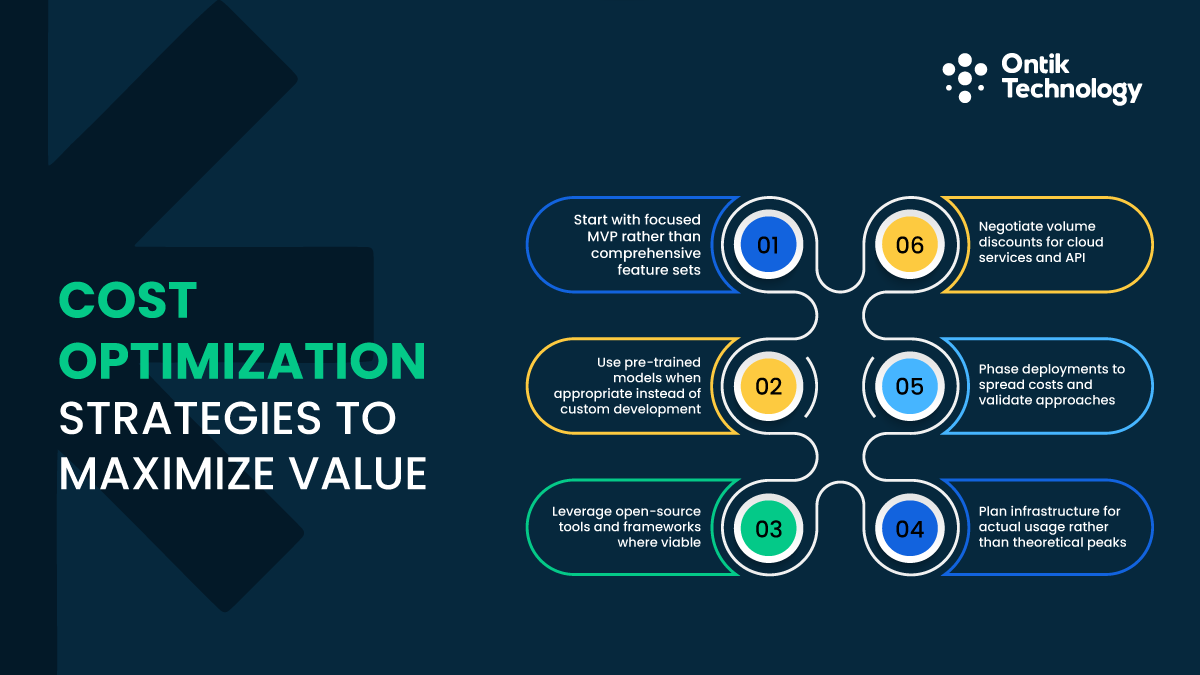
Cost optimization strategies to maximize value:
- Start with focused MVP rather than comprehensive feature sets
- Use pre-trained models when appropriate instead of custom development
- Leverage open-source tools and frameworks where viable
- Plan infrastructure for actual usage rather than theoretical peaks
- Phase deployments to spread costs and validate approaches
- Negotiate volume discounts for cloud services and API usage
Hidden costs frequently surprise organizations without AI experience. Change management and training require substantial investment beyond pure technology. User adoption programs ensure people actually use new AI systems effectively. Ongoing optimization maintains performance as business conditions evolve.
Tech Stack Used by Top AI Development Companies in Dubai
Artificial intelligence companies in Dubai employ sophisticated technology stacks to build robust, scalable AI solutions. Understanding these tools helps you evaluate vendor capabilities realistically and make informed decisions about your AI projects.
Foundation models like OpenAI's GPT, Meta's Llama (open-source), and Google's multimodal Gemini power most AI applications. Frameworks simplify development: LangChain manages prompts and chains AI operations, Microsoft's AutoGen builds multi-agent systems, and CrewAI orchestrates teams of AI agents for shared goals.
Programming languages and runtime environments provide the foundation for implementation. Python dominates AI development due to its extensive libraries and active community support. Node.js serves well for building APIs and integrating AI into web applications. TypeScript adds valuable type safety for larger codebases.
Core technology components include:
- Foundation models: OpenAI GPT, Meta Llama, Google Gemini for language understanding
- AI frameworks: LangChain for LLM applications, AutoGen for multi-agent systems, CrewAI for orchestration
- Programming languages: Python for AI development, Node.js for APIs, TypeScript for type safety
- Vector databases: Pinecone for managed search, Weaviate for hybrid capabilities, ChromaDB for open-source
- Cloud platforms: AWS UAE region, Microsoft Azure, Google Cloud Platform for infrastructure
- Development tools: Docker and Kubernetes for deployment, GitHub Actions for automation
Vector databases store and retrieve embeddings efficiently for semantic search. Pinecone provides managed vector search at impressive scale. Weaviate combines vector search capabilities with traditional database features. ChromaDB offers open-source options for organizations preferring self-hosted solutions.
AWS is strong in the UAE with local data centers for data residency. Azure suits enterprises using Microsoft ecosystems. Google Cloud Platform offers unified AI and infrastructure. Data processing uses Apache Spark for distributed large datasets, Apache Kafka for high-throughput real-time streams, and dbt for transforming raw data into analytics-ready formats.
Development and deployment infrastructure includes:
- Containerization using Docker for consistent environments and Kubernetes for orchestration
- Automated pipelines with GitHub Actions or GitLab for testing and deployment
- Experiment tracking through MLflow or Weights & Biases for model development
- Monitoring systems using Prometheus and Grafana for observability
- Workflow orchestration via Apache Airflow for complex data pipelines
- Security management with HashiCorp Vault for secrets and encryption keys
Security and governance tools protect sensitive information and ensure compliance. HashiCorp Vault manages secrets and encryption keys securely. Apache Ranger provides fine-grained access control across data sources. Data lineage tools track how information flows through systems.
Testing frameworks verify AI system behavior across multiple dimensions. Pytest handles traditional software testing for code quality. Specialized tools evaluate model accuracy, fairness, and robustness comprehensively. Red-teaming techniques identify potential vulnerabilities and failure modes.
Final Thoughts
Dubai's AI ecosystem thrives with over 800 companies deploying intelligent solutions, backed by strong government support and advanced infrastructure. The shift toward agentic AI marks a fundamental transformation—these autonomous systems handle complex workflows independently, adapting to changing conditions without constant human intervention.
Selecting the right development partner demands scrutiny beyond marketing claims. Examine verified delivery records, technical expertise, and proven compliance knowledge. Remember that costs extend far beyond initial development—data preparation, ongoing optimization, and infrastructure require substantial investment.
Success hinges on five critical factors: robust data governance, appropriate model selection, comprehensive monitoring systems, clear business objectives, and organizational readiness for change. Industries from financial services to healthcare already demonstrate measurable benefits through fraud detection, personalized experiences, and predictive maintenance.
Smart organizations start focused, solving specific problems before scaling systematically. Strong data pipelines, rigorous testing, and proper MLOps practices ensure long-term performance. Connect with Dubai's leading AI chatbot solutions providers to transform potential into proven business value.
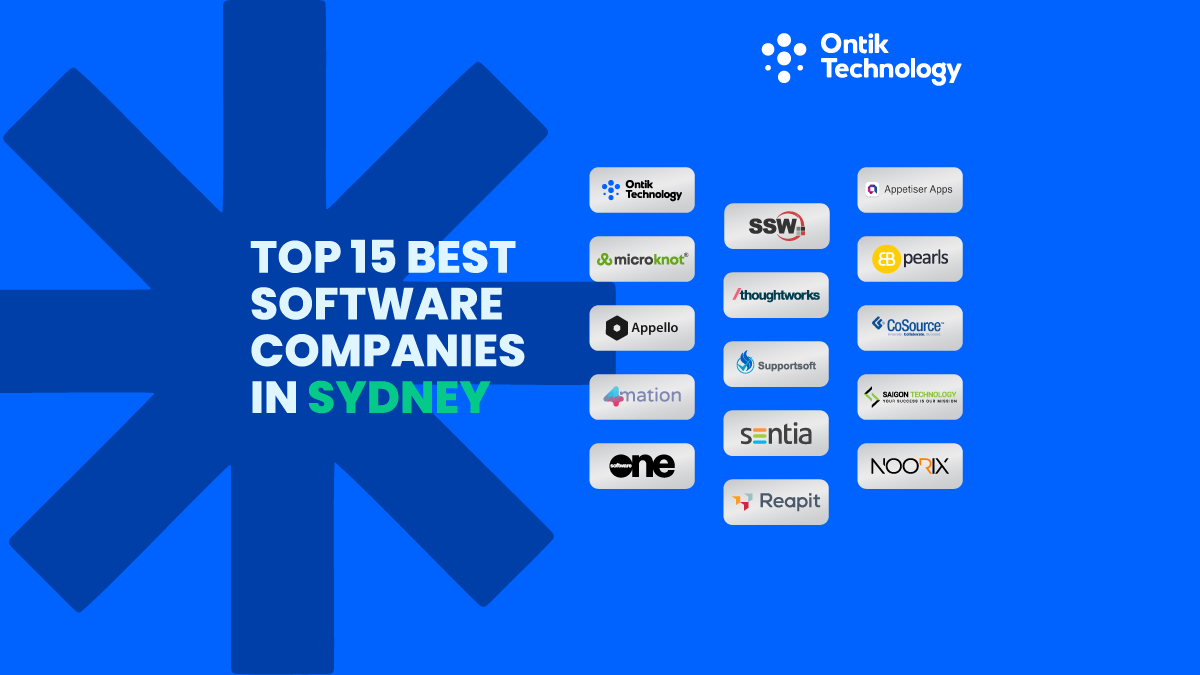

Key Takeaways
- Sydney is a leading Australian tech hub, with a fast-growing software market and deep talent pool across web, mobile, AI and enterprise solutions.
- The guide compares 15 top software development companies in Sydney, covering ratings, pricing, tech stacks, industries, and team sizes.
- Ontik Technology and several other firms offer strong AI, mobile, and custom software capabilities at competitive, startup-friendly rates.
- A clear checklist—experience, services, tech stack, portfolio, approach, pricing, and support- helps shortlist the right development partner.
- Typical Sydney projects range from AUD 10K to 100K+, with costs driven by scope, complexity, platform choice, tech stack, and post-launch support needs.
Sydney has rapidly become one of the fastest-growing tech hubs in the Southern Hemisphere. From AI-powered platforms to mobile apps, software development companies in Sydney are driving digital innovation across industries.
Australia's software development market reached USD 3.25 billion in 2024 and is projected to hit $17.15 billion by 2033. Sydney leads as the preferred base for top IT companies in Sydney. But choosing the right partner is challenging.
Not every software developer matches your vision, timeline, or budget. Some excel at custom software development, others at mobile app development or AI solutions. We have researched, compared portfolios, and analyzed reviews. This guide reveals the top 15 software development companies in Sydney redefining digital excellence in 2025. Let us find your perfect tech partner.
List of Top 15 Best Software Development Companies in Sydney
Below is a curated list of the best software development companies in Sydney, Australia. These firms have been evaluated based on ratings, expertise, case studies, plus client feedback. Each software development agency brings unique strengths to the table, from AI integration to blockchain development to mobile app development.
Here is a quick comparison to help you decide:
Now let us explore each software company in detail.
1. Ontik Technology

Ontik Technology is a forward-thinking software consulting and development company that prioritizes innovation, research, plus employee growth. Founded in 2016, the company has grown to a team of 50 to 249 highly skilled software developers. They specialize in a wide range of cutting-edge technologies, including web development, mobile app development, cloud computing, artificial intelligence, machine learning, blockchain, plus more.
Core Services
Ontik Technology offers a comprehensive suite of custom software development services designed to meet diverse business needs:
- AI Development (30%): Building intelligent chatbots, image analyzers, and personalized recommendation engines
- IT Staff Augmentation (20%): Providing skilled software developers to support your in-house teams
- Mobile App Development (20%): Creating scalable and secure mobile apps for iOS and Android app development
- Custom Software Development (10%): Tailoring solutions to meet specific business needs
- Web Development (10%): Delivering robust web platforms and SaaS products
- E-Commerce Development (5%): Building online stores with seamless payment integrations
- Low/No Code Development (5%): Rapid prototyping using modern no-code platforms
Why Ontik Technology Stands Out
Ontik Technology specializes in building scalable and secure mobile apps plus web platforms, including SaaS products and AI-powered solutions. As a leading provider in the software development agency space, they focus on delivering tailored solutions that align with client objectives. Their cost rating of 4.8 out of 5 reflects their commitment to delivering exceptional value.
With a minimum project size of $10,000 and hourly rates under $25, Ontik offers competitive pricing without compromising quality. Their team focuses on innovation plus research, ensuring that every solution is future-ready.
Notable Strengths:
- Deep expertise in AI and machine learning integration
- Affordable pricing models suitable for startups and SMEs
- Strong focus on employee growth translates to better project outcomes
- Expertise in blockchain and Web3 technologies
Ontik Technology serves clients globally, making them an ideal partner for businesses in Sydney, Australia looking for cost-effective yet high-quality custom software development.
2. Simform
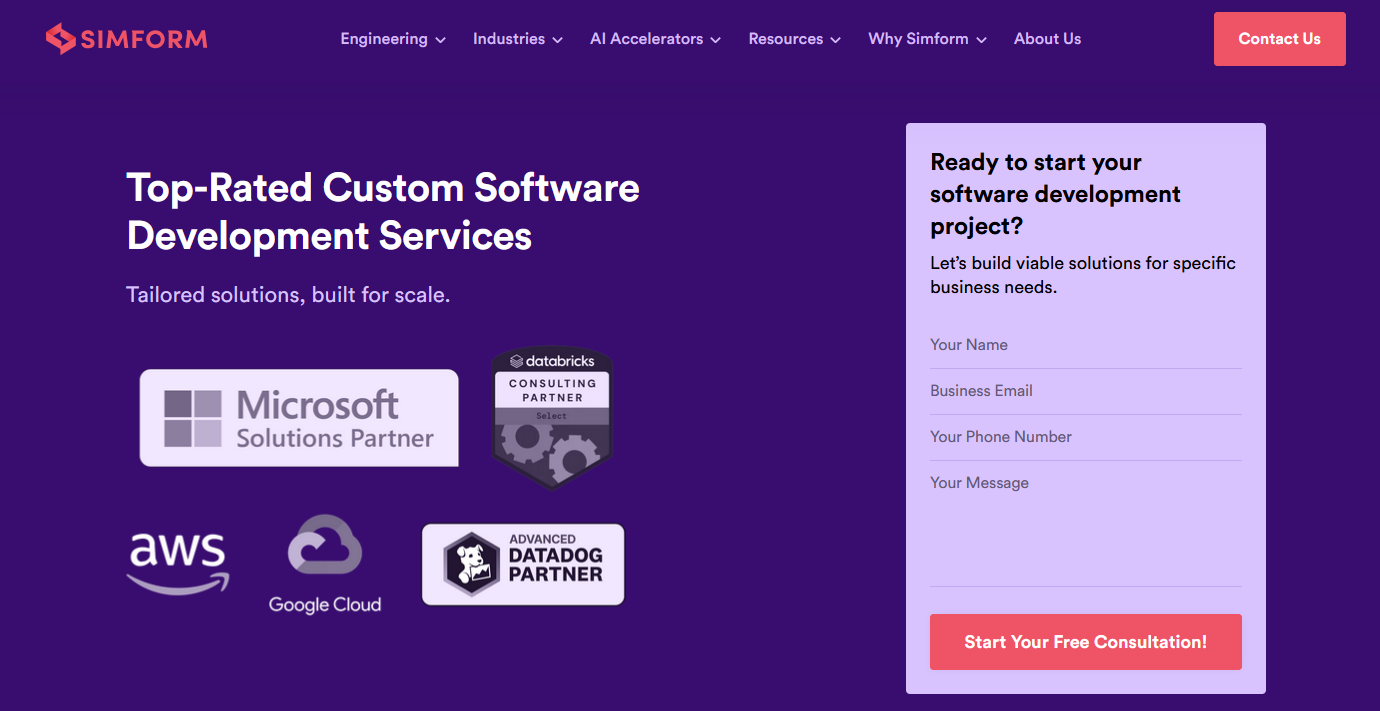
Simform delivers full-stack, end-to-end, and customized software development solutions. Rated 4.8 stars on Clutch (81 reviews), they are highly praised for technical expertise and communication, delivering innovative solutions across various industries.
Core Services
Simform provides a broad spectrum of custom software development services:
- Custom Software Development (10%)
- AI Development (10%)
- CRM Consulting and Systems Integration (plus 7 additional services)
- Cloud-based application development
- Quality assurance and testing services
- Business intelligence and data analytics solutions
Key Highlights
- Strong emphasis on effective communication
- Proven track record with global enterprises
- Agile methodologies enhance collaboration and rapidly achieve solutions
- Transparent project lifecycle management
- Focus on delivering tailored solutions that drive business outcomes
Simform serves Sydney software development clients and offers flexible engagement models, from fixed-price projects to dedicated development teams. Their commitment to continuous improvement keeps them at the industry forefront.
3. TechnoYuga Soft Pvt. Ltd.
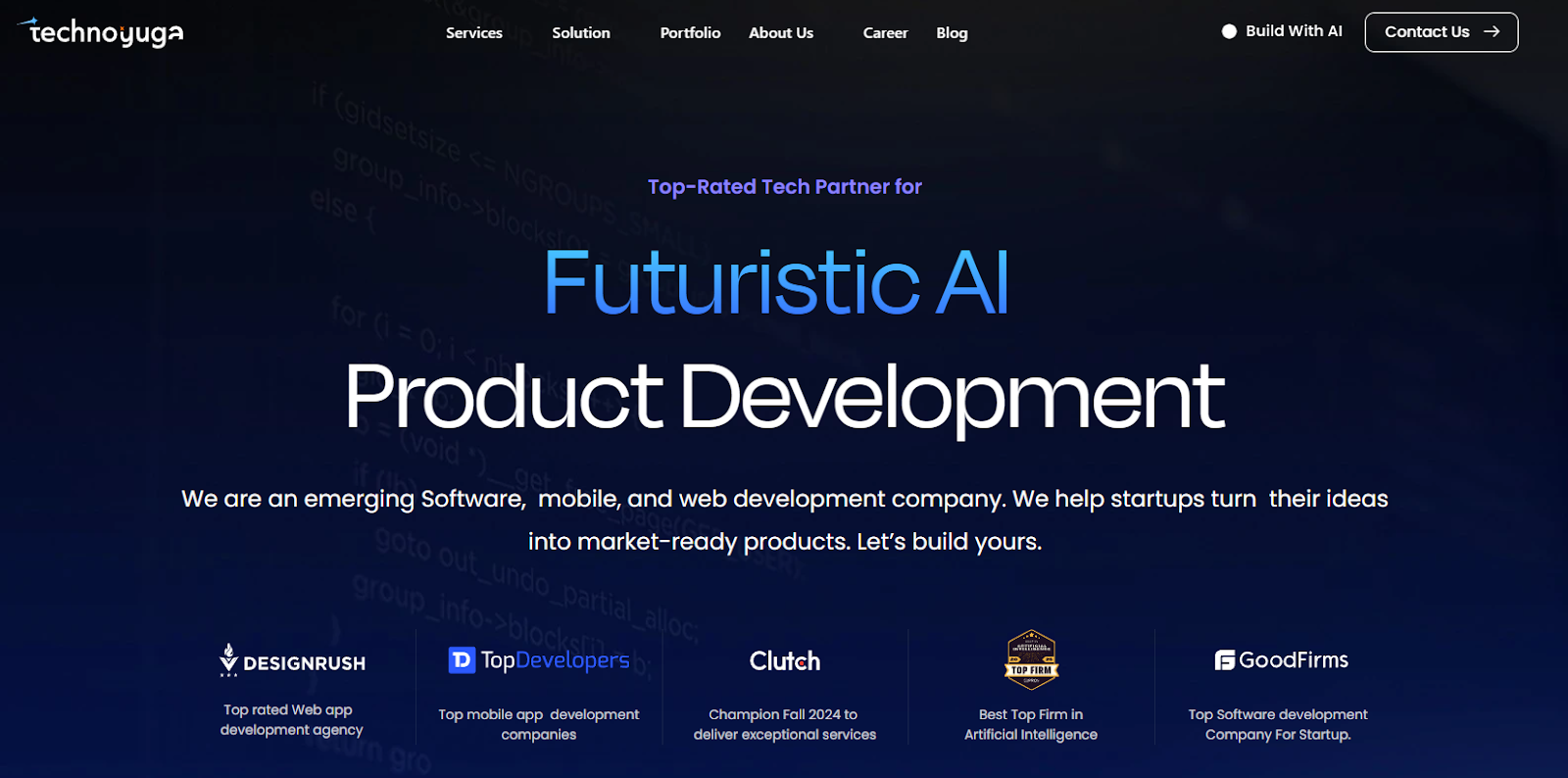
TechnoYuga Soft Pvt. Ltd. is a full-stack development firm offering comprehensive, custom software solutions for a wide range of industries. With a perfect 5.0-star rating based on 64 reviews, TechnoYuga consistently receives positive feedback.
Core Services
TechnoYuga focuses on three main areas:
- Custom Software Development (35%)
- Mobile App Development (35%)
- AI Development (20%)
- Plus one additional service line
Key Highlights
- Exceptional project management and timely delivery
- Scalable and user-friendly applications
- Proactive communication and strategic partnership approach
- User-centric design principles
- Excellence in developing software that addresses specific market needs
TechnoYuga's team of 50 to 249 software developers ensures personalized attention to every project. Their hourly rate of less than $25 makes them one of the most cost-effective options for custom software development in Sydney.
4. Innowise
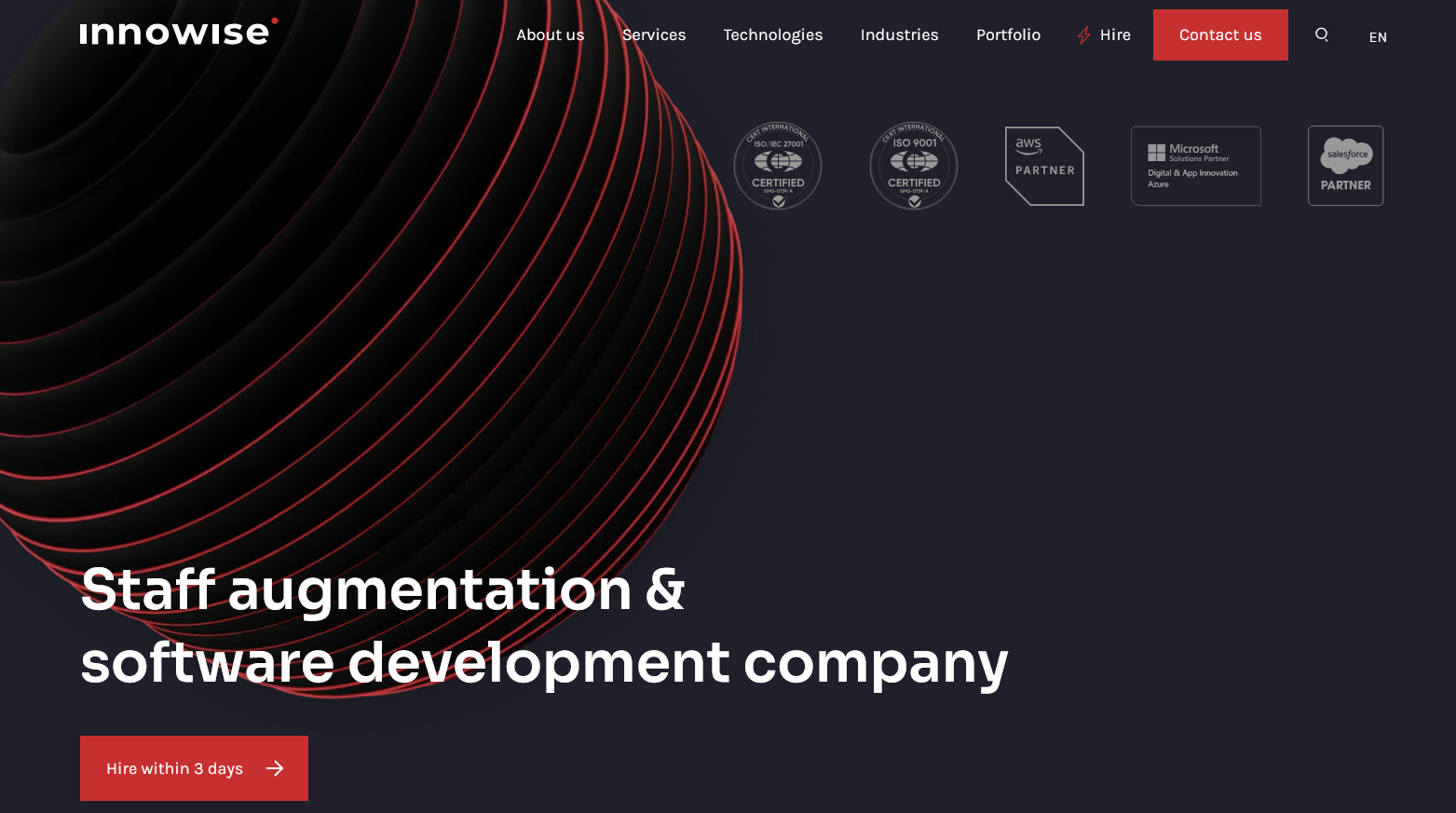
Innowise is a bespoke software development agency that provides end-to-end services, specializing in various sectors, including healthcare and finance. With a Clutch rating of 4.9 stars based on 72 reviews, Innowise boasts a 100% satisfaction rate. This leading provider excels at delivering innovative software solutions for complex enterprise requirements.
Core Services
Innowise offers a diverse range of software development services:
- Custom Software Development (10%)
- AI Development (10%)
- AR/VR Development (10%)
- Plus 7 additional services including cloud solutions and IoT
- Data analytics and business intelligence services
Key Highlights
- Exceptional responsiveness plus technical expertise
- Deliver on time and within budget
- Proven experience in regulated industries like healthcare and fintech
- Strong project management with Agile and Scrum methodologies
- Skilled at delivering tailored solutions for enterprise clients
Innowise serves Sydney with a minimum project size of $10,000 and hourly rates from $50 to $99. Their ability to deliver tailored solutions makes them ideal for complex enterprise needs.
5. EB Pearls

EB Pearls is a full-stack software development company that specializes in creating bespoke, tailored, and custom software solutions. Based in Surry Hills, Australia, EB Pearls has earned a perfect 5.0-star rating based on 59 reviews.
Core Services
EB Pearls focuses heavily on mobile solutions:
- Custom Software Development (15%)
- Mobile App Development (50%)
- AI Development (25%)
- Plus one additional service line
Key Highlights
- Over 200 mobile apps developed
- Expert iOS, Android app development, and hybrid solutions
- Excellent communication skills and professionalism
- Seamless integration into client teams
- Strong track record in mobile application development
EB Pearls' team of 250 to 999 software developers handles both startup projects and enterprise applications. Their hourly rate of $25 to $49 offers great value for mobile app development companies in Sydney.
6. Appinventiv
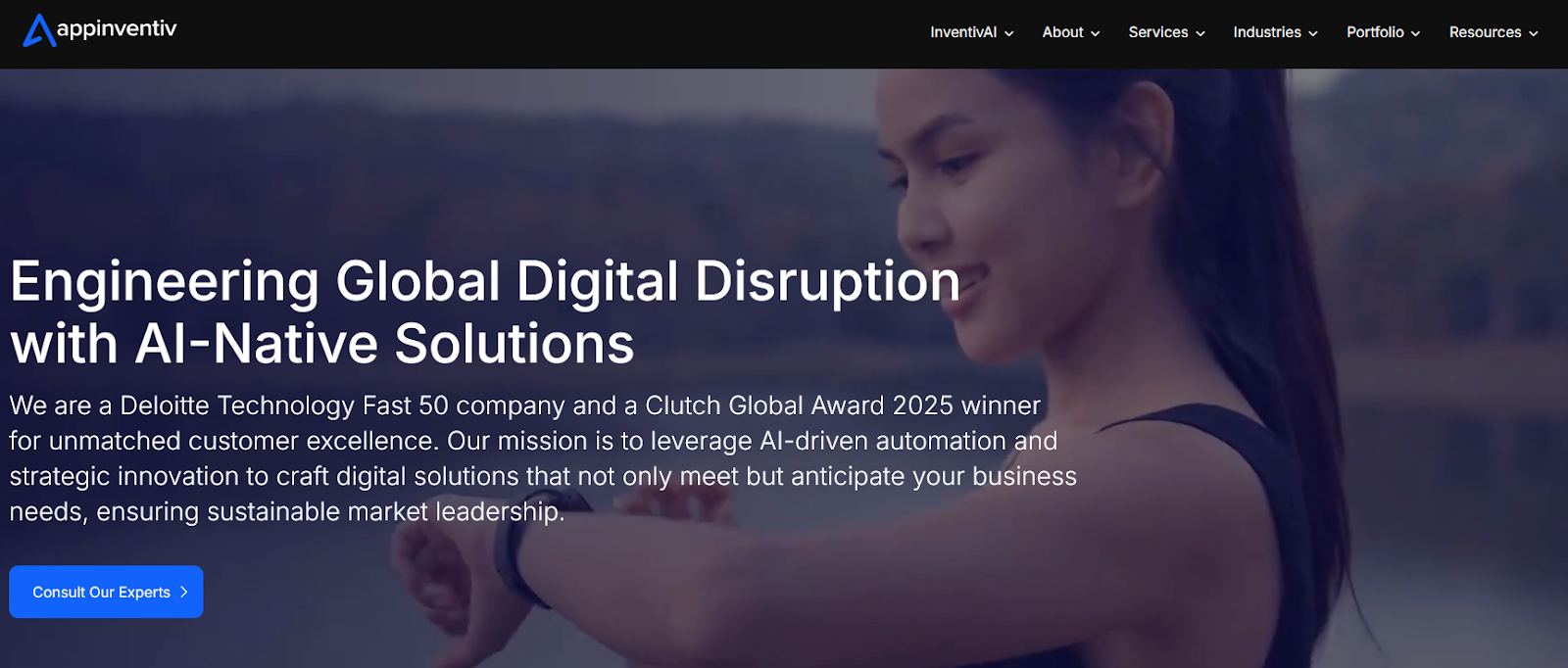
Appinventiv is a custom software development company specializing in end-to-end software development solutions. With a Clutch rating of 4.6 stars based on 89 reviews, Appinventiv has a largely positive reputation. This software development agency focuses on delivering innovative mobile applications and AI-powered solutions.
Core Services
Appinventiv offers three primary software development services:
- Custom Software Development (20%)
- AI Development (40%)
- Mobile App Development (40%)
Key Highlights
- Large team of 1,000 to 9,999 software developers
- Strong AI and machine learning capabilities
- Experience with both startups and enterprises
- Flexible engagement models
- Excellence in mobile application development
Approximately 70% of feedback highlights their strengths in project management, flexibility, plus technical expertise. Their minimum project size of $50,000 makes them suitable for mid to large-scale software development projects.
7. Arcanys
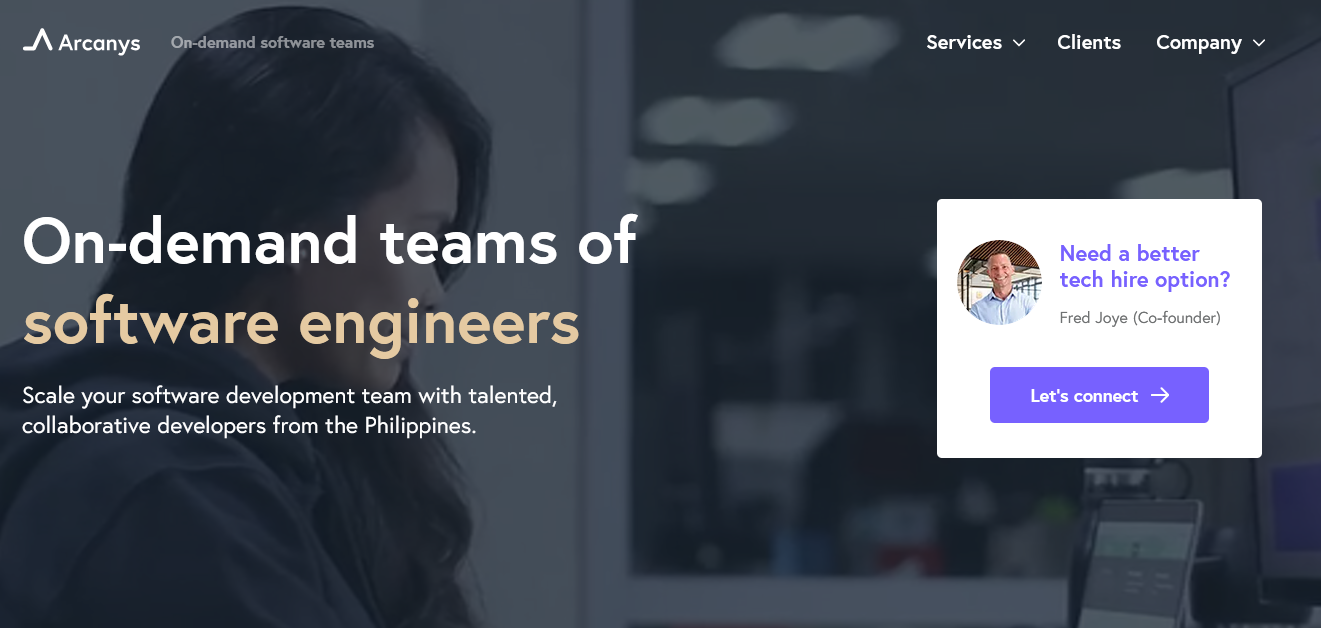
Arcanys offers full-stack software development and custom software creation, providing solutions meticulously tailored to meet the needs of various industries. With a perfect 5.0-star rating based on 25 reviews, Arcanys has earned a reputation for excellence.
Core Services
Arcanys focuses on three main areas:
- Custom Software Development (40%)
- Web Development (30%)
- AI Development (20%)
- Plus one additional service line
Key Highlights
- Long-term partnership approach
- Strong emphasis on code quality and best practices
- Transparent communication throughout development
- Seamless integration into existing workflows
- Expertise in developing software for complex business requirements
Arcanys' team of 250 to 999 software developers provides balance between personalized service and scalability. With a minimum project size of $100,000 and hourly rates of $25 to $49, they cater to enterprise clients.
8. VT Digital

Based in Sydney, Australia, VT Digital is a software development company that specializes in creating tailored, AI-enhanced software solutions. With a perfect 5.0-star rating based on 25 reviews, VT Digital has proven its excellence as a web development company and software development agency.
Core Services
VT Digital offers a balanced service portfolio of custom software development services:
- Custom Software Development (20%)
- Mobile App Development (30%)
- Web Development (20%)
- Plus 3 additional services including data analytics
Key Highlights
- Deep expertise in financial services industry
- Strong focus on compliance and regulatory requirements
- AI-enhanced solutions improving user engagement
- Local Sydney presence with global team capabilities
- Excellence in website development and web application development
VT Digital's team of 10 to 49 software developers ensures personalized attention. With a minimum project size of just $1,000 and hourly rates of $50 to $99, they accommodate projects of all sizes.
9. Hiteshi

Hiteshi is a bespoke software development company specializing in custom software creation plus full-stack development. Based in Sydney, Australia, Hiteshi has earned a perfect 5.0-star rating based on 27 reviews.
Core Services
Hiteshi focuses primarily on two areas:
- Custom Software Development (30%)
- AI Development (70%)
Key Highlights
- Heavy focus on artificial intelligence and machine learning
- Deliver projects ahead of schedule
- Strong emphasis on budget adherence
- Excellent value for money
- Expertise in delivering cutting edge software solutions
Hiteshi's team of 50 to 249 software developers provides the right mix of expertise and personalized service. With a minimum project size of $5,000 and hourly rates under $25, they offer exceptional value for AI development projects.
10. Appello Software
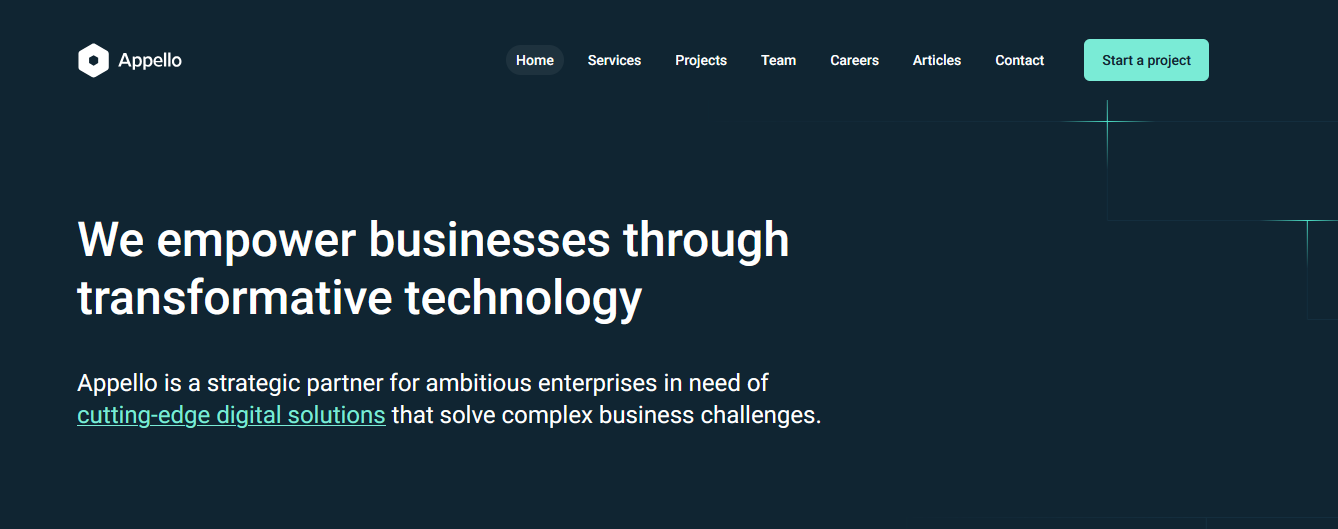
Appello Software is a custom software development company based in Sydney, Australia, specializing in tailored software development solutions, including mobile app development, web-based platforms, plus branding. With a Clutch rating of 4.9 stars based on 33 reviews, Appello has earned strong client satisfaction.
Core Services
Appello focuses heavily on mobile solutions:
- Custom Software Development (35%)
- Mobile App Development (55%)
- Web Development (10%)
Key Highlights
- Specializes in healthcare and fintech industries
- Strong UI/UX design capabilities including custom web design
- Transparent communication and project management
- Local Sydney presence ensures cultural alignment
- Excellence in mobile applications development
Appello Software tailors software solutions and mobile apps for industries such as healthcare and fintech. Their team of 50 to 249 software developers provides focused expertise. With a minimum project size of $50,000 and hourly rates of $100 to $149, they cater to clients valuing premium quality.
11. StepInsight

StepInsight is a custom software development company based in Sydney, Australia, known for expertise in bespoke software solutions. They focus on tailored software development plus end-to-end software engineering services. With a Clutch rating of 4.9 stars based on 11 reviews, StepInsight has built a solid reputation.
Core Services
StepInsight offers a balanced portfolio of software development services:
- Custom Software Development (40%)
- Mobile App Development (30%)
- AI Development (15%)
- Plus one additional service line
Key Highlights
- Strong technical proficiency across multiple platforms
- Client-focused approach with regular updates
- Timely delivery and adherence to budgets
- End-to-end software engineering services
- Proven ability to deliver solutions that meet business objectives
StepInsight's team of 10 to 49 software developers ensures personalized attention to every project. With a minimum project size of $25,000 and hourly rates of $50 to $99, they serve mid-market clients seeking technology solutions.
12. Tech Exactly

Tech Exactly is a custom software development company specializing in tailored and end-to-end software solutions. Based in Kolkata, India, Tech Exactly serves clients globally, including Sydney. With a Clutch rating of 4.9 stars based on 25 reviews, they have earned strong client trust.
Core Services
Tech Exactly focuses on mobile solutions and software development services:
- Custom Software Development (10%)
- Mobile App Development (50%)
- AI Consulting (10%)
- Plus 3 additional services
Key Highlights
- Strong mobile app development capabilities
- Exceptional communication and milestone tracking
- Adaptability to changing project requirements
- Cost-effective pricing model
- Excellence in mobile applications and mobile application development
Tech Exactly's team of 50 to 249 software developers provides the scale needed for diverse projects. With a minimum project size of $5,000 and hourly rates under $25, they offer excellent value for app development.
13. Offshorly
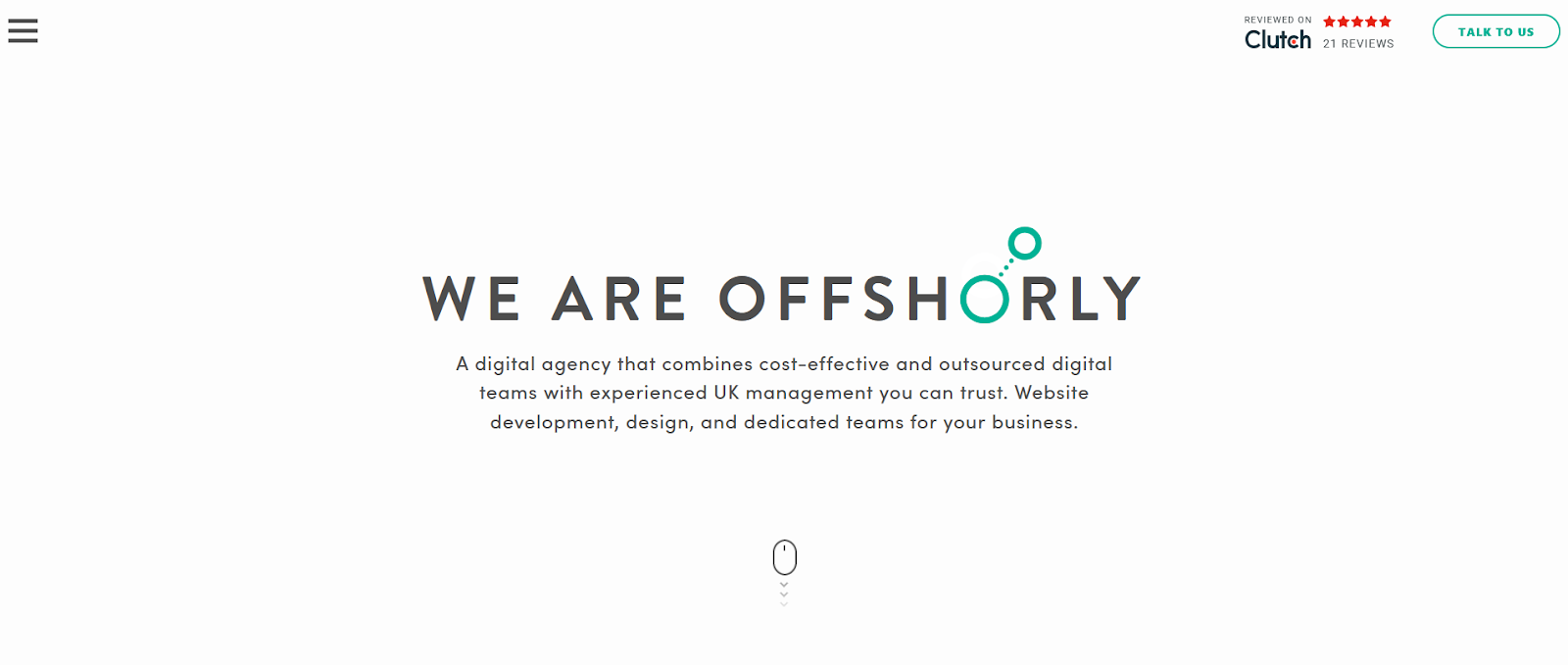
Offshorly is a custom software development company specializing in bespoke software creation plus end-to-end development solutions. With a Clutch rating of 4.9 stars based on 21 reviews, Offshorly has achieved a 100% positive feedback rate.
Core Services
Offshorly offers diverse custom software development services:
- Custom Software Development (20%)
- AI Development (20%)
- Web Design (15%)
- Plus 4 additional services including website development
Key Highlights
- Acts as an extension of your internal team
- Proactive approach to problem-solving
- High-quality deliverables consistently
- Strong commitment to client values
- Skilled at delivering tailored solutions across industries
Offshorly's team of 50 to 249 software developers ensures personalized service. With a minimum project size of $5,000 and hourly rates under $25, they provide cost-effective digital solutions for businesses of all sizes.
14. Sentia

Sentia is a custom software development company based in Sydney, Australia, offering tailored and end-to-end software solutions. With a Clutch rating of 4.8 stars based on 6 reviews, Sentia has built a reputation for excellence as both a software development agency and web development company.
Core Services
Sentia offers a balanced portfolio of software development services:
- Custom Software Development (20%)
- Mobile App Development (25%)
- Web Development (25%)
- Plus 3 additional services including web application development
Key Highlights
- Deep understanding of business objectives
- Strong technical expertise across multiple platforms
- Adherence to timelines and budgets
- Ability to deliver scalable solutions
- Excellence in website development and custom web design
Sentia's team of 10 to 49 software developers provides focused attention. With a minimum project size of $25,000 and hourly rates of $150 to $199, they cater to clients valuing premium expertise.
15. Quickworks
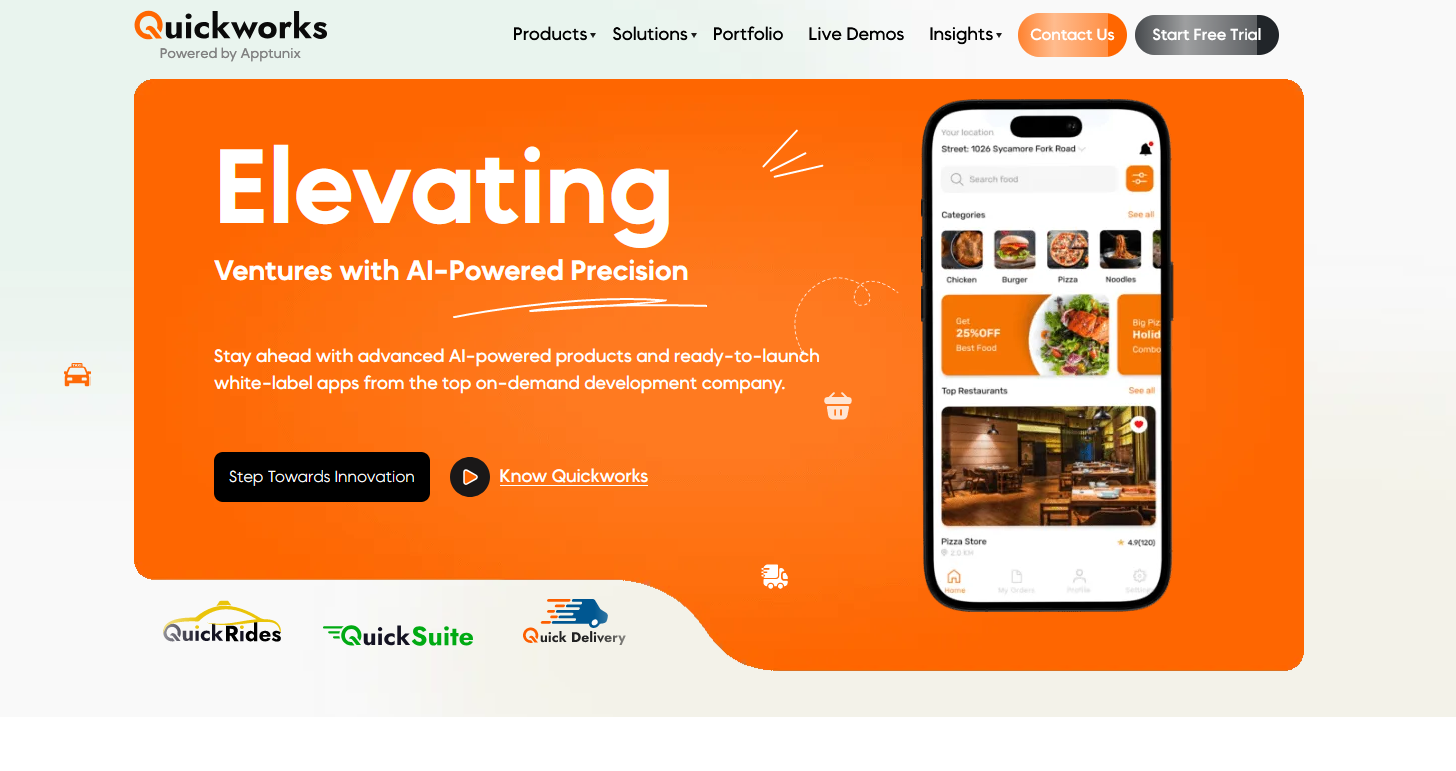
Quickworks specializes in mobile software development for iOS and Android, focusing on delivering ready-to-deploy, white-labeled platforms. Built with scalability, speed, plus simplicity in mind, Quickworks offers pre-built yet customizable tech stack.
Core Services
Quickworks offers specialized solutions:
- White-Label Apps: Prebuilt solutions for food, grocery, taxi, and fleet management apps
- SaaS Integration: AI-powered, customizable apps that can launch in weeks
- iPaaS/Workflow Automation: Drag-and-drop enterprise integration services platform with 1,500 plus pre-integrations
- Post-Launch Support: Regular updates, customer support, and feature enhancements
Key Highlights
- Deep domain expertise in on-demand platforms
- Affordable pricing without compromising quality
- Streamlined development approach using agile methodologies
- Exceptional post-launch support and updates
- Leading provider in white-label mobile applications
Quickworks specializes in mobile software development, building ready-to-deploy iOS and Android app development solutions that are white-labeled and fully configurable. Their plug-and-play architecture reduces development time by up to 70%, helping businesses launch within weeks. Their platforms are backed by robust APIs, high-level security, plus flexible UI modules.
Now that you have discovered the top software development companies in Sydney, let us dig deeper. How do you actually choose the right one? Because not every great name will be the right fit for your business. Here is what to consider before making your move.
Why Choose the Best Software Development Companies in Sydney?
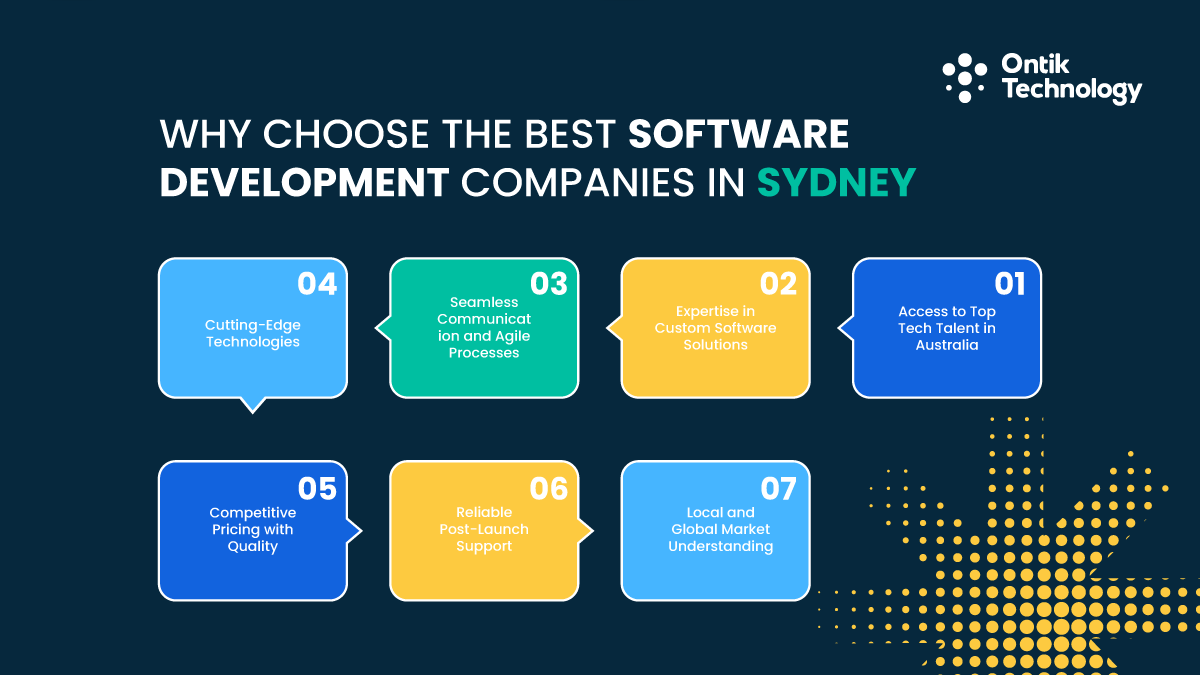
Collaborating with the right software development company in Sydney is crucial for business success. Whether you are a startup or enterprise, finding the right digital partner outlines your vision. Sydney is emerging as a powerhouse for next-gen software companies bringing real value.
Access to Top Tech Talent in Australia
Sydney hosts skilled software developers, software engineers, mobile developers, UI/UX designers, plus product strategists. These software developers in Sydney bring expertise across multiple technologies and frameworks.
Many top software companies in Sydney and IT companies in Sydney, Australia have major offices here, giving you access to concentrated tech talent. The collaborative environment among software developers in Sydney fosters innovation and knowledge sharing.
These professionals stay current with mobile software development trends. Government IT initiatives support STEM education, creating a pipeline of qualified software developers ready to tackle real business challenges.
Expertise in Custom Software Solutions
A custom software development company in Sydney builds platforms tailored for your goals and workflows. Custom software development improves efficiency and eliminates operational inefficiencies. Sydney firms deliver highly scalable systems, whether SaaS products or on-demand apps. Custom software solutions provide tailored solutions that give you competitive advantages through unique features aligned with your business vision and needs.
Seamless Communication and Agile Processes
Sydney software companies use Agile for faster, transparent custom development (market research, business analysis, development, deployment, maintenance). Time-zone alignment is beneficial. Agile's iterative development, cross-functional collaboration, and user stories define scope and functionality. Effective communication is key; scaling requires strategy to maintain efficiency and productivity.
Cutting-Edge Technologies
Sydney's innovation-led software ecosystem leverages cutting-edge tools like Flutter and React Native for cross-platform mobile apps, and modern web frameworks for faster delivery. Developers use advanced frameworks for robust systems.
DevOps improves collaboration, while cloud solutions boost scalability and performance. Business intelligence and data analytics enable data-driven decisions.
Competitive Pricing with Quality
While Sydney is not the cheapest market, the cost-to-quality ratio is outstanding. Firms offer flexible pricing: fixed-cost packages to dedicated teams. Software development costs range from $20,000 for MVPs to $5 million for full products. A Minimum Viable Product tests market viability before full investment.
Reliable Post-Launch Support
Sydney-based firms offer maintenance, monitoring, bug fixes, plus upgrades. Ongoing maintenance keeps software running smoothly. Regular feedback loops ensure software meets user needs. Custom software development can lead to better user experiences by focusing on user-centric design principles.
Local and Global Market Understanding
These app development companies in Sydney grasp compliance, user behavior, plus Australian regulations. Companies in Sydney may have better insight into the local business landscape and specific customer expectations. Adhering to Australian Privacy Principles (APPs) and Notifiable Data Breaches (NDB) scheme is crucial. This local insight combined with global delivery makes them ideal partners.
Ready to find your development partner? Let us explore the top 15 best software development companies in Sydney.
Sydney's IT Landscape: A Hub for Innovation
Sydney has emerged as Australia's premier destination for technology services. The city hosts numerous top IT companies in Sydney alongside innovative small IT companies in Sydney that deliver specialized solutions. Whether you're searching for top tech companies to work for in Sydney or seeking IT Services Companies in Sydney for your project, the city's ecosystem supports every need.
This comprehensive list of IT companies in Sydney represents the top 10 IT companies in Sydney and beyond, showcasing firms that excel in custom software and app developers Sydney services. These top software companies in Sydney and best software development companies in Sydney Australia have established proven track records across industries. Many leading providers in Sydney's software development agency landscape offer comprehensive services from ideation to deployment.
Parameters to Choose the Best Software Development Company in Sydney
Selecting the best software development company in Sydney is a high-stakes decision for any business, big or small. The right partner brings more than just code to the table. They bring strategy, support, plus long-term value. Here are the most important parameters to guide your decision.
Experience and Industry Expertise
Start by checking how long the company has been operating. Longevity reflects credibility and consistent delivery. Look for industry experience in your specific sector, as healthcare apps differ vastly from retail platforms.
Check for years in business, successful project count, industry-specific case studies, client testimonials from similar sectors, awards and recognitions, plus partnerships with technology leaders like Microsoft Gold Partner status. Top software development companies in Sydney showcase case studies demonstrating their domain expertise. Experienced software developers offer deep insights, better workflows, plus avoid rookie mistakes. Top software developers in Sydney understand how to align technology with your business vision.
Range of Services Offered
Top Sydney custom software developers provide full-cycle services, including ideation, maintenance, and essential offerings like mobile app, web, and backend development, along with custom web design and application capabilities. This comprehensive approach eliminates the need for multiple vendors.
Full-cycle development includes business analysis, user stories, development, deployment, plus ongoing maintenance. A leading provider should deliver solutions across all platforms and technologies.
Tech Stack and Tools
Modern problems need modern tools. Check what programming languages, frameworks, plus technologies the company uses. Sydney's best mobile software development companies master Flutter, Kotlin, Swift, React Native, plus more.
Key technologies include frontend frameworks (React, Angular, Vue.js), mobile platforms (Flutter, React Native, Swift, Kotlin), backend systems (Node.js, Python, Java, .NET), cloud services (AWS, Azure, Google Cloud), and emerging tech (AI/ML, Blockchain, IoT, business intelligence and data analytics tools).
The technology stack should align with your project requirements plus future scalability needs. Top software developers should be proficient in multiple tech stacks and cutting edge technologies.
Portfolio and Case Studies
Always review a company's past projects. This shows their technical skills, creativity, plus ability to solve real business challenges. Look beyond surface design. Examine user reviews, performance improvements, or revenue results tied to their projects. Client reviews often highlight the importance of communication and timely delivery in software development projects.
Client success stories reveal how the company approaches real business challenges and their ability to deliver solutions that drive business success. Look for examples of tailored software solutions that addressed specific client needs.
Client Testimonials and Reviews
Reviews can offer valuable insight into the company's professionalism, reliability, plus communication. Platforms like Clutch, GoodFirms, and Google Reviews are a good start. A great software development company in Sydney does not just deliver good products but builds lasting relationships.
Pay attention to patterns in reviews. If multiple clients mention excellent communication, that is a strong signal. If several mention delays, that is a red flag. Reviews from engineering firms and established businesses carry significant weight.
Development Approach and Methodology
The most successful software development companies in Australia often follow Agile or Scrum methodologies. These ensure faster iterations, real-time feedback, plus a lower chance of rework. A defined software delivery process builds transparency, accountability, plus trust.
Agile offers iterative development for flexible requirements, uses regular sprints for continuous progress, ensures transparent communication, allows quick adaptation to changing business needs, and fosters collaboration between the client and development team. DevOps enhances collaboration between development and operations through continuous integration and deployment.
Pricing Model and Cost Transparency
The software development cost in Sydney varies based on scope, tech stack, plus team structure. Make sure the company is upfront about pricing. Look for flexibility in pricing models: fixed-price, hourly, or dedicated team models. Remember, the cheapest option can become the costliest if it lacks quality or stability. Value for cost is more important than just low prices.
Support and Maintenance
Software development requires ongoing maintenance, not a one-time job. Leading Sydney software development companies provide flexible post-launch maintenance, including performance monitoring, bug fixes, and regular updates. Consistent feedback during development ensures solutions meet user needs.
Finding a software development company in Sydney that checks all these boxes is not easy, but it is worth the effort. For companies needing additional resources, consider exploring dedicated development team options.
What Are the Software Development Costs in Australia?
Understanding software development cost in Australia, particularly in Sydney, is essential for smart budgeting. Projects range from AUD 10,000 to AUD 100,000 plus, depending on numerous factors.
The cost of software development can range from $20,000 for a simple Minimum Viable Product to over $5 million for full product development. Simple software development projects typically take 10 to 12 weeks, while larger projects can take several months to a year.
Factors Influencing Cost
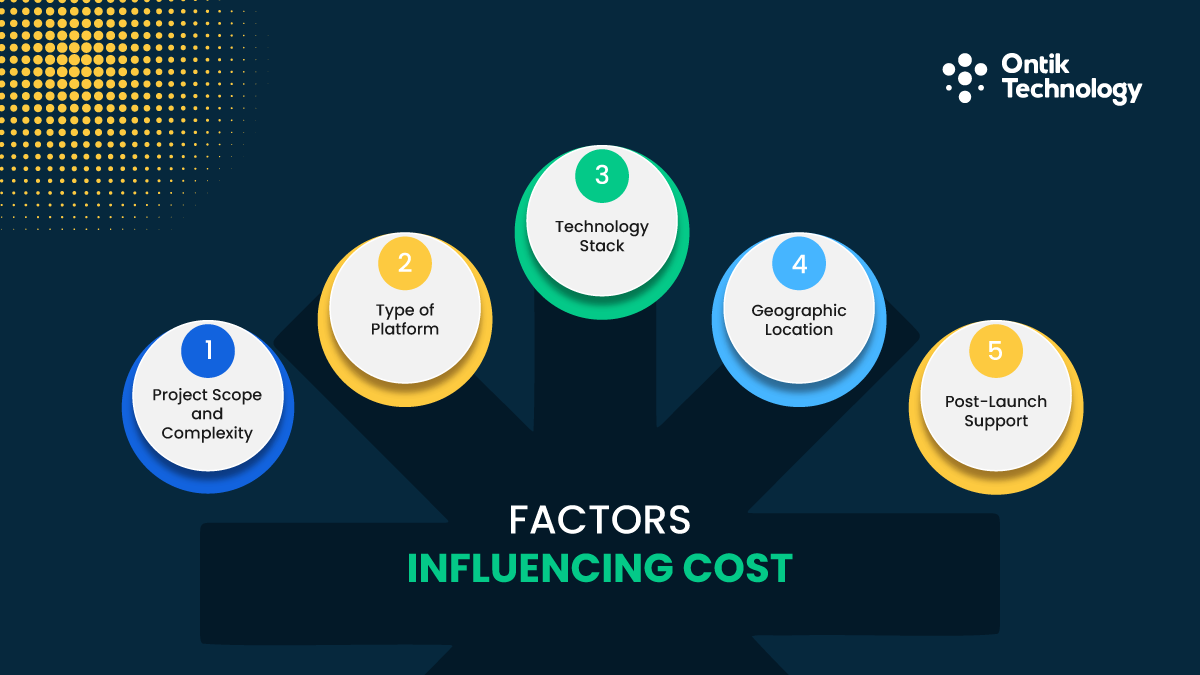
Project Scope and Complexity: Enterprise systems with user roles, analytics, plus integrations significantly increase software development costs in Sydney.
Type of Platform: Web development is often cost-effective. Native mobile apps for iOS and Android require separate builds, raising expenses. Hybrid solutions like React Native save time and money. Mobile application development costs vary based on platform choice.
Technology Stack: Standard stacks are affordable. New technologies like AI, blockchain, or IoT demand special skills with higher costs. Data analytics and business intelligence features add to the overall cost.
Geographic Location: Software developers in Sydney are more expensive than outsourcing teams. The pricing for software development services varies significantly based on whether the team is onshore or offshore.
Post-Launch Support: Ongoing maintenance typically costs 15 to 20% of the initial development budget annually.
A Comparative Overview of Sydney's Leading Software Development Companies
Choosing the right partner requires understanding what each company brings to the table. Here is a comparison of the top firms.
Team Size and Pricing
Small IT companies in Sydney (10 to 49 software developers) offer personalized attention plus flexibility, ideal for startups requiring close collaboration. Larger firms (1,000+ software developers) provide scalability plus diverse expertise for enterprise projects.
Budget-friendly options (under $25/hr) include Ontik Technology, TechnoYuga, Hiteshi, Tech Exactly, plus Offshorly. Mid-range options ($25 to $99/hr) include Simform, EB Pearls, Appinventiv, Arcanys, VT Digital, plus StepInsight. Premium options ($100 to $199/hr) include Appello Software and Sentia.
Specialization and Location
AI and machine learning specialists include Ontik Technology, Simform, Hiteshi, plus Innowise. Mobile app development leaders include EB Pearls, Tech Exactly, plus Appello Software. Healthcare and fintech experts include Appello Software, Innowise, plus VT Digital.
Web development company specialists include VT Digital, Sentia, and Arcanys, offering comprehensive website development and web application development services.
Sydney-based companies include VT Digital, Hiteshi, StepInsight, Appello Software, Sentia, plus EB Pearls, offering local insight plus cultural alignment. Global companies serving Sydney include Simform, Innowise, Appinventiv, Arcanys, TechnoYuga, Tech Exactly, Offshorly, plus Ontik Technology.
Companies with perfect 5.0-star ratings include TechnoYuga, EB Pearls, Arcanys, VT Digital, plus Hiteshi. Several software development companies in Sydney have experience working with startups and enterprises alike, providing tailored solutions to meet specific client needs with a strong focus on customer satisfaction and long-term partnerships.
Final Thoughts
Selecting the right Sydney software development partner is key to digital success, whether for a startup or an enterprise. Custom software drives business growth. Smart budgeting and a reliable partner accelerate scalability.
Sydney hosts top app development firms for diverse industries, from AI to enterprise solutions. To begin, define requirements, set a budget, and contact the best fit. Building an MVP minimizes risk and validates the concept.
The right company becomes a strategic partner, understanding your goals and providing the technical expertise to execute. Choose wisely and start building your future today.
FAQ's
What is the average cost of software development in Sydney?
The average software development cost in Sydney ranges from AUD 10,000 to AUD 100,000 plus, depending on project complexity. Simple mobile apps start around $10,000, while enterprise solutions can exceed $100,000. Factors like tech stack, team size, plus project scope all influence final costs.
How long does it take to build a custom software solution?
Simple software development projects typically take 10 to 12 weeks to complete. More complex enterprise applications can take several months to a year. The timeline depends on project requirements, team size, plus development methodology. Agile approaches often deliver faster results through iterative development.
Should I hire a local developer or outsource?
Local software development companies in Sydney offer better communication, cultural alignment, plus understanding of Australian regulations like the APPs and NDB scheme. However, offshore teams provide cost savings. Many businesses choose hybrid models that balance quality with budget. Consider your priorities: communication versus cost.
How do I verify a company's expertise?
Check their portfolio, case studies, and client testimonials (Clutch, Google Reviews). Request references. Inquire about their tech stack and development methods. Use a free consultation to assess communication and expertise. Look for industry recognition like Microsoft Gold Partner status.


Choosing the right software development company in Abu Dhabi can transform your business. With over 300 firms in the market, finding a software development company in Abu Dhabi that actually delivers becomes challenging.
Abu Dhabi's tech ecosystem has grown dramatically thanks to Vision 2030 investments. We evaluated 100+ companies using strict criteria: Clutch reviews, local presence, case studies, and PDPL compliance. This guide presents 10 verified Abu Dhabi-based software companies with proven track records.
Whether you need custom software development, mobile apps, or enterprise solutions, these local software developers Abu Dhabi offer the expertise and regional market knowledge to execute successfully. Each has been vetted for technical capability and market readiness.
What Makes Abu Dhabi a Rising Hub for Software Development?
Driven by Vision 2030, Abu Dhabi has become a booming tech ecosystem. The software development market is expected to grow 12.5% annually until 2029, making it a prime location to hire software companies.
Hub71 spearheads this growth with $2 billion in startup incentives. Free zones like Masdar City and ADGM attract top local and international software firms by offering 100% foreign ownership, zero corporate tax for 50 years, and fast-track visas.
The emirate focuses on enterprise software, government contracts, and mission-critical systems. This differs from Dubai's startup-heavy ecosystem. Abu Dhabi offers B2B software firms opportunities in stable government and compliance projects, requiring custom development. Key sectors utilizing software include oil/gas, finance, healthcare, and government.
Infrastructure supports rapid growth with full 5G coverage, world-class data centers, and cloud connectivity rivaling any global tech hub.
How Did We Curate This List of Top Software Development Companies?
We evaluated over 100 software development companies in Abu Dhabi using six rigorous criteria to ensure verified quality and genuine capability. Whether you need a software development company near me Abu Dhabi or prefer working with a leading software development firm Abu Dhabi, this methodology helps you choose wisely.
Clutch reviews - We prioritized firms with 4.0+ ratings and verified client feedback. Real reviews from actual projects reveal more than polished marketing materials. We analyzed review patterns, response quality, and client satisfaction trends.
Case studies - Companies must demonstrate documented project success with measurable outcomes. We looked for specific results: reduced costs, improved efficiency, increased revenue. Generic portfolio pieces without data did not qualify.
Industry specialization - The best software development company in Abu Dhabi has deep expertise in specific sectors like fintech, healthcare, government, or logistics. Specialists understand industry regulations, workflows, and technical requirements better than generalists.
PDPL compliance - The Personal Data Protection Law (PDPL) establishes strict requirements for collecting, storing, and processing personal data. Compliance is mandatory for software handling resident data. Every software development company in Abu Dhabi must understand these regulations.
Key requirements include data minimization, clear consent mechanisms, user rights (access, correction, deletion), security measures, and breach notification within 72 hours. Violations carry fines up to AED 10 million.
UAE data protection and security standards are non-negotiable. We verified each company's understanding of Personal Data Protection Law, encryption practices, and data residency requirements.
Scalability - Companies must grow development teams without sacrificing delivery quality. We assessed their ability to maintain code standards, communication clarity, and sprint discipline as projects scale.
This methodology delivers vetted partners with proven capabilities in custom software development, not just marketing claims.
What Are the Top 15 Software Development Companies in Abu Dhabi?
The following 15 top software development companies in Abu Dhabi represent the region's most capable and verified partners. Each software company brings unique strengths across different industries and technical domains, from web application development to mobile app solutions.
Before we dive into individual profiles, here's a quick comparison to help you narrow your options:
Company Comparison Table
Now let's explore what makes each company stand out.
Ontik Technology
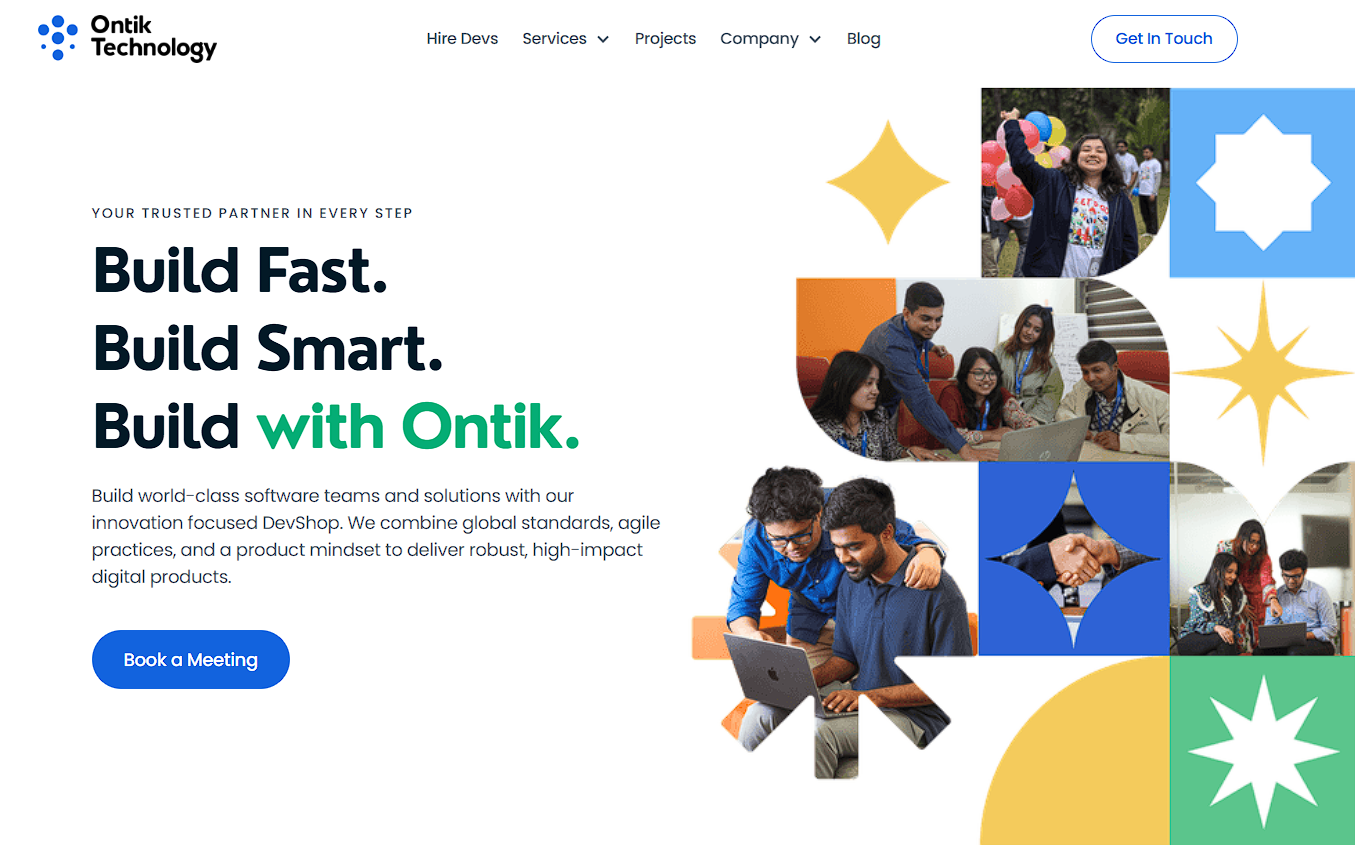
Founded in 2016, they have delivered 500+ successful projects for 350+ businesses worldwide. Their team of 150+ professionals offers rates under $25/hr, making enterprise-grade solutions accessible.
Service portfolio:
- AI development and machine learning solutions
- IT staff augmentation and team extension
- Mobile app development (iOS and Android)
- Custom software development service
- Web development and Web3 solutions
- Enterprise resource planning systems
- BI and data science
- MVP development
Ontik specializes in digital transformation, modernizing legacy systems, and integrated business automation. Their expertise spans diverse sectors including real estate, fitness, mentorship, and cultural education. With a strong UAE presence, they ensure seamless collaboration through every project phase.
The company has cultivated a culture rooted in research, continuous learning, and cutting-edge technology adoption. Their approach combines technical proficiency with deep understanding of regional market dynamics, including PDPL compliance and Arabic-RTL implementation.
Best for: Forward-thinking companies wanting AI-powered solutions with strong collaboration from conception to launch at competitive rates.
Competenza

Competenza has over 10 years of experience serving 1000+ enterprises globally with technology partnerships including Microsoft, Amazon, and Intel.
Key strengths:
- AI/ML solutions and custom Machine Learning models
- Process automation for approvals and reconciliations
- Mobile app development (iOS, Android, cross-platform)
- IT staff augmentation with GCC-aligned teams
- Cloud services across AWS, Azure, and hybrid setups
- Digital transformation and application modernization
Best for: Enterprises and growing businesses needing end-to-end digital solutions with strong GCC compliance understanding.
Synergy Labs

Synergy Labs maintains a 4.9 Clutch rating across 45 reviews. This boutique studio has delivered 100+ custom projects for clients including Forbes Council, Minnect, and Clapper with rates of $50-99/hr.
Key capabilities:
- Custom mobile apps for iOS and Android
- Web applications and platforms
- MVP development and rapid prototyping
- Fintech and social media applications
- UI/UX design services
Best for: Startups and growing companies building consumer-facing mobile applications where user experience drives competitive advantage.
Lumitech
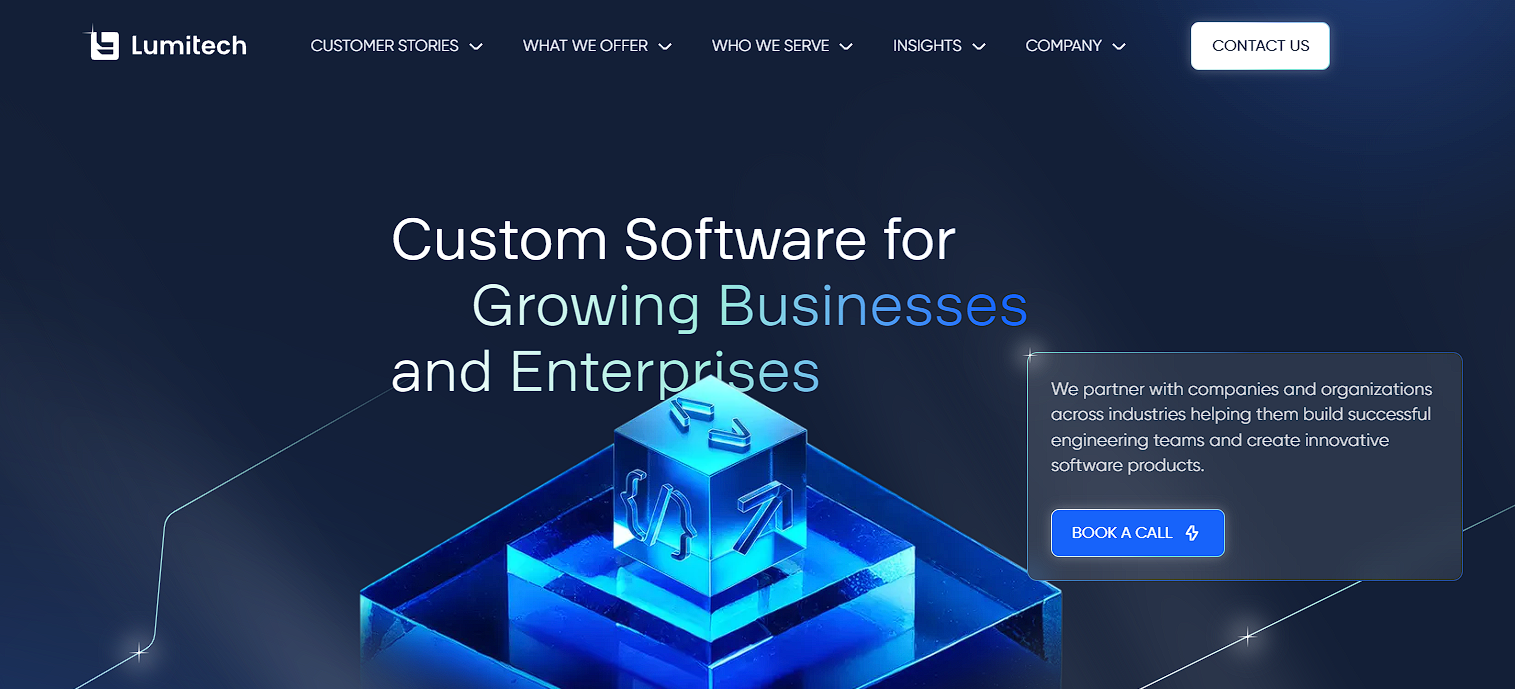
Lumitech ranks #1 in IT Consulting in the UAE on Clutch and appears in the Clutch 100 fastest-growing companies of 2024. They achieved 600% growth since 2022 with an in-house team approach.
Service offerings:
- Web development with scalable architectures
- Mobile development for high-performance apps
- AI/ML development and data insights
- Startups, MVPs, and POCs
- UX/UI design
- QA and testing
Best for: Fast-growing startups and scale-ups needing AI-driven development with a tech-first, zero-bureaucracy approach.
Phaedra Solutions

Phaedra Solutions holds a 4.9 Clutch rating across 23 reviews. Based in Dubai Silicon Oasis, they have delivered 700+ projects with 200+ experts and maintain 97% client retention.
Comprehensive services:
- AI and machine learning development
- Custom software development
- Mobile app development (iOS and Android)
- Web development and eCommerce
- UI/UX design and prototyping
- Fractional CTO services
Best for: Startups seeking rapid AI MVP development and enterprises needing comprehensive digital transformation with proven ROI.
Blink22
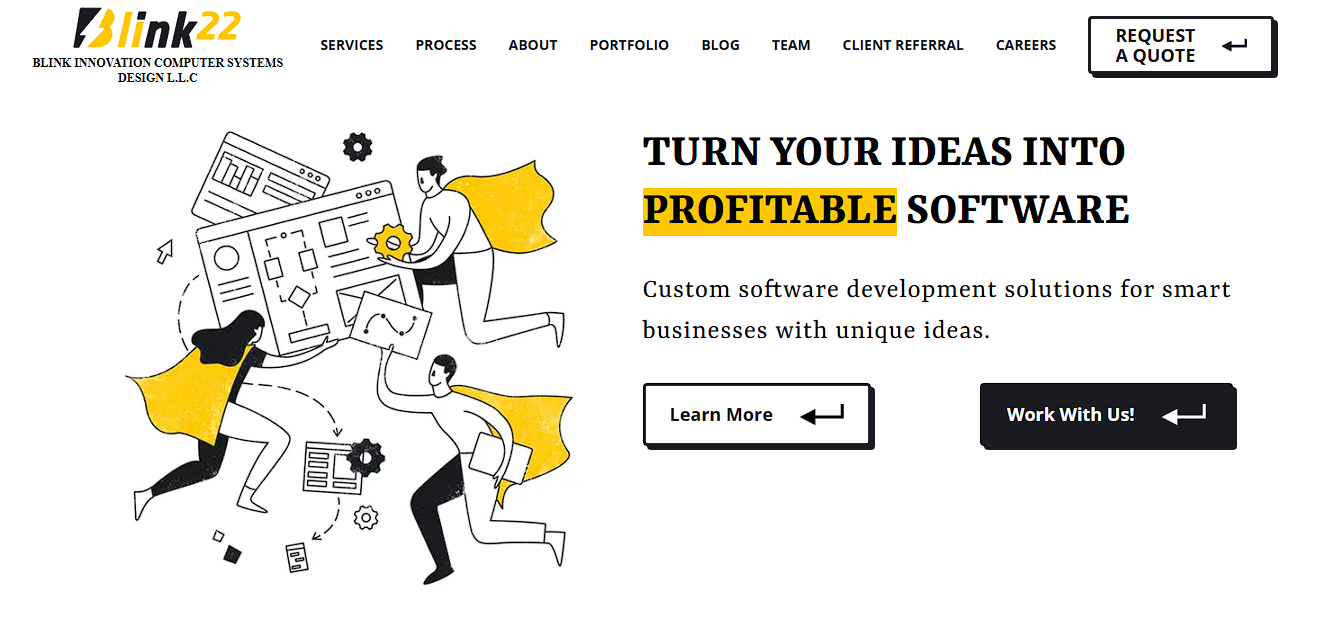
Blink22 achieves a perfect 5.0 Clutch rating across 30 reviews. Based in Dubai with branches in UK, Singapore, and KSA, they have 10+ years experience and 100+ engineers.
Core services:
- Web development (backend and frontend)
- Mobile development for iOS and Android
- Chatbot development
- Custom software solutions
Best for: Companies building customer-facing products where design excellence and user engagement drive business success.
Euvic

Euvic operates with 6,000+ IT specialists globally, 20+ years in business, and 3,000+ delivered projects. Their 4.8 Clutch rating reflects enterprise focus with 92% employee retention.
Enterprise capabilities:
- Business consulting and digital transformation
- Custom software development
- Cloud services and migration
- Automation and innovation
- Team extension and staff augmentation
- Performance marketing
Best for: Large enterprises and government entities needing proven processes for major digital transformation with global delivery capabilities.
Fingent
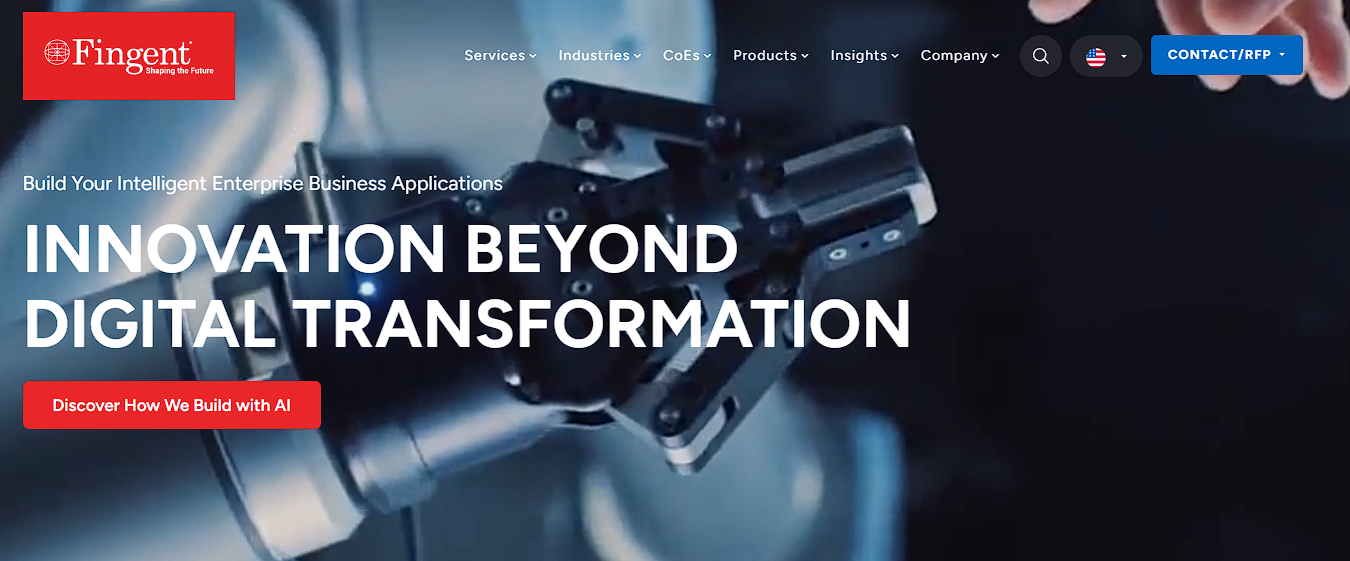
Fingent is an ISO 27001-certified company with 300+ employees and 57 Clutch reviews. They serve Fortune 500 clients including Sony, Johnson & Johnson, NEC, and PwC.
Service areas:
- AI-driven development and data engineering
- Cloud-native solutions
- Custom software development
- SAP implementation and consulting
- Extended reality (AR/VR/MR)
- Data visualization
Best for: Mid-to-large enterprises needing comprehensive software development services with enterprise-grade quality and global support.
Apptunix

Apptunix holds a 4.9 Clutch rating with 80 reviews. Founded in 2013, they have 300+ professionals with offices in USA, UK, and UAE (Business Bay, Dubai) charging $25-49/hr.
Development focus:
- Mobile app development (iOS, Android, cross-platform)
- Custom software development
- AI and machine learning integration
- On-demand delivery apps
- Healthcare and fintech solutions
Best for: Mobile-first businesses in healthcare, logistics, real estate, and fintech needing scalable app solutions with competitive pricing.
Hyperlink InfoSystem
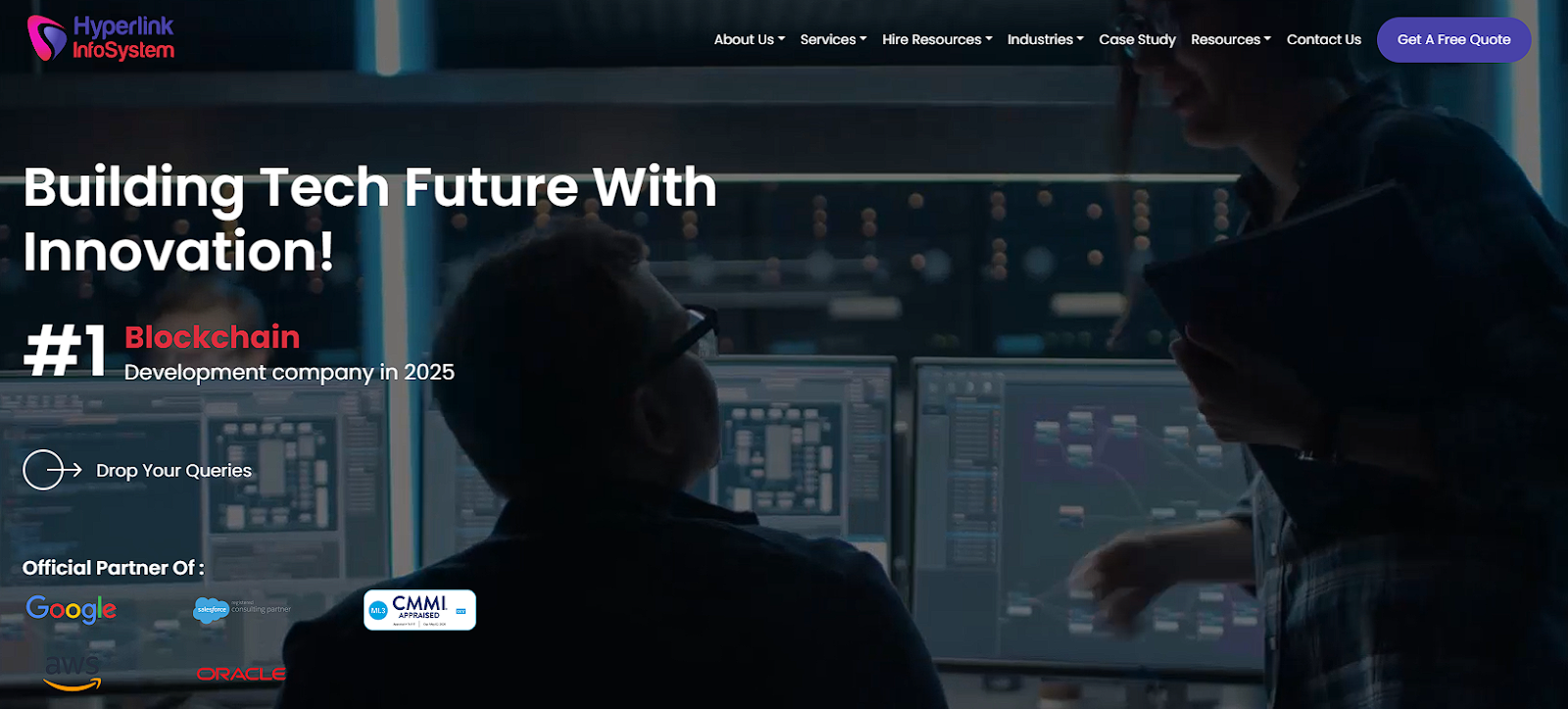
Hyperlink InfoSystem has a 4.9 Clutch rating across 171 reviews. Founded in 2011, they have 1,000+ employees and have delivered 4,500+ apps for 2,700+ clients worldwide.
Service portfolio:
- Mobile app development
- Web development
- Blockchain technology
- Data science and IoT solutions
- Salesforce development
- AI and machine learning
Best for: Diverse development needs across multiple industries requiring proven processes and global delivery capabilities.
Andersen

Andersen maintains a 4.9 Clutch rating across 129 reviews with 3,500+ professionals. Founded in 2007, they have a Dubai office on Sheikh Zayed Road.
Technical capabilities:
- Full-stack software development
- IT staff augmentation
- Mobile and web development
- Cloud and microservices architecture
- QA and testing
- Business intelligence and analytics
Best for: Organizations needing rapid team scaling with experienced developers who integrate seamlessly with existing teams.
Lumina

Lumina achieves a perfect 5.0 Clutch rating across 25+ reviews as a Premier Verified partner. This Dubai-based team specializes in eCommerce and digital marketing.
Core services:
- Shopify and eCommerce development
- Web development and design
- SEO and PPC management
- Digital strategy
- Social media marketing
Best for: Retail and D2C brands needing fast, design-led eCommerce builds with integrated CRO/SEO and measurable ROAS improvements.
Code Brew Labs
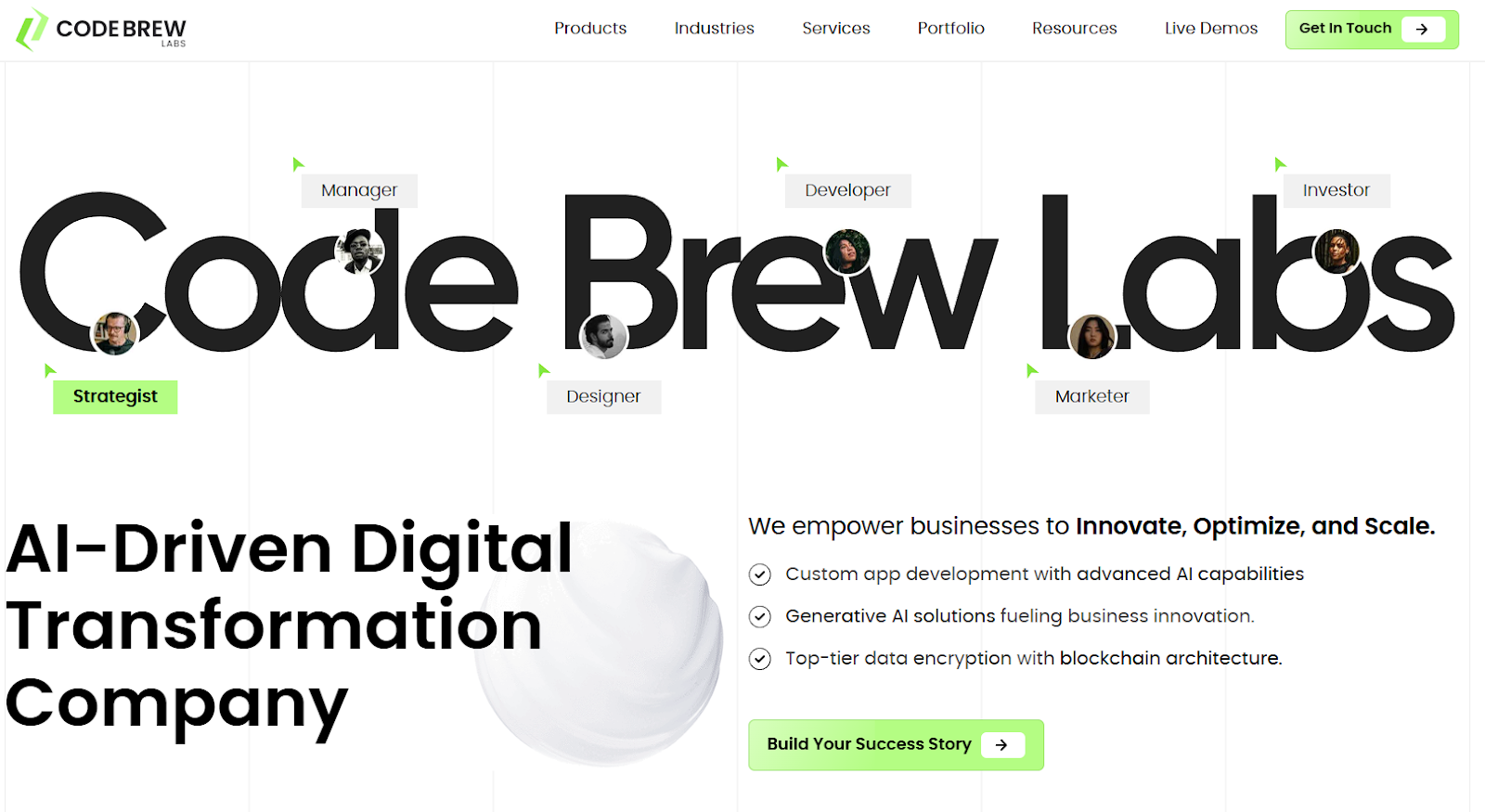
Code Brew Labs holds a 4.7 Clutch rating across 48 reviews. Founded in 2013 with headquarters in Dubai World Trade Centre Tower, their 200+ team charges $30-70/hr.
Development services:
- Mobile app development (iOS and Android)
- AI and machine learning integration
- Blockchain development
- Fintech and on-demand solutions
- UI/UX design
Best for: Startups and enterprises building on-demand platforms and fintech solutions with AI integration.
Toptal
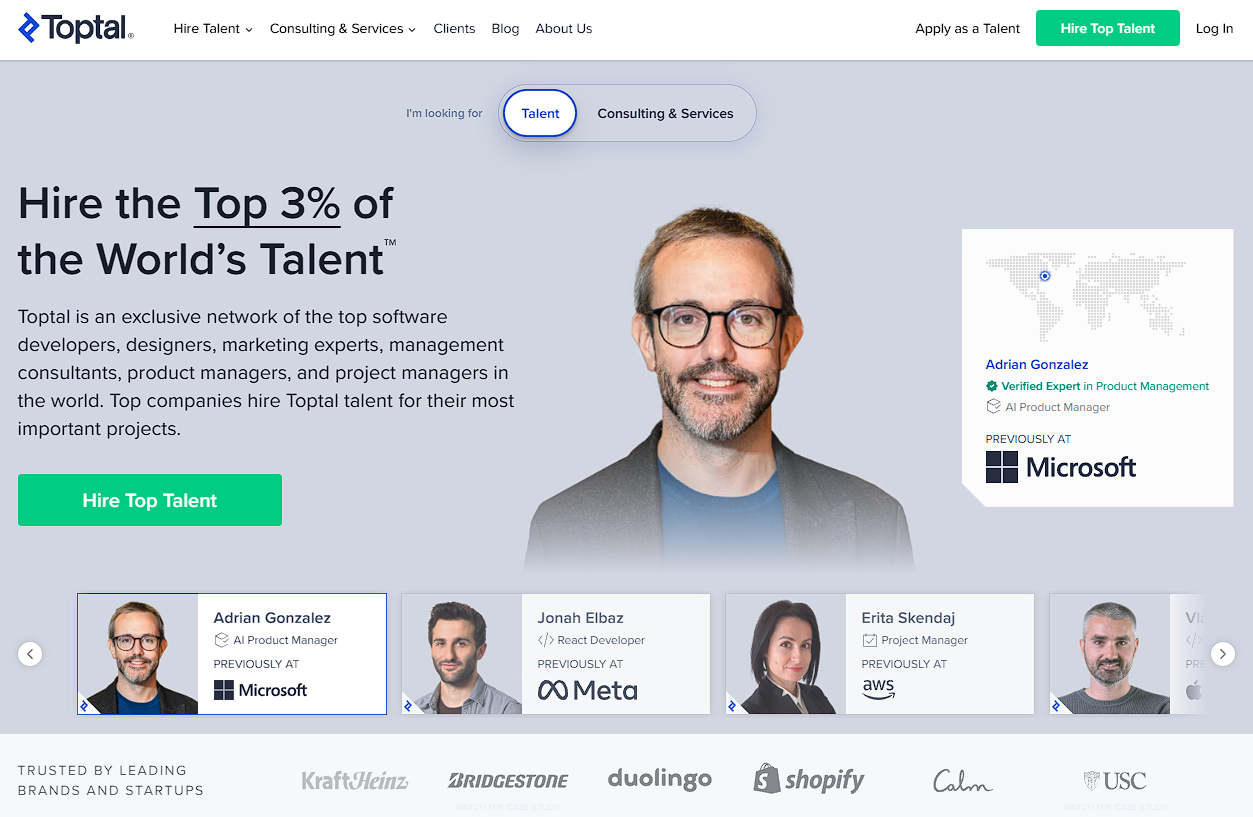
Toptal is a global talent marketplace connecting businesses with the top 3% of freelance software developers, designers, and finance experts with hiring possible within 48 hours.
Talent categories:
- Software development across all stacks
- UI/UX design
- Project management
- DevOps and cloud architecture
- Mobile development
Best for: Companies needing immediate access to specialized, vetted talent for mission-critical initiatives without long-term commitments.
Cubix

Cubix maintains a 4.8 Clutch rating across 52 reviews with 16+ years of experience. Headquartered in Washington DC with a Dubai branch, they charge $25-49/hr.
Expertise areas:
- Custom software development
- Mobile app development
- Game development
- Blockchain and AI/ML
- AR/VR/XR solutions
- Business intelligence analytics
Best for: Companies building enterprise software, gaming applications, or immersive AR/VR experiences with strong technical guidance.
Why Choose Ontik Technology for Software Development in Abu Dhabi
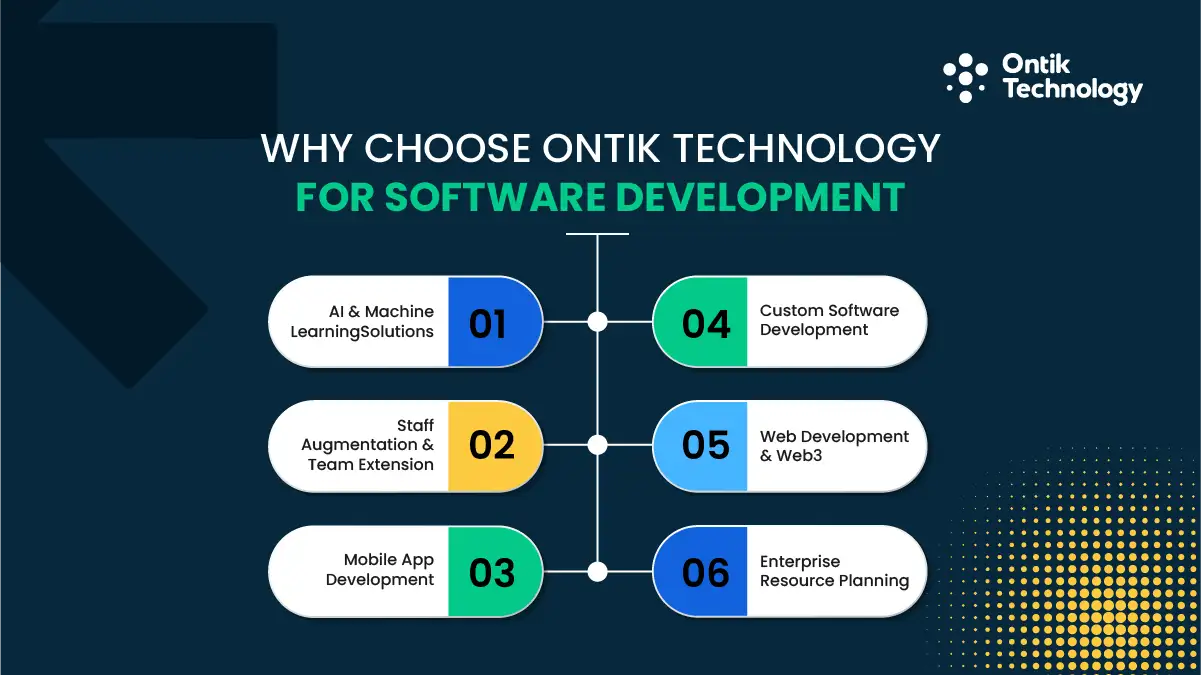
Ontik Technology has established itself as a premier software development partner in Abu Dhabi, distinguished by its impressive track record of over 500 successful projects and a stellar 4.5 Google rating from 57 reviews.
Since its founding in 2016, the company has cultivated a culture deeply rooted in research, continuous learning, and the adoption of cutting-edge technologies that keep clients ahead of the competitive curve.
Comprehensive Service Portfolio for Modern Business Needs
Ontik Technology offers a diverse range of specialized services designed to address today's digital challenges:
- AI & Machine Learning Solutions – Delivering intelligent automation and data-driven insights that produce measurable business outcomes
- Staff Augmentation & Team Extension – Providing top-tier talent precisely when you need it, with dedicated development teams that function as your extended tech squad
- Mobile App Development – Creating engaging, user-centric applications across iOS and Android platforms
- Custom Software Development – Building bespoke solutions tailored to your unique business requirements
- Web Development & Web3 – From scalable web platforms to blockchain-integrated solutions
- Enterprise Resource Planning – Implementing comprehensive ERP systems for streamlined operations
- BI & Data Science – Transforming raw data into actionable insights through advanced analytics and visualization
- MVP Development – Rapidly building minimum viable products to validate ideas and accelerate time-to-market
Ontik Technology offers enterprise-grade solutions at competitive rates (under $25/hr). Their 150+ professionals are versatile in complex challenges across real estate, fitness, mentorship, and cultural education.
With a strong UAE presence, they ensure seamless collaboration in Abu Dhabi. They specialize in digital transformation, modernizing legacy systems, and integrated business automation to optimize workflows, scale efficiently, and maintain business continuity.
How to Choose a Software Development Company in Abu Dhabi
Selecting the best software development company in Abu Dhabi requires systematic evaluation of technical capability, regional market readiness, and partnership potential. Understanding the software development process in Abu Dhabi companies helps you make informed decisions.
Define Your Goals and Requirements First
Define your goals, success metrics, and must-have features before contacting vendors. Start with the business problem, not the solution. Are you building an MVP or a full web application platform? MVPs validate assumptions quickly in 10-14 weeks. Full builds need 6-12 months.
Map must-have features versus nice-to-haves. Identify the critical 20% delivering 80% of value. Set realistic budgets including development, hosting, maintenance, and future enhancements.
Verify the Company's Regional Market Readiness
Demand proof of Arabic-RTL implementation, local payment integrations, and PDPL-compliant data handling from actual projects. Ask for screenshots showing RTL layouts working naturally in Arabic.
Check for working integrations with local providers like Telr, PayTabs, and Network International. Verify PDPL compliance: Where is data hosted? How do they handle consent? What encryption standards?
Request Technical Proof Before Signing Contracts
Request architecture diagrams, CI/CD pipeline descriptions, and code samples before signing. Good diagrams show system components, data flow, scaling strategies, and failure modes.
Ask about automated testing, build automation, and observability. Review code samples for consistent style, meaningful names, error handling, and security practices
Common Mistakes When Hiring Software Developers in Abu Dhabi
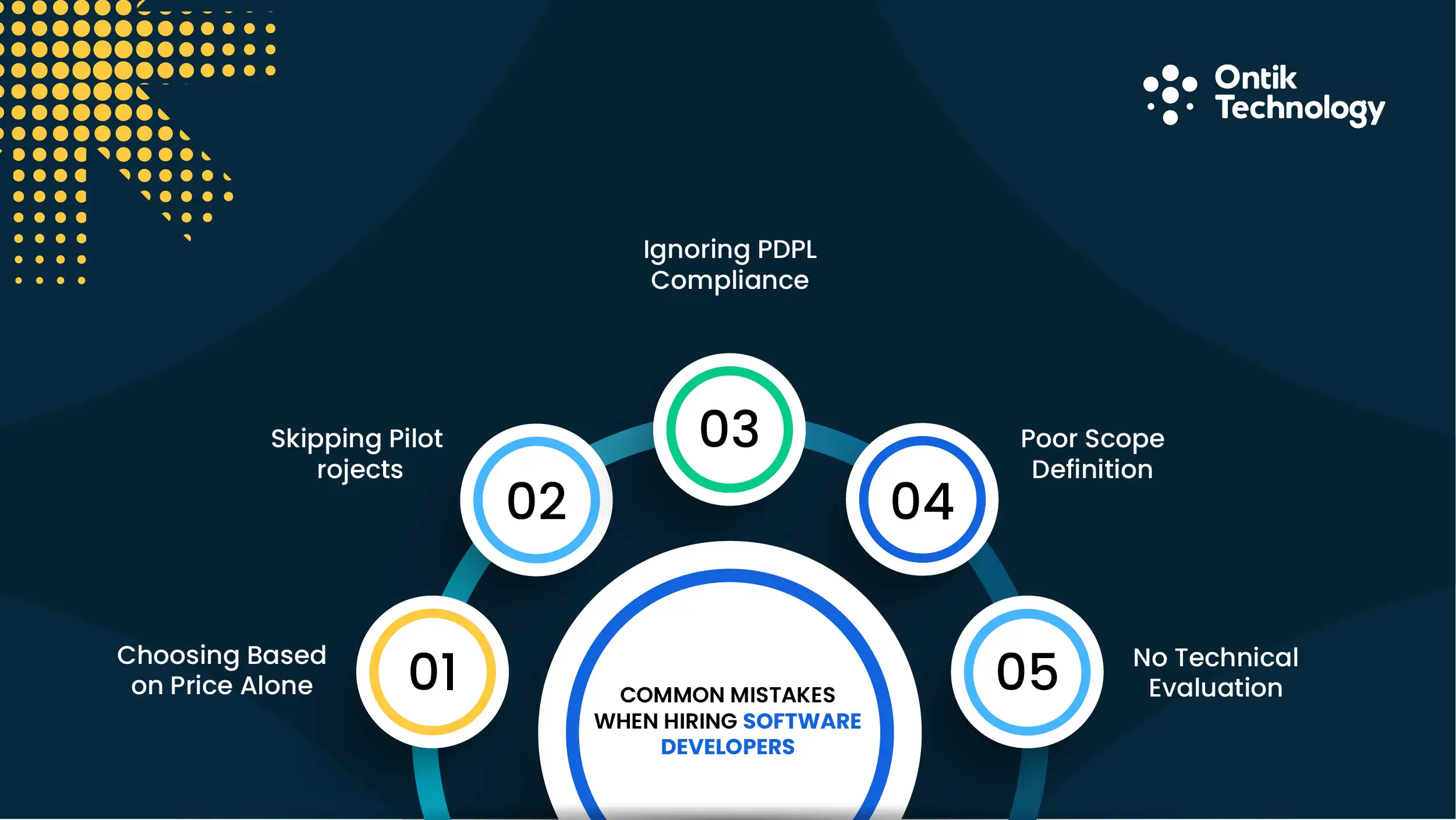
Choosing Based on Price Alone
Many businesses select vendors based solely on hourly rates, leading to budget overruns and failed deliveries. A developer charging $15/hour who takes three times longer costs more than a $50/hour expert who delivers efficiently. Cheap developers often lack experience with regional requirements like Arabic-RTL layouts, PDPL compliance, and local payment gateway integrations. Quality developers justify higher rates through efficient delivery, fewer bugs, and proper architecture that scales.
Skipping Pilot Projects
Jumping into full contracts without pilot projects means gambling with your entire budget. Communication styles, development practices, code quality, and cultural fit only reveal themselves during real collaboration. A 3-4 sprint pilot costing $10,000-$25,000 tests delivery capability before committing $100,000+. Many businesses skip pilots to save money upfront, then waste far more on failed projects with incompatible vendors.
Ignoring PDPL Compliance
The Personal Data Protection Law carries penalties up to AED 10 million for violations. Vendors who do not understand PDPL compliance put your business at legal risk. Compliance affects architecture decisions about data residency, encryption standards, and access controls that must be designed from the start.
Poor Scope Definition
Vague requirements give vendors no boundaries. Without clear scope, costs balloon and launch dates slip. Good scope definition identifies must-have features versus nice-to-haves, defines success metrics, and establishes boundaries.
No Technical Evaluation
Sales presentations hide implementation quality behind polished demos. Request architecture diagrams, code samples, and CI/CD pipeline documentation before signing. Technical evaluation separates professional firms from amateurs.
What Is the Cost of Software Development in Abu Dhabi?
Software development costs in Abu Dhabi range from $49 to $120 per hour, with local agencies typically charging $55 to $95 per hour for full-service delivery including project management and QA. Offshore development teams from Eastern Europe and India offer more budget-friendly rates between $20 and $40 per hour.
Full app development projects in Abu Dhabi typically cost $19,000 to $98,000 depending on complexity, while Dubai projects run slightly higher at $24,500 to $120,000 due to increased living expenses and market demand.
Hourly rates by experience level:
- Junior developers: $33-$44/hr
- Mid-level developers: $44-$61/hr
- Senior developers: $66-$99/hr
- Architects/Specialists: $99-$120/hr
Monthly salaries for in-house developers:
- Mid-level mobile developer: $6,800-$12,000/month
- Average software engineer: $27,800/month
MVP development typically takes 3-4 months for most projects, allowing businesses to validate ideas before committing to full-scale development.
Project complexity, payment gateway integrations, Arabic-RTL implementation, and PDPL compliance requirements all affect final costs. Plan for 30-40% extra beyond initial quotes to cover compliance, hosting, and iteration work.
Typical Software Development Timelines in Abu Dhabi
Delivery timelines vary based on project complexity and scope. Most capable software development companies in Abu Dhabi follow these general timeframes:
Simple applications and MVPs take 10-14 weeks with clear requirements and modern CI/CD practices. Medium-complexity platforms with multiple integrations require 3-6 months. Complex enterprise systems with extensive features and compliance requirements need 6-12 months or longer.
Several factors influence delivery speed. Clear requirements enable immediate development. Modern DevOps and experienced teams accelerate delivery. Scope creep, unclear requirements, and integration complexity slow timelines. Responsive stakeholders enable rapid progress. Companies using agile methodologies typically deliver working features faster through iterative sprints.
In-House Development vs Outsourcing
The decision depends on your context. Startups benefit from outsourcing for speed and cost efficiency. Enterprises with complex IP may prefer internal teams. Benefits of hiring local software developers in Abu Dhabi include timezone alignment, cultural understanding, and easier face-to-face collaboration.
In-house offers control but requires recruiting time and high salaries. Outsourcing provides speed and flexibility but less control. End-to-end development offers the best of both worlds, giving you a dedicated partner who handles everything from discovery and design through development, testing, and deployment. Many businesses use a software solutions provider Abu Dhabi for complete project delivery while maintaining lean internal teams.
Understanding the benefits of end-to-end development helps you choose the right model for your situation.
Software Development Trends in Abu Dhabi 2025
Abu Dhabi's software market is surging with unprecedented government backing. The UAE IT services market is expected to reach USD 20.24 billion in 2025, growing at 13.24% CAGR to USD 37.69 billion by 2030. Abu Dhabi alone has allocated AED 13 billion through its Digital Strategy 2025-2027 to drive innovation.
AI dominates the landscape. Abu Dhabi aims to become the world's first fully AI-native government by 2027, implementing over 200 AI solutions across government services. The emirate's AI ecosystem has grown 61% as companies deploy chatbots, predictive analytics, and computer vision for practical outcomes.
Cloud adoption is accelerating with mandated 100% sovereign-cloud adoption for government services by 2027. Cybersecurity spending is rising sharply. The UAE's AI in cybersecurity market will grow from USD 1.2 billion to USD 5.36 billion by 2030 at 27.4% CAGR.
Low-code platforms and mobile-first solutions round out the trends, enabling faster development cycles across industries.
Conclusion
Abu Dhabi has emerged as a formidable force in global software development. Backed by Vision 2030 investments, $2 billion in Hub71 incentives, and world-class infrastructure, the emirate has created an ecosystem where innovation thrives and businesses gain genuine competitive advantage.
What sets Abu Dhabi apart is its focus on substance over hype. The companies profiled here deliver enterprise-grade solutions, deep expertise in mission-critical systems, and regional market knowledge that international vendors cannot match. They understand PDPL compliance, Arabic-RTL implementation, and local business realities.
Choosing a software development partner from Abu Dhabi means tapping into a market growing at 12.5% annually with competitive pricing and uncompromising quality. The tech ecosystem here is not just growing. It is maturing into a reliable, innovation-driven hub where your next software project can be built faster, smarter, and closer to your market.
Frequently Asked Questions
Which software development company in Abu Dhabi is best for startups?
BidsCube and Ontik Technology offer excellent value for startups. BidsCube combines development with business coaching at affordable rates. Ontik provides AI-powered solutions with rates under $25/hr and a perfect 5.0 Clutch rating.
How long does it take to build custom software in Abu Dhabi?
MVPs typically take 10-14 weeks with clear requirements. Medium platforms need 3-6 months. Complex enterprise systems require 6-12 months. Timeline depends on scope, integrations, and team responsiveness. Understanding software development case studies Abu Dhabi helps set realistic expectations. Learn more about AI MVP development for modern product launches.
Do Abu Dhabi software companies understand PDPL compliance?
Leading companies like Transit Security and ValueLabs specialize in PDPL-compliant development. Always verify their experience with data residency, encryption standards, and consent management before signing.
What is the average cost of app development in Abu Dhabi?
Simple mobile apps cost $30,000-$60,000. Complex apps with backend integration range $60,000-$150,000. Enterprise applications start at $150,000+. Hourly rates run $40-$150 depending on expertise.
Should I hire a local Abu Dhabi company or outsource internationally?
Local companies understand regional market nuances, PDPL compliance, and Arabic-RTL requirements. International firms may cost less but lack regional expertise. Hybrid models using companies like Ontik (global talent, local presence) offer the best balance. Benefits of hiring local software developers in Abu Dhabi include better communication and cultural alignment. Compare this with mobile app development companies in Dubai to understand regional differences.
Which programming languages are most used in Abu Dhabi?
JavaScript/TypeScript, Python, and React dominate. Node.js powers backends. React Native and Flutter enable cross-platform mobile development. Java and .NET remain strong for enterprise projects.
How do I verify a software development company in Abu Dhabi technical capabilities?
Request architecture diagrams, code samples, and CI/CD pipeline documentation. Ask for client references you can call. Run a 3-4 sprint pilot project before full commitment. Review their Clutch ratings and software development case studies Abu Dhabi to assess proven track records.
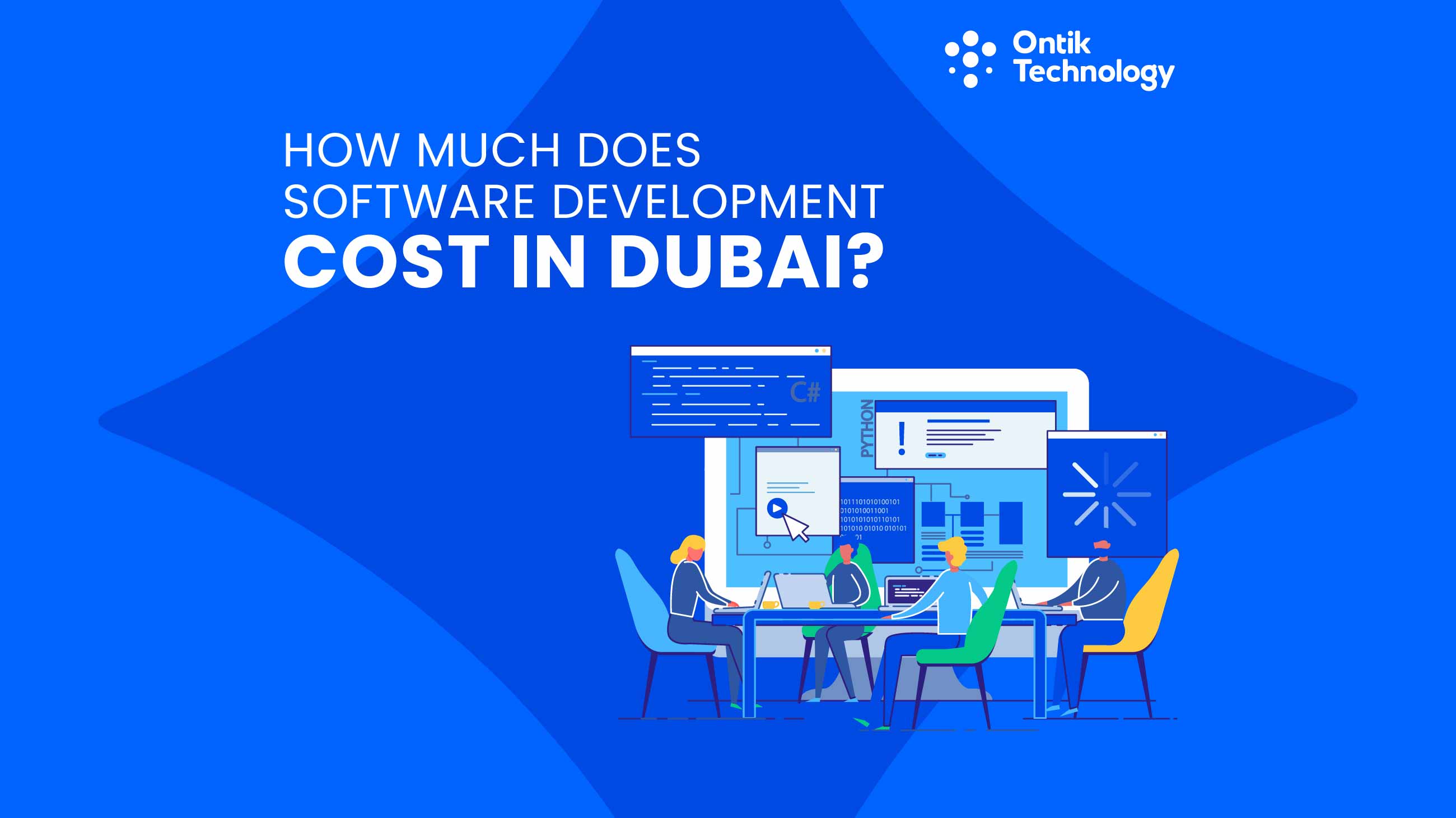

Planning a software project in Dubai? The first question that hits you is always about money. How much will this actually cost? The answer is not simple because software development costs in Dubai can swing wildly based on what you are building and who builds it for you.
You might get quotes from AED 40,000 to well over AED 500,000 for the same project idea. Confusing, right? This guide breaks down every cost factor you need to know. You will learn exactly where your money goes and how to budget smartly for your next software project.
Dubai has become a serious tech hub in the Middle East. The city attracts talented developers and innovative companies from around the world. But with opportunity comes complexity, especially when it comes to software development pricing.
To avoid unexpected budget issues, it's essential to understand the costs upfront, whether you're seeking custom software development or specific, specialized solutions. We'll bypass the generalities and provide you with concrete figures.
Software Development Cost in Dubai: 2026 Price Breakdown
Custom software development in Dubai typically ranges from AED 146,000 to AED 1,800,000 ($40,000 to $500,000+). The wide range exists because every project brings unique requirements and challenges. Software companies in Dubai operate across different pricing tiers based on expertise and service models.
Understanding software development pricing models is crucial when evaluating quotes. The software development rate Dubai market offers varies significantly, and knowing the cost of software developers UAE helps you make informed decisions. The average software project budget Dubai depends on multiple variables, but using a Dubai software cost calculator can provide initial estimates for planning purposes.
Here is what you can expect based on project complexity:
Cost by Complexity Level
AI software development costs more. These intelligent systems range from AED 110,000 to AED 1,100,000+ ($30,000 to $300,000+). The price jumps because AI requires specialized skills, extensive data processing, plus ongoing model training.
A simple calculation helps you estimate costs early. Take your project hours and multiply by the hourly software development rate in Dubai. Quality teams average around AED 300 per hour. So a 500-hour project costs roughly AED 150,000 before additional expenses.
Mobile app development cost sits in a similar range. Basic apps start around AED 73,000 ($20,000), while complex marketplace apps can hit AED 257,000 ($70,000) or more. The platform choice matters too. Android app development cost often runs 15-20% higher than iOS app development services because of device fragmentation.
Understanding these ranges helps you plan budgets realistically. Next, let's explore why these costs vary so dramatically.
Why Software Development Costs Vary So Much in Dubai

Several forces drive the massive price differences you see when you develop software in Dubai. Understanding these helps you evaluate quotes and avoid surprises.
Key factors that influence cost variations:
- Regulatory compliance requirements specific to UAE markets
- Location-based salary expectations and overhead costs
- Technology complexity and specialized skill requirements
- Project scope clarity and change management
- Team structure and engagement model choices
The UAE market adds unique layers. UAE regulatory compliance PDPL requirements are mandatory for all software projects. Dubai operates under specific regulations like the Personal Data Protection Law (PDPL). Your software must comply with these rules. Compliance work adds planning time, legal reviews, plus security implementations that increase development cost by 10-25%.
Location plays a big role too. The Dubai developer hourly rate commands premium pricing compared to offshore teams but offers advantages. You get face-to-face meetings, local market knowledge, plus easier communication across time zones. Many businesses choose hybrid models to balance cost efficiency and quality.
Technology choices create price gaps. Understanding software development cost factors helps you anticipate where expenses accumulate. A basic web app using standard frameworks costs far less than a blockchain-powered platform with AI features. Project complexity cost analysis reveals that advanced tech requires specialized software developers who command premium rates. Machine learning engineers, for example, can cost 40-60% more than general full-stack developers. The team structure impact pricing significantly, with different engagement models offering varying cost benefits.
Project scope creep kills budgets. Research from Deloitte shows that 30% of cost overruns stem from poorly defined requirements. When features keep getting added mid-project, development time stretches and costs spiral. This is why discovery phases matter so much.
Development team structure influences pricing significantly. An in-house team in Dubai might cost AED 400,000+ annually per developer when you factor in salaries, benefits, office space, plus equipment. Offshore software team options through companies like Ontik Technology can cut those costs by 40-60% while maintaining quality.
Dubai vs Middle East: Regional Cost Comparison
How does Dubai stack up against neighbors? Let's look at software development cost Middle East pricing across the Gulf region.
Regional Hourly Rates (2026)
The regional hourly rate developers command varies based on market maturity and living costs. Dubai and Qatar lead in pricing because of higher living costs plus strong demand for tech talent. When comparing Dubai vs Saudi Arabia software pricing, you'll notice Saudi Arabia provides competitive rates plus massive market opportunity through Vision 2030 initiatives.
Quality varies by location too. The UAE has invested heavily in tech education and attracts international talent. This creates a deeper pool of experienced development companies compared to smaller markets. You might save 20% in Bahrain but spend more time on quality control.
Middle East IT outsourcing trends show increasing adoption of hybrid models. Many smart businesses use offshore development to maximize value. Offshore software development savings can reach 50-70% compared to local rates. Ontik Technology operates from Bangladesh with international delivery standards. Their hourly rate software development Middle East projects run 50-70% lower than Dubai while maintaining ISO-certified quality processes. You get experienced developers at $25-35 per hour instead of $60-80.
Regional differences matter less when you partner with the right team. What really drives your total cost is understanding the specific factors that influence every project.
What Drives Software Development Costs in Dubai?
Let's break down the specific factors that push your budget up or down. Each element compounds to create your final development cost in Dubai.
Project complexity sits at the top. A simple informational app with five screens costs dramatically less than an enterprise resource planning system with 50+ modules. Complexity shows up in features, user roles, data structures, plus integration points. More complexity means more development hours.
Technology stack impact on costs:
- Standard frameworks (React, Node.js): Lower rates due to larger talent pool
- Advanced AI/ML systems: 30-50% premium for specialized expertise
- Blockchain development: Premium rates for cryptography specialists
- Cloud-native architecture: Moderate costs with scalability benefits
Design investment ranges from 15-25% of total budget. Quality UI/UX design for software startups UAE plus professional branding and UI UX design cost in Middle East can boost conversions by up to 400% according to Statista. Professional UI/UX design services reduce support tickets plus training time significantly.
Integration requirements often surprise clients. Connecting to existing ERP systems, customer relationship management platforms, or payment gateways adds substantial work. Each integration needs custom API development, testing, plus security measures. Complex integrations can add 20-30% to project costs.
Security and compliance cannot be optional in Dubai. The UAE Personal Data Protection Law plus industry regulations create mandatory requirements. Cybersecurity services cost in Middle East projects add 15-20% to development cost but protect you from legal problems.
Team location creates the biggest price swings. Here is how rates compare globally:
- North America: $100-200 per hour
- Western Europe: $80-150 per hour
- Dubai/UAE: $60-80 per hour
- Eastern Europe: $40-60 per hour
- South Asia: $25-40 per hour
Hybrid models give you the best of both worlds. Keep project management plus client communication in Dubai while leveraging offshore software team Middle East options for coding. Understanding staff augmentation best practices helps you implement this approach effectively. This can reduce cost of software development by 40% compared to fully local teams.
Service-Wise Cost Breakdown: What You'll Actually Pay
Different types of software carry different price tags. Here is what each service actually costs in the Dubai market.
MVP Development Costs
MVP development cost in Middle East projects helps you test ideas before committing to full-scale development. Basic MVPs start around AED 36,750 ($10,000) for simple concepts. More sophisticated MVP software development services Dubai projects run AED 110,000-220,000 ($30,000-60,000).
Ontik Technology's MVP development services specialize in rapid delivery. Their lean approach cuts costs by focusing only on essential features. You get a working product in 8-12 weeks instead of 6+ months.
MVP cost breakdown by phase:
- Discovery and planning: 10-15% of total budget
- MVP design and prototyping: 20-25% of total budget
- Development and coding: 50-60% of total budget
- Testing and deployment: 10-15% of total budget
Smart MVP planning can cut your initial investment by 30%. Affordable MVP development for startups Middle East options make launching possible even with limited budgets. MVP app development cost in Qatar and Saudi markets run similar to UAE pricing. For AI-focused products, AI MVP development requires additional budget for data preparation plus model training.
AI Development Costs
AI software development UAE represents one of the fastest-growing sectors in the technology landscape. AI software development cost in Middle East projects range widely based on complexity. Basic chatbots with rule-based logic start around AED 100,000 ($27,000). AI chatbot cost Dubai for mid-level implementations with machine learning capabilities runs AED 250,000-600,000 ($68,000-165,000).
The machine learning development cost depends heavily on data quality and model complexity. You need clean, labeled datasets for training. Data collection plus preprocessing can consume AED 30,000-100,000 alone. Poor data quality forces expensive rework cycles. When seeking an AI development company Dubai, ensure they have proven experience with data engineering and model optimization.
Natural language processing solutions UAE require specialized expertise and typically cost 20-30% more than standard AI implementations. Machine learning development company UAE teams often use third-party AI services that add ongoing costs.
Using OpenAI APIs or Google Vision runs $100-500 monthly. Custom AI and machine learning solutions demand careful budgeting because talent costs more and projects take longer than traditional software development in Dubai.
The UAE's National AI Strategy 2031 creates opportunities for AI-focused businesses. AI consulting services for startups in Qatar and across the region support this growth. AI and machine learning solutions for businesses Middle East avoid ongoing fees but require higher upfront investment.
Web Development Costs
Website development cost Dubai varies significantly based on project scope and functionality. Corporate website development Saudi Arabia plus website maintenance cost UAE packages range from AED 50,000-150,000 ($15,000-40,000) for standard sites. E-commerce website development Dubai with payment processing plus inventory management runs AED 150,000-400,000 ($40,000-110,000).
WordPress website cost in Qatar offers budget-friendly options starting around AED 20,000 ($5,500). Custom web application UAE development using frameworks like React or Next.js cost more but provide better performance plus scalability. Finding the right web design and development company Dubai ensures your project meets both technical and business requirements.
Web development pricing tiers:
- Basic business website: AED 50,000-80,000
- E-commerce platform: AED 150,000-250,000
- Custom web application: AED 300,000-600,000
- Enterprise web portal: AED 600,000+
Web Design & Development Agency in Abu Dhabi, UAE teams plus Web Design & Development Agency in Riyadh, KSA providers offer comprehensive packages. Professional web development services include ongoing maintenance at 15-20% annually. Cloud hosting on AWS or Azure runs AED 700-3,700 ($200-1,000) monthly depending on traffic.
Mobile App Development
Mobile app development cost in Middle East starts around AED 90,000 ($25,000) for basic functionality. Android app development cost UAE plus iOS app development services Dubai run similar amounts individually. Hybrid app development cost Saudi Arabia using React Native or Flutter runs AED 110,000-257,000 ($30,000-70,000) and works on both platforms.
Cross-platform app development pricing Qatar saves money compared to building separate native apps. Mobile app developers in Middle East understand regional requirements plus user preferences. Mobile app development services deliver both native and cross-platform solutions.
Feature complexity drives mobile costs. Simple apps (4-6 screens) cost AED 90,000-130,000. Medium complexity (10-15 screens) runs AED 130,000-220,000. Complex apps (20+ screens) exceed AED 220,000.
On-demand app development cost UAE for services like ride-sharing or food delivery sits at the higher end. App development cost in Dubai includes store submission plus compliance at AED 3,700-7,400 ($1,000-2,000). Annual maintenance runs 20% of development cost.
Custom Software Development
Custom software development cost in Middle East represents the biggest investment. Enterprise software development UAE costs range from AED 440,000 to AED 1,800,000+ ($120,000-500,000+) based on scope.
Custom CRM development cost Dubai runs AED 250,000-750,000 ($70,000-200,000). ERP software development services UAE cost even more at AED 750,000-2,200,000 ($200,000-600,000). The complexity comes from integrating multiple business processes plus legacy systems.
Bespoke software solutions Middle East projects justify the investment through ownership benefits. Custom software development in Dubai eliminates licensing fees for commercial products. You own the code completely. Software product development cost Saudi Arabia plus custom software development company Qatar pricing follows similar patterns. Long-term ROI often exceeds 240% for well-planned projects.
Cybersecurity Services
Security cannot be an afterthought in Dubai's regulated environment. Basic security implementations add AED 18,000-29,000 ($5,000-8,000) to projects. Advanced security with encryption, audit trails, plus penetration testing runs AED 55,000-367,000 ($15,000-100,000+).
Essential cybersecurity services:
- Security audit and vulnerability assessment: AED 10,000-30,000
- Penetration testing: AED 15,000-40,000
- Managed security monitoring: AED 5,000-20,000 monthly
- Compliance implementation: AED 20,000-100,000
Cybersecurity audit services UAE plus managed cybersecurity services Middle East cost AED 5,000-20,000 ($1,400-5,500) monthly. This includes threat monitoring, incident response, plus regular security audits. Data protection services for fintech Middle East require these ongoing services.
Cybersecurity consulting company Dubai teams provide network security solutions Saudi Arabia plus UAE markets. Cybersecurity risk assessment cost UAE runs AED 10,000-30,000 for comprehensive reviews. Ontik Technology provides comprehensive cybersecurity solutions with real-time threat monitoring.
Staff Augmentation Costs
IT staff augmentation Dubai offers flexibility when you need specific skills temporarily. Software development staff augmentation UAE and IT staff augmentation company Dubai rates run AED 15,000-30,000 ($4,000-8,000) monthly per developer.
Hire remote developers UAE through proven partners to reduce risk. Cost of hiring developers in Saudi Arabia plus dedicated developer cost UAE varies by experience level. Hire remote developers in Middle East through proven partners to reduce risk. Understanding staff augmentation vs outsourcing and types of staff augmentation helps you choose the right engagement model.
Dedicated development team setup can be completed in just 2 weeks. The benefits of IT staff augmentation include seamless integration with your existing team. You scale up or down based on project needs without hiring headaches.
Offshore software developers Middle East cuts costs dramatically. Offshore software team Middle East and offshore staff augmentation provide skilled developers from Bangladesh or Eastern Europe cost AED 9,000-13,000 ($2,500-3,500) monthly. You maintain quality while reducing expenses by 50-60%. Offshore staff augmentation provides access to global talent pools at competitive rates.
Real Dubai Projects: What Companies Actually Paid
Nothing beats real examples to understand how much does software development cost in practice. Here are three actual scenarios from Dubai businesses.
Small Retailer: Workflow Automation
A Dubai-based retailer needed to digitize approval processes. They had 15 screens, basic integrations, plus straightforward requirements. The project took 3 months with a modest budget around AED 150,000 ($40,000).
Results came quickly. Approval time and cost both dropped significantly. Manual errors decreased by 40%. The system paid for itself in 8 months through labor savings plus faster operations.
Mid-Size Logistics Firm: ERP Integration
A logistics company needed their new software in Dubai to connect with existing ERP plus CRM systems. Final cost to develop landed around AED 350,000 ($95,000) for the 6-month project. Support tickets fell by 25% because data flowed automatically between systems. The company recovered its investment within 18 months through operational cost savings.
Enterprise Finance Platform: Compliance Heavy
A financial services firm required extensive compliance features. The enterprise software in Dubai needed 50+ screens, multiple integrations, audit trails, plus support for thousands of users. Development time stretched 14 months with cost to build a software exceeding AED 1,800,000 ($500,000).
Steep upfront costs delivered substantial returns. Audit preparation time dropped 35%. Regulatory reporting became automated. Enterprise software development investments pay off over 3-5 years when planned strategically.
How to Estimate Your Software Development Budget
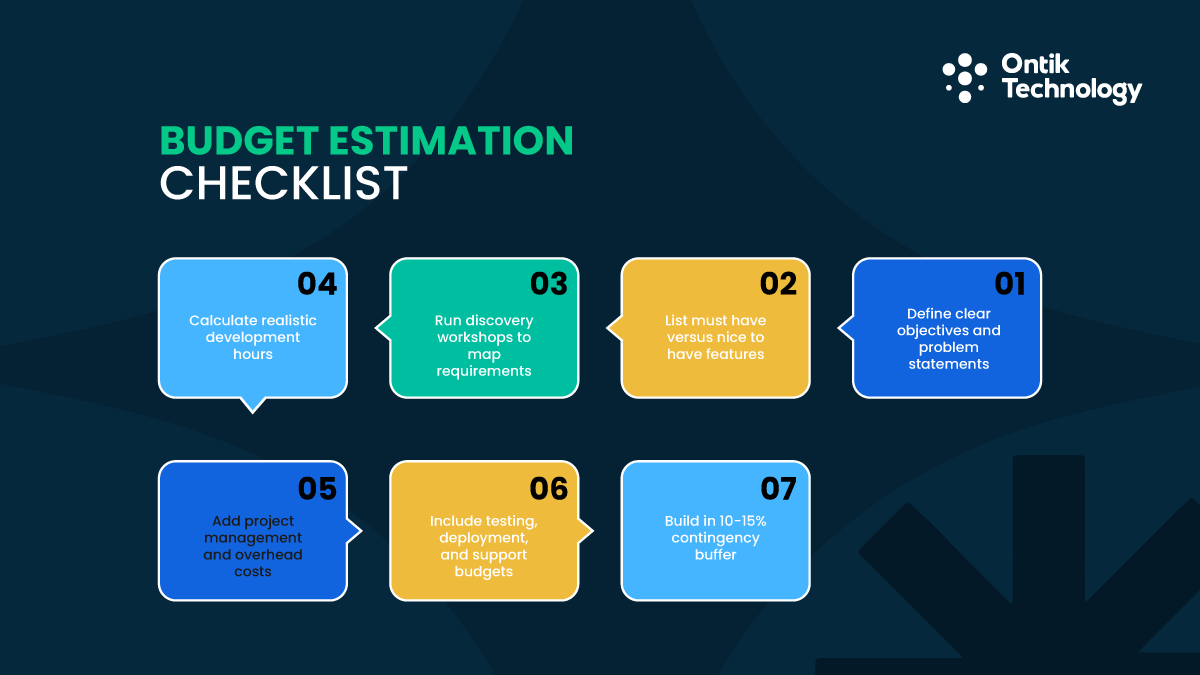
You need a systematic approach to budget accurately for development in Dubai. Follow these steps to avoid surprises.
Budget estimation checklist:
- Define clear objectives and problem statements
- List must-have versus nice-to-have features
- Run discovery workshops to map requirements
- Calculate realistic development hours
- Add project management and overhead costs
- Include testing, deployment, and support budgets
- Build in 10-15% contingency buffer
Start with clear objectives. Write down exactly what problems your software must solve. List must-have features separately from nice-to-have additions. This clarity prevents scope creep that inflates cost due to poor planning by 30% according to Deloitte research.
Run discovery workshops early. Spend AED 7,000-37,000 ($2,000-10,000) upfront to map requirements thoroughly. Development companies in Dubai that invest in discovery are 30% less likely to face budget overruns according to the Project Management Institute.
Calculate development hours realistically using a development hours calculator. A proper cost estimation formula software accounts for all project phases. Simple apps need 300-500 hours. Medium complexity projects require 500-1,200 hours. Complex enterprise software systems consume 2,000+ hours. Multiply your hours by average cost rates to get base development cost.
Agile project budgeting UAE methodologies allow for iterative refinement and better cost control. MVP budgeting for startups Dubai focuses on essential features first, reducing initial capital requirements while validating market fit.
Add these often-forgotten expenses:
- Project management (10-15% of dev costs)
- Quality assurance plus testing (15-20%)
- Design and UX work (15-25%)
- Deployment plus setup (5-10%)
- Post-launch support (15-20% annually)
Include a contingency buffer of 10-15%. McKinsey data shows nearly 50% of large IT projects overshoot budgets. Break costs into phased development cycles. Phase 1 might be MVP with core features. Phase 2 adds advanced functionality. This approach reduces upfront investment while delivering value incrementally.
Cost-Saving Strategies: The Offshore Development Advantage
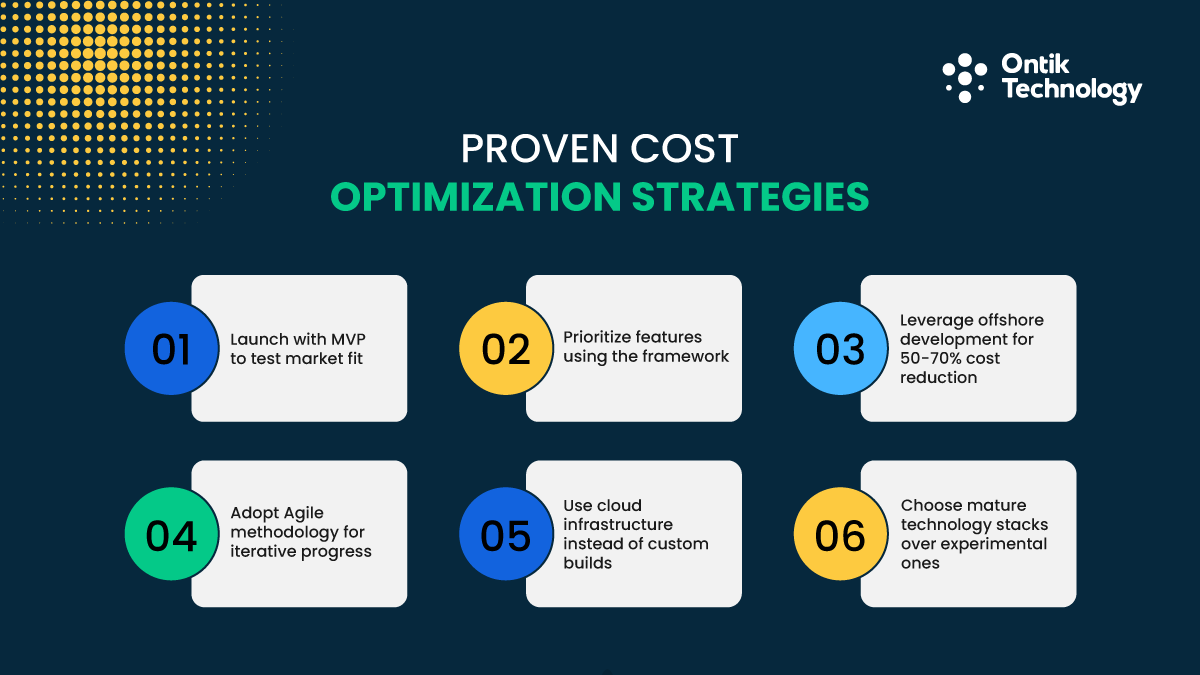
Smart businesses find ways to reduce software development cost in UAE without sacrificing quality. Here are proven strategies that work in the development ecosystem.
Start with MVP before full development. Building only essential features first cuts initial investment by 30%. You validate market fit before committing to full-scale development with expensive features.
Proven cost optimization strategies:
- Launch with MVP to test market fit
- Prioritize features using must-have/nice-to-have framework
- Leverage offshore development for 50-70% cost reduction
- Adopt Agile methodology for iterative progress
- Use cloud infrastructure instead of custom builds
- Choose mature technology stacks over experimental ones
Prioritize features ruthlessly. Create three buckets: must-have, should-have, plus nice-to-have. Build software with only must-haves for version 1. This discipline keeps budgets under control while delivering functional products.
Leverage offshore development strategically. This represents the single biggest opportunity for cost savings. Remote staff augmentation teams from South Asia cost 50-70% less than Dubai-based development teams. Quality remains high when you choose experienced partners.
Ontik Technology exemplifies the offshore advantage. They deliver enterprise-grade development from Bangladesh at rates 60% below Dubai prices. Their team includes 220+ successful projects across web, mobile app, AI, plus blockchain.
Cost Comparison: Dubai vs Offshore
Adopt Agile development practices. Agile methodology allows iterative progress with regular feedback loops. You catch problems early before they become expensive to fix.
Use cloud infrastructure instead of building everything custom. Cloud solutions from AWS, Google Cloud, plus Azure offer proven options for hosting, databases, plus scaling. You pay only for what you use.
Choose proven technologies over experimental ones. Mature frameworks like React, Node.js, plus Python have large developer pools. This keeps rates reasonable and reduces project risk. For specialized needs, blockchain development requires careful planning but delivers strong security benefits.
Hidden Costs and Budget Pitfalls to Avoid
Even careful planning misses certain expenses. Watch for these common budget traps in software development companies in Dubai projects.
Maintenance costs catch many by surprise. Software needs ongoing care after launch. Expect to spend 15-20% of initial development cost annually. This covers bug fixes, security updates, minor improvements, plus technical support.
Often-overlooked ongoing expenses:
- Annual maintenance (15-20% of initial cost)
- Cloud hosting that scales with traffic
- Third-party API subscriptions
- Legal and compliance reviews
- Marketing and user acquisition
- Technical support and training
Cloud hosting expenses UAE grow with success. A basic setup costs AED 700-1,800 ($200-500) monthly. Heavy traffic can push this to AED 7,000-37,000 ($2,000-10,000) monthly. Plan for scaling costs as your user base expands in the development market.
Third-party API subscription cost adds up quickly. Third-party services accumulate expenses. Payment gateways charge transaction fees plus monthly minimums. Analytics tools, email services, plus APIs each carry subscription costs. A typical application uses 5-10 third-party services costing AED 1,800-7,400 ($500-2,000) monthly combined.
Legal plus compliance work often gets underestimated. Software compliance audit Dubai ensures adherence to local regulations. UAE regulations require specific data protection measures. Legal reviews cost AED 7,000-37,000 ($2,000-10,000) for standard projects.
Marketing plus user acquisition deserve budget allocation. Building great software means nothing if nobody uses it. Set aside 20-30% of development cost for initial marketing.
Why projects go over budget? Software development cost breakdown analysis shows these main culprits: scope creep (30% of overruns), poor requirements (25%), integration problems (20%), data migration (15%), plus team changes (10%).
McKinsey research confirms that 45% of large IT projects run over budget while delivering 56% less value than promised. The cost of building quality software requires experienced partners who understand these pitfalls.
Choosing Your Development Partner: Why Ontik Technology Delivers Value
Partner selection matters more than any other decision when you develop software in Dubai. The right team saves you money while delivering quality. When evaluating partners, consider whether staff augmentation versus consulting or staff augmentation versus managed services better fits your needs.
Essential criteria for partner selection:
- Proven track record with 500+ completed projects
- Technical expertise matching your specific requirements
- Transparent pricing with detailed breakdowns
- Strong communication and regular updates
- Flexible engagement models
- Post-launch support commitment
At Ontik Technology, we bring deep expertise across multiple technologies. Our team masters JavaScript, Python, React, Node.js, Django, Laravel, plus emerging technologies like blockchain. We have successfully delivered 500+ projects for clients worldwide since 2016.
We operate 24-hour schedules across global time zones. Our project managers provide daily updates plus weekly detailed reports. You get complete transparency into progress, blockers, plus upcoming milestones at every stage.
Why businesses choose us:
- Setup dedicated development teams in just 2 weeks
- 50-70% cost savings compared to Dubai-based teams
- ISO-certified development standards with thorough testing
- Flexible engagement models for different project needs
- Clients typically save $100,000-300,000 on medium to large projects
Our global client base spans the USA, Canada, Australia, Europe, plus Middle East. We have built platforms for universities, healthcare providers, fintech firms, plus e-commerce businesses. Check our portfolio to see projects like Home Run (real estate platform), InCheckFitness (health app), plus Chippit (fintech solution).
We provide ongoing maintenance, updates, plus technical support after deployment. Our teams help you scale as your business grows without disappearing after launch.
Final Thoughts
You now understand exactly what drives software development cost in Dubai. You know the price ranges, hidden expenses, plus cost-saving strategies that work. The key is choosing the right software development partner who delivers quality within your budget.
Ontik Technology combines global expertise with cost-effective offshore development. Their team has successfully delivered 220+ projects for clients in 20+ countries. They set up dedicated teams in 2 weeks plus provide transparent pricing from day one.
Whether you need MVP development, custom software development, mobile app development, or AI solutions, Ontik delivers reliable results. Their offshore advantage saves you 50-70% compared to Dubai-based development teams without compromising quality.
Book a free consultation to discuss your project requirements. Get a detailed cost estimate tailored to your specific needs in the software development in the UAE market. Let's turn your software vision into reality with a partner who understands both quality plus value.
Frequently Asked Questions
What is a realistic budget for building a mobile app in Dubai?
App development cost UAE 2026 varies by complexity. Basic mobile apps start around AED 90,000 for simple functionality. Medium complexity apps with backend integration run AED 180,000-220,000. Complex marketplace apps exceed AED 400,000. Cross-platform development costs 20-30% less than separate native apps.
Why are software development costs higher in Dubai than some offshore markets?
Hourly rate developers Dubai commands premium pricing due to several factors. Dubai's higher living costs drive salary expectations up. Office space plus business licenses add overhead. Regulatory compliance for UAE markets adds complexity. However, Dubai offers proximity to clients plus local market knowledge advantages.
What hidden costs should I watch out for when hiring a Dubai-based development agency?
Hidden costs in software projects often surprise first-time buyers. Maintenance costs 15-20% annually after launch. Cloud hosting scales with traffic. Third-party API subscriptions accumulate quickly. Legal reviews plus compliance audits cost extra. Marketing needs separate budgets. Always request comprehensive quotes.
How soon can I launch with an MVP and what will it cost?
Simple MVPs take 8-12 weeks to build. Costs start around AED 37,000 for basic concepts. Most business MVPs run AED 110,000-220,000. Complex MVPs reach AED 400,000. Timeline depends on feature complexity plus integrations needed.
What hourly rates do developers in Dubai charge and how do they compare offshore?
Software development FAQ Dubai inquiries often focus on rates. Dubai developers average AED 220-440 per hour. Offshore teams in South Asia cost AED 90-130 per hour while maintaining quality. The 50-70% savings add up significantly on projects requiring 1,000+ development hours.
Maintenance and ongoing support: how much should I budget after launch?
Software maintenance Dubai requires ongoing investment. Plan for 15-20% of initial development costs annually. A AED 400,000 project needs roughly AED 60,000-80,000 yearly. This covers bug fixes, security updates, plus technical support. Cloud hosting adds AED 2,400-36,000 annually depending on traffic.
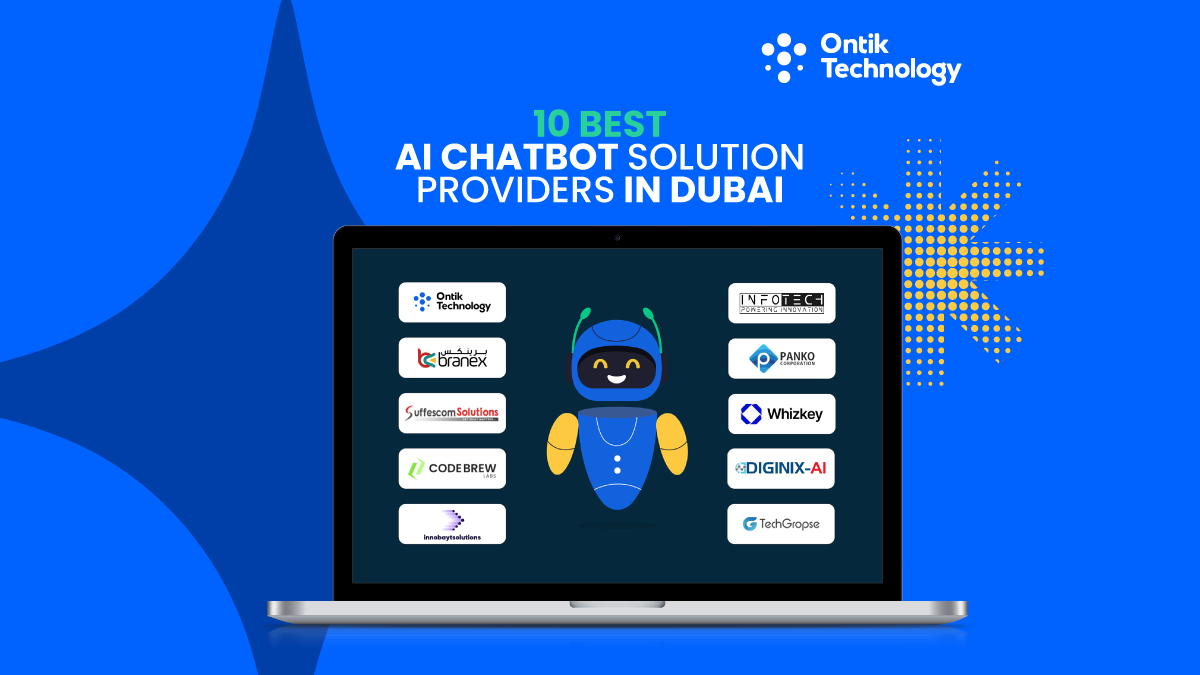
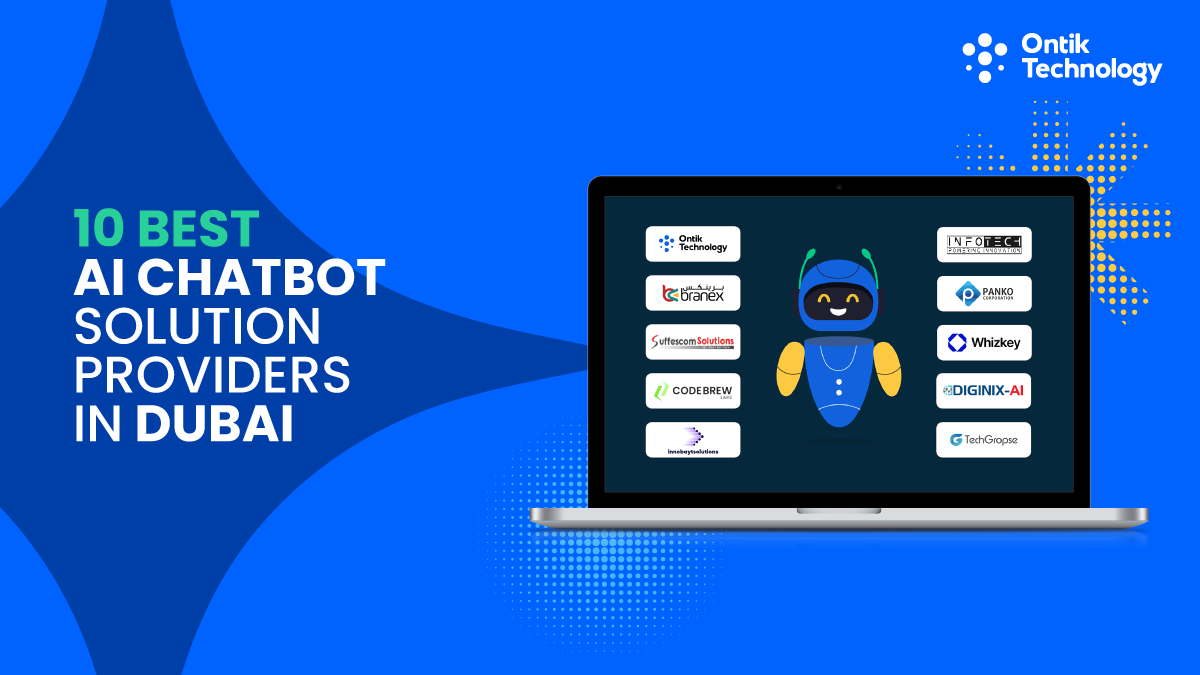
Dubai is among the most modern cities in the world. Technology and commerce are now advancing together. In Dubai today, the use of AI chatbot solutions is now becoming one of the major ways to implement some of these digital trends that will help to promote this growth. Walk into any bank, real estate firm, or online store, and chances are a chatbot will greet you first.
These bots are not just answering questions, they’re helping people book services, track deliveries, and get instant support without waiting in line. With the UAE government pushing for smart innovation and automation, demand for AI chatbot solutions in Dubai has grown over 70% in the last three years.
Today’s companies use chatbots to handle bookings, payments, and even product recommendations all in real time. In this guide, we explore the top 10 best AI chatbot solution providers in Dubai, highlighting the firms driving this digital revolution with advanced technology, real results, and local expertise.
Top 10 Best AI Chatbot Solution Providers in Dubai
With a focus on digital business in Dubai, AI chatbots solutions are becoming an increasingly important element of daily operations for many organizations in the region. These systems can be used in numerous areas such as customer service, sales, and to reduce the amount of time and errors that occur in each area. The top ten organizations listed below were chosen for their ability to deliver projects in a timely manner; provide long-term support; and have provided results in multiple industries
1. Ontik Technology
Website: ontiktechnology.com
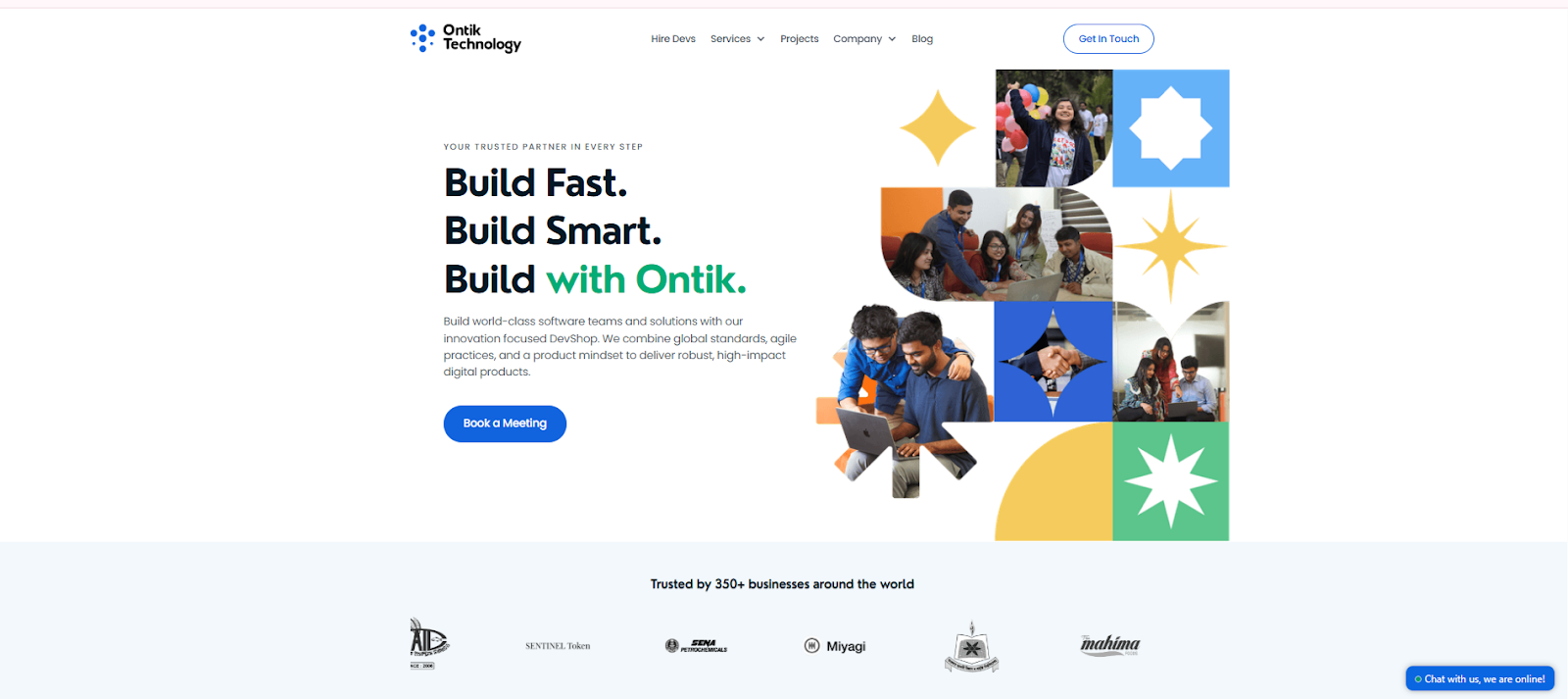
Core Expertise: AI chatbot development, AI and Machine learning service, business automation, and digital system design.
Ontik Technology began operations in 2016 and has stayed consistent since then. The firm works with Dubai businesses that want chatbots built for actual results, not just demos. Their developers focus on practical AI chatbot solutions that answer customer questions instantly and keep data flowing into CRM systems without manual entry. Most of their clients use these bots to support customer service teams or to handle high-volume eCommerce queries.
Strengths: Ontik builds for speed and function. Their chatbots run on natural language processing and adaptive AI models, designed to reduce waiting time and lift customer satisfaction scores. The systems are simple to maintain, which suits mid-sized companies that can’t afford long training cycles. Clients mention their honest timelines and steady technical support.
Industries Served: eCommerce, healthcare, logistics, and fintech.
Ratings & Reputation:
Performance – 4.8/5
Communication – 4.9/5
After-service – 4.7/5
In Dubai’s growing automation market, Ontik Technology stands out for reliable builds and clear project handling, one of the few AI chatbot development companies in UAE known more for delivery than presentation.
2. Branex
Website: branex.ae
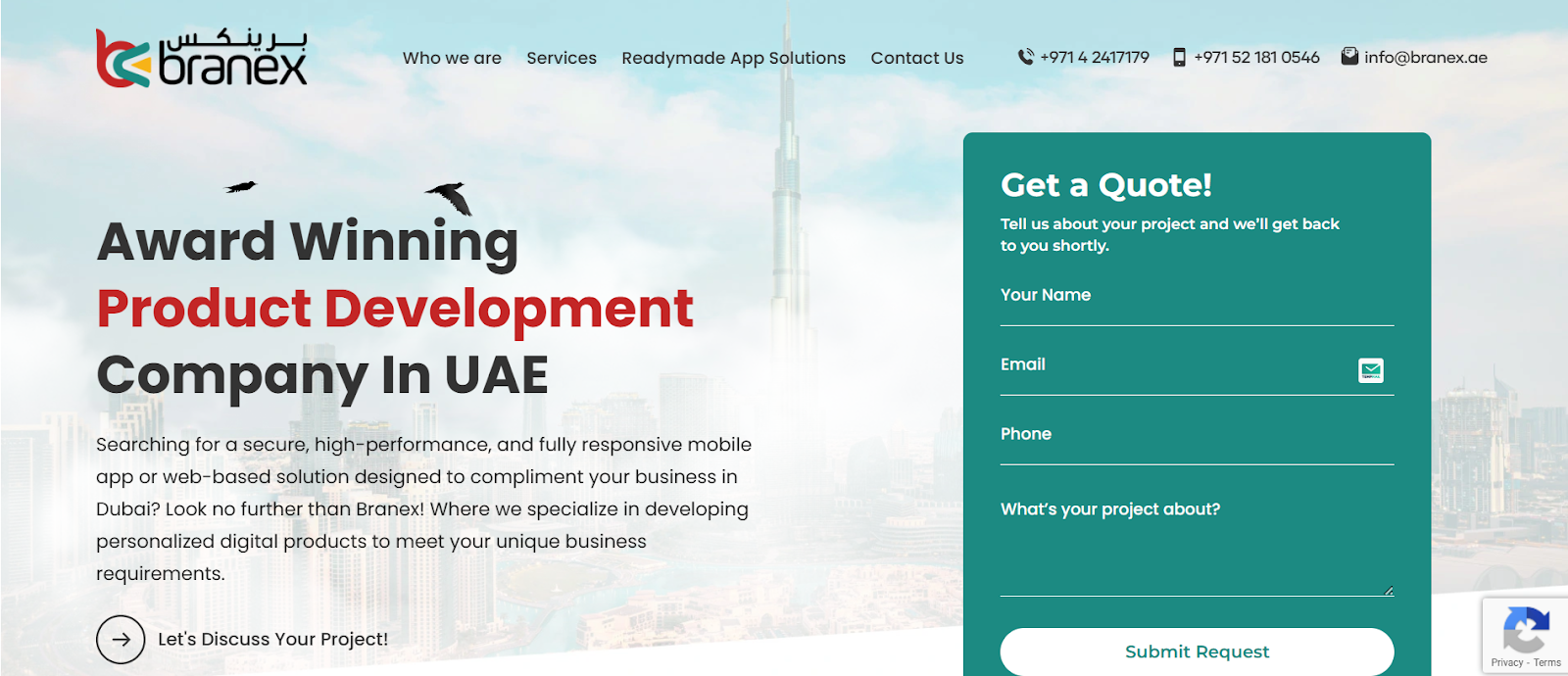
Core Expertise: Conversational AI, automation platforms, web and mobile app development.
Branex has been active in Dubai’s digital market for more than a decade. The company builds AI chatbot solutions that help local businesses manage customer requests without delay. Their systems respond quickly, record chat data, and guide users through simple automated steps. Most firms use Branex chatbots to answer sales queries or direct customers to live agents when needed.
Strengths: The team focuses on ease of use and clean integration. Their chatbots work across different platforms and can be trained to match a brand’s tone. Clients mention that Branex provides strong follow-up support and steady improvements after launch.
Main Working Sectors: Retail, education, real estate, and travel.
Ratings & Reputation:
Performance – 4.7/5
Communication – 4.8/5
After-service – 4.6/5
Branex continues to hold its spot among trusted AI chatbot development companies in Dubai, valued for practical builds and responsive customer service.
3. Suffescom Solutions
Website: suffescom.com
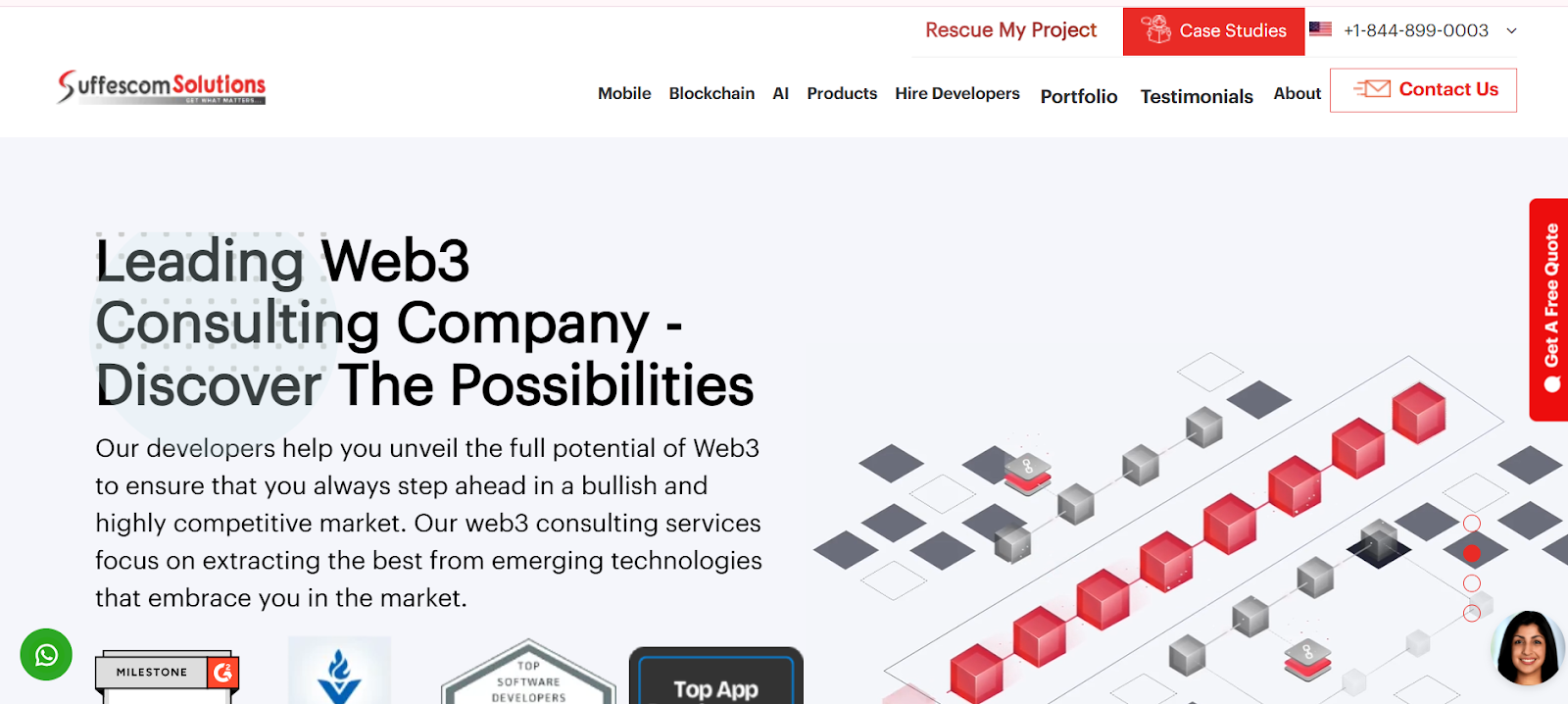
Core Expertise: ai chatbot development, automation systems, and enterprise software integration.
Suffescom Solutions has worked in Dubai’s automation market for years, helping companies bring smarter chat systems into daily operations. The firm develops AI chatbots that handle real-time customer support and service tasks with strong accuracy.
These bots use natural language processing and a layered ai model that improves from active customer interactions. The approach cuts manual effort and enhances the overall customer experience, especially for businesses managing large service networks.
Strengths: Suffescom builds bots that can manage hundreds of conversations at once and switch smoothly to a human agent when needed. The systems are checked for chatbot performance and refined regularly. Clients say the tools reduce workload and raise response quality.
Main Working Sectors: Telecom, retail, healthcare, and logistics.
Ratings & Reputation:
Performance – 4.6/5
Communication – 4.7/5
After-service – 4.6/5
Suffescom remains one of the leading AI chatbot solution provider in Dubai, UAE, offering consistent AI chatbot development solutions in Dubai UAE that automate complex customer service operations for large enterprises.
4. Code Brew Labs
Website: code-brew.com

Core Expertise: AI chatbot development, automation tools, mobile applications, and AI solutions.
Code Brew Labs has been in Dubai’s tech scene long enough to know what companies really need. Their AI chatbots don’t chase fancy extras. They just answer fast, link with CRMs, and keep data moving. Each chatbot runs on an AI model guided by natural language processing so it can follow tone and context. In practice, that means fewer confused customers and quicker replies during rush hours.
Strengths: Most clients point to reliability. The bots handle live customer support, not demo chats. They’re checked for chatbot performance and tuned after launch to fit each brand’s workflow. Teams report smoother automated customer support tasks and stronger customer engagement once the system settles in.
Main Working Sectors: Banking, travel, retail, and logistics.
Ratings & Reputation:
Performance – 4.7/5
Communication – 4.8/5
After-service – 4.6/5
Code Brew Labs remains one of the best chatbot app development companies in Dubai, Abu Dhabi, trusted for stable builds and steady AI-powered customer service that keeps operations running quietly but efficiently.
5. Innobayt Solutions
Website: innobaytsolutions.com

Core Expertise: ai chatbot development, chatbot software, mobile app systems, and conversational ai solutions.
Innobayt Solutions is a Dubai-based company that builds AI chatbots for small and mid-sized firms that want automation without heavy cost. Their products are simple, practical, and designed for real users. Each Ai chatbot runs on natural language processing and AI technology that keeps replies accurate and conversational. The systems also support virtual assistant features, helping businesses automate customer support while maintaining quick, personal responses.
Strengths: Innobayt’s tools are light and dependable. Clients mention faster service handling and higher customer satisfaction rates since deploying these bots. Each chatbot platform is tested for chatbot performance before launch, ensuring smooth live chat sessions and stable ai-powered chatbot results across different channels.
Main Working Sectors: Real estate, healthcare, retail, and education.
Ratings & Reputation:
Performance – 4.7/5
Communication – 4.8/5
After-service – 4.7/5
Innobayt continues to be listed among chatbot companies in the UAE, valued for its clear design, quick setup, and reliable ai chatbot development services that improve customer experience and automate customer support effectively.
6. Infotech UAE
Website: infotechuae.com

Core Expertise: AI chatbot development, AI solutions, automation software, and data systems.
Infotech UAE has worked in Dubai’s tech field for years, helping local companies move toward smarter customer systems. The team builds AI chatbots that handle everyday support and make service replies faster. Each chatbot uses an AI model that improves with live use. The system applies natural language processing to understand customer inquiries and store useful data for future chats.
Strengths: Infotech focuses on consistency over flash. Their AI chatbots for customer service are tested for chatbot performance before going live. Clients mention fewer missed requests and smoother customer engagement since adopting these tools. The bots also automate customer support tasks, keeping customer service operations steady even during busy hours.
Main Working Sectors: Banking, healthcare, logistics, and eCommerce.
Ratings & Reputation:
Performance – 4.7/5
Communication – 4.8/5
After-service – 4.7/5
Infotech UAE is one of the leading AI chatbot development firms in UAE, known for dependable AI chatbot development services built on advanced AI technology and practical post-launch support.
7. Pankoe RP
Website: pankoerp.com

Core Expertise: AI chatbot development, business automation, ERP systems, and AI solutions.
Pankoe RP has built its place in Dubai’s digital space by focusing on automation that makes everyday work easier. The Company creates AI Chatbots for Real Time Customer Support & to Eliminate Manual Processing. Every Chatbot is run through a Natural Language Processing (NLP) Model & an Artificial Intelligence (AI) Model to quickly & reliably provide responses. Their bots are used in multiple setups, from finance portals to logistics tracking systems, keeping customer experience smooth and data flow accurate.
Strengths: Pankoe RP builds systems that are practical and easy to maintain. Their chatbots record customer interactions automatically and handle repetitive queries before sending complex cases to a human agent. This setup helps automate customer support while improving chatbot performance over time. Clients note visible gains in response time and overall customer satisfaction.
Main Working Sectors: Finance, logistics, manufacturing, and eCommerce.
Ratings & Reputation:
Performance – 4.6/5
Communication – 4.8/5
After-service – 4.6/5
Pankoe RP is among the AI chatbot development company in Dubai, UAE trusted for reliable automation, balanced design, and strong technical follow-up support.
8. Whizkey
Website: whizkey.com
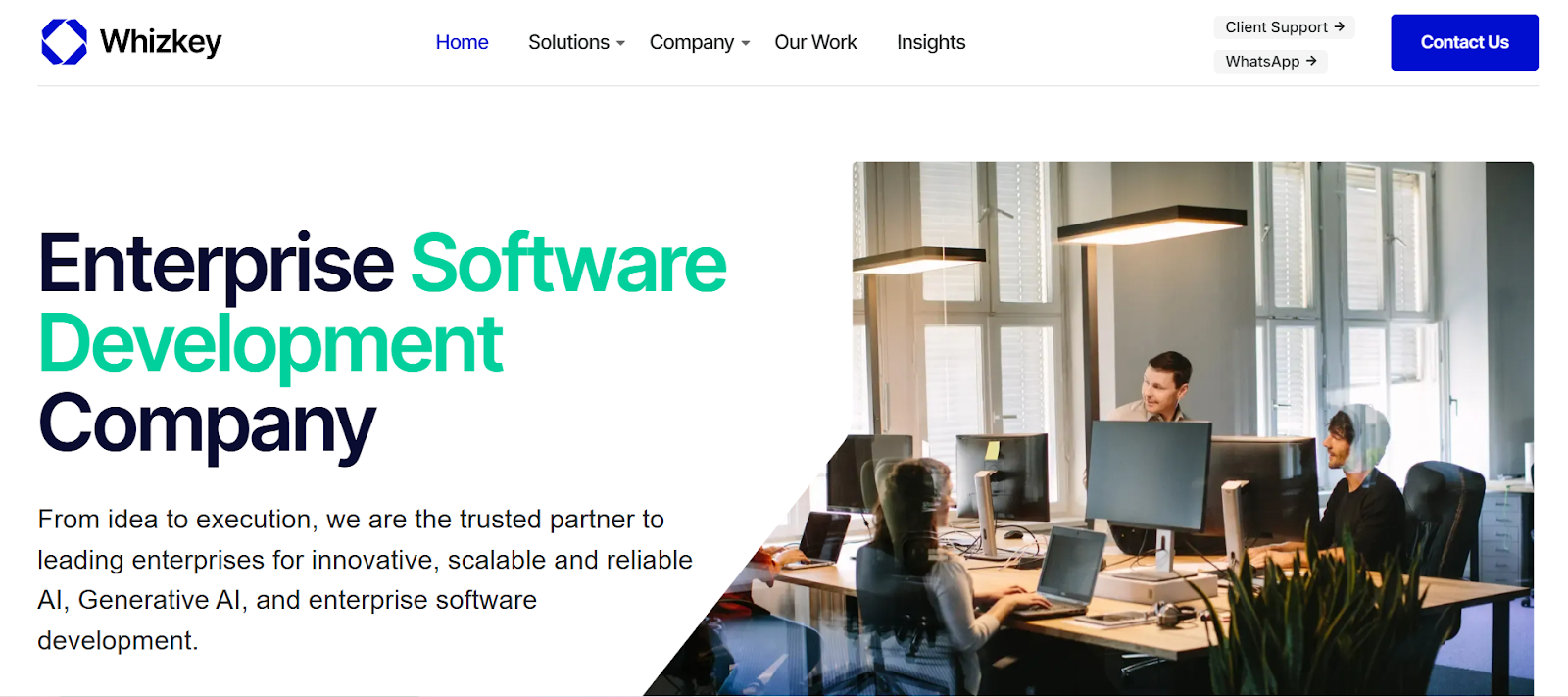
Core Expertise: AI chatbot development, custom AI tools, and automation for online platforms.
Whizkey works quietly but effectively in Dubai’s growing automation space. The firm builds AI chatbots that handle daily customer support, track orders, and guide users through live chat. Each chatbot relies on an AI model and natural language processing to keep replies quick and accurate. The systems help improve customer experience by reducing wait times and handling common questions before a human agent steps in.
Strengths: Whizkey’s chatbots are stable and easy to manage. They record customer interactions automatically and update responses through continuous learning. Clients mention better customer engagement and faster resolutions since adopting these systems. The tools also automate customer support, helping teams maintain strong customer service operations across channels.
Main Working Sectors: Retail, eCommerce, telecom, and education.
Ratings & Reputation:
Performance – 4.8/5
Communication – 4.7/5
After-service – 4.7/5
Whizkey stands as an AI custom chatbot development company in Dubai, recognized for reliable chatbot builds, real-world usability, and responsive customer service chatbots that keep communication simple and direct.
9. Diginix AI
Website: diginixai.com

Core Expertise: AI chatbot development, advanced AI systems, and automation for business support.
Diginix AI has built a strong name in Dubai’s automation scene. The company develops AI chatbot solutions that manage customer support, collect chat data, and reply in several languages. Each AI chatbot is based on an AI model trained with natural language processing to get better after every customer interaction. You’ll find their chatbots across finance, travel, and telecom firms where quick and accurate responses are essential.
Strengths: The systems are practical and scale smoothly. Diginix AI checks every chatbot for chatbot performance and accuracy before deployment. Clients report stronger customer engagement and improved customer experience since integration. The bots also support human agents by helping automate customer support, allowing teams to focus on priority requests.
Main Working Sectors: Retail, fintech, telecom, and logistics.
Ratings & Reputation:
Performance – 4.7/5
Communication – 4.8/5
After-service – 4.6/5
Diginix AI stands among the Generative AI company UAE and continues to grow as one of the leading AI chatbot development firms in UAE, offering Generative AI services UAE and advanced AI technology that support long-term automation and reliable digital communication.
10. TechGropse
Website: techgropse.com
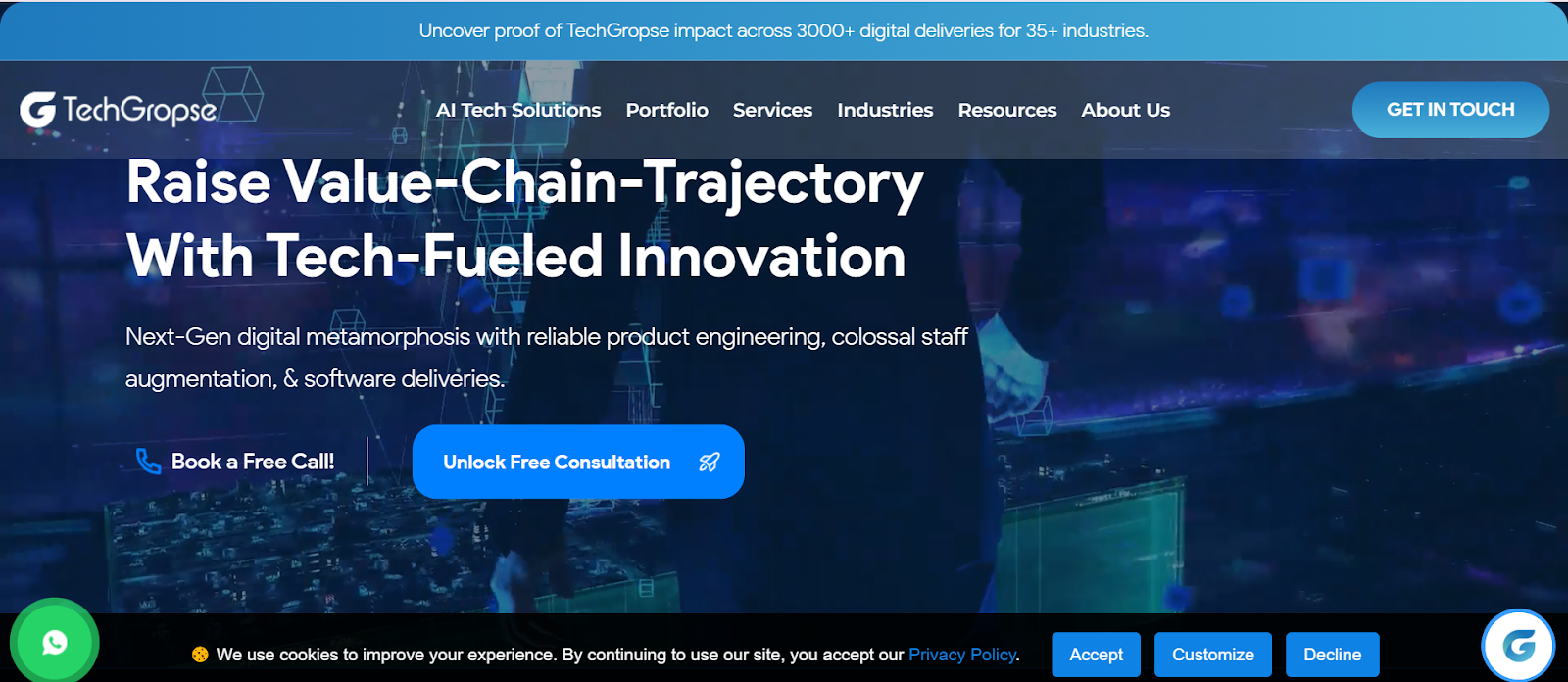
Core Expertise: AI chatbot development, AI-powered automation, and mobile app engineering.
TechGropse is a familiar name in Dubai’s technology scene. The company builds AI chatbots that make customer support faster and reduce manual work. Every chatbot uses an AI model supported by natural language processing to respond instantly and keep chat accuracy consistent. Their bots manage customer interactions across mobile apps, websites, and live chat systems, helping businesses improve customer experience without extra staff.
Strengths: TechGropse develops practical automation for enterprises and startups. Their chatbots are tested for chatbot performance, giving smooth handovers from AI agent to human agent when needed. The systems also automate customer support while improving customer satisfaction and customer engagement. Clients note clear reporting tools that show usage data and help teams retrain bots easily.
Main Working Sectors: eCommerce, travel, real estate, and education.
Ratings & Reputation:
Performance – 4.8/5
Communication – 4.8/5
After-service – 4.7/5
TechGropse remains one of the best chatbot service Dubai and a leading AI chatbot development company in Dubai, UAE, offering dependable AI chatbot development services and best AI chatbot solutions for both growing and established businesses.
Why Intelligent Chatbots Are Changing the Way Dubai Does Business
Dubai’s service industry runs on quick decisions and constant client contact. That pressure has turned AI chatbots for customer service from a nice-to-have into standard infrastructure. Banks, hospitals, and retail groups use them to deal with the daily flood of messages that once needed entire support teams.
1. Precision in Real Time
Modern conversational AI tools don’t wait for business hours. They scan intent, language, and tone instantly through natural language processing, then route complex issues to a human agent before delays stack up. It’s the kind of precision that matters in a city built around instant response.
2. Shifting the Human Role
Automation now handles routine customer interactions, leaving people to manage exceptions, the questions that need empathy or judgment. Companies report faster resolution and more focused staff.
3. Data That Sharpens Service
Every exchange becomes data. Managers review patterns, sentiment, and recurring pain points to improve customer experience and product design.
4. Multilingual and Local Fit
In Dubai’s bilingual market, most systems now operate in both Arabic and English. That flexibility builds trust and shortens support time for diverse audiences.
5. Cost Efficiency with Scale
Automation lowers ticket volumes and handling time. Many local firms report 30–40% savings in customer care budgets within the first year.
Key Features of Leading AI Chatbot Solutions
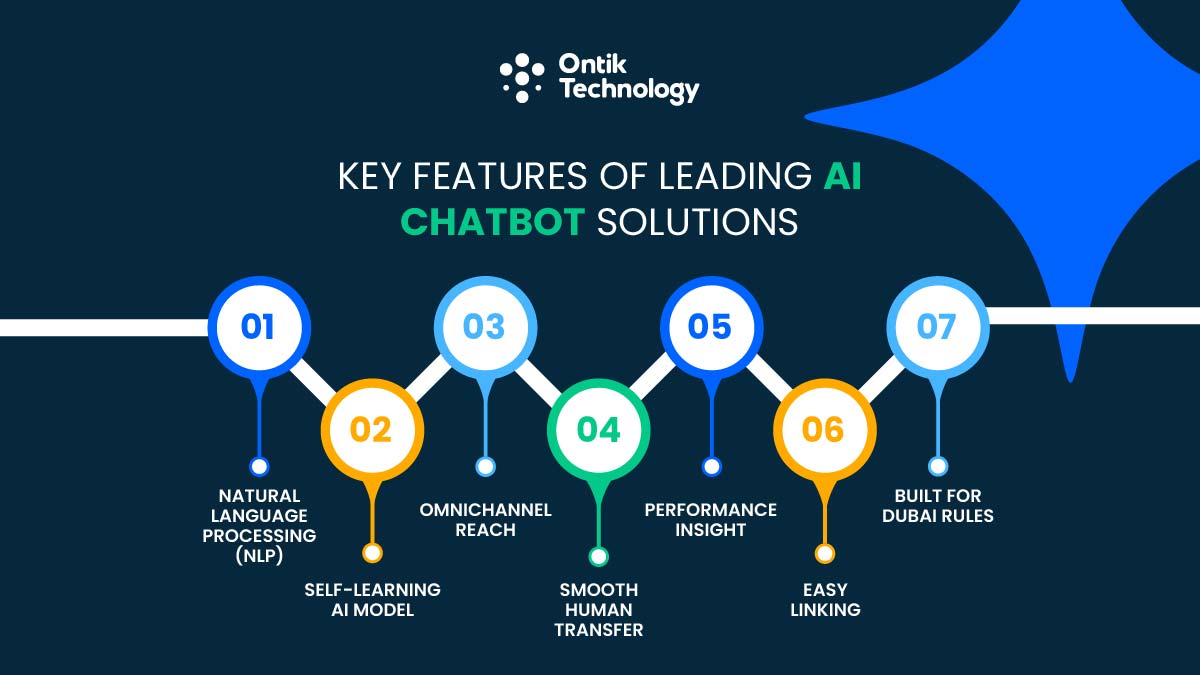
When you look at how Dubai firms pick chat platforms, it’s rarely about design. It’s about what the system does when the phones are busy, and no one’s free to answer. Here’s what separates solid builds from the rest:
- Natural Language Processing (NLP) – The part that lets a chatbot actually read the way people write. It catches tone, intent, even slang. Without it, replies feel mechanical.
- Self-learning AI Model – Every chat becomes a small lesson. The system keeps improving with use. After a few weeks, it starts handling questions that once needed people.
- Omnichannel Reach – One chatbot covers live chat, WhatsApp, and mobile apps together. Customers don’t notice the switch, and that’s the point.
- Smooth Human Transfer – When the bot hits a wall, it hands the thread to a human agent. The customer doesn’t have to repeat a thing.
- Performance Insight – Simple dashboards show chatbot performance and response time. You’ll see what customers ask most and where the lag happens.
- Easy Linking – Good platforms tie into CRMs or billing systems. They pull data in seconds instead of minutes.
- Built for Dubai Rules – Vendors like the leading AI chatbot development firms in UAE build around local data laws and privacy checks.
How to Choose the Right AI Chatbot Development Company in Dubai
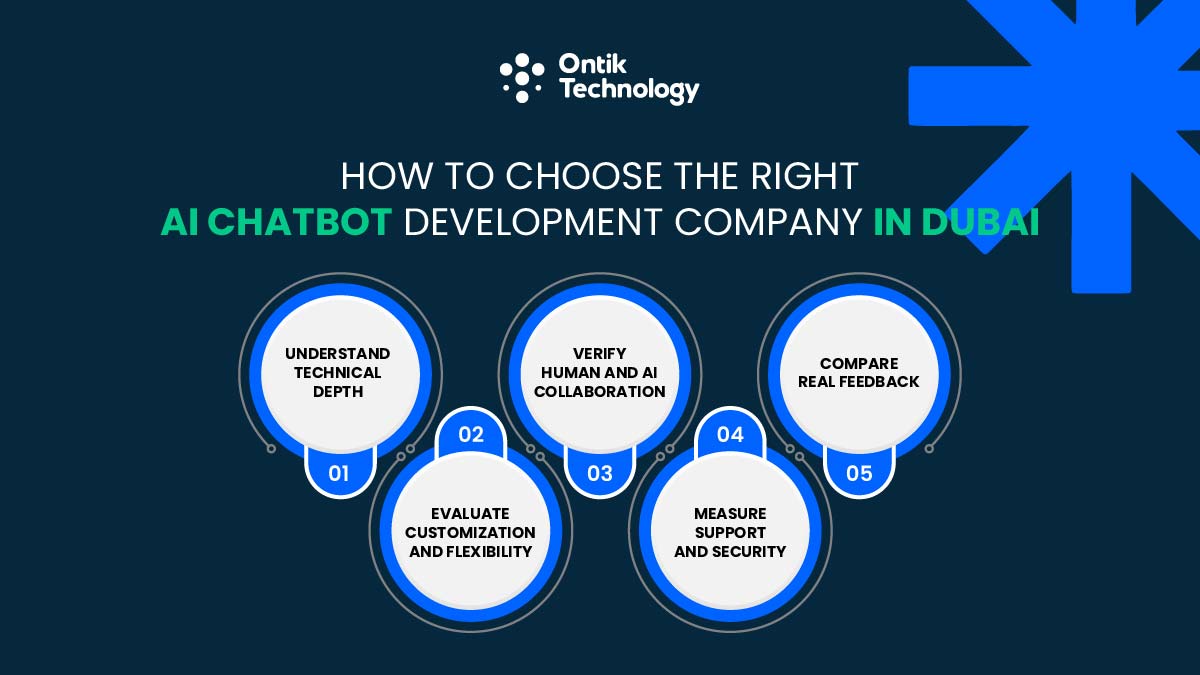
Choosing the right partner for AI chatbot solutions in Dubai isn’t about who has the biggest portfolio. It’s about who understands local business pressure, speed, multilingual service, and strict data rules. The right team helps you move faster without risking quality or compliance.
- Understand Technical Depth
A capable firm doesn’t just install chatbots; it builds scalable systems. Look for solid experience in chatbot development and back-end integration. Companies like the AI chatbot development company in Dubai, UAE with proven case studies across finance and logistics usually deliver cleaner builds and fewer post-launch issues.
- Evaluate Customization and Flexibility
Each business runs differently. A good provider adjusts tone, workflow, and platform design. Check if they can align with your CRM and internal apps to maintain real-time customer engagement.
- Verify Human and AI Collaboration
Even the best system needs balance. The chatbot should know when to hand control to a human agent or AI agent for advanced support. This handover keeps service smooth without frustrating users.
- Measure Support and Security
Reliable vendors stay involved after launch. They monitor chatbot performance, push updates when patterns change, and keep communication open. A leading AI chatbot solution provider in Dubai, UAE will also meet Dubai’s data-protection rules, offering quick response if problems appear instead of passing you between departments.
- Compare Real Feedback
Talk to existing clients. Performance metrics, not promises, reveal how well the vendor handles live environments.
The Future of AI Chatbot Solutions in Dubai and UAE
Automation in Dubai has moved fast. What started as small pilots is now part of daily business. You’ll find AI chatbots in banks, hospitals, and shipping firms quietly handling thousands of messages every day. The next few years will only push that further.
- Arabic and English Together – Local firms are demanding bilingual bots. Most AI development companies in Dubai, UAE now build language models tuned for both markets.
- Generative AI Takes the Stage – Tools powered by Generative AI services UAE will write smoother replies, learn tone from real chats, and adjust instantly when rules change.
- Deeper System Links – Chatbots are starting to work directly inside CRMs and ERPs, creating records or orders without staff input.
- Human and Machine Side by Side – Teams will mix automation with real support staff. The aim isn’t to replace people but to build faster, more personal AI-powered customer service.
- Wider Sector Adoption – Finance, logistics, and health groups already rely on artificial intelligence chatbots Dubai UAE for compliance checks, bookings, and updates.
Why Ontik Technology Stands Out
Ontik Technology isn’t loud about what it does, but people in the Dubai tech circle know the name. Since 2016, it has earned that reputation slowly, through steady work and honest results. Here’s what really keeps clients coming back:
1. A Clean Track Record
Projects get finished. Deadlines are met. You don’t hear stories about half-done builds or missed handovers. That alone makes Ontik different in a market that moves fast.
2. Real Transparency
Clients see every stage from scope to launch. Ontik keeps updates simple and honest, so teams always know what’s working and what needs fixing.
3. Ratings That Match Reality
Performance ratings hover near 4.8 out of 5. Communication scores are even higher. Those numbers aren’t marketing; they’re pulled straight from verified client feedback.
4. Support That Doesn’t End
Known as a trusted AI partner in UAE, Ontik checks in long after delivery. They monitor uptime, fine-tune chatbots, and roll updates quietly before issues turn into problems.
5. Practical Over Hype
No flashy promises. Just solid tools built to save time and improve efficiency. What clients notice most is consistency; projects that run, scale, and keep running.
Conclusion
Over the past few years, automation in Dubai has quietly shifted from experiments to infrastructure. Most firms now treat AI chatbot solutions as essential systems, not optional tools. The firms featured here have proven that performance depends on design depth, stable APIs, clean data pipelines, and chat models trained on region-specific intent libraries.
Their systems deliver measurable uptime, low-latency replies, and SLA-compliant accuracy that traditional support desks can’t match. Each vendor blends conversational engineering with backend integration, ensuring every interaction feeds real metrics into CRM and analytics stacks.
The standout quality across these providers isn’t marketing polish; it’s engineering discipline. They build frameworks that scale, learn, and sustain under pressure. For organizations seeking enterprise-grade reliability and intelligent automation, this list marks the most credible path to finding the best chatbot developers working in Dubai today.


Finding the right partner for your digital transformation can feel overwhelming. Perth's tech scene has grown rapidly over the past decade. You now have access to world-class software companies in Perth Australia that deliver everything from mobile apps to enterprise solutions.
Perth has become a thriving hub for technology and innovation, with businesses in Perth and Australia benefiting from local expertise. The city now hosts numerous software development agencies that serve local businesses plus international clients. These development companies range from boutique agencies to large-scale enterprise solution providers.
What sets Perth apart is its unique blend of global expertise and local understanding. Top software development companies in Perth work across multiple time zones. They deliver quality solutions at competitive rates compared to other major cities.
Moreover, to get a deeper understanding of effective collaboration models, check out staff augmentation best practices, which explores proven methods for managing remote development teams efficiently.
This guide breaks down the top 15 software companies in Perth Australia. You will discover what makes each one unique. Plus, you will learn how to choose the perfect fit for your development project needs.
What Services Do Perth Software Companies Offer
Perth's software landscape offers comprehensive development services for every business need. You can find specialists in mobile app development, web applications, and cloud-based solutions. Many firms now provide AI and machine learning software development as part of their core offerings.
Perth's custom software developers build tailored, non-shelf solutions that perfectly match your business processes, ensuring seamless integration with existing systems.
Enterprise software firms manage large, complex projects, utilizing established frameworks, maintaining security compliance, and offering continuous maintenance and support post-launch.
Several development agencies specialize in industry-specific solutions. Fintech software development Perth firms understand regulatory requirements and blockchain technology. Healthtech software developers know HIPAA and patient privacy laws. eCommerce software solutions providers optimize for conversion and user experience.
Many of these companies have expanded their services beyond traditional development. They now offer:
- Cloud migration and infrastructure setup
- Software integration and automation
- SaaS product development Australia solutions
- CRM and ERP management software
- Mobile-first progressive web applications
- DevOps and continuous integration pipelines
Agile development, which uses sprints, has changed project delivery. This iterative approach allows for regular updates and priority adjustments based on market shifts, thus reducing risk and improving results.
Now let's explore the leading software developers who are shaping Perth's digital future.
Top 15 Software Companies in Perth Australia
Perth's software development scene offers diverse options for companies of all sizes. These development companies bring years of combined experience. They have delivered successful projects across multiple industries. Each one has carved out its own specialty in the competitive tech landscape.
Here is a quick comparison to help you understand what each company in Perth brings to the table:
Let's dive deeper into what makes each of these software development companies worth considering.
1. Ontik Technology
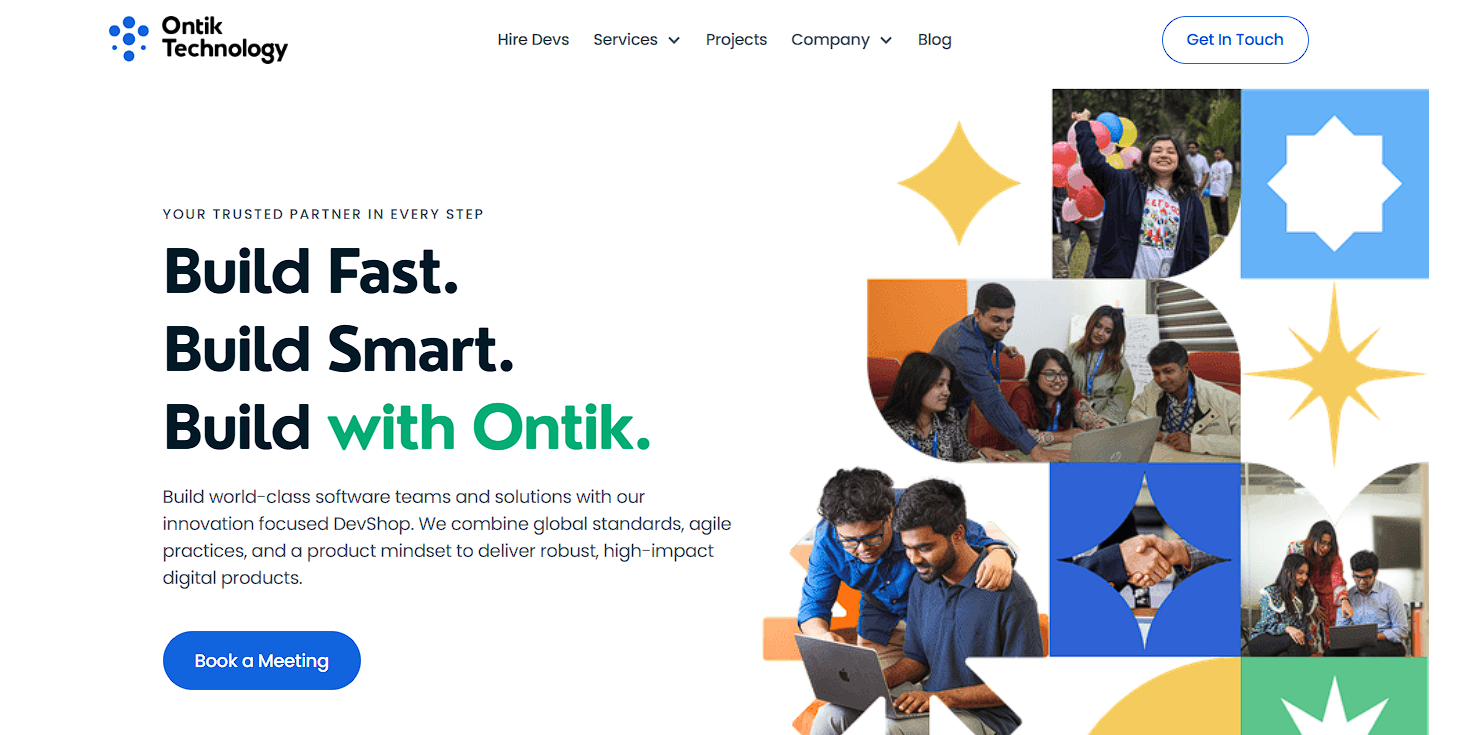
Ontik Technology has built a reputation as one of the top software companies in Perth since 2016. The company focuses on helping startups and growing businesses turn ideas into market-ready software products through MVP development services.
We operate globally while maintaining strong roots in Perth's tech community. Our development team handles everything from initial concept validation to full-scale product launches. Ontik's approach centers on rapid development without compromising quality.
What They Provide
- Custom software development tailored to business requirements
- MVP development for startups testing market fit
- Mobile application development for iOS and Android
- Web development using modern frameworks
- Team augmentation services for scaling development capacity
- Product strategy and software consulting
- UI/UX design and development
- Quality assurance and development and testing
Their Unique Position
Ontik bridges the gap between local expertise and global delivery standards. We understand Perth businesses while bringing international best practices. The company excels at software development for startups who need to move fast and validate ideas quickly with proven staff augmentation best practices.
2. Codiant
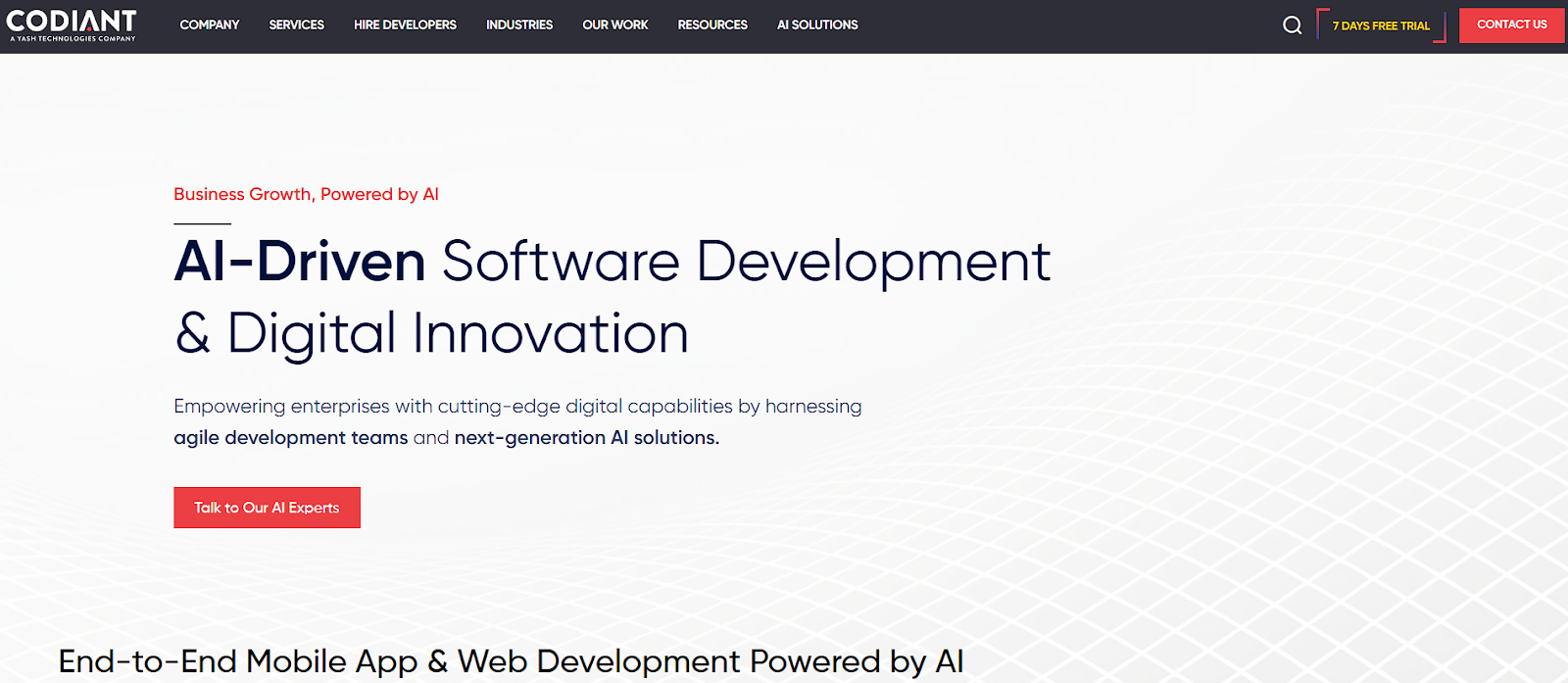
Codiant brings nearly two decades of software development experience to the Australian market. Founded in 2006, they have expanded across multiple continents with offices in the USA, UK, UAE, India, and Australia. Their Perth presence gives local businesses access to a massive talent pool. The company has delivered over 1,500 projects for companies around the world. They combine AI-driven development approaches with traditional software engineering excellence.
What They Provide
- Mobile app development for enterprise clients
- Web application development with scalable software architecture
- AI and machine learning integration
- Blockchain development solutions
- Internet of Things (IoT) applications
- Cloud-native application development
- Quality assurance and automated testing
- Dedicated development team services
Their Unique Position
Codiant stands out for their AI-first approach to problem-solving. They leverage machine learning to optimize development processes and end-user experiences. Their global reach means they can handle projects of any scale while maintaining competitive pricing structures.
3. ISH Technologies

ISH Technologies operates primarily from Brisbane and Gold Coast but serves Perth clients with dedication. The company has accumulated over 12 years of experience in custom software development. They take a consultative approach to every project. Their team works closely with clients to understand business objectives before writing any code. ISH focuses on building long-term partnerships rather than one-off projects.
What They Provide
- Custom software development for unique business needs
- Mobile app development for consumer and business applications
- Web development with responsive design
- Digital strategy and software development consulting
- E-commerce platform development
- API development and third-party integrations
- Ongoing maintenance and support services
- Cloud infrastructure setup and management
Their Unique Position
ISH Technologies excels at translating complex business requirements into intuitive software solutions. They bring east coast expertise to Perth projects. Their track record shows consistent delivery of projects on time and within budget.
4. Tecmyer

Tecmyer combines digital marketing expertise with software development capabilities. This dual focus makes them unique among Perth's list of software development companies. The company launched in 2015 and quickly established itself as a go-to partner for businesses needing both technology and visibility. They understand that building great software is only half the battle. Marketing that software effectively completes the picture. Their integrated approach helps clients launch software products that people actually find and use.
What They Provide
- Mobile and web app development
- Search engine optimization (SEO) services
- Pay-per-click (PPC) advertising management
- Social media marketing campaigns
- Content marketing and strategy
- Brand development and digital identity
- E-commerce solutions with marketing integration
- Analytics and performance tracking
Their Unique Position
Tecmyer's combined expertise in software development agency services and digital marketing sets them apart. You get a team that thinks about user acquisition from day one. This makes them ideal for businesses launching new digital products into competitive markets.
5. One IT
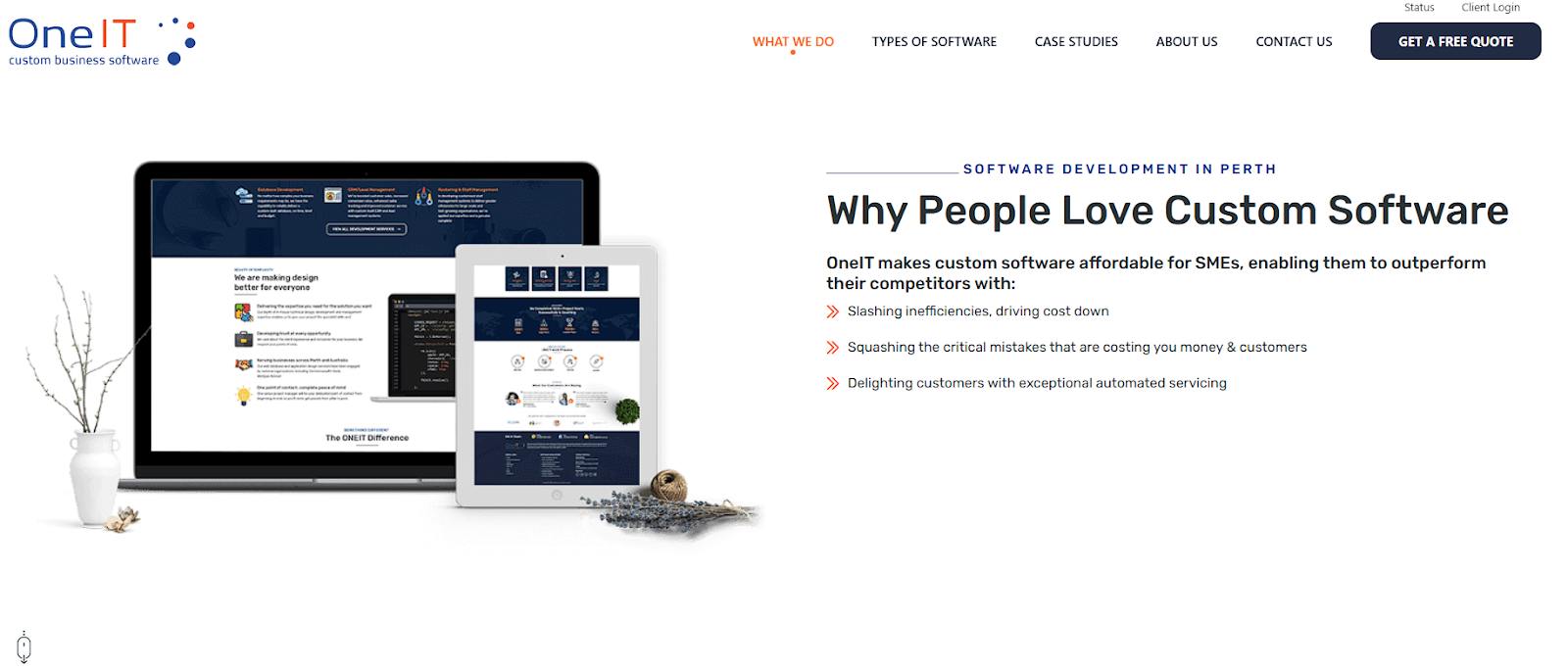
One IT has been serving Perth businesses for over two decades. The company started in 2000 and has grown alongside Perth's digital evolution. They have completed projects for more than 500 clients across various industries. One IT takes a business-first approach to technology solutions. They focus on understanding how software aligns with your bottom line. Their longevity in the market speaks to consistent quality and reliable service delivery.
What They Provide
- Custom business software development
- Database design and optimization
- Business process automation
- Integration with existing systems
- Legacy system modernization
- Web application development
- Mobile solutions for business operations
- Technical support and maintenance
Their Unique Position
One IT brings unmatched local knowledge and stability to Perth projects. Their 20-plus years of operation means they have seen technology trends come and go. They recommend solutions that will stand the test of time rather than chasing every new trend.
6. Hatchet
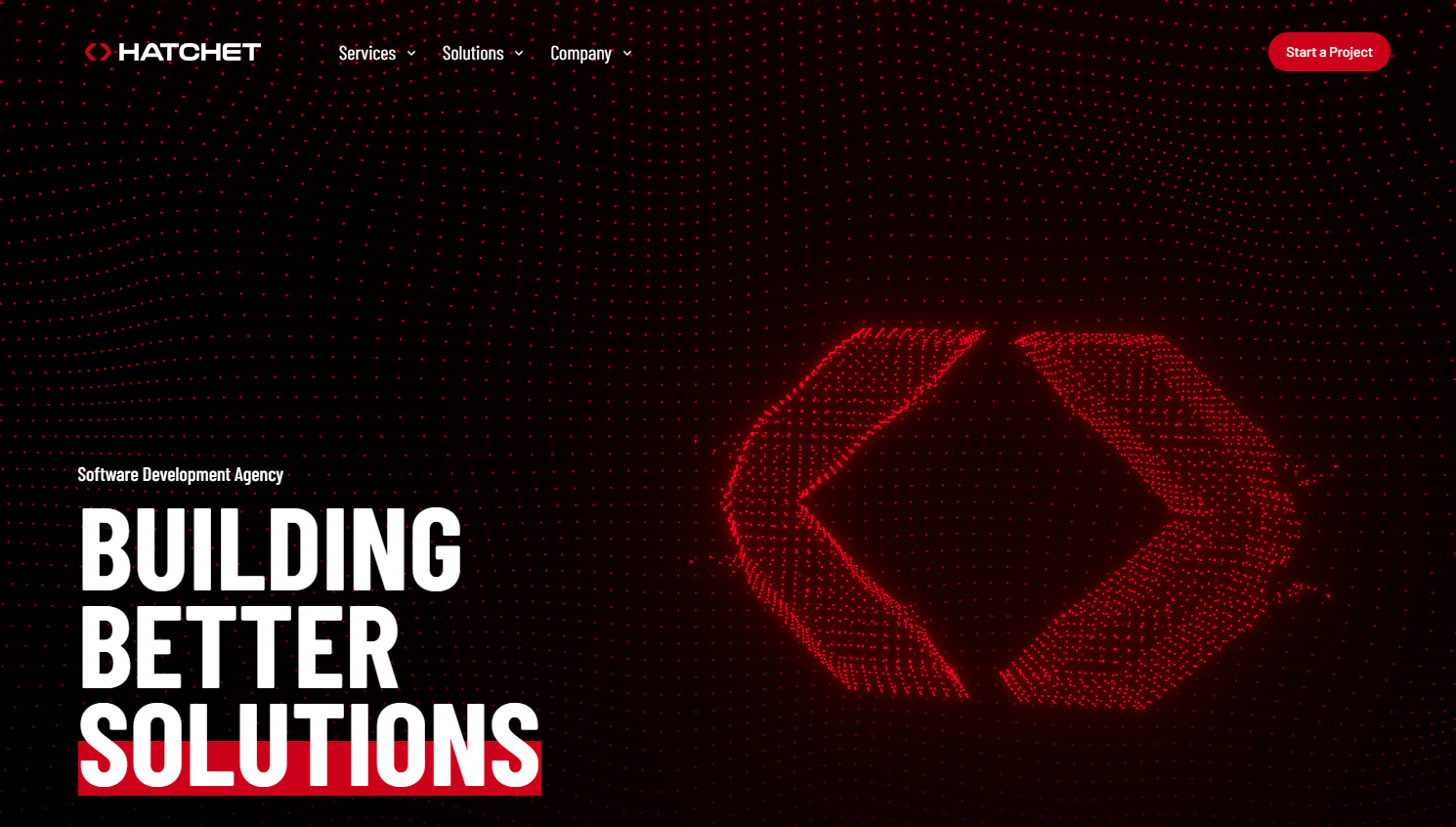
Hatchet launched in 2015 with a focus on modern web application development. The Perth-based software development team specializes in Laravel, one of the most popular PHP frameworks. They have built a reputation for clean code and scalable architecture. Hatchet works primarily with Australian businesses but their solutions have global reach. The company values transparency and clear communication throughout the software development process. They pride themselves on building software that other developers enjoy working with.
What They Provide
- Custom web application development
- Laravel framework specialization
- API development and integration
- Database architecture and design
- Front-end development with modern JavaScript frameworks
- Progressive web applications
- Technical consulting and code audits
- Ongoing development support
Their Unique Position
Hatchet's deep expertise in Laravel makes them the best software firms in Perth for PHP-based projects. They have contributed to open-source projects and stay current with best practices. This technical excellence translates into faster development times and more maintainable code.
7. Lateral
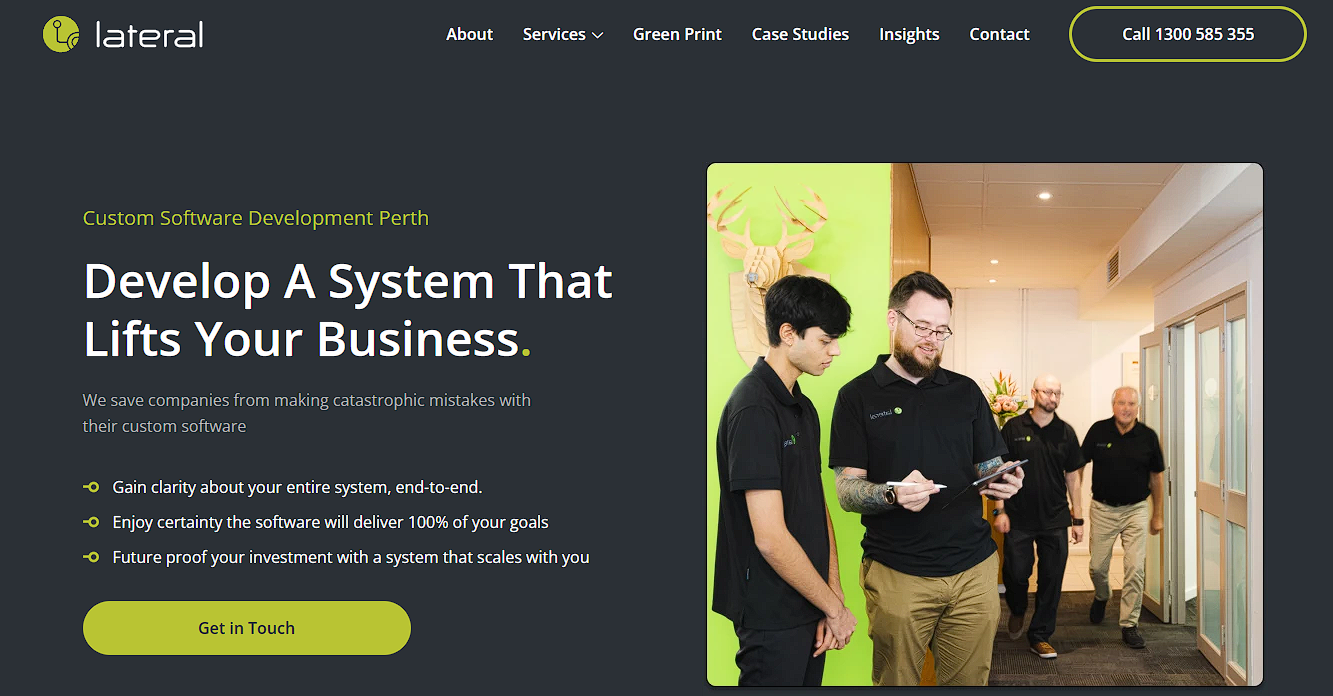
Lateral stands as one of Perth's most established technology companies. They have been operating since 1986, giving them nearly four decades of experience. The company has evolved from traditional software development into cutting-edge artificial intelligence and machine learning solutions. They work primarily with large enterprises and government organizations. Lateral's team includes some of Perth's most experienced development experts. Their long history has given them deep insights into what works and what does not in enterprise software.
What They Provide
- Enterprise software development and architecture
- Machine learning and AI implementation
- Custom software solutions for complex business problems
- System integration across legacy and modern platforms
- Digital transformation consulting
- Cloud migration and optimization
- Business intelligence and data analytics
- Managed services and ongoing support
Their Unique Position
Lateral's decades of experience make them one of the leading software developers for mission-critical enterprise systems. They understand regulatory compliance and enterprise security requirements. Their stability and track record provide peace of mind for large-scale projects.
8. Dapth
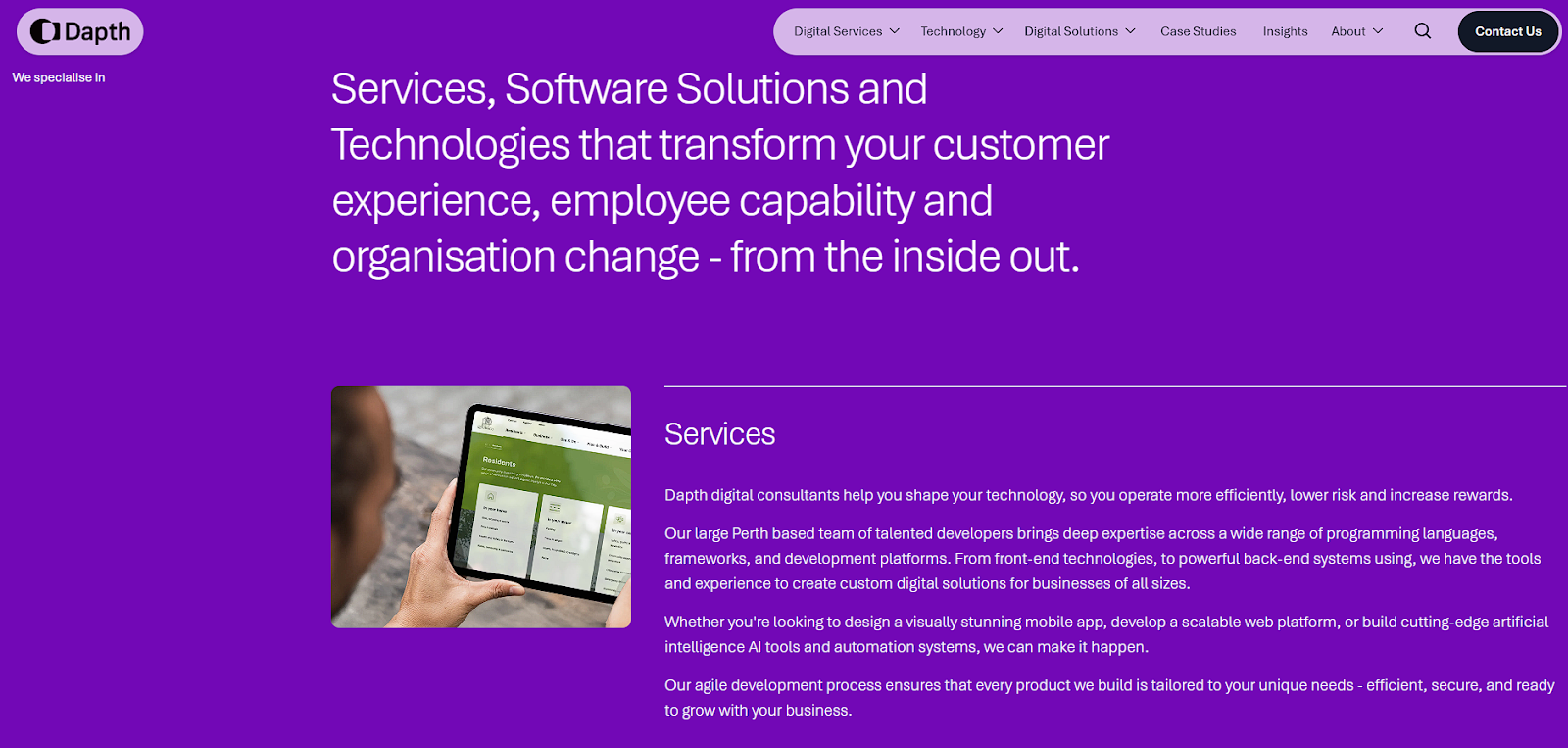
Dapth has been building custom software solutions since 2015 from their Perth CBD office. The company focuses on Microsoft Azure cloud technologies. They help businesses migrate from on-premise systems to cloud infrastructure. Dapth works with mid-size to large organizations across Australia. Their team combines software development skills with cloud architecture expertise. This dual capability makes them valuable partners for digital transformation projects.
What They Provide
- Custom software development on Azure platform
- Cloud migration planning and execution
- Azure infrastructure setup and optimization
- Web application development
- Mobile application development
- DevOps implementation
- Software integration services
- Cloud security and compliance
Their Unique Position
Dapth's specialization in Azure cloud platform makes them ideal for businesses already invested in Microsoft technologies. They understand how to build cloud-native applications that scale efficiently. Their Perth location means they provide local support for cloud software solution needs.
9. Quartex Software

Quartex Software emerged from the merger of INX Software and K2fly in 2022. The combined entity brings together over 25 years of industry experience. They employ approximately 250 people globally with strong presence in Perth. Quartex focuses specifically on workforce management software for high-risk industries. They serve mining, oil and gas, and other resource sectors. Their solutions help companies manage complex compliance requirements and operational challenges.
What They Provide
- Workforce management software
- Compliance and safety management systems
- Contractor management platforms
- Resource planning and scheduling
- Risk management software
- Training and competency tracking
- Mobile workforce applications
- Integration with enterprise resource planning systems
Their Unique Position
Quartex's deep specialization in resource sector software makes them the go-to choice for Perth's dominant mining industry. They understand the unique challenges of managing workforces in remote locations. Their software addresses real operational problems that generic solutions cannot handle.
10. Intuji
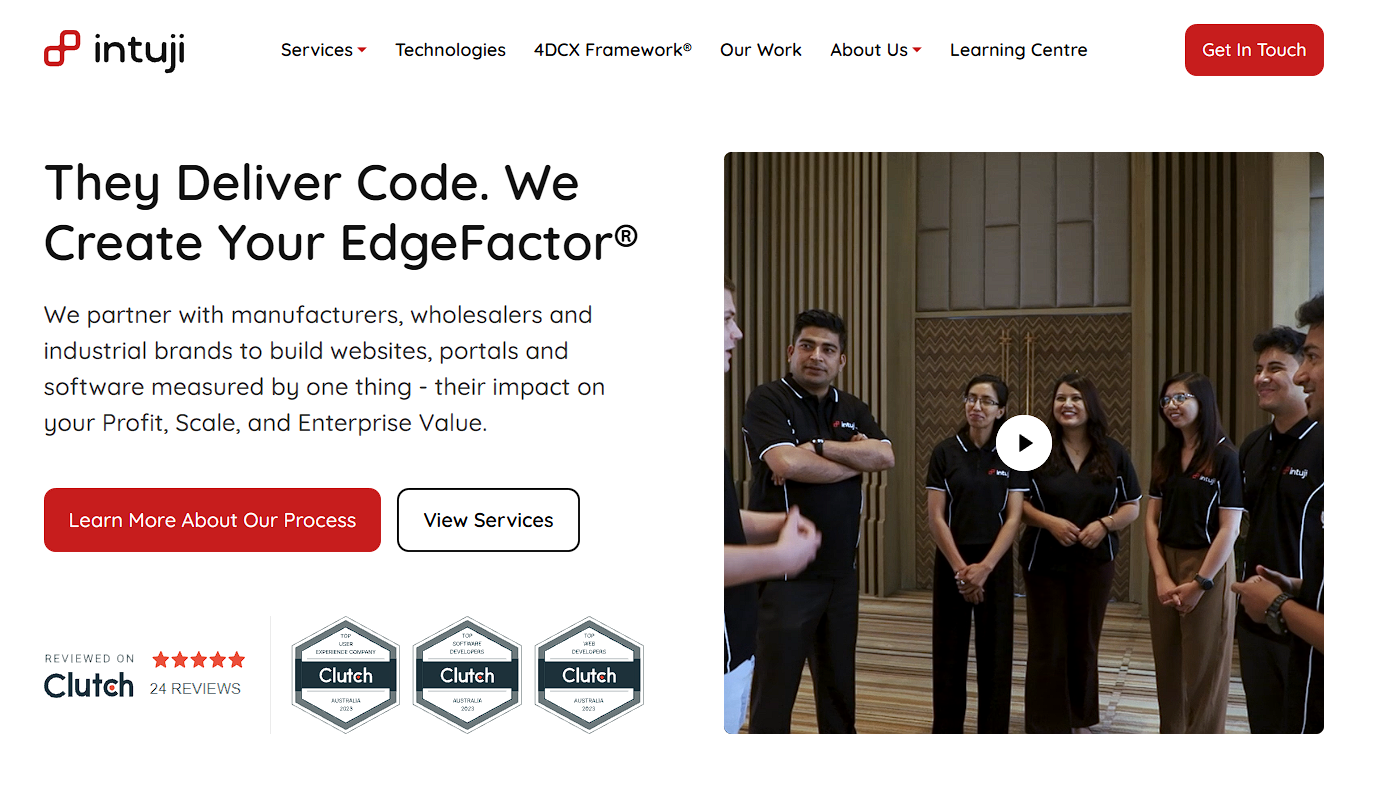
Intuji established itself in 2015 as a customer experience consulting and software development company. They employ between 50 and 99 professionals in Perth. The company holds ISO certifications that demonstrate commitment to quality processes. Intuji works with businesses that want to improve how customers interact with their digital products. They combine strategic consulting with technical implementation. Their approach ensures that the software not only works well but also delights users.
What They Provide
- Customer experience strategy and software consultancy
- Custom software development focused on user experience
- Mobile application development
- Web application development
- User interface and user experience design
- Customer journey mapping
- Digital transformation projects
- Quality assurance and user testing
Their Unique Position
Intuji's focus on customer experience sets them apart from purely technical development shops. They ensure that every software decision serves the end user. This makes them valuable for local software companies in Perth that compete on customer satisfaction.
11. Nano Solutions
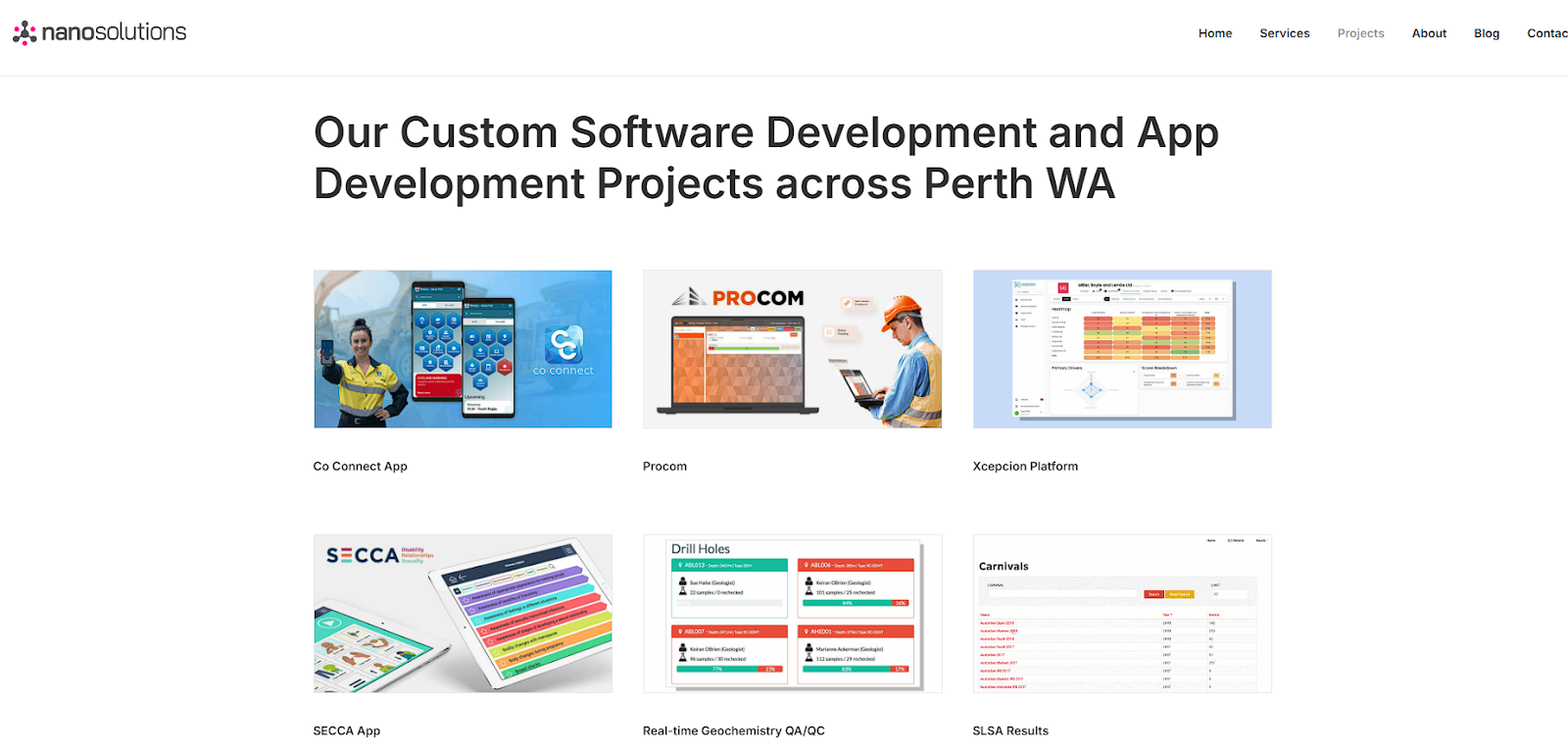
Nano Solutions operates from Perth and Fremantle, serving businesses across Western Australia. The company specializes in connecting disparate systems through elegant integration solutions. They have built expertise in making different hardware and software platforms work together seamlessly. Nano Solutions takes on complex technical challenges that many developers avoid. Their team includes specialists in various programming languages and platforms. This versatility allows them to work with almost any technology stack.
What They Provide
- Custom software development
- Systems integration and middleware
- API development and management
- Mobile application development
- Web application development
- Database design and optimization
- Legacy system connectivity
- Technical architecture consulting
Their Unique Position
Nano Solutions excels at solving integration puzzles that prevent businesses from operating efficiently. They can connect old systems with new software. Their ability to work across multiple platforms makes them valuable for businesses with complex technology landscapes.
12. Hello People

Hello People has been delivering digital solutions from Perth since 2008. The company has completed over 400 projects in its 16-plus years of operation. They employ between 50 and 249 people, making them one of the larger development agencies on this list. Hello People has evolved from basic web development into sophisticated AI and machine learning solutions. They serve clients across various industries including education, healthcare, and finance. Their portfolio demonstrates versatility and technical depth.
What They Provide
- Artificial intelligence and machine learning solutions
- Custom software development
- Mobile app development for iOS and Android
- Web application development
- Data analytics and business intelligence
- Cloud application development
- User experience design and development
- Digital strategy consulting
Their Unique Position
Hello People's early adoption of AI and machine learning technologies gives them an edge in data-driven projects. They can build intelligent systems that learn and improve over time. This makes them one of the best choices for businesses looking to leverage innovative software capabilities.
13. Sunrise Techs

Sunrise Techs has been operating for over a decade with a team of more than 50 app developers and designers. The company positions itself as an AI-first development agency in Perth. They serve clients across Australia from their Perth base. Sunrise Techs focuses on emerging technologies including blockchain, artificial intelligence, and advanced mobile solutions. Their team stays current with the latest development frameworks and tools. This forward-thinking approach attracts clients who want cutting-edge solutions.
What They Provide
- AI-powered software application development
- Mobile app development for iOS and Android
- Web application development with modern frameworks
- Blockchain solutions and smart contracts
- Internet of Things (IoT) applications
- Cross-platform mobile development
- Cloud-native application architecture
- Technical consulting and strategy
Their Unique Position
Sunrise Techs' commitment to AI-first development puts them at the forefront of modern software engineering. They integrate machine learning into projects from the start rather than as an afterthought. This approach makes them ideal partners for businesses wanting to differentiate through technology innovation.
14. Powered by Software

Powered by Software is a boutique consultancy run by Sahira, an experienced developer with over 20 years in the industry. This solo operation offers personalized attention that larger firms cannot match. The services company specializes in business system integrations, particularly with MYOB and SAP platforms. Powered by Software works primarily with small to medium businesses in Perth. The personal approach means every client works directly with an experienced professional. This eliminates communication layers and ensures consistent quality.
What They Provide
- MYOB integration and customization
- SAP system integration
- Business process automation
- Custom reporting solutions
- Database optimization
- Technical consulting for small businesses
- Software selection advisory
- Ongoing support and maintenance
Their Unique Position
Powered by Software's specialization in accounting software integration makes them invaluable for Perth businesses using MYOB or SAP. The solo consultant model means you get affordable software development Perth options without sacrificing expertise. This works perfectly for smaller projects that do not require large teams.
15. Ether Software

Ether Software focuses exclusively on helping SaaS founders bring their visions to life. The Perth-based software development company understands the unique challenges of building software as a service products. They work with entrepreneurs and established businesses launching new digital products. Ether Software emphasizes rapid MVP development to test market assumptions quickly. Their team has experience across multiple industries and technology stacks. This breadth allows them to recommend the best approach for each unique situation.
What They Provide
- SaaS product development Australia solutions
- MVP (Minimum Viable Product) development
- Business process automation
- Custom web application development
- API development and integration
- Cloud infrastructure setup
- Technical product strategy
- Growth-focused feature development
Their Unique Position
Ether Software, focused solely on SaaS, is ideal for subscription-based projects. They understand retention drivers and help tech startup founders launch AI MVPs faster by avoiding common mistakes.
These 15 diverse Perth software companies offer unique strengths. Choose based on your specific project needs, budget, and timeline.
How to Choose the Right Software Development Company in Perth
Selecting the right development partner can make or break your project. The decision requires careful evaluation across multiple criteria. Here's what matters most when choosing from top software developers in Perth.
Start With Clear Requirements
Write down your project scope before contacting any company. Include must-have features and nice-to-have additions. Define your budget range. Set realistic timelines. This clarity helps you communicate effectively with potential partners.
Evaluate Based on These Key Factors:
Due Diligence Actions:
Beyond website testimonials, find independent client reviews on platforms like Clutch or GoodFirms. Contact past clients to ask about their communication, problem-solving, and post-launch support.
Schedule discovery calls with your top three. Prepare specific questions on how they manage changes and challenges. Clarify code ownership and IP rights early.
Request detailed proposals from finalists. Compare scope and deliverables, not just pricing. Cheaper quotes often hide the software cost in change orders later.
Consider starting with a smaller pilot project to test the partnership before committing to full development. Understanding different engagement models like staff augmentation vs consulting or staff augmentation vs managed services can help you make the right choice for your needs.
Why Choose Ontik Technology for Software Development in Perth
Ontik Technology understands what Perth businesses need because we are part of this community. We have helped dozens of local companies plus international startups build high-quality software that drives real business results.
Our Approach Sets Us Apart
We specialize in moving fast without cutting corners. Our agile methodology means you see progress every week. You provide feedback continuously. We adjust course as needed. This flexibility prevents costly mistakes and ensures the final product matches your vision.
What Makes Us Different:
- Business-First Thinking: We start with your business goals, not just your feature list
- Challenge Assumptions: We respectfully question requirements to find better paths
- Consultative Partnership: You get honest advice that saves money and time
- Flexible Engagement: From single developers to full dedicated teams
Technical Excellence Across Platforms:
Team Augmentation Services
Need extra developers for three months? We can help. Want to build an entire dedicated development team? We handle that too. Our flexible engagement models adapt to your changing needs throughout the development lifecycle. Learn more about IT staff augmentation benefits and explore remote staff augmentation options.
Our software development process starts with understanding your business objectives. This consultative approach has helped clients launch faster and save significant budget. We excel at custom software development in Perth scenarios while maintaining the quality standards expected from trusted software development companies.
Perth Software Development Cost Guide

Understanding software development costs helps you budget realistically and avoid surprises. The software cost in Perth varies significantly based on company size, expertise, and project complexity.
Hourly Rate Breakdown:
Project-Based Pricing Examples:
- Simple mobile app: $20,000 - $50,000
- Complex custom software: $100,000 - $500,000
- Enterprise solutions: $500,000+
Factors That Influence Final Costs:
Project complexity matters most. More features mean more development time. Design and development requirements add to budgets. Integration needs require extra work. Platform choices affect pricing. Timeline urgency commands premium rates.
Perth vs Other Australian Cities:
Perth offers significant value compared to eastern capitals. Sydney developers charge $150-$250 per hour. Melbourne rates range from $140-$230 per hour. Perth's $80-$200 range provides a 20-30% cost advantage without compromising quality. For even more cost-effective options, consider offshore staff augmentation or explore different types of staff augmentation models.
Hidden Costs to Consider:
Cloud software solutions in Perth projects include ongoing infrastructure costs beyond development. Budget for hosting, monitoring, and maintenance. These operational expenses ensure your software runs smoothly after launch.
Consider the total cost of ownership, not just initial development. Affordable software development Perth options might save money upfront but cost more in maintenance. Quality code and solid architecture from reputable best software development company in Australia providers pay dividends over time.
Quality matters more than price alone. The cheapest option rarely delivers the best value when offering custom software development solutions.
Conclusion
Perth's software development landscape offers exceptional choices for businesses of all sizes. The 15 top software companies featured here represent years of combined experience. They have delivered successful projects across multiple industries based in Perth Western Australia.
Choosing the right partner requires careful evaluation of your specific needs. Consider technical expertise, communication style, and cultural fit. Look beyond price to focus on value and long-term partnership potential with Perth software developers.
Investing in software development is vital for your company's future. Quality solutions drive new revenue, boost efficiency, and improve customer experience. Perth-based software development companies offer end-to-end mobile and web solutions to help you achieve success.
Ready to begin? Contact top Perth tech companies matching your project needs. Schedule discovery calls with leading IT firms, ask challenging questions, and find a partner who understands your vision and can deliver software aligned with your goals.
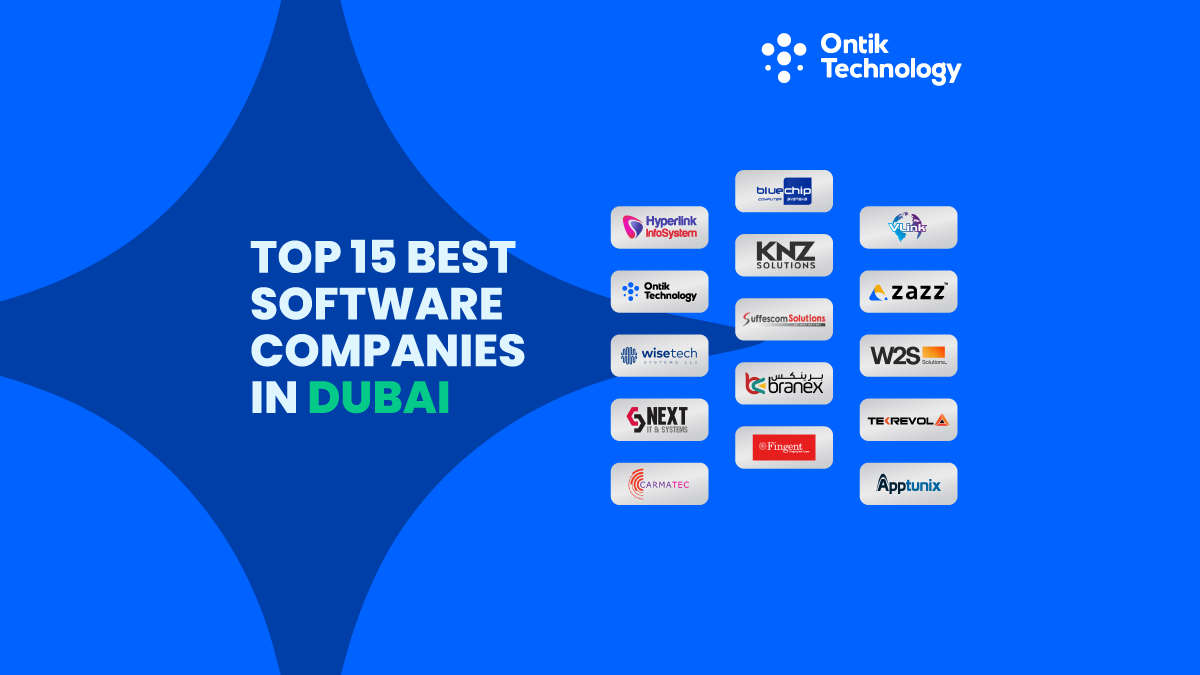

Dubai has emerged as a global technology powerhouse over the past decade. The city's ambitious vision through initiatives like Smart Dubai and Dubai 10X has created a thriving ecosystem for innovation. Government backing plus strategic investments are driving unprecedented growth in the software development sector.
The UAE software market is projected to reach significant milestones by 2029, with steady annual growth exceeding 6%. This expansion attracts world-class talent and cutting-edge technologies to the region. Businesses across the United Arab Emirates now have access to exceptional software development services in Dubai and tailored solutions for their unique needs.
Finding the right best software companies in Dubai can transform your digital presence. This comprehensive guide profiles the top 10 software development companies serving the UAE market. Each leading software development company brings unique strengths to help businesses achieve their technology goals through custom software development, mobile app development, and enterprise solutions.
Why Dubai is a Leading Software Development Hub
Dubai has become a premier destination for development companies in UAE. The government's Dubai Digital Strategy 2025 and Smart Dubai initiatives are pouring billions into digital transformation. This creates massive opportunities for software development in Dubai and businesses seeking innovative development solutions.
The city's strategic location connects the Middle East, Asia, and Europe. Business-friendly free zones like Dubai Internet City and Dubai International Financial Centre offer 100% foreign ownership plus zero taxes. That's huge for tech startups and established tech companies alike.
Access to talent is another game changer. Dubai attracts skilled software developers in Dubai and top software developers from around the world. These highly experienced professionals bring diverse technical expertise in AI and machine learning, blockchain, cloud computing, and mobile application development. The startup ecosystem is thriving too, with venture capital flowing into innovative projects across the software market UAE.
Infrastructure matters for professional software development Dubai operations. The emirate's world-class connectivity and modern facilities make it easy for a software development company based here to operate efficiently. Plus, the UAE market itself is digitally savvy. Consumers and businesses here embrace cutting-edge technologies faster than many other regions, creating demand for top software solutions and custom application development.
Top 15 Best Software Companies in Dubai: Comparison & Profiles
Choosing among top software development companies Dubai takes research. Whether you need a custom software development company, mobile application services, or enterprise solutions, this list of top providers gives you the quick facts. Then we'll dive deep into what makes each software company UAE provider unique and how they can support your digital transformation goals. Many software development companies in UAE offer specialized services, but finding the right tech partner requires understanding their strengths and expertise.
Now let's explore what each of these leading software companies brings to the table. This list of the best software development firms across the Middle East showcases diverse expertise in web and mobile app development, enterprise software development, and cutting-edge AI solutions.
1. Hyperlink InfoSystem

Hyperlink InfoSystem has been transforming businesses since 2011. This custom software development company operates with a massive software development team of 1200+ dedicated developers across global locations. Their track record speaks volumes with 4500+ mobile apps and 2200+ websites delivered.
What They Deliver
- Mobile application development for iOS and Android platforms
- Custom web development with modern frameworks and scalable architecture
- Blockchain development for decentralized solutions across industries
- Artificial Intelligence and machine learning integration for automation
- Game development services with immersive 2D and 3D experiences
Why They Stand Out
Ranked among the top software companies since 2014 with a 4.9 Clutch rating. They serve everyone from startups to Fortune 500 enterprises, delivering high-quality software adapted to each client's unique needs.
2. Ontik Technology
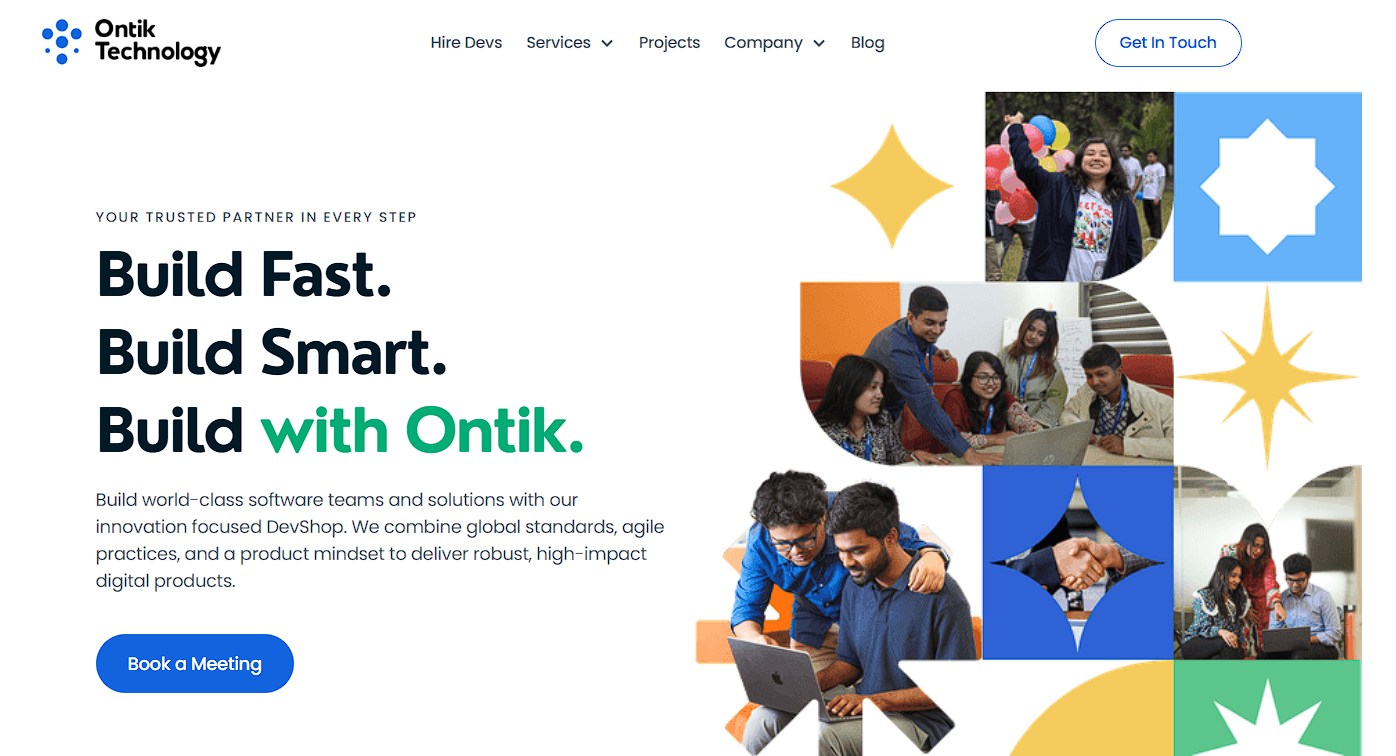
Ontik Technology brings a fresh perspective to software development company Dubai operations. Founded in 2016, this trusted software development provider has quickly built a reputation for speed and quality. With 60+ developers and a presence across Bangladesh, the USA, Canada, and Australia, they deliver for 350+ businesses through their efficient development process.
Service Portfolio
- AI and machine learning strategies that scale with business growth
- Custom web applications using React, Vue.js, Angular, and Django
- Native and cross-platform mobile app development for global reach
- Blockchain and Web3 solutions for decentralized platforms
- Enterprise software including ERP and cybersecurity solutions
- Enterprise software development company UAE, and MVP tech development in Dubai
Their Competitive Edge
Seven-day deployment sets Ontik apart from competitors who need weeks or months to start. Their rigorous vetting rejects 94% of applicants, ensuring only top talent joins your team. Transparent pricing with no surprise fees and agile development methodologies keeps projects moving fast.
- Recognized as a lean startup MVP development company with an agile and skilled development team in Dubai.
- Offers MVP development with technical expertise and scalable development solutions for both new and established businesses.
- Connects startups in Dubai with the Dubai startup hub ecosystem, ensuring smoother product launches and faster adoption.
3. Wisetech
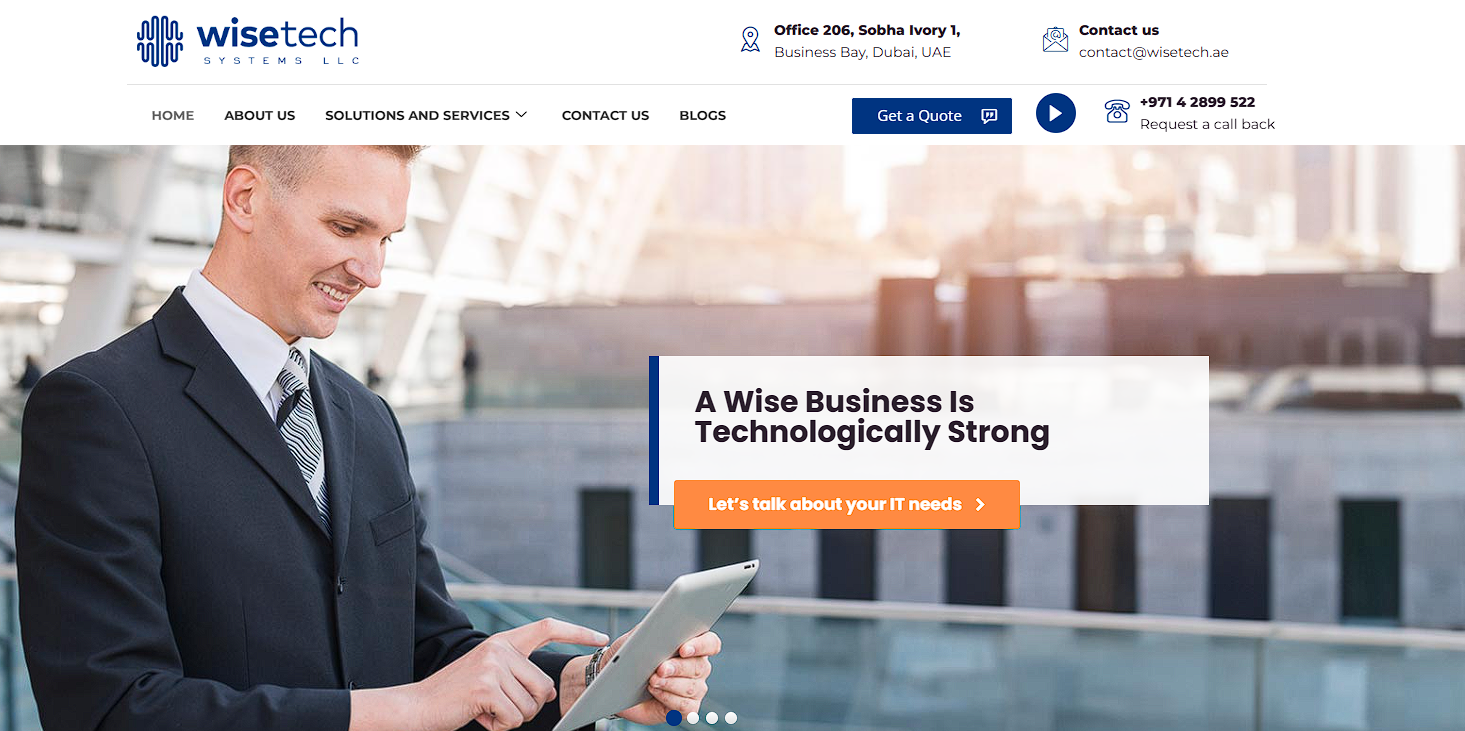
Wisetech has been powering UAE businesses for 16 years. This leading software company focuses exclusively on the local market, understanding the unique challenges Dubai enterprises face. With 500+ completed projects and 110+ satisfied clients, they have deep roots in the region.
Core Offerings
- IT consultancy services for strategic technology planning
- Managed IT solutions with 24/7 monitoring and support
- Cybersecurity services protecting against evolving threats
- Cloud infrastructure solutions on AWS and Azure platforms
- Web and mobile app development tailored for UAE audiences
What Sets Them Apart
Local expertise with multiple offices across Dubai ensures fast response times. The team deeply understands UAE compliance requirements and cultural nuances, making them ideal for businesses prioritizing local partnerships over offshore providers.
4. Next UAE

Next UAE stands out in Dubai's tech ecosystem with a specialized focus. This UAE software development company concentrates on emerging technologies that push boundaries. Their engineering-first approach attracts businesses ready to innovate.
What They Deliver
- Robotics solutions for industrial automation and efficiency
- Drone technology integration for logistics and surveillance
- Internet of Things platforms connecting devices seamlessly
- Custom IT systems designed for complex operational needs
- Automation services that reduce manual processes dramatically
Their Unique Position
Few software companies in Dubai specialize in robotics and IoT like Next UAE. Their niche expertise helps businesses explore cutting-edge solutions and differentiate through technology. The team effectively bridges hardware and software development.
5. Carmatec
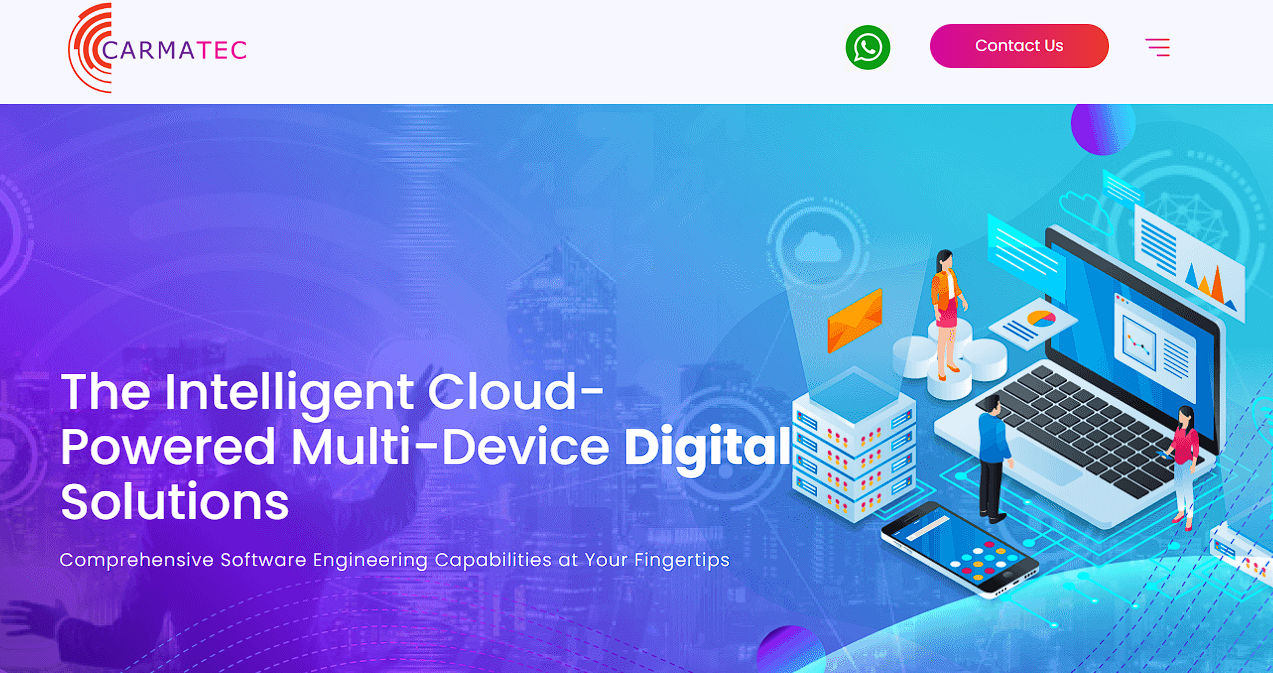
Carmatec brings two decades of enterprise software development experience to Dubai. This global software company maintains offices worldwide while serving GCC clients with dedicated focus. Major brands like QIC, Deutsche Bank, and Swiggy trust their solutions.
Key Capabilities
- Enterprise resource planning systems that streamline operations
- Cloud adoption strategies reducing infrastructure costs
- Custom business software addressing specific industry challenges
- Mobile and web applications with optimized user experiences
- Digital transformation consulting from strategy to execution
Why Enterprises Choose Them
Twenty years in business plus multiple industry awards demonstrate proven reliability. They excel at complex, large-scale projects requiring extensive customization. ISO certification and DesignRush recognition validate quality standards for enterprise-grade solutions.
6. Blue Chip Gulf

Blue Chip Gulf has been the go-to IT solutions company in Dubai for over 20 years. With 40+ technical support engineers and multiple offices across Dubai, they deliver hands-on support when businesses need it most. Their local presence spans Deira, Al Barsha, Dubai Media City, and beyond.
Service Highlights
- Round-the-clock IT support ensuring minimal downtime
- Managed IT services covering infrastructure and operations
- Network cabling and structured connectivity solutions
- Office 365 deployment and ongoing administration
- CCTV and security system installation across UAE
Their Advantage
Relationship-driven service with rapid response times thanks to nearby teams. Businesses needing reliable IT maintenance plus emergency support find a dependable partner who understands local business environments thoroughly.
7. KNZ Solutions
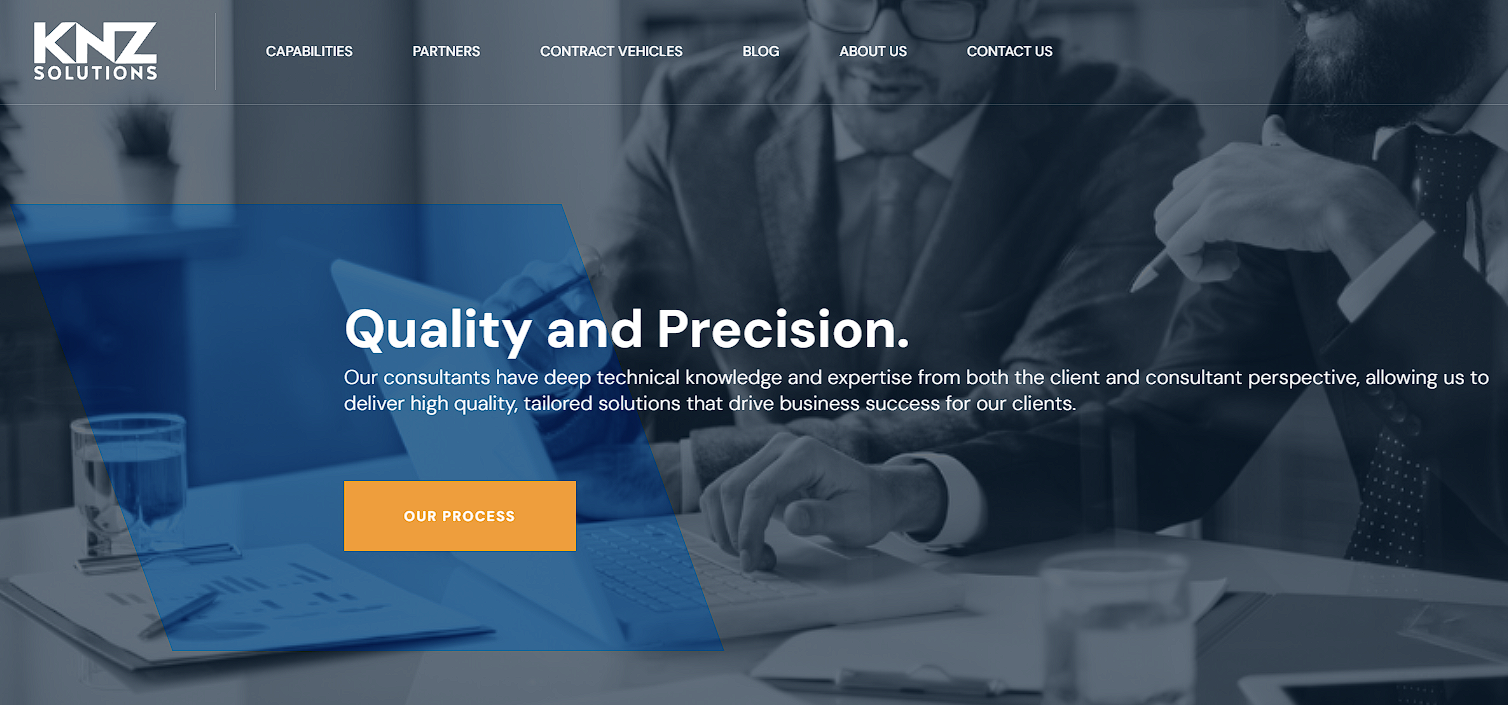
KNZ Solutions operates as a boutique IT consulting firm serving Dubai enterprises. This software consulting company takes a strategic approach, combining deep technical knowledge with business insight. They work from both client and consultant perspectives.
Core Services
- IT strategy consulting aligning technology with goals
- Custom software solutions tailored to workflows
- System integration connecting disparate platforms
- Technical architecture planning for scalability
- Quality assurance processes ensuring reliable delivery
What Distinguishes Them
Focus on precision over volume with consultants who invest time understanding your business before recommending solutions. This measured approach works well for enterprises seeking thoughtful guidance rather than cookie-cutter software.
8. Suffescom Solutions

Suffescom Solutions positions itself at the forefront of emerging technology. This mobile app development company specializes in innovations that reshape industries. Their work spans AI-powered applications, Web3 platforms, and blockchain implementations.
What They Provide
- Artificial Intelligence solutions with natural language processing
- Web3 and blockchain development for decentralized systems
- Mobile applications leveraging cutting-edge technologies
- Smart contract development for automated transactions
- Digital partnership platforms connecting ecosystems
Why Innovation Leaders Choose Them
Suffescom targets businesses ready to experiment with new technologies. Their blockchain expertise helps companies explore cryptocurrency, NFT, and decentralized finance opportunities. The team thrives on complex technical challenges that keep organizations ahead of technology curves.
9. Branex
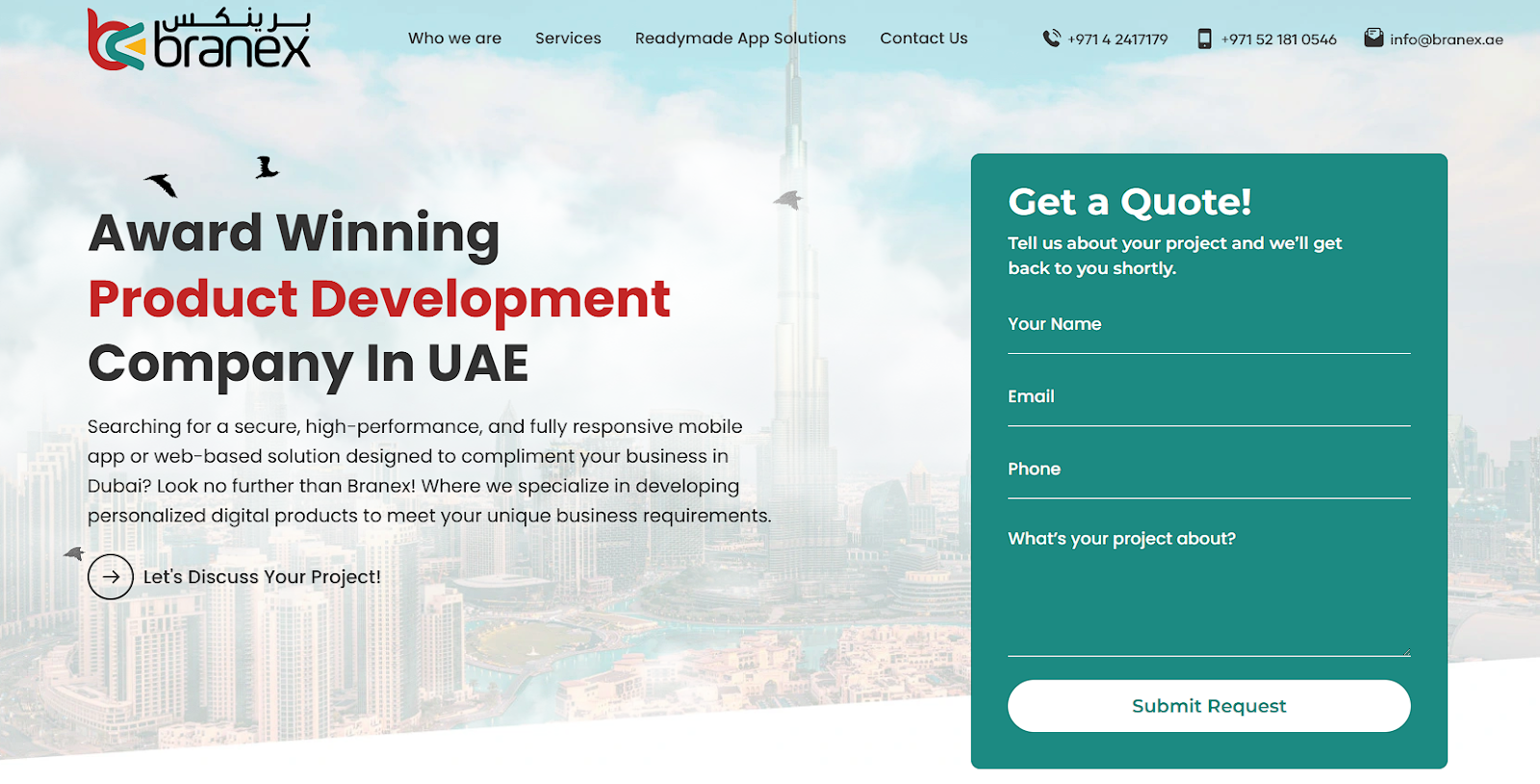
Branex combines beautiful design and development with robust technical execution. This Dubai-based development agency earned a 4.8 rating on Clutch by delivering digital products users love. Their design-first philosophy ensures software looks as good as it functions.
Service Portfolio
- User experience design creating intuitive interfaces
- Responsive web development for all devices
- Mobile application development with polished aesthetics
- Digital product strategy from concept to launch
- Brand identity design integrated with software solutions
Their Design Advantage
Branex excels when visual appeal and user experience drive success. Their creative plus technical blend works perfectly for consumer-facing applications. Startups and brands prioritizing differentiation through design find great software that delights users.
10. Fingent
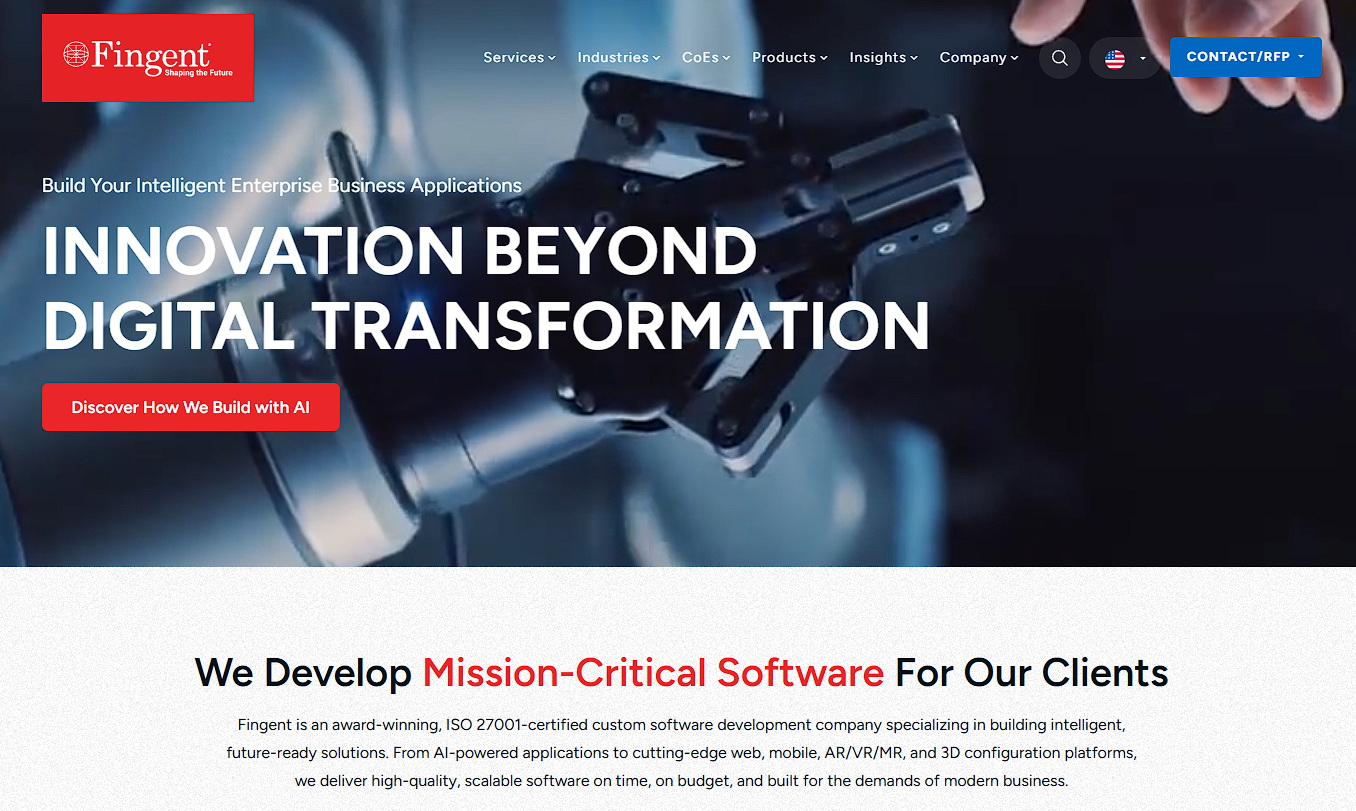
Fingent delivers mission-critical software for enterprises that cannot afford failures. This ISO 27001-certified custom software development company holds a perfect 5.0 rating across multiple client reviews. Founded with a focus on quality, they serve industries where reliability is non-negotiable.
Primary Offerings
- Custom enterprise software with rigorous testing protocols
- Artificial Intelligence implementation for business automation
- SAP integration and enterprise resource planning systems
- Robotic process automation reducing operational costs
- Extended reality experiences using AR, VR, and MR technologies
What Makes Them Reliable
Flawless execution with commitment to bug-free software shows in client testimonials. Industries like healthcare, finance, and manufacturing requiring enterprise-grade reliability trust their approach. Certified expertise in emerging platforms adds cutting-edge capabilities.
11. VLink Info
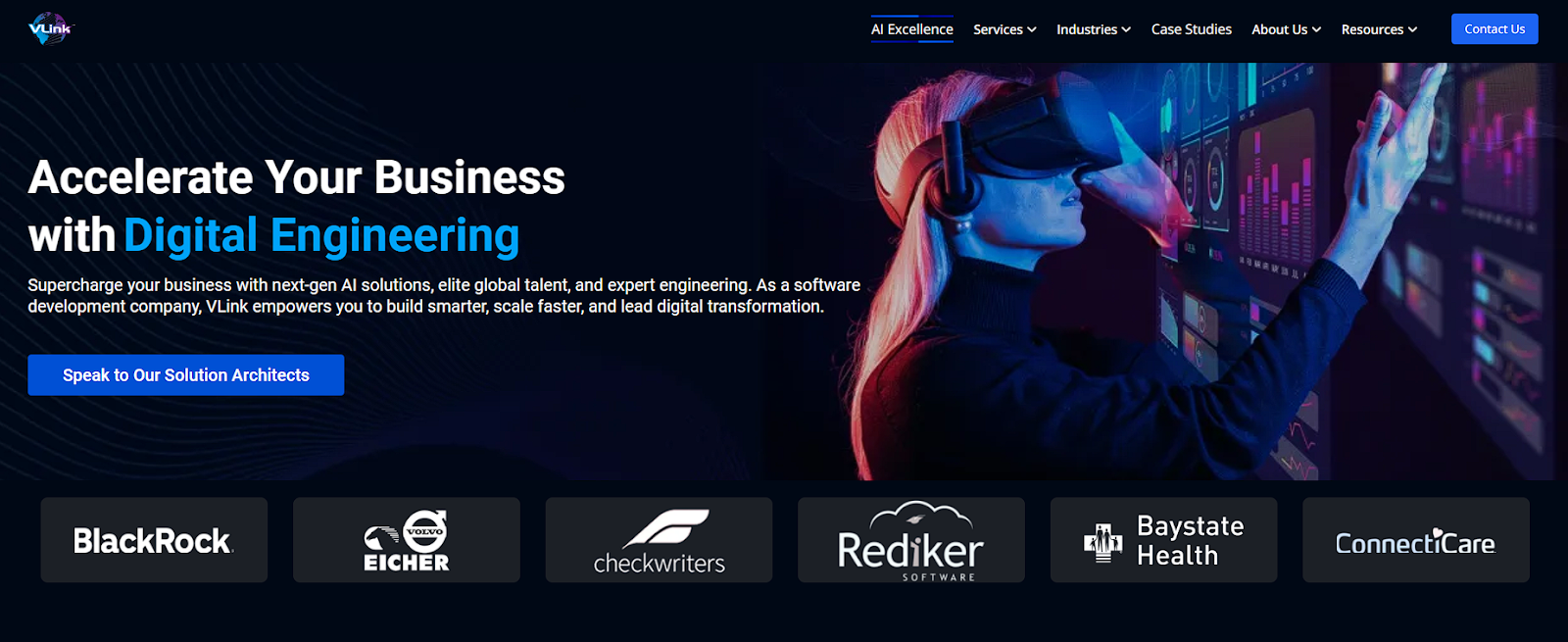
VLink Info operates as a global powerhouse with 1800+ technology professionals. Founded in 2006, this leading software development company serves 250+ clients including Fortune 500 enterprises. Their Connecticut headquarters plus delivery centers in India and Indonesia enable 24/7 operations.
Core Capabilities
- IT staff augmentation placing top 3% talent within 48 hours
- Custom software development across web and mobile platforms
- Digital transformation consulting with implementation support
- Cloud services including migration and infrastructure management
- Dedicated development teams working as extensions of clients
Their Speed Advantage
Rapid talent deployment is unmatched with 48-hour onboarding. Multiple awards including Inc 500/5000 recognition validate their growth trajectory. Enterprises needing flexible team expansion without recruitment headaches find compliance with GDPR, PCI DSS, and other standards ensures security.
12. Zazz
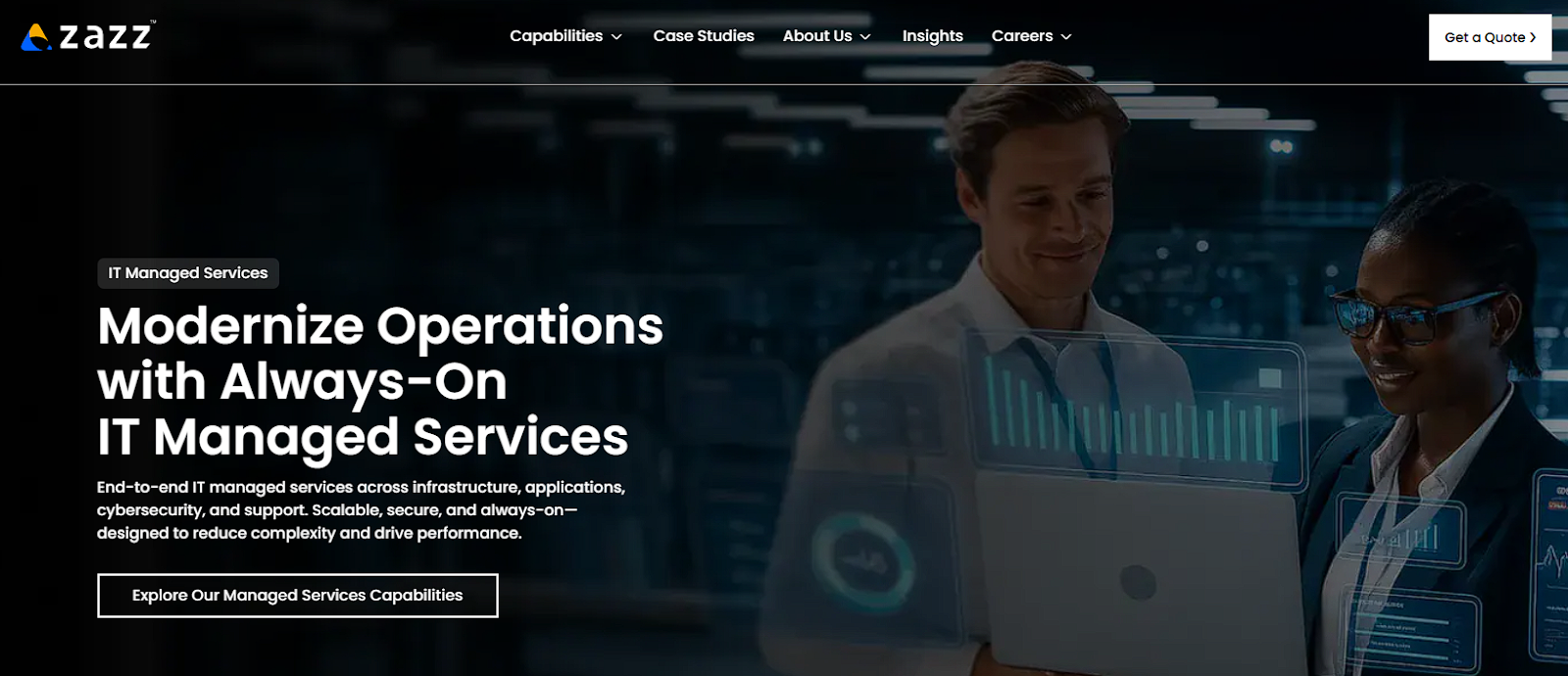
Zazz brings Silicon Valley innovation to Dubai. Founded in 2009 with offices across North America plus Dubai, this top mobile app development company has shipped 700+ applications for 600+ companies. Forbes ranked them as the number one app development company in dubai.
What They Offer
- Enterprise mobile applications with architecture-led development
- Cross-platform development using Flutter and React Native
- Web application development for complex business needs
- IoT solutions connecting smart devices and platforms
- Product strategy consulting from concept to market
Why They Excel
Enterprise focus means they handle complexity well. Banking, healthcare, and government clients trust their security-first approach. Agile methodology combined with design thinking produces applications users actually want, with experience spanning multiple continents bringing diverse perspectives.
13. Way2Smile Solutions

Way2Smile Solutions specializes in digital transformation for government and enterprise clients. Operating from Jumeirah Lakes Towers in Dubai, this software development company has delivered 250+ applications. CEO Madhu Kesavan brings 20+ years of IT industry experience.
Service Range
- AI-powered software solutions for intelligent automation
- Custom ERP systems streamlining business operations
- Cloud-native application development for scalability
- Mobile and web development using agile methodologies
- IT consulting services for strategic technology decisions
Their Government Expertise
Government partnerships demonstrate reliability and compliance expertise. Work supporting Dubai's AI concierge initiative showcases capability with high-profile projects. Enterprises and government entities needing solutions that meet strict requirements find understanding of UAE digital strategies valuable.
14. TekRevol
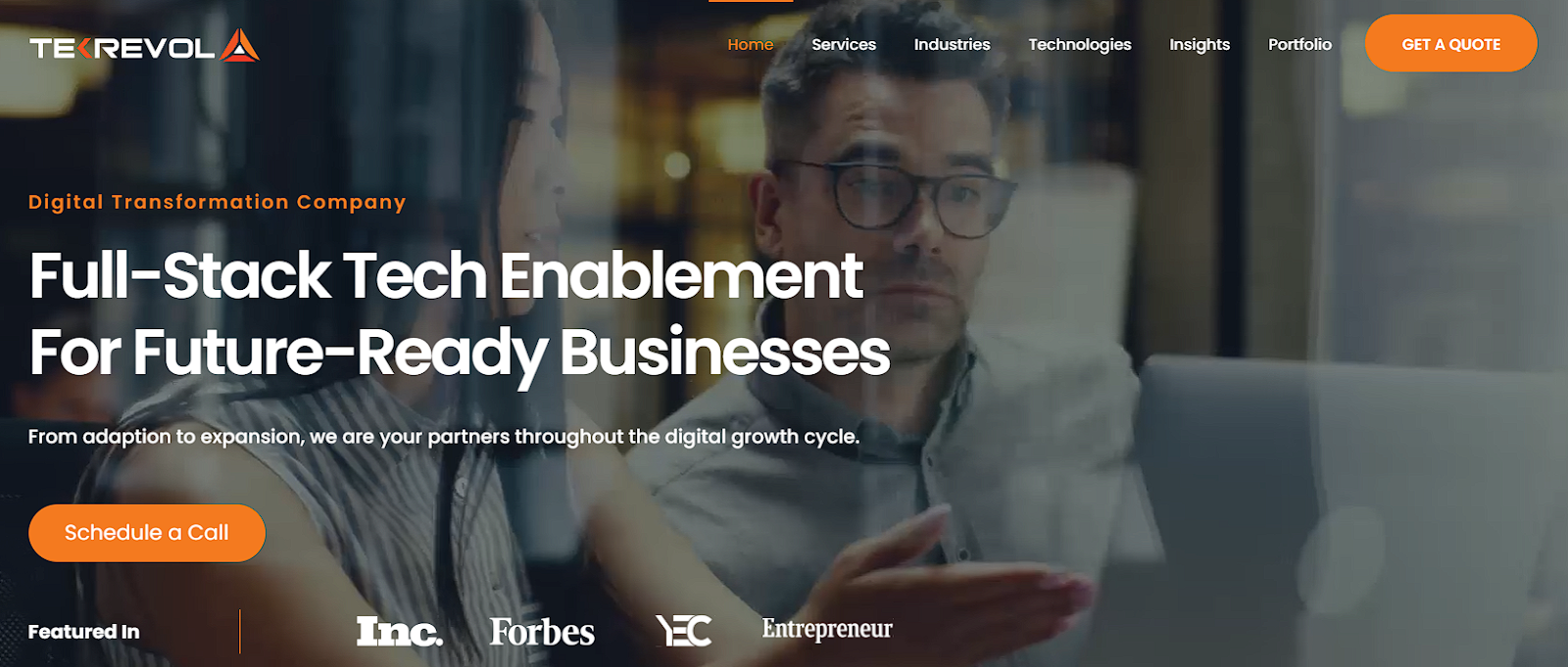
TekRevol has been accelerating digital transformation since 2013. With 350+ developers and offices across the GCC, USA, Canada, and UK, they serve 15+ industries. Their Dubai location in Sheikh Rashid Tower at Dubai World Trade Center ensures easy access.
What They Deliver
- Mobile app development for iOS, Android, and cross-platform
- Custom software development solving unique business challenges
- Game development creating immersive 2D and 3D experiences
- Artificial Intelligence and blockchain integration services
- Web development with responsive, high-performance solutions
Their Regional Focus
GCC market focus means they understand regional business culture. Notable clients like OZ Leasing and Mdrouz validate Middle East expertise. Comprehensive service range from mobile apps to game development provides flexibility with ROI-focused approach ensuring measurable business value.
15. Apptunix
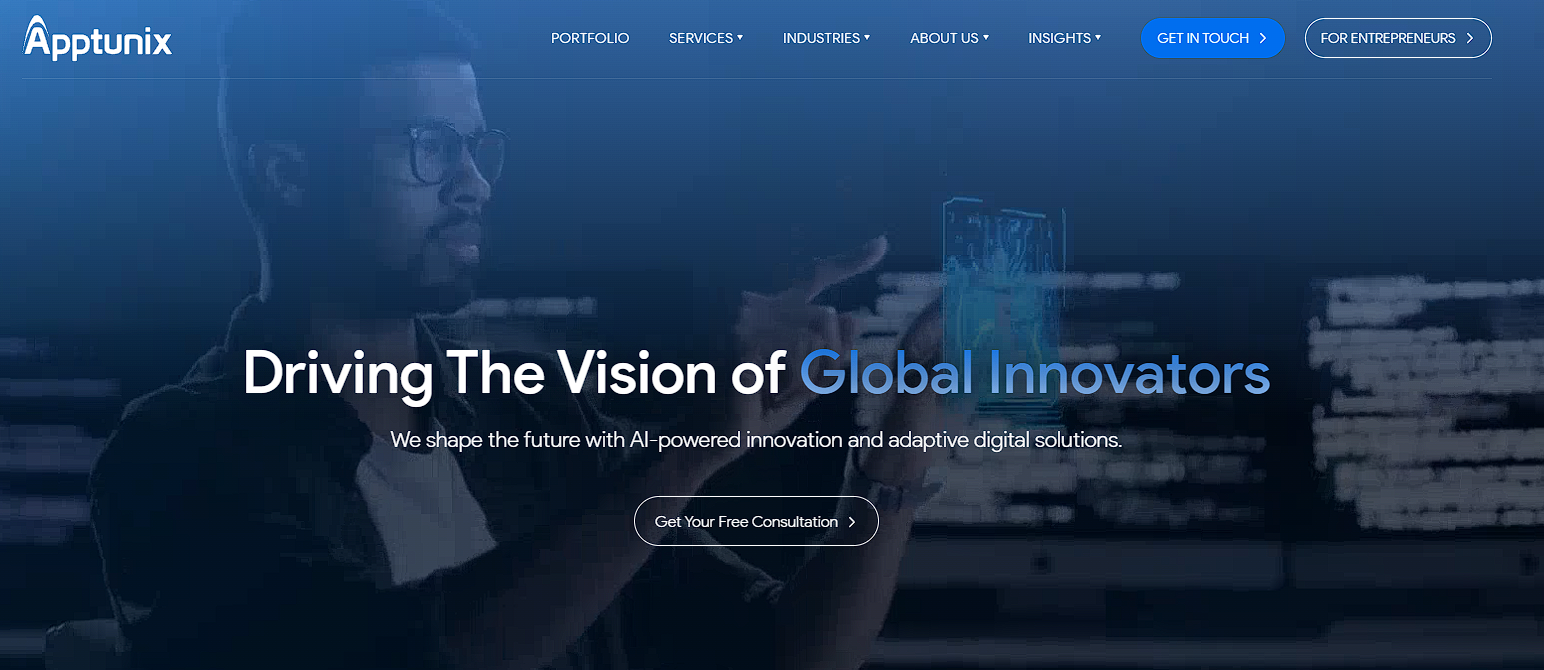
Apptunix rounds out our list with impressive credentials. Since 2013, they have delivered 2,500+ projects for major brands including McDonald's, ISUZU, and Namshi. With 250+ technology professionals across Dubai, New York, London, and India, they combine global reach with local presence.
Primary Services
- Mobile application development with Arabic language support
- Custom software solutions meeting UAE compliance standards
- Artificial Intelligence and machine learning implementations
- Blockchain and metaverse application development
- Wearable technology and IoT platform creation
Their UAE Advantage
Dubai operations in One Central at Dubai World Trade Center demonstrate commitment to the UAE market. Arabic support plus RTL design capabilities serve regional needs effectively. Recognition as a Top 100 mobile app development company by Clutch validates quality for businesses prioritizing UAE compliance.
Key Services Offered by Software Companies in Dubai
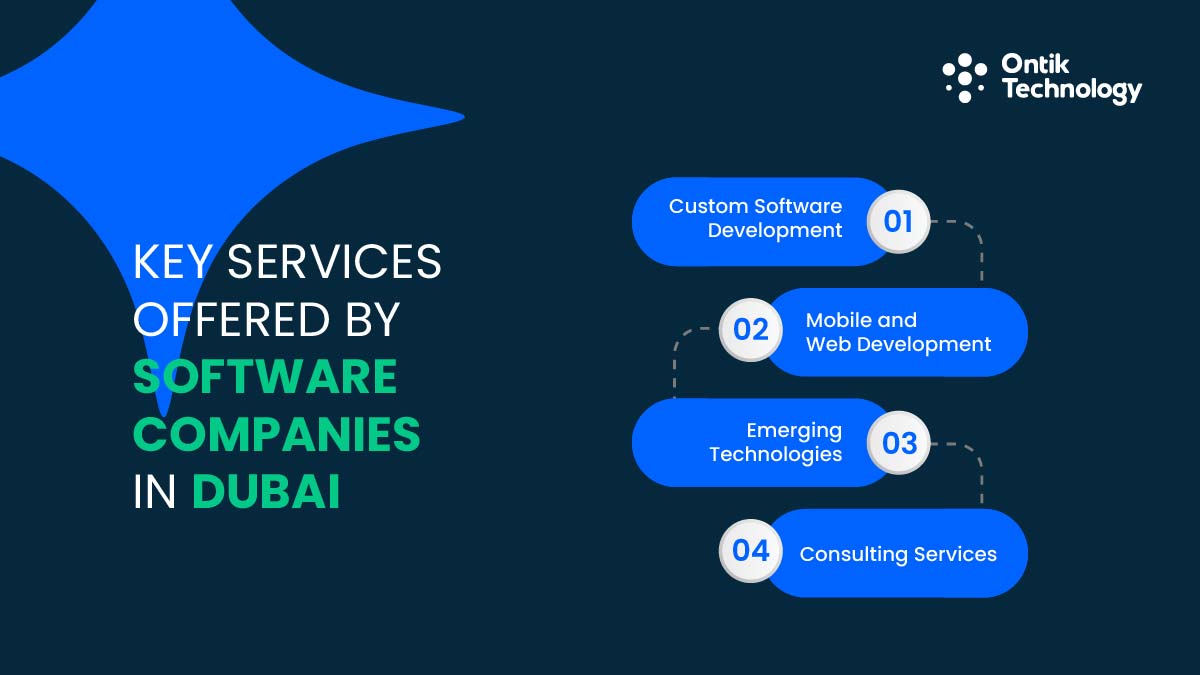
Understanding what software services you need helps narrow choices among software solutions providers in UAE. Top-rated software agencies in UAE offer comprehensive development solutions across multiple domains to help businesses succeed.
Custom Software Development
Custom software development services address specific business challenges that off-the-shelf products cannot solve. Enterprise software development UAE creates customized software and tailored solutions matching your exact workflows. Custom ERP software development UAE streamlines operations across departments while CRM software solutions Dubai help manage customer relationships effectively. These solutions require deep business understanding, with dedicated software development teams analyzing requirements and building scalable systems from the ground up.
Mobile and Web Development
Mobile app development company services reach customers where they spend most digital time. Native iOS and Android development delivers optimal performance, while cross-platform solutions reduce costs. Web development company services create responsive platforms handling complex functionality. A web development company providing expert software solutions focuses on user experience, ensuring smooth navigation and engaging web and mobile interfaces across all devices.
Emerging Technologies
AI and ML software development Dubai brings intelligence to applications through predictive analytics and automation. Cloud software solutions Dubai provide scalability without infrastructure investment. Blockchain creates transparent systems while IoT solutions connect physical devices to digital platforms. These cutting-edge technologies give competitive advantages when implemented thoughtfully by experienced software engineers in Dubai.
Consulting Services
Software consulting firms in Dubai guide strategic technology decisions. Consultants evaluate current systems, identify gaps, and recommend solutions tailored to your needs. Digital transformation consulting helps businesses modernize operations comprehensively, with technical expertise in tech stack selection and architecture planning ensuring long-term scalability.
Tech stack selection determines long-term flexibility and cost. Architecture planning ensures scalability as you grow. The right consulting partner saves money by preventing costly mistakes early.7
Picking the right software development partner determines project success. When evaluating software companies in the UAE and looking for the best software solutions, start by reviewing portfolios focused on your industry. Companies with relevant experience understand your challenges better. Look for case studies demonstrating successful delivery and client testimonials revealing how teams handle pressure.
Technical expertise matters immensely. Verify UAE software development companies use modern tech stack options and agile development methodologies. Check their proficiency in required languages and frameworks.
Effective communication distinguishes great partnerships. Maintain significant overlap with UAE business hours and ensure response times are under 2 hours.
Compare development cost against value delivered when hiring software developers in Dubai or app developers, not just hourly rates. Understanding the benefits of IT staff augmentation can help you make informed decisions about team structure.
Affordable software companies Dubai may seem attractive, but quality matters for long-term success. Understand what quotes include to avoid surprise charges.
Post-launch support determines satisfaction. Verify providers offer maintenance and updates after deployment. It is essential to prioritize security and compliance. This involves confirming comprehensive Non-Disclosure Agreements (NDAs), utilizing encrypted communication methods, and ensuring strict adherence to all UAE data regulations.
Thoroughly evaluate potential software development partners, whether for Dubai startups or enterprise solutions, to avoid costly errors and find the best fit.
Software Development Cost in Dubai: Pricing Guide 2025
Understanding costs helps budget appropriately for custom business software Dubai projects. Software outsourcing companies Dubai pricing depends on multiple factors.
Hourly Rate Breakdown
Location Impact on Pricing
Onshore Dubai developers cost $90-130/hour with face-to-face collaboration benefits. Nearshore teams charge $60-80/hour with reasonable time zone overlap. Offshore software development Dubai drops to $35-60/hour though communication requires more effort.
Project Cost Examples
Simple mobile apps: $30,000-50,000
Complex enterprise software: $100,000-300,000
Large-scale digital transformation: $500,000+
Hidden Costs to Watch
Setup fees ($500-2,000 per developer), management overhead (10-15%), monthly minimum hours, and exit fees can add up. When evaluating software design and development services UAE, compare total project value.
Securing detailed estimates from various providers of software product development in Dubai is crucial for setting a realistic budget. The primary concern is Return on Investment (ROI); high-quality software development services are a worthwhile investment, leading to substantial gains in efficiency and fostering business growth.
Why Choose Ontik Technology for Software Development in Dubai, UAE
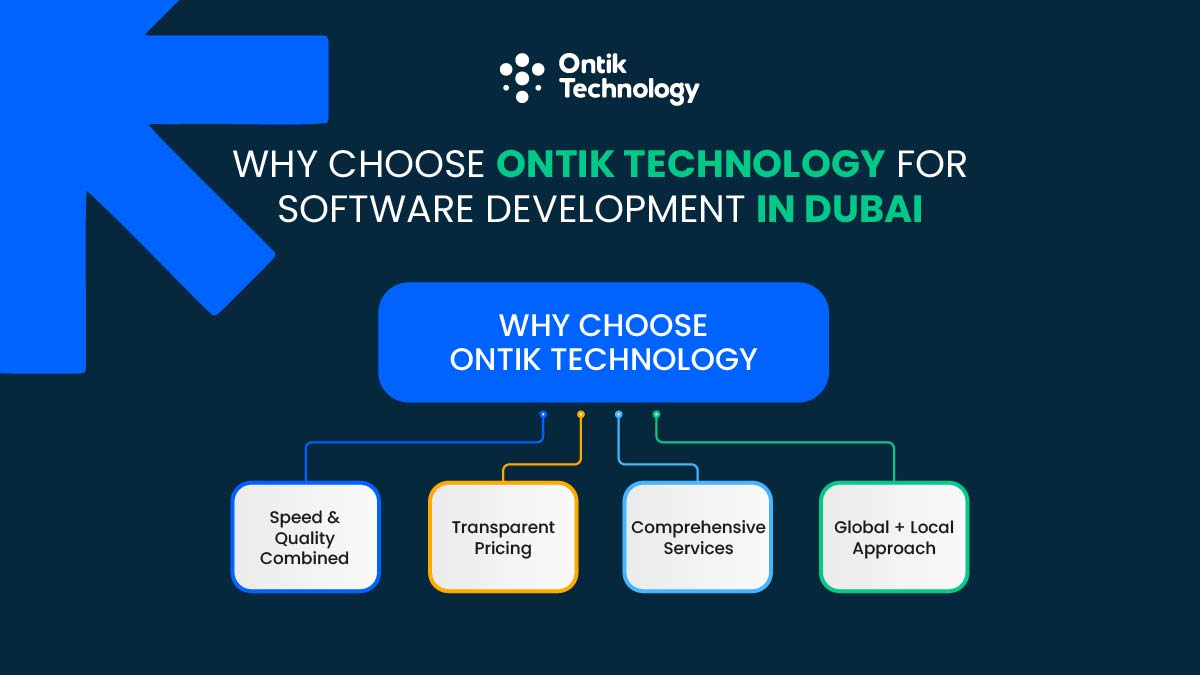
Ontik Technology stands out among software company UAE providers through proven expertise in custom software development Dubai. Since 2016, we've delivered business software solutions Dubai for startups and enterprises across 20+ countries, specializing in AI-powered applications and scalable SaaS platforms.
As a leading software provider, we combine global software expertise with local market understanding. Whether you need MVP development services for startups or enterprise-grade solutions, we deliver exceptional results.
Speed & Quality Combined
Our seven-day deployment beats industry standards by weeks. Access the top 6% of pre-vetted software engineers in Dubai, available for immediate assignment. Our screening process ensures the highest quality talent.
You skip lengthy recruitment while gaining developers who contribute from day one on your software product development Dubai projects. Our efficient development process ensures rapid results without compromising quality.
Transparent Pricing
One all-inclusive rate covers developer time, management, infrastructure, and weekly reports. No setup fees or hidden charges. Start with a two-week trial, then scale up or down with 48-hour notice. Monthly rolling contracts provide flexibility without rigid minimums, making us an affordable yet premium choice for development in Dubai. Learn more about offshore staff augmentation advantages.
Comprehensive Services
As a full-service custom software development company, we deliver:
- Custom web applications using modern frameworks and the latest tech stack
- AI and ML software development for intelligent automation
- Mobile apps across iOS, Android, and cross-platform
- Cloud software solutions optimizing infrastructure costs
- UI/UX design and development ensuring exceptional user experience
Global + Local Approach
Our Bangladesh development center provides access to 60+ software developers while maintaining competitive rates. Continuous quality monitoring through monthly reviews and quarterly code audits ensures excellence. Underperforming members receive immediate training or replacement at no extra cost, ensuring your software development team consistently delivers.
Getting Started: Book a free consultation to discuss your custom business software Dubai needs. Meet shortlisted developers and deploy your team within seven days.
Software Development Trends in Dubai 2025
The software market UAE continues evolving rapidly. Understanding these trends helps businesses make forward-looking technology decisions with Dubai focuses on becoming a global tech hub. Dubai technology companies and software companies in the UAE are leading innovation across multiple domains.
AI Dominates Development
AI implementation has become essential across industries. Companies leverage machine learning for predictive analytics, chatbots for customer service, and automation for operations. Software development hubs in Dubai are prioritizing AI capabilities as businesses recognize that delaying adoption means falling behind competitors seeking cutting-edge solutions. Organizations exploring AI MVP development can rapidly validate their concepts before full-scale implementation.
Blockchain Beyond Crypto
Web3 technologies are solving real business problems through supply chain transparency, digital identity verification, and smart contracts. The United Arab Emirates' crypto-friendly regulations position Dubai as a regional blockchain hub attracting global software development expertise.
Cloud-Native & Security
Modern application development focuses on cloud-native architecture delivering better scalability and cost efficiency. Simultaneously, cybersecurity has intensified with zero-trust architectures and continuous monitoring becoming standard. UAE data regulations drive additional compliance requirements that professional software development Dubai teams must address from initial design phases.
Sustainability & Government Innovation
Energy-efficient code and green hosting reflect growing environmental consciousness. Dubai's 10X initiative aims to position the city a decade ahead globally, driving massive smart city investments. Software companies partnering with government projects gain experience implementing cutting-edge solutions at scale, while low-code platforms democratize application development. However, custom software development services remain essential for competitive differentiation and unique business requirements.
Conclusion
Dubai's thriving tech ecosystem offers world-class software development talent and infrastructure. The 10 best software companies in Dubai combine global technical expertise with local market knowledge to help businesses succeed. Whether you need mobile apps, enterprise software development solutions, or cutting-edge AI implementations, qualified partners are ready to help.
When selecting from among the top software companies, evaluate providers carefully using technical expertise, communication quality, and proven results. Consider factors like industry experience, development methodologies, and ability to customize solutions for your specific needs. The right software development partner accelerates your digital transformation and business growth in 2025 and beyond.
Start your search today among software solutions providers in UAE and take your business to the next level. Whether you're a startup seeking affordable software companies Dubai or an enterprise requiring comprehensive business software solutions Dubai, the perfect tech partner awaits in this dynamic software development hub. These developers in Dubai are ready to transform your vision into reality.
Frequently Asked Questions
1. What is the average cost of software development in Dubai?
Software development in Dubai ranges from $40-150 per hour depending on developer expertise and location. Simple mobile apps cost $30,000-50,000, while complex enterprise solutions range $100,000-300,000.
2. How long does it take to develop custom software in Dubai?
Custom software development timelines vary by complexity. Simple applications take 2-4 months, medium complexity projects need 4-8 months, and large-scale enterprise solutions require 8-18 months for completion.
3. What are the benefits of hiring software developers in Dubai?
Dubai offers access to diverse global talent, tax-free zones, strategic location connecting three continents, government support for innovation, and a thriving tech ecosystem with cutting-edge infrastructure.
4. Which programming languages are most popular among Dubai software companies?
Dubai software companies commonly use JavaScript, Python, Java, React, Angular, Node.js, Swift for iOS, Kotlin for Android, and emerging technologies like blockchain frameworks and AI/ML libraries.
5. Do Dubai software companies provide post-launch support and maintenance?
Yes, reputable Dubai software companies offer comprehensive post-launch support including bug fixes, updates, security patches, performance monitoring, feature enhancements, and ongoing maintenance through service level agreements.
6. How do I choose between offshore and onshore software development in Dubai?
Consider your budget, communication needs, and project complexity. Onshore offers face-to-face collaboration but costs more. Offshore provides cost savings with skilled developers but requires strong remote communication processes.
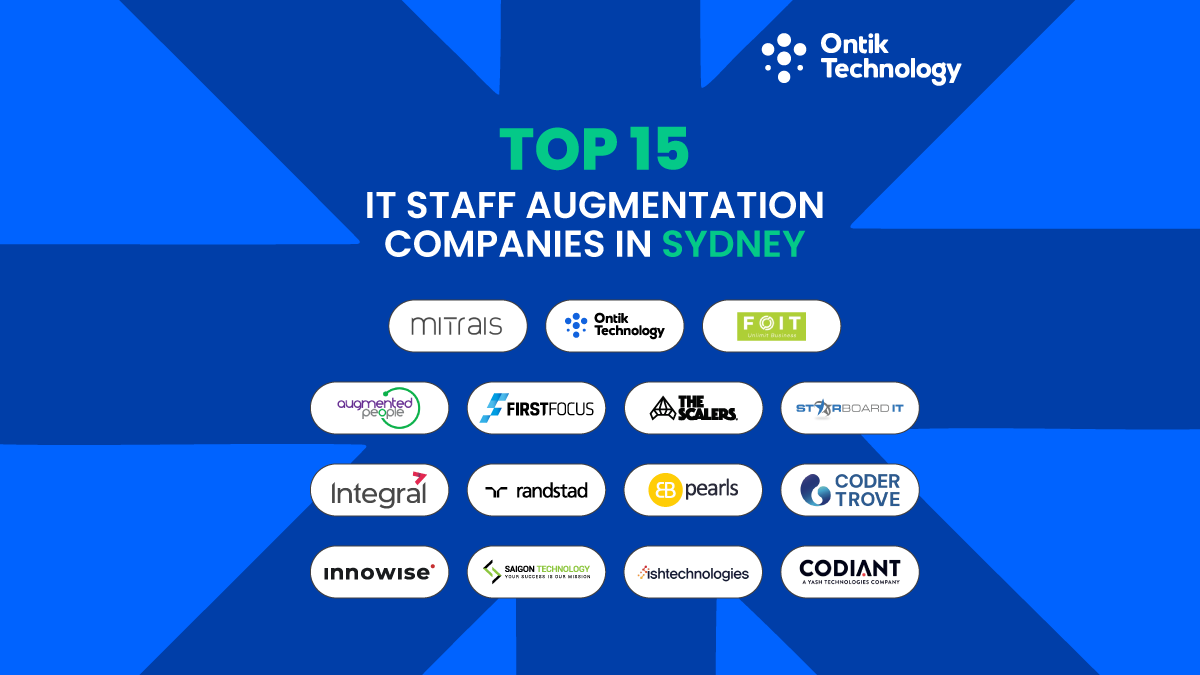
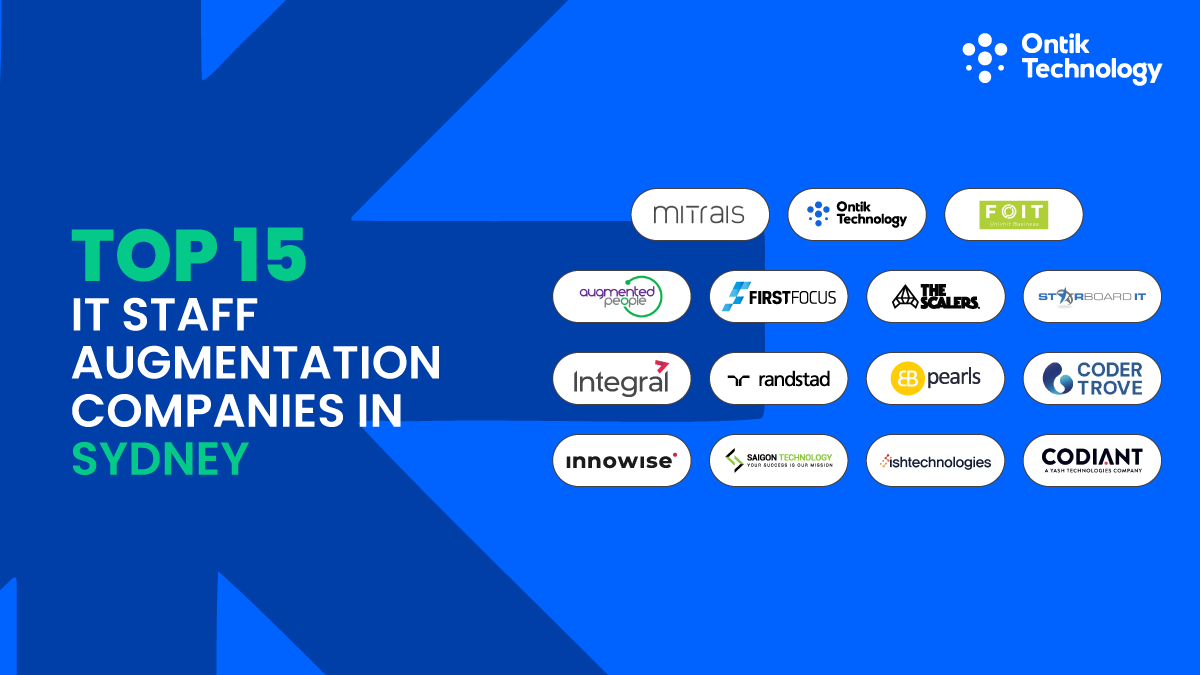
Sydney's tech scene is booming in 2025, which means companies are feeling the heat to come up with cool new solutions even when money's tight and deadlines are looming. Those old-school, months-long hiring processes just aren't cutting it anymore.
That's why IT staff augmentation has become a smart move for Sydney businesses who need specialized talent, like, yesterday. This approach lets them quickly scale up their teams without the headache of permanent overhead or endless recruitment. With staff augmentation services in Sydney, businesses get to stay in the driver's seat of their projects while tapping into top-notch global expertise.
Australia's position as an APAC technology hub makes Sydney particularly attractive for IT staff augmentation. The city offers English-speaking professionals, strong intellectual property protections, and convenient time zone overlap with Asian markets. Startup companies in Sydney can tap into local expertise or leverage offshore talent through IT Staff Augmentation Companies in Sydney.
This guide explores the top 15 providers, with comparisons, pricing insights, selection tips, and strategies to boost your development capacity.
What is IT Staff Augmentation?
IT staff augmentation lets you extend your development team with external professionals. You maintain full control over the project. The augmented team members work as part of your in-house squad. They follow your processes, use your tools, and report to your managers.
This model differs from traditional IT outsourcing companies. You are not handing off entire projects to a third party. Instead, you are adding specific skills to your existing team for as long as needed. When the project wraps up or requirements change, you can scale down without the complications of permanent layoffs.
Software staff augmentation works through three main engagement models. Project-based augmentation brings in specialists for specific initiatives with defined timelines. Long-term augmentation fills ongoing skill gaps in your core team. Hybrid models combine both approaches, giving you maximum flexibility as business needs shift.
The beauty of this approach is speed. You skip the months-long hiring process. Background checks, interviews, and technical vetting happen on the provider's end. You get developers who can contribute from day one through IT staffing services.
Top 15 IT Staff Augmentation Companies in Sydney
Finding the right IT Staff Augmentation Companies in Sydney starts with understanding what each provider brings to your team. This comparison table plus detailed profiles help you make informed decisions fast when evaluating staff augmentation services in Sydney.
Quick Comparison Table
Detailed Company Profiles: Sydney
1. Ontik Technology
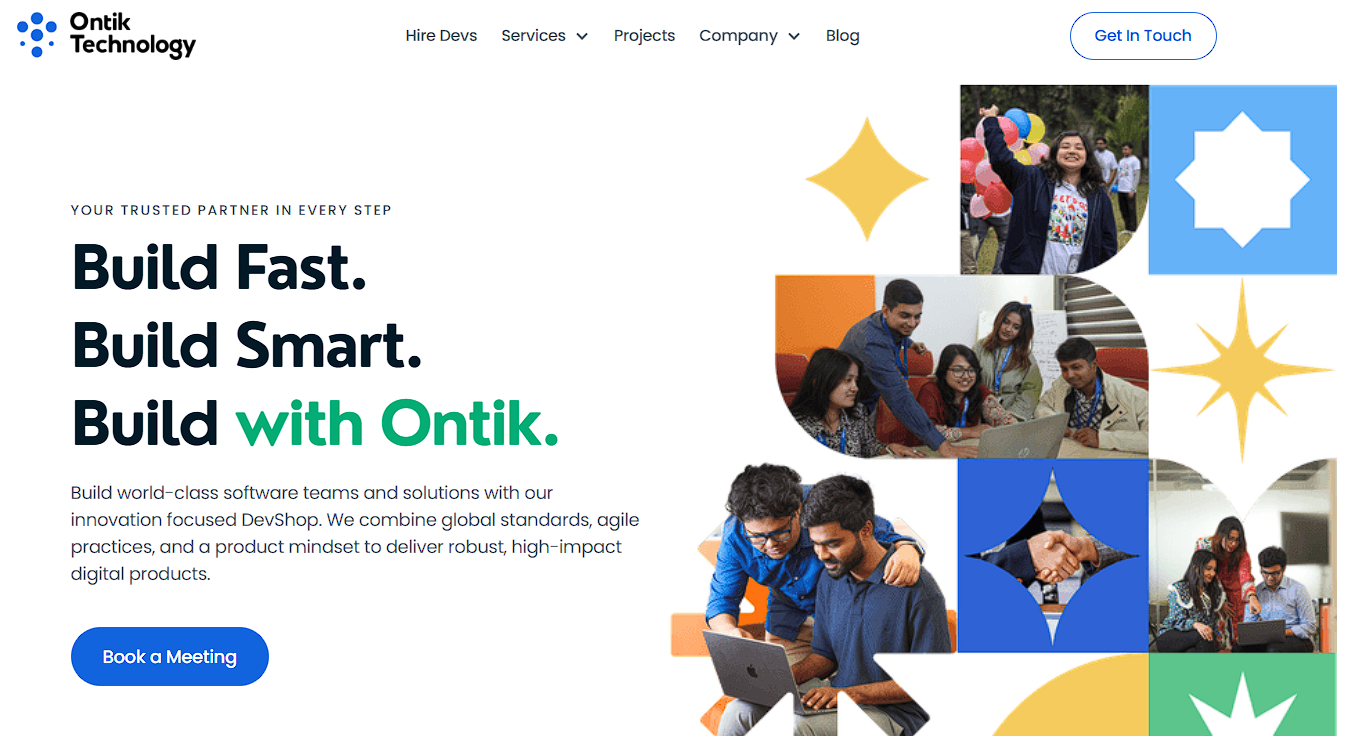
Ontik Technology leads Sydney's staff augmentation space with a focus on rapid deployment plus quality assurance. Operating since 2016, they specialize in helping startups and IT firms scale development teams without traditional hiring delays. Their dual presence in Australia and Bangladesh enables competitive pricing while maintaining Sydney-based account management. The company has delivered 220+ successful projects across 20+ countries, building expertise in AI-powered solutions, SaaS platforms, and MVP development for time-sensitive launches.
Core Offerings
- Full-stack web development with MERN stack, Python, and modern frameworks
- AI and machine learning implementation for business automation
- MVP development with agile SCRUM methodologies
- Seven-day deployment guarantee with pre-vetted talent pool
- Transparent fixed-rate pricing covering all management overhead
What Makes Them Different
Fastest deployment guarantee on this list at seven days from approval to active contribution. Their rigorous vetting rejects 94% of applicants, ensuring only top 6% join client teams. No hidden fees or surprise charges. Sydney office enables face-to-face collaboration when needed. Strong track record with fintech and healthcare startups requiring rapid scaling.
2. Mitrais
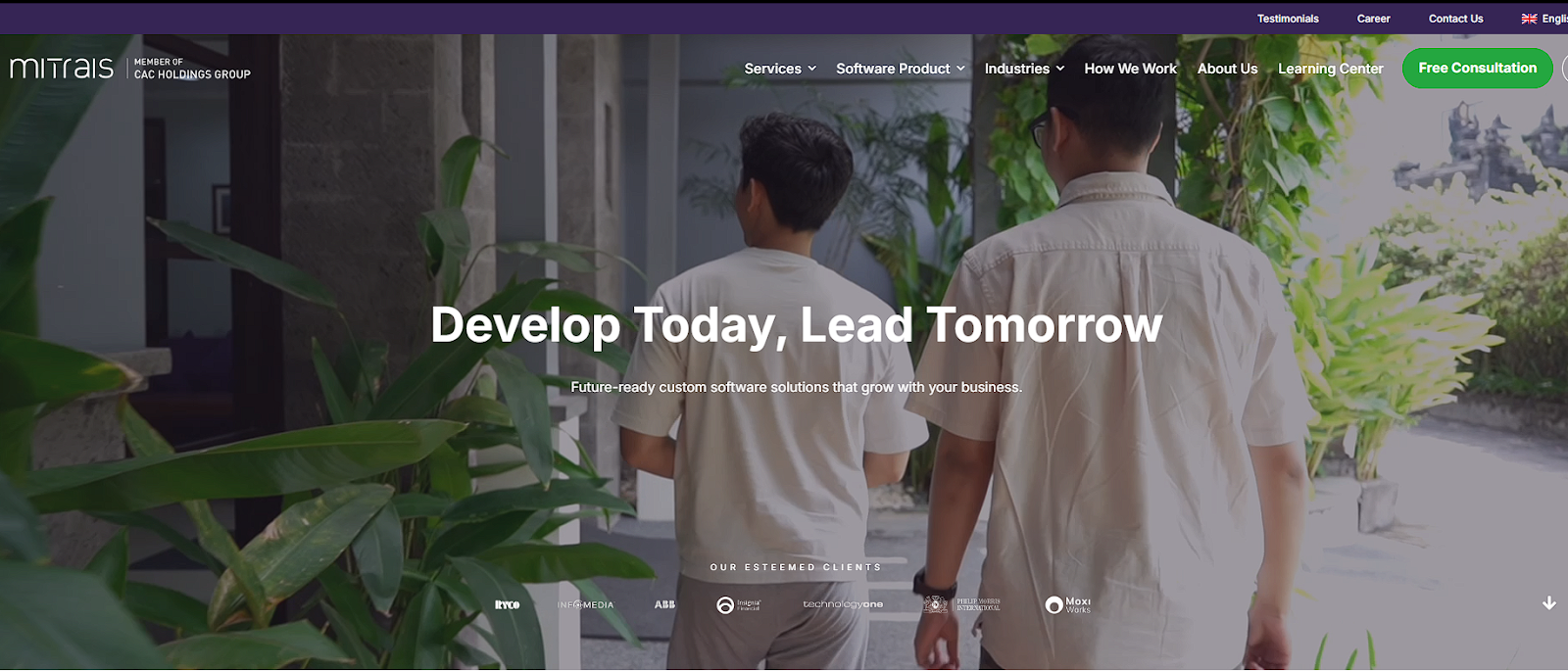
Mitrais, with three decades of software development experience, is a leading offshore development provider in Indonesia (Forrester Research). They serve major financial institutions and government agencies in Sydney, ensuring consistent quality with their competency management system. They've completed over 500 projects, fostering long-term client relationships (average 3+ years).
What They Deliver
- Enterprise-grade agile development teams for complex projects
- Java, .NET, and Microsoft technology stack expertise
- Cloud migration and modernization services (AWS, Azure)
- Mobile application development for iOS and Android platforms
- Legacy system transformation with minimal business disruption
What Makes Them Different
Three-decade track record with clients like Technology One, IOOF, and HSBC. Nearshore advantage offers 5-8 hour business overlap with Australian time zones. Half of engagements exceed three years. Proprietary system ensures developers' cutting-edge skills through continuous training.
3. FOIT

FOIT operates as a comprehensive IT consulting firm with strong Sydney presence plus offices across Melbourne, Perth, and Adelaide. They specialize in helping enterprises navigate complex technology challenges while maintaining strict security and compliance standards. The company serves government agencies, financial institutions, and healthcare organizations requiring high-security development practices. Their 24/7 support model ensures continuous coverage for mission-critical projects.
Service Portfolio
- IT staff augmentation with rigorous security vetting processes
- Managed cybersecurity services and risk assessment
- Cloud infrastructure optimization (Microsoft Azure, AWS)
- Strategic IT consulting for digital transformation initiatives
- Compliance-focused development for regulated industries
What Makes Them Different
Australian-owned with local regulatory understanding. 24/7 support via Sydney-based account managers. Strong government/enterprise portfolio. Security-first development for compliance. National coverage via multi-city presence.
4. Augmented People

Augmented People takes a consultative approach to staff augmentation, prioritizing cultural alignment alongside technical expertise. Founded in 2015, they differentiate themselves by matching professionals based on work style, communication preferences, and team dynamics. This methodology results in significantly higher retention rates compared to traditional skill-only matching. They serve mid-sized companies seeking seamless team integration rather than just technical bodies.
Key Capabilities
- Cultural fit assessment and work style compatibility analysis
- UI/UX designers, software engineers, and technical project managers
- Team integration consulting for smooth onboarding processes
- Long-term retention strategies reducing turnover costs
- Personalized matching based on communication preferences and work habits
What Makes Them Different
They match professionals by cultural fit and technical skills, not just resumes, leading to 30% higher retention. Personalized onboarding ensures smooth integration. Their boutique service offers dedicated attention, ideal for companies prioritizing team cohesion over rapid scaling.
5. First Focus
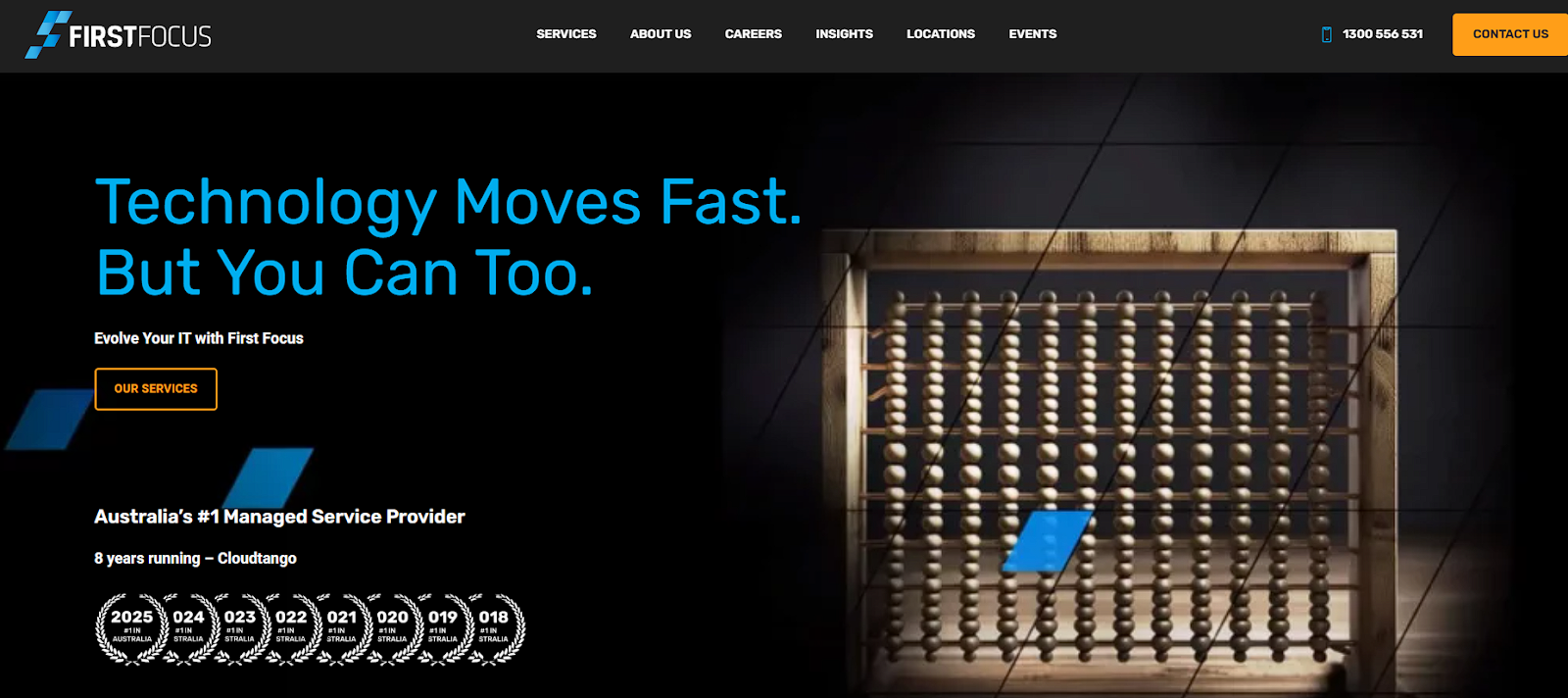
First Focus operates as an official Microsoft Gold Partner specializing in enterprise software solutions across Australian markets. Established in 2002, they've built deep expertise in Microsoft's evolving technology ecosystem. Their developers hold current Microsoft certifications and undergo regular training on latest platform updates. The company serves large enterprises and government agencies heavily invested in Microsoft stack requiring specialized expertise.
Primary Services
- Microsoft Dynamics 365 implementation and customization
- Azure cloud solutions with enterprise-grade architecture
- Power Platform development for business process automation
- Enterprise resource planning (ERP) and business intelligence solutions
- Staff augmentation with Microsoft-certified professionals
What Makes Them Different
A Microsoft Gold Partner, this company offers certified Microsoft expertise, a strong track record with Australian government agencies, and regular developer training, ideal for organizations needing deep Microsoft stack knowledge.
6. The Scalers
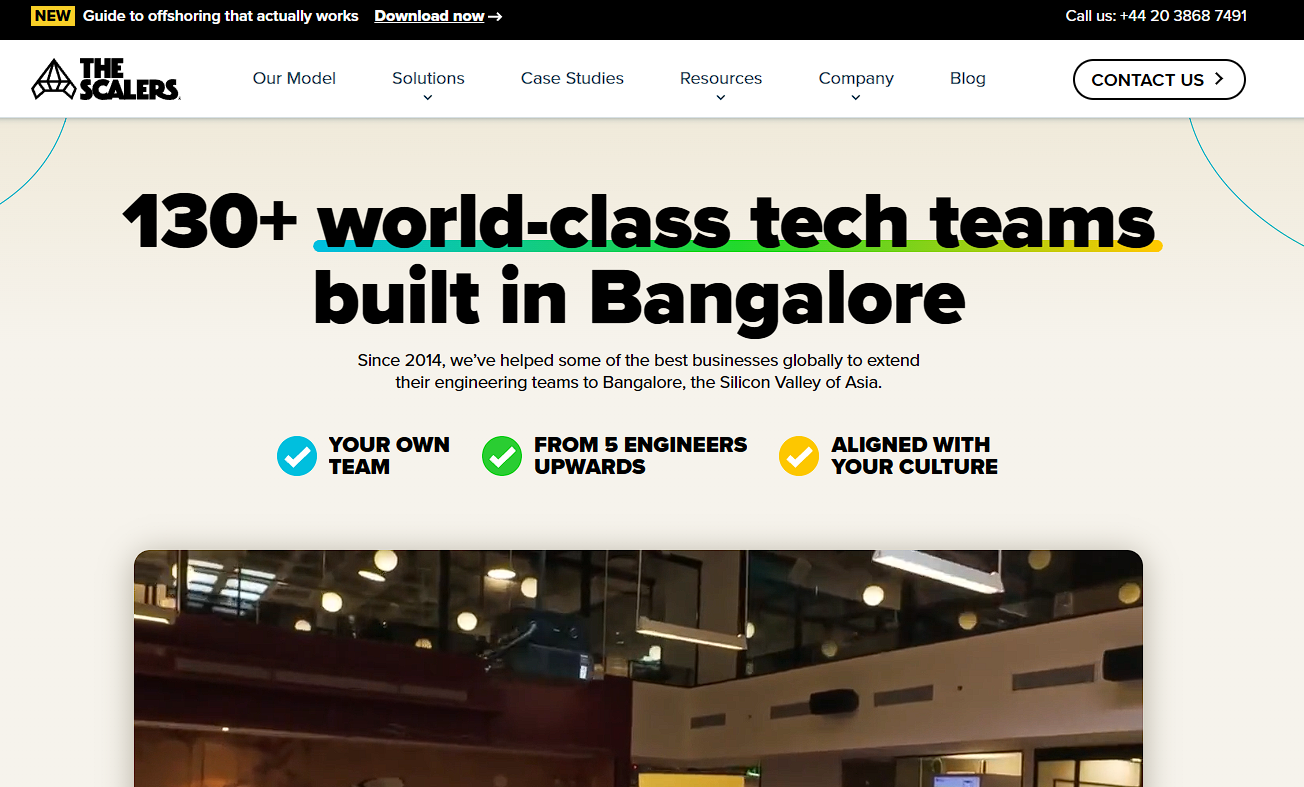
The Scalers operates a unique hybrid model building dedicated offshore development centers in India for Sydney-based companies. Founded in 2019, they've rapidly expanded across the Australian market by combining cost-effective offshore talent with Australian leadership coordination. They handle all infrastructure, HR administration, and operational overhead while clients focus purely on project delivery. This model works particularly well for companies needing 5+ developers long-term.
Main Solutions
- Dedicated offshore development centers with full infrastructure
- HR, payroll, and administrative support for augmented teams
- Australian-based account management and coordination
- Long-term team building with retention focus
- Cost savings of 40-60% versus onshore hiring
What Makes Them Different
This company offers high-quality, cost-effective offshore teams with a 1.2% applicant pass rate. They handle all infrastructure, HR, and admin, with Australian account management for seamless communication. Ideal for long-term partnerships, not short-term augmentation.
7. Starboard IT

Starboard IT brings deep cybersecurity expertise to staff augmentation space, serving high-security industries across Sydney. Established in 2008, they specialize in placing professionals with advanced security certifications including CISSP and CEH. Their team understands Australian privacy regulations and industry-specific compliance frameworks. They serve financial services, healthcare, and government sectors where security is paramount.
What They Provide
- Security architects and penetration testing specialists
- Compliance-focused developers for regulated industries
- Infrastructure security professionals with current certifications
- Australian privacy law expertise (APRA, GDPR equivalents)
- Team members holding CISSP, CEH, and industry certifications
What Makes Them Different
Certified, secure teams with deep knowledge of Australian privacy and compliance. Ideal for projects needing strict security and audit trails in banking, healthcare, and government. All placements are rigorously background and security checked.
8. Integral

Integral specializes in digital transformation projects requiring diverse skill sets spanning business analysis, technical leadership, and hands-on development. Operating since 2005, they excel at complex initiatives involving legacy system modernization. Their professionals bridge the gap between business requirements and technical implementation. They understand both outdated technology stacks and modern architectures, making transitions smoother.
Core Solutions
- Business analysts and Scrum masters for agile transformations
- Technical leads and solution architects for complex migrations
- Legacy system modernization and cloud migration expertise
- Digital strategy consulting with implementation support
- Teams bridging monolithic architectures to microservices
What Makes Them Different
Their unique talent pool blends business and technical expertise, excelling in complex projects across legacy and modern tech. They foster collaboration between stakeholders and tech teams, making them ideal for enterprises undergoing significant platform transformations requiring change management and technical skills.
9. Randstad
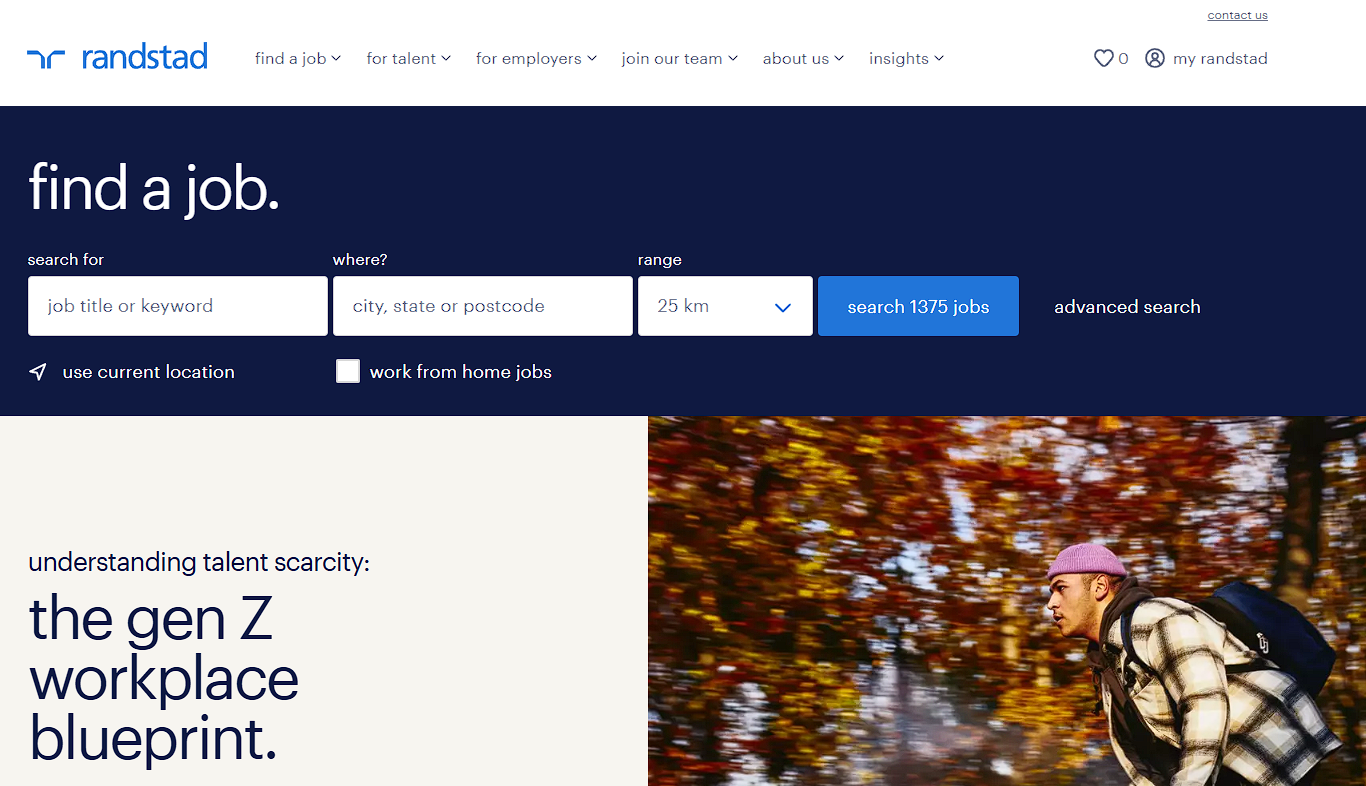
Randstad operates as one of the world's largest talent companies with extensive Australian presence since 2009. They maintain 1,000+ experts across 30 locations in Australia and New Zealand. Their scale enables simultaneous filling of multiple positions, making them ideal for large-scale team expansions. They handle all employment logistics including payroll, insurance, and compliance administration, reducing HR burden significantly.
Service Highlights
- Contract IT placements across all technology disciplines
- Managed service programs (MSP) for high-volume staffing
- Recruitment process outsourcing (RPO) for ongoing needs
- Multi-position simultaneous fills (10+ developers)
- Complete employment logistics including payroll and compliance
What Makes Them Different
With 25 years in tech staffing and global reach, this company fills numerous diverse roles simultaneously. They handle all employment logistics, freeing your HR team. Ideal for large enterprises needing 10+ developers or multiple specialized roles quickly, they provide a global talent network with local coordination.
10. EB Pearls
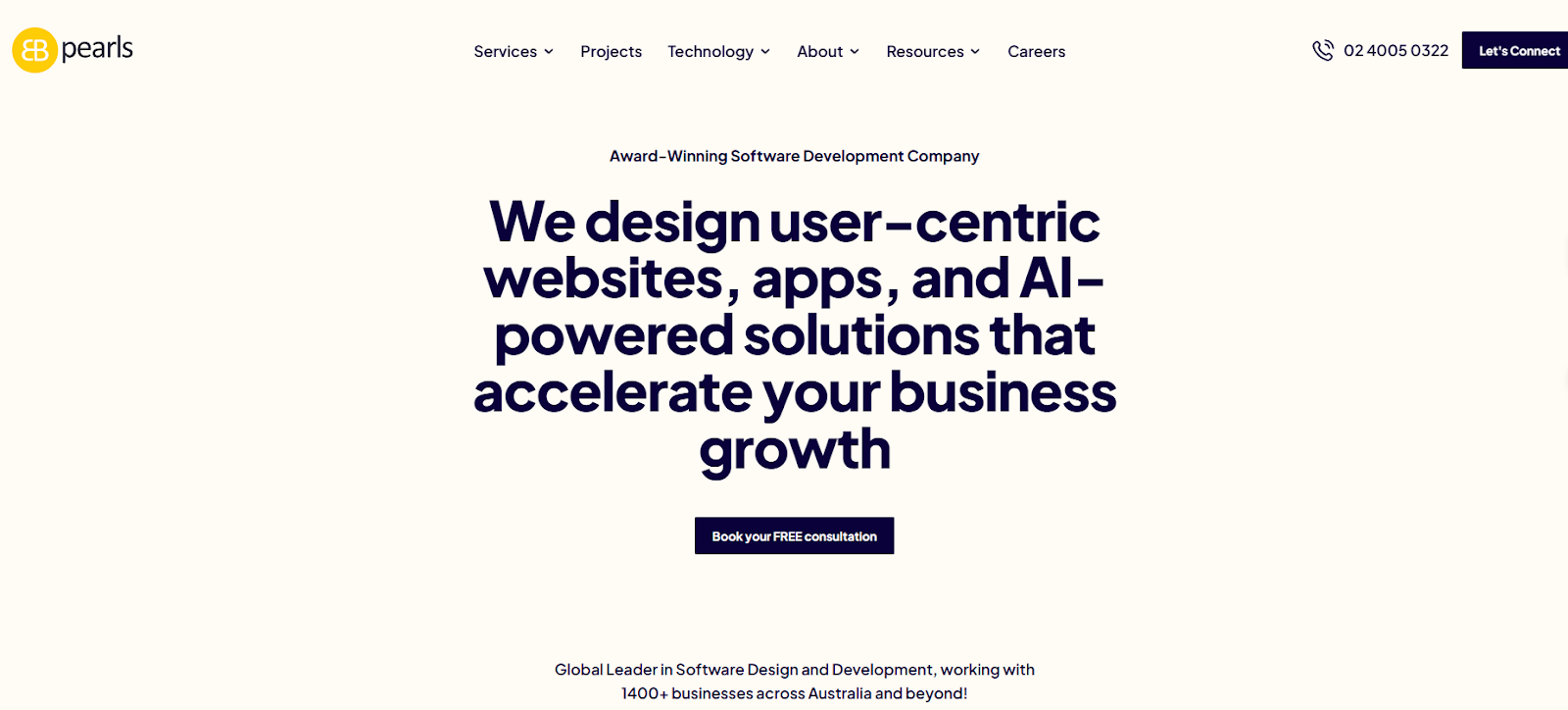
EB Pearls operates as Australia's largest mobile app development team with 320+ in-house developers across Sydney, London, and Kathmandu. Founded in 2004, they've delivered 4,000+ projects achieving a 4.9-star Clutch rating. They're Gold-winners for web design from Good Design Awards 2020. All client communications, UX/UI design, and quality assurance happen Sydney-side while development occurs in their Nepal center, reducing costs by 40% without timeline impacts.
What They Offer
- Mobile app development (native iOS/Android plus cross-platform)
- Web application development with modern frameworks
- E-commerce solutions (official Shopify Experts partner)
- UI/UX design teams with 15+ years experience
- Staff augmentation reducing costs 40% versus full Sydney rates
What Makes Them Different
Completed 4,000+ projects with top ratings. Sydney-based client comms, Nepal-owned dev hub. 40% cost savings, no quality loss. Strong in healthcare, fintech, compliance.
11. CoderTrove
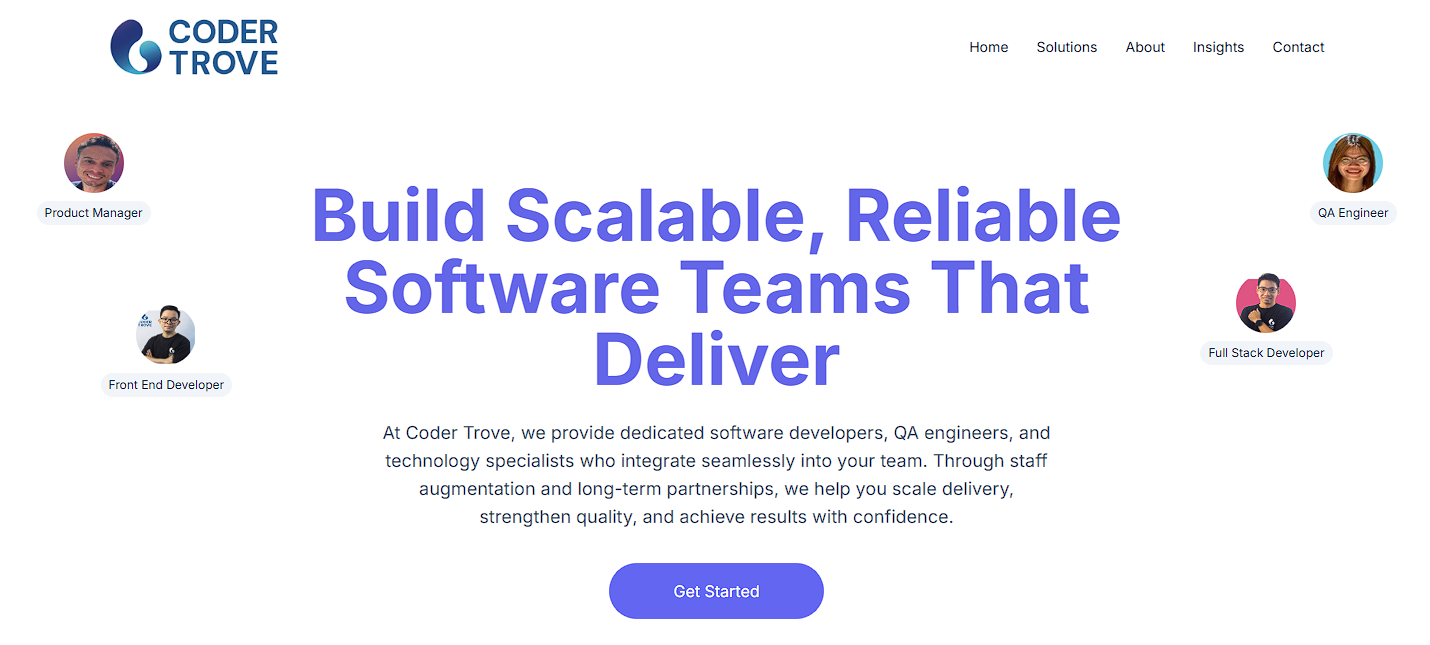
CoderTrove curates a network of pre-vetted freelance developers and consultants for rapid deployment. Established in 2017, their platform enables reviewing developer profiles, portfolios, and client ratings before engagement. They handle all contracts and payments, simplifying administrative overhead. This model works exceptionally well for startups and small businesses needing specific skills for short-term projects without long-term commitments.
Key Solutions
- Pre-vetted freelance developer network with verified reviews
- Modern web technologies (React, Node.js, Python expertise)
- Flexible pricing (hourly, daily, project-based options)
- 3-7 day deployment for immediate project needs
- Part-time specialists for targeted skill gaps
What Makes Them Different
Deploy in 3 to 7 days. Review portfolios, ratings, and feedback upfront. Flexible pricing. Ideal for startups needing niche skills fast, at lower cost than agencies.
12. Innowise

Innowise provides enterprise-level staff augmentation with focus on custom software development for complex business challenges. Founded in 2007, they've grown to 1,800+ developers globally serving mid to large enterprises. Their team includes senior architects who guide sophisticated technical decisions. They follow agile methodologies with emphasis on transparent communication through dedicated account managers assigned to each client engagement.
Core Services
- AI and machine learning implementation for enterprise automation
- Data engineering specialists for big data processing
- Senior solution architects for complex technical guidance
- Custom software development for enterprise requirements
- Transparent agile processes with dedicated account management
What Makes Them Different
Access 1,800+ skilled developers with niche expertise. Account managers guide smooth coordination. Agile focus suits complex enterprise builds across fintech, manufacturing, and more.
13. Saigon Technology

Saigon Technology offers cost-effective staff augmentation through Vietnam-based development centers while maintaining Australian business hours coverage. Founded in 2010, they provide Sydney companies access to skilled developers at competitive rates. They handle all infrastructure and management overhead allowing focus on product development. Strategic shift scheduling ensures availability during Australian business hours despite geographic distance.
Service Range
- Offshore development teams with Australian hours availability
- Full-stack web development across modern frameworks
- Mobile application development (iOS, Android, cross-platform)
- QA and testing services with automation expertise
- Infrastructure and management overhead handling
What Makes Them Different
Lowest-cost pick at $35–$60/hr with no quality trade-off. Real-time collab during AU hours. Infra and management handled. 400+ devs cover wide skill range.
14. ISH Technologies

ISH Technologies operates as a web and mobile development house serving Australian markets from Brisbane base. Founded in 2011, they focus on emerging market solutions with experience across fintech, healthcare, and e-commerce sectors. They provide end-to-end services from initial requirements gathering through post-launch support. Their long-term partnership approach includes scaling teams as business grows.
What They Deliver
- Web application development with modern architecture
- Mobile app development for iOS and Android platforms
- Dedicated development teams working exclusively on your projects
- End-to-end project delivery from concept to post-launch maintenance
- Industry expertise spanning fintech, healthcare, and e-commerce
What Makes Them Different
Australian firm with offshore-style rates via lean ops. End-to-end project support, scalable teams, and deep industry know-how. Built for lasting partnerships, not one-offs.
15. Codiant
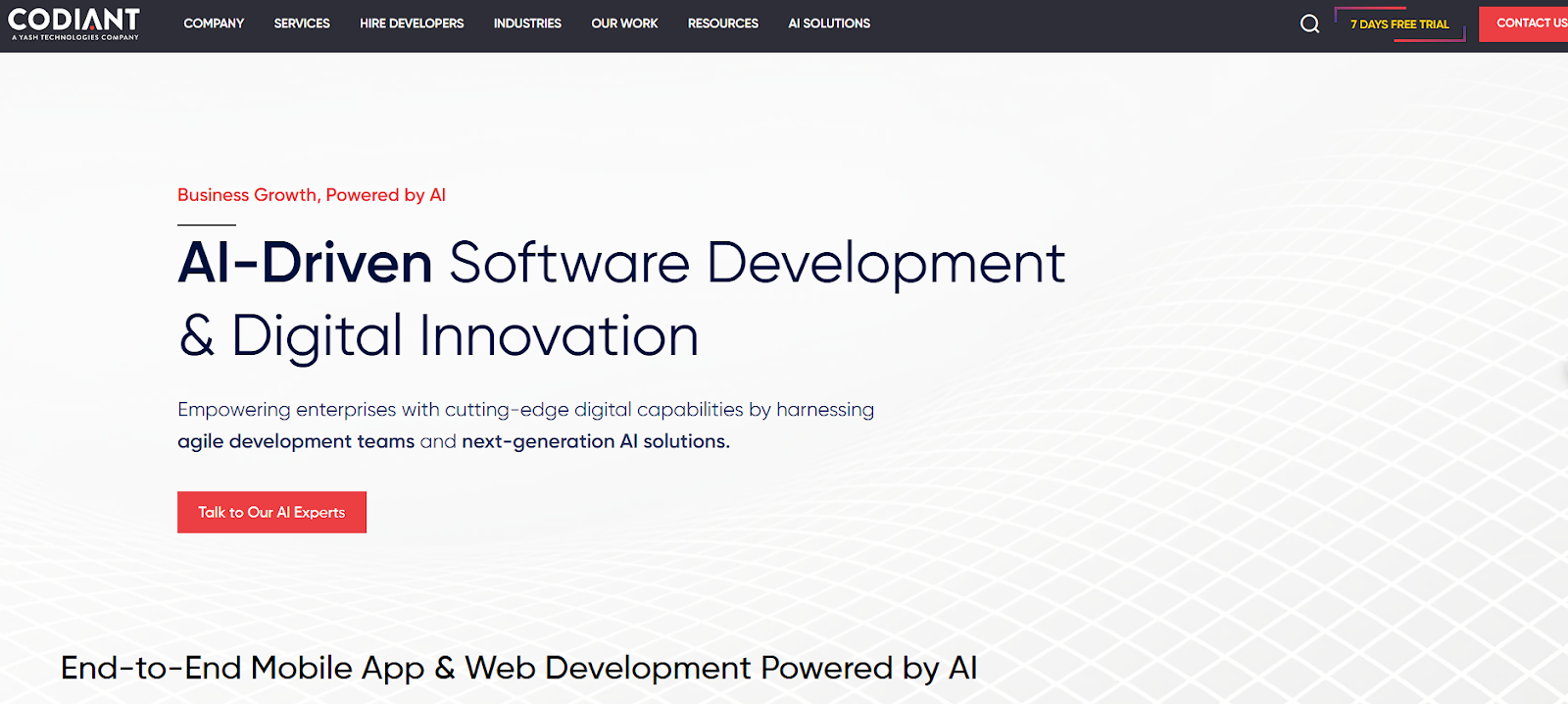
Codiant specializes in digital product development with particular expertise in connected devices and Internet of Things solutions. Founded in 2010, they bring unique capabilities in IoT, wearables, and smart device integration. Their collaborative approach involves augmented team members participating in strategy sessions rather than just executing tasks. Rigorous testing and code review processes ensure quality across complex connected systems.
Primary Offerings
- Internet of Things (IoT) development and integration
- Wearable technology applications for health and fitness
- Cross-platform mobile development (iOS, Android, hybrid)
- Smart device connectivity and integration solutions
- Collaborative development with strategy participation
What Makes Them Different
Rare IoT expertise with deep smart device integration. Augmented teams join strategy, not just execution. Rigorous testing ensures reliability. Trusted in retail, logistics, and connected ecosystems.
Benefits of IT Staff Augmentation for Sydney Businesses
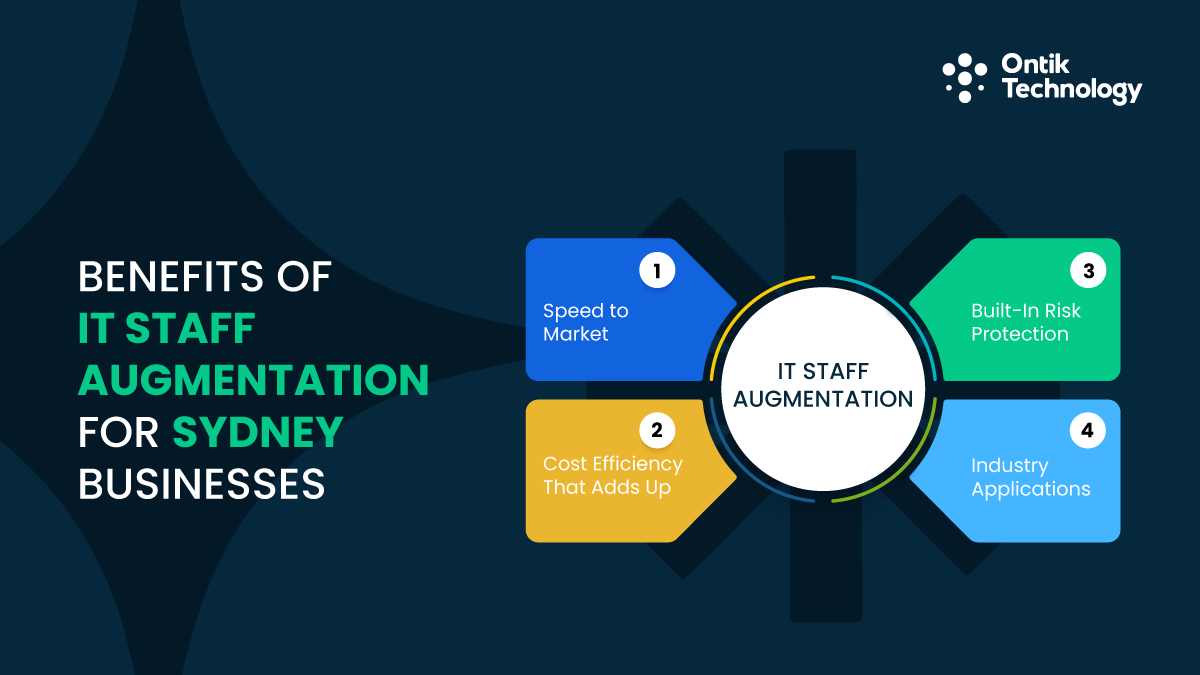
Benefits of IT Staff Augmentation for Sydney
Sydney's tech sector demands speed without sacrificing quality. IT resource outsourcing through staff augmentation delivers both by eliminating traditional hiring delays while giving you access to specialized expertise. Understanding the key benefits of IT staff augmentation helps you make informed decisions.
Speed to Market
Traditional hiring averages 68 days. Contract IT staffing solutions cut that to 7-14 days. Companies using augmented teams report 40% faster project delivery compared to building teams from scratch. This speed advantage keeps Sydney businesses competitive in fast-moving markets.
Cost Efficiency That Adds Up
A three-month project with three developers costs $234,000 via augmentation versus $330,000 for permanent hires. You save nearly $100,000 on a single project through IT staffing services.
Built-In Risk Protection
Hiring the wrong permanent employee costs Australian businesses $85,000 on average. Staff augmentation flips this. Poor performer? Top IT Staff Augmentation Companies in Sydney swap them out at no cost within 14 days.
Industry Applications
Fintech companies use augmentation for compliance specialists. Healthcare startups bring in Australian privacy regulation experts. E-commerce businesses scale before peak seasons then scale down after. SaaS companies build MVPs without permanent overhead through software development companies.
Understanding these benefits helps you make the business case. Now let's tackle how to separate great providers from mediocre ones.
How to Choose Staff Augmentation Companies in Australia
Not all IT companies in Sydney deliver equal value when it comes to staff augmentation. These six factors help you identify partners worth your investment. Learn more about choosing between staff augmentation and consulting approaches.
Technical Expertise Match
Review their portfolio for your specific technology stack. Look for 3-5 completed projects using your required technologies. No relevant experience signals they'll learn on your dime. Tech staffing firms in Sydney should demonstrate proven expertise in your domain.
Vetting Process Rigor
Top providers reject 90-95% of applicants through multiple technical assessments and code reviews. Ask their rejection rate. Answers like "we accept most qualified candidates" reveal weak standards. Quality IT consulting and outsourcing Sydney providers maintain strict screening standards following staff augmentation best practices.
Communication Setup
Verify minimum 4-hour overlap with Australian business hours, under 2-hour response times, and integration with your tools (Slack, Teams, Jira). Weekly timesheets and progress updates should be standard. Clear communication separates professional staff augmentation companies from mediocre ones.
Replacement Guarantees
Leading providers offer free replacements within 14 days if performance issues arise. No replacement policy? Walk away from that risk. Reliable IT Staff Augmentation Companies in Sydney stand behind their talent with strong guarantees.
Contract Flexibility
Avoid six-month minimums. Seek monthly rolling contracts with 48-hour scale-up or scale-down notice. You need ability to pause between project phases without penalties. Flexible terms characterize modern IT staff augmentation Australia services. Understanding the difference between staff augmentation and managed services helps clarify engagement models.
Security and References
Verify comprehensive NDAs, encrypted communications, and Australian privacy compliance. Request 2-3 references from similar companies. Providers refusing references are hiding something. Trust builds through transparency in software outsourcing Sydney relationships.
These criteria narrow your options considerably. Understanding cost structures becomes your next priority.
Cost of Staff Augmentation Services in Sydney
Sydney's augmentation market offers wide pricing variation based on experience, location, and specialization. Smart buyers understand these factors before committing budgets to IT Staff Augmentation Companies in Sydney.
Rate Structure
Location Impact
Onshore Sydney developers cost $90-$130/hour with face-to-face options. Nearshore talent runs $60-$80/hour with good time zone overlap. Offshore teams charge $35-$60/hour but require careful communication planning. Each model offers different value propositions for software solutions Sydney projects. Explore remote staff augmentation options for cost-effective solutions.
Hidden Costs
Watch for setup fees ($500-$2,000 per developer), separate management overhead billing (10-15% markup), monthly hour minimums, and exit fees. Choose all-inclusive pricing where one rate covers everything. Transparent IT consulting companies make costs clear upfront.
ROI Example
Three-month project, three mid-level developers: $129,600 through augmentation versus $189,000 for permanent hires. You save $59,400 or 31%. This demonstrates why IT staff augmentation Australia continues growing rapidly.
Understanding these costs helps you budget accurately. Let's explore how Ontik Technology delivers exceptional value among IT Staff Augmentation Companies in Sydney.
How Ontik Technology Delivers Superior Staff Augmentation in Sydney
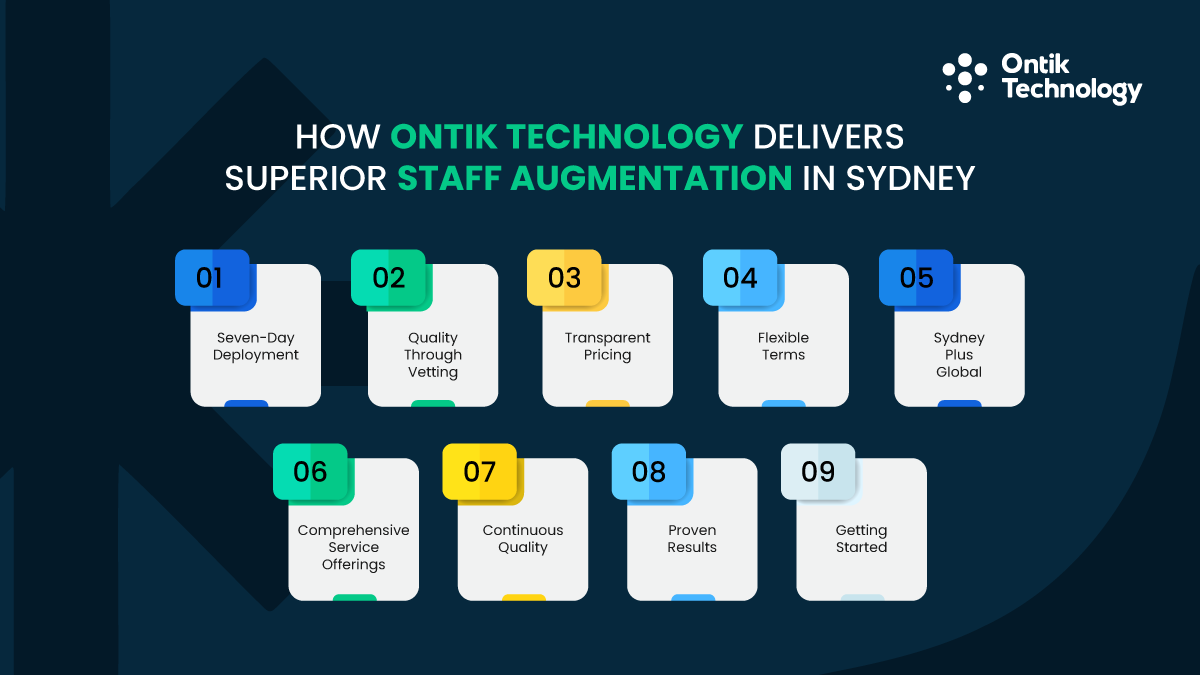
Ontik Technology combines speed, quality, and transparency in ways other Sydney providers struggle to match. We've refined our process through 220+ successful projects since 2016, establishing ourselves as one of the leading IT Staff Augmentation Companies in Sydney.
Seven-Day Deployment
We deploy developers within one week from approval. This speed comes from maintaining a pre-vetted talent pool of 60+ developers. You interview shortlisted candidates, make your selection, and they start by day seven. No other staff augmentation company in Sydney matches this deployment speed.
Quality Through Vetting
Our screening rejects 94% of applicants. Every developer completes multiple technical assessments, real-world coding challenges, and behavioral interviews. We verify references and review GitHub contributions. Only the top 6% join our network. This rigorous process ensures you receive top-tier talent through our IT staffing services.
Transparent Pricing
One hourly rate covers developer time, management coordination, infrastructure access, and weekly timesheets. No setup fees. No hidden charges. No separate management overhead. This transparency differentiates us from other software development companies in the market.
Flexible Terms
Start with a two-week trial. Scale up or down with 48-hour notice. Pause between phases without penalties. Monthly rolling contracts instead of six-month minimums. We adapt to your business rhythm rather than forcing rigid structures.
Sydney Plus Global
Our Sydney CBD office enables face-to-face meetings when needed. Local account managers understand Australian business culture. Our Bangladesh development center provides access to 60+ developers at competitive rates. This combination delivers local accessibility with global talent pools.
Comprehensive Service Offerings
Beyond staff augmentation, we offer complete development solutions including:
- Web Development with modern frameworks
- AI & Machine Learning implementation
- Mobile App Development for iOS and Android
- Cloud Solutions and infrastructure
- UI/UX Design consultation
- Dedicated Development Teams for long-term projects
Continuous Quality
Monthly performance reviews incorporate your feedback. Quarterly code audits ensure high standards. Underperforming members receive immediate training or replacement at no cost. Your project success builds our reputation among IT Staff Augmentation Companies in Sydney.
Proven Results
Sydney fintech: 2 to 12 developers in six weeks. Healthcare startup: compliance platform in four months versus nine-month estimate. E-commerce company: $280,000 annual savings replacing three permanent roles. These outcomes demonstrate our commitment to client success.
Getting Started
Free 30-minute consultation. We assess needs and recommend team structure. Meet shortlisted developers. Team deploys within seven days. Experience why companies choose us among top IT companies offering staff augmentation in Sydney.
Ready to scale without traditional hiring headaches? Contact Ontik Technology today and discover superior IT staff augmentation Australia services.
Conclusion
IT Staff Augmentation Companies in Sydney provide the fastest path to scaling your development capacity without traditional hiring overhead. You skip months of recruitment while accessing specialized expertise exactly when projects demand it through staff augmentation services in Sydney. The 15 providers in this guide bring different strengths spanning rapid deployment, enterprise solutions, security expertise, and cost efficiency.
Your choice depends on specific project requirements, budget constraints, and desired engagement models. Some excel at rapid scaling while others specialize in particular technologies or industries. Staff augmentation consistently beats traditional hiring for flexibility plus cost efficiency in Sydney's competitive tech market.
Choose providers carefully by prioritizing rigorous vetting processes, transparent pricing, and flexible contract terms. Start small with trial periods to test team fit before committing to longer engagements. The right partner among IT Staff Augmentation Companies in Sydney becomes a strategic asset accelerating growth while the wrong choice creates expensive headaches that derail timelines.
